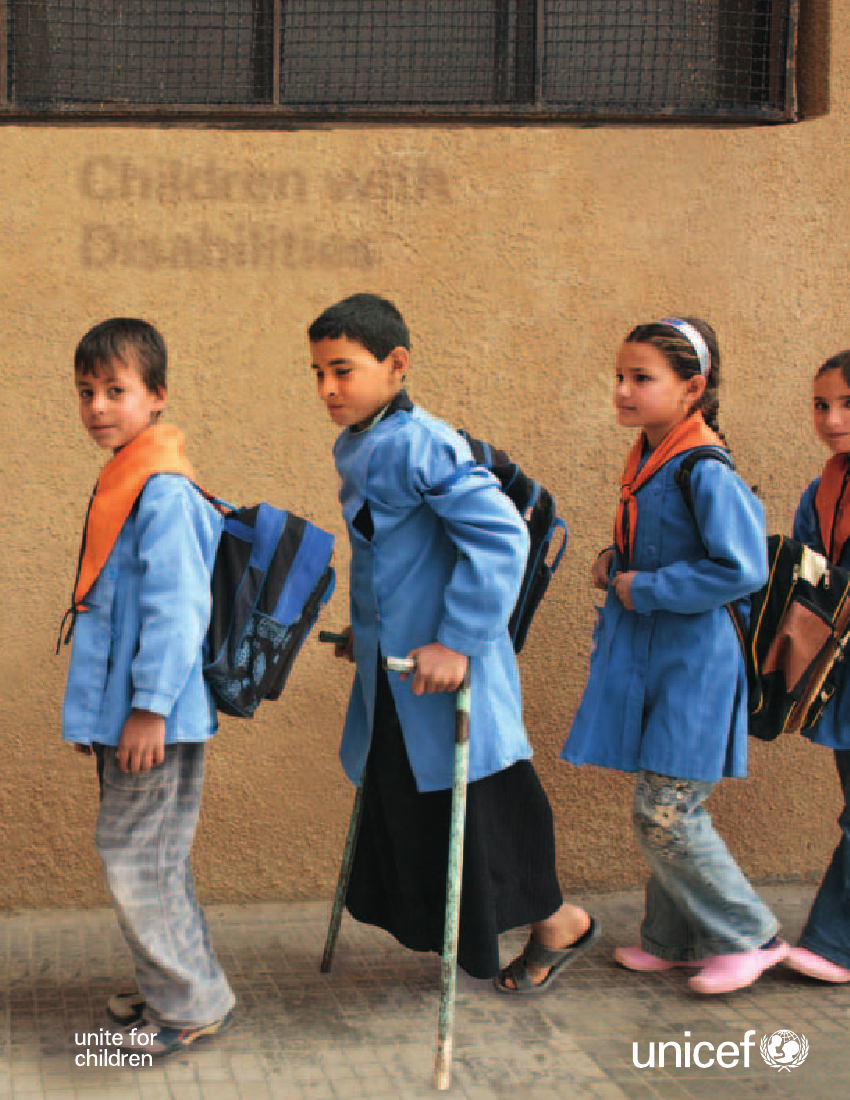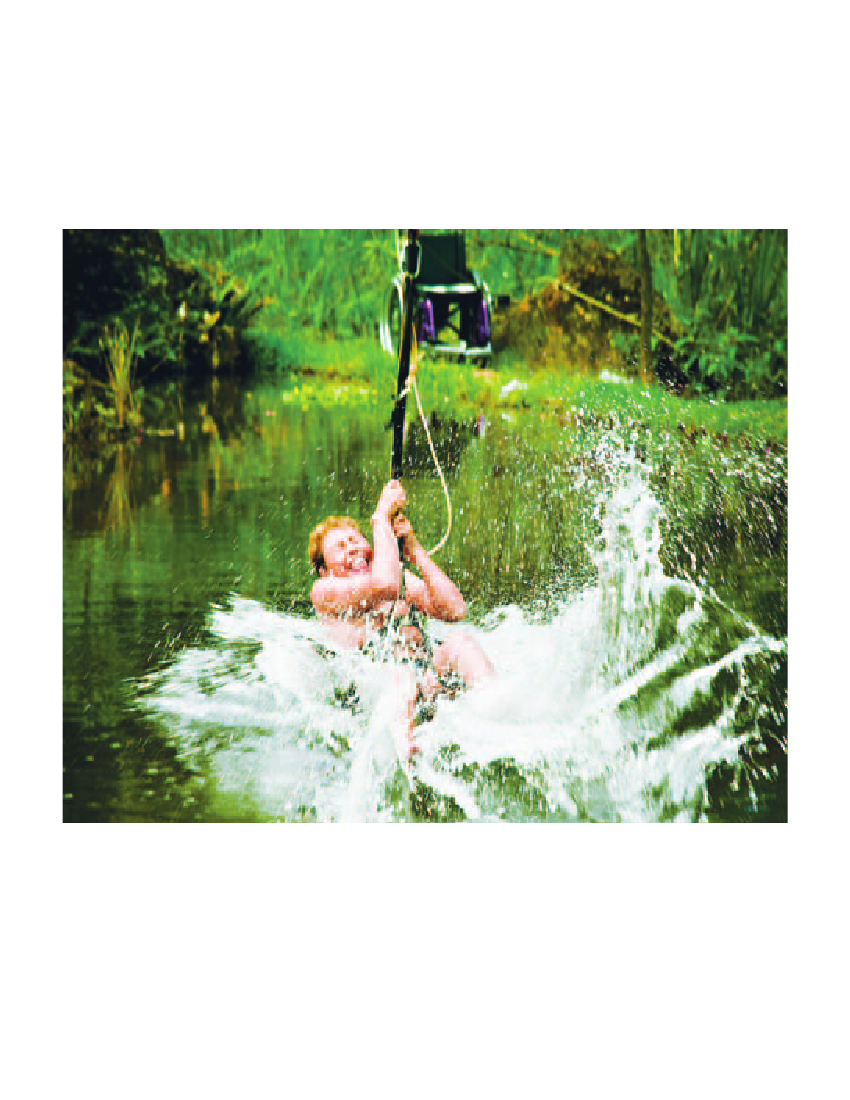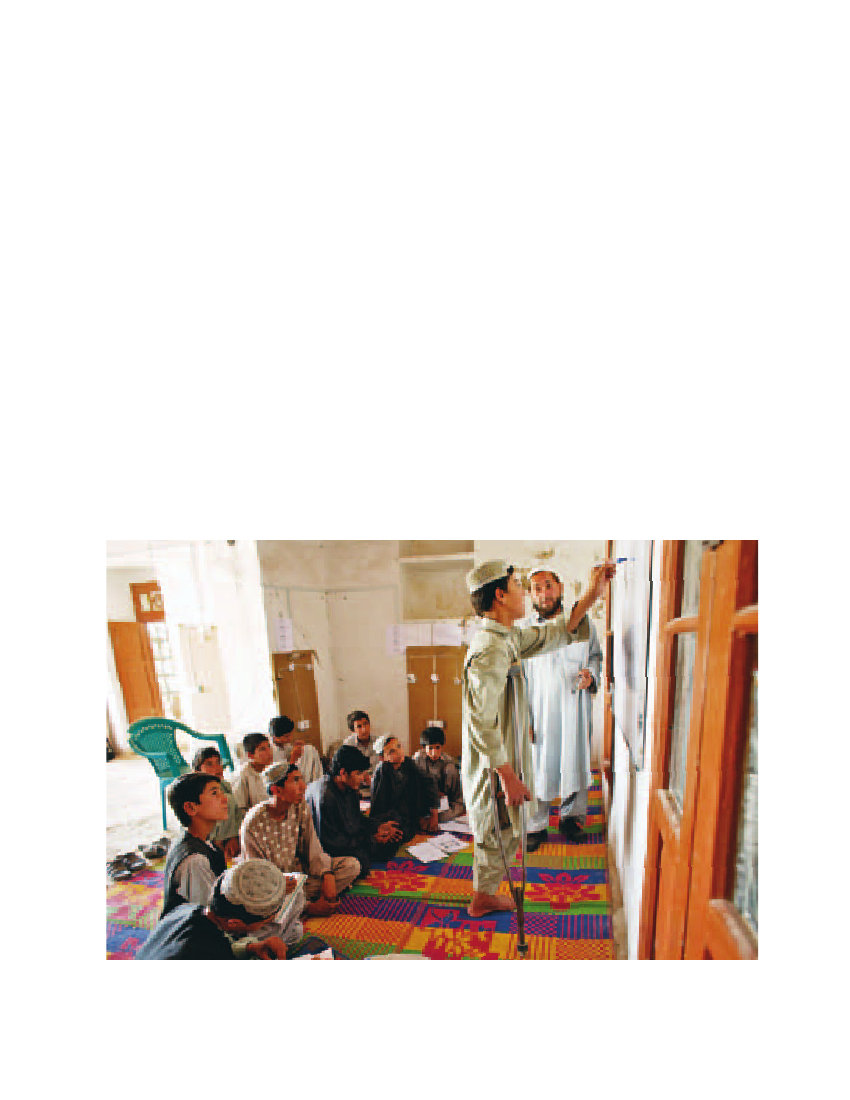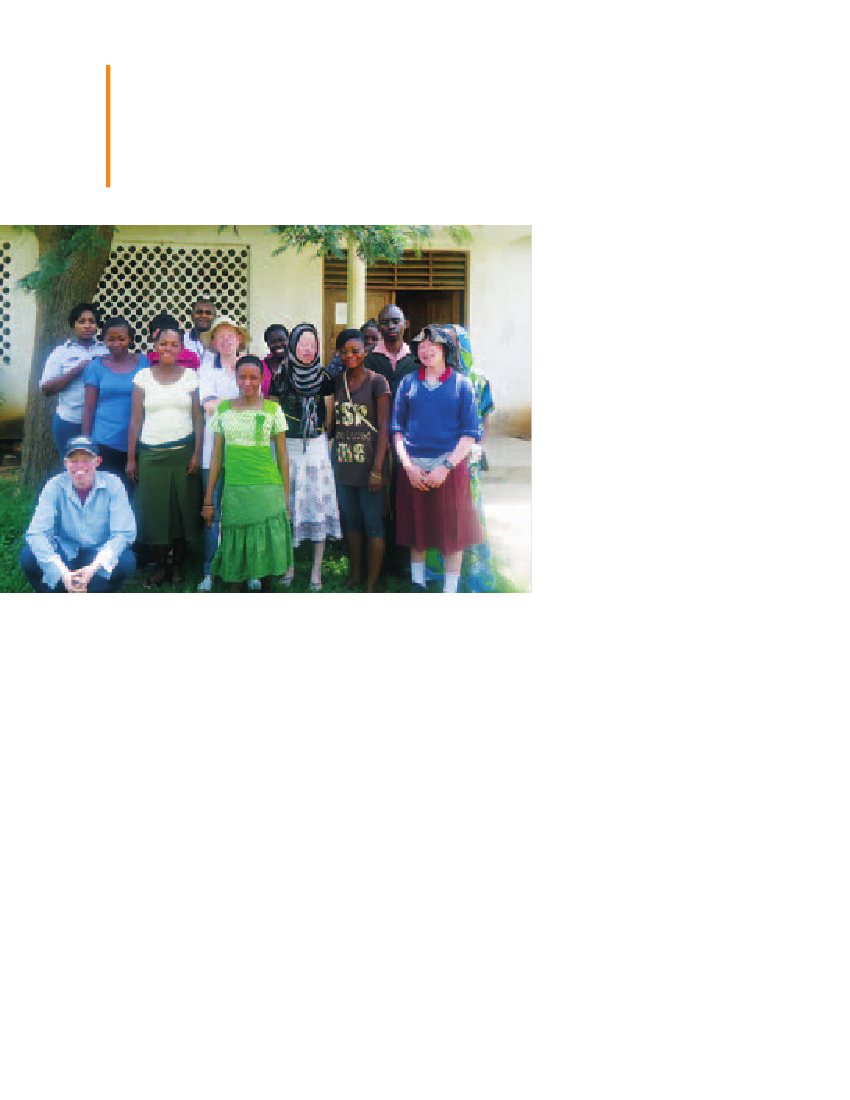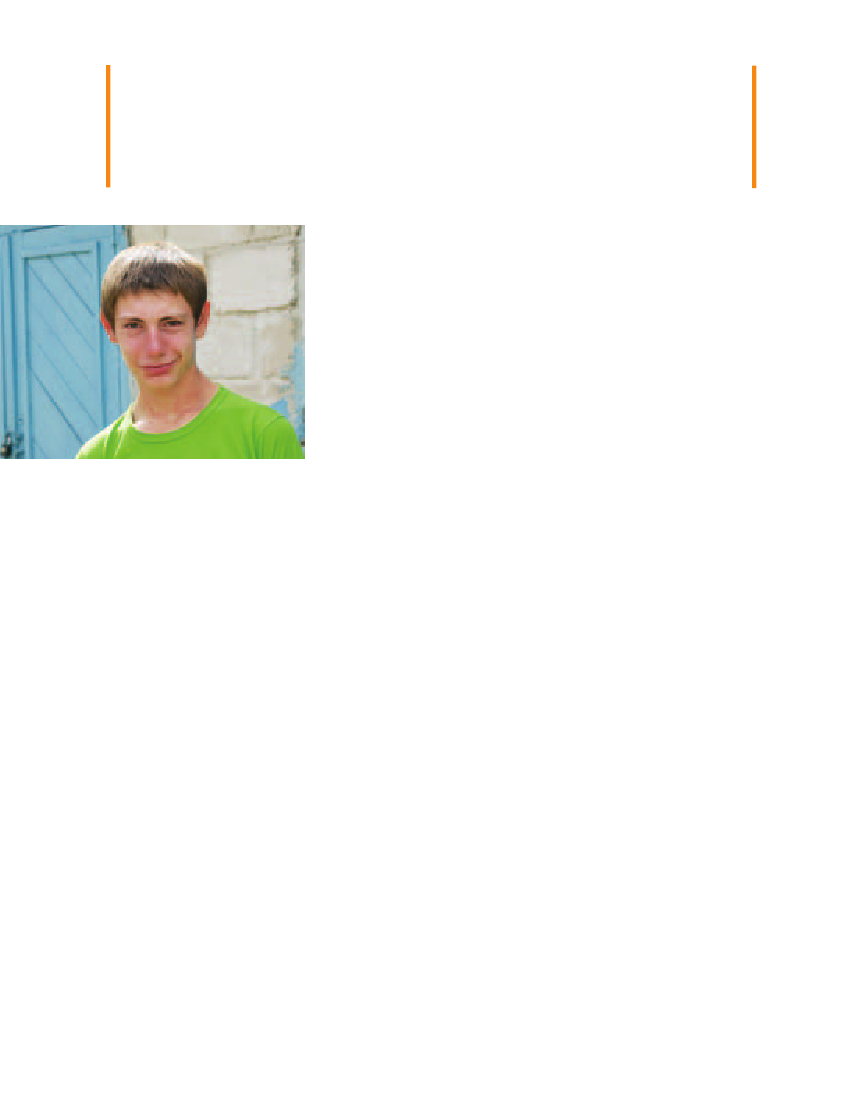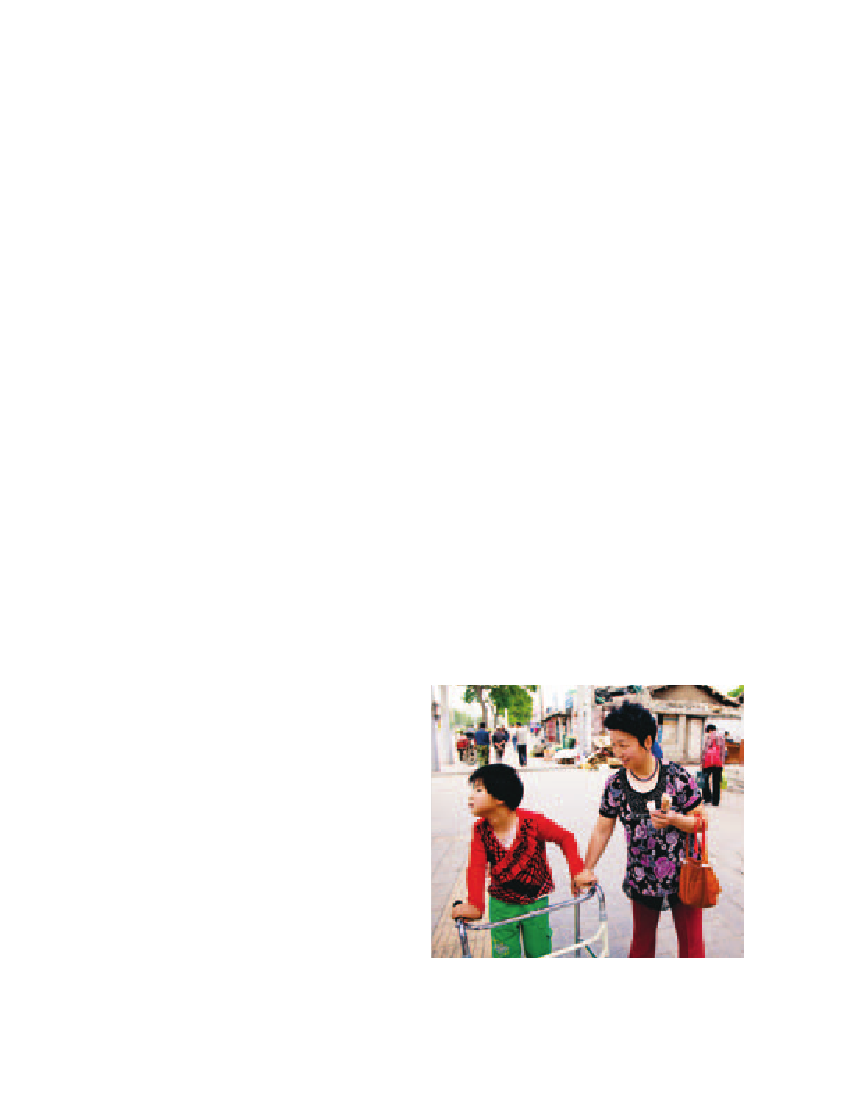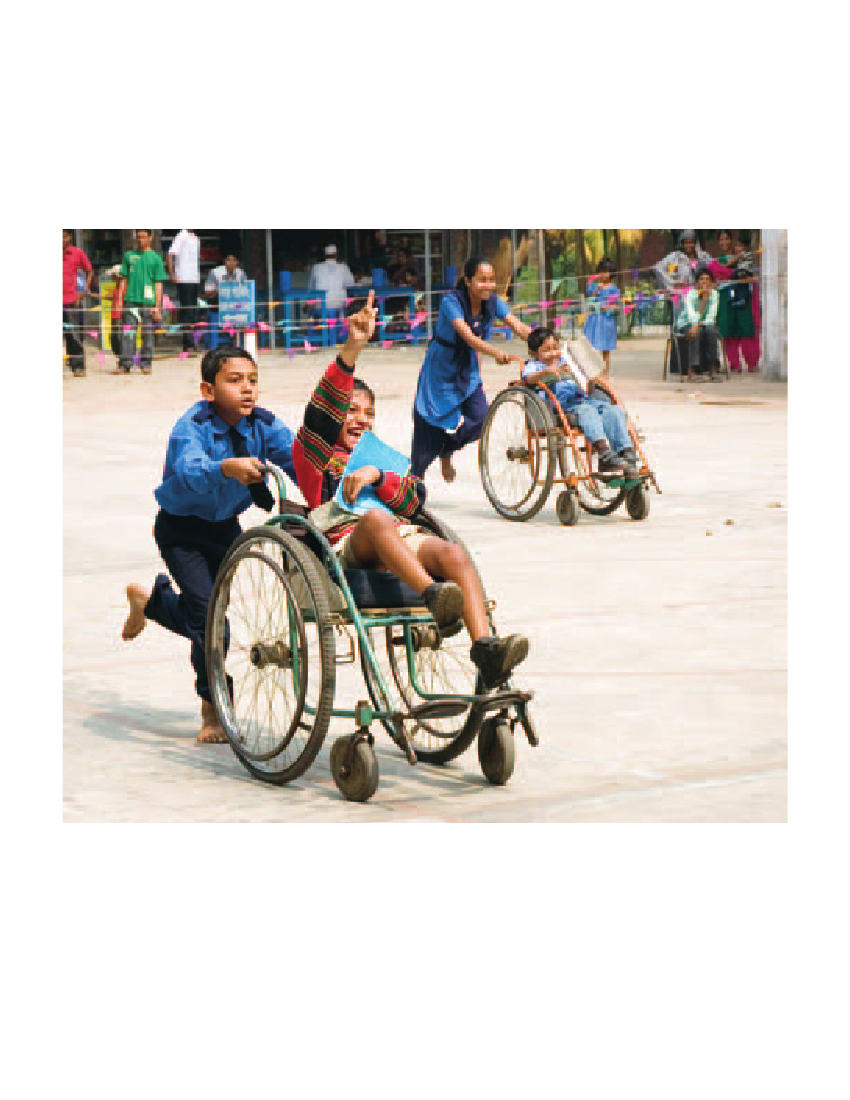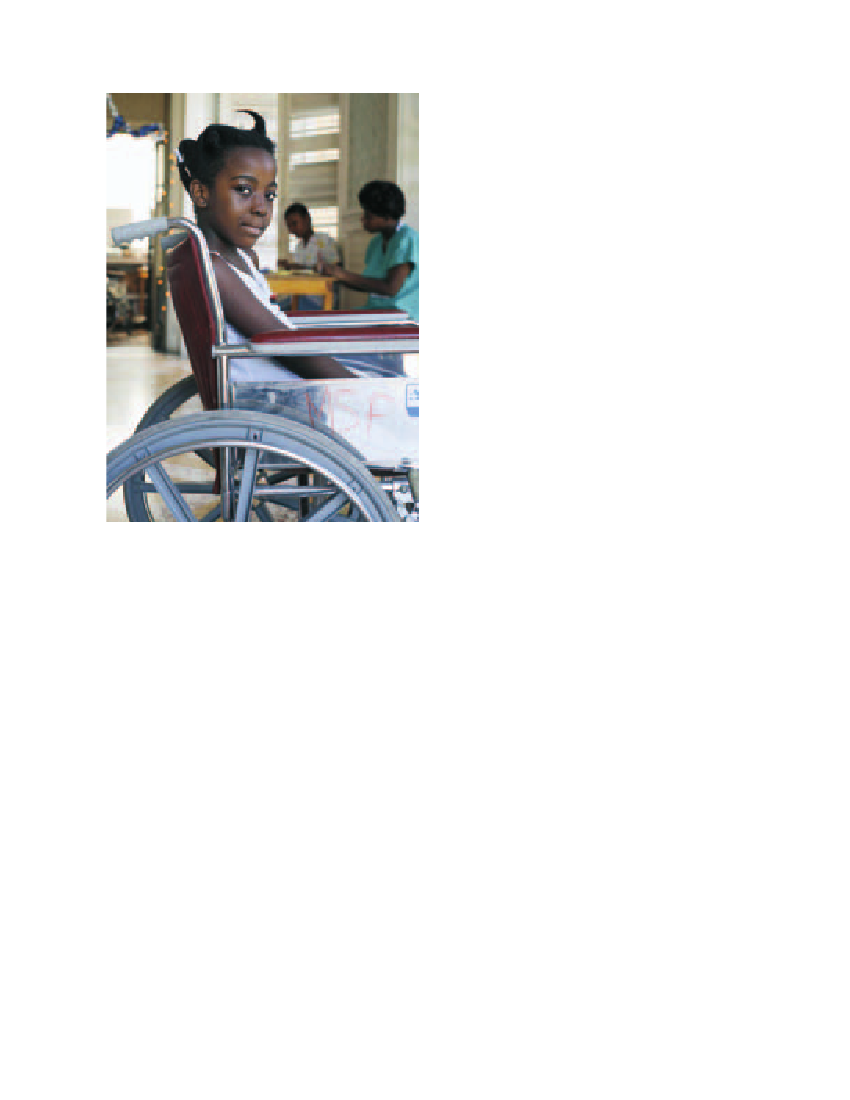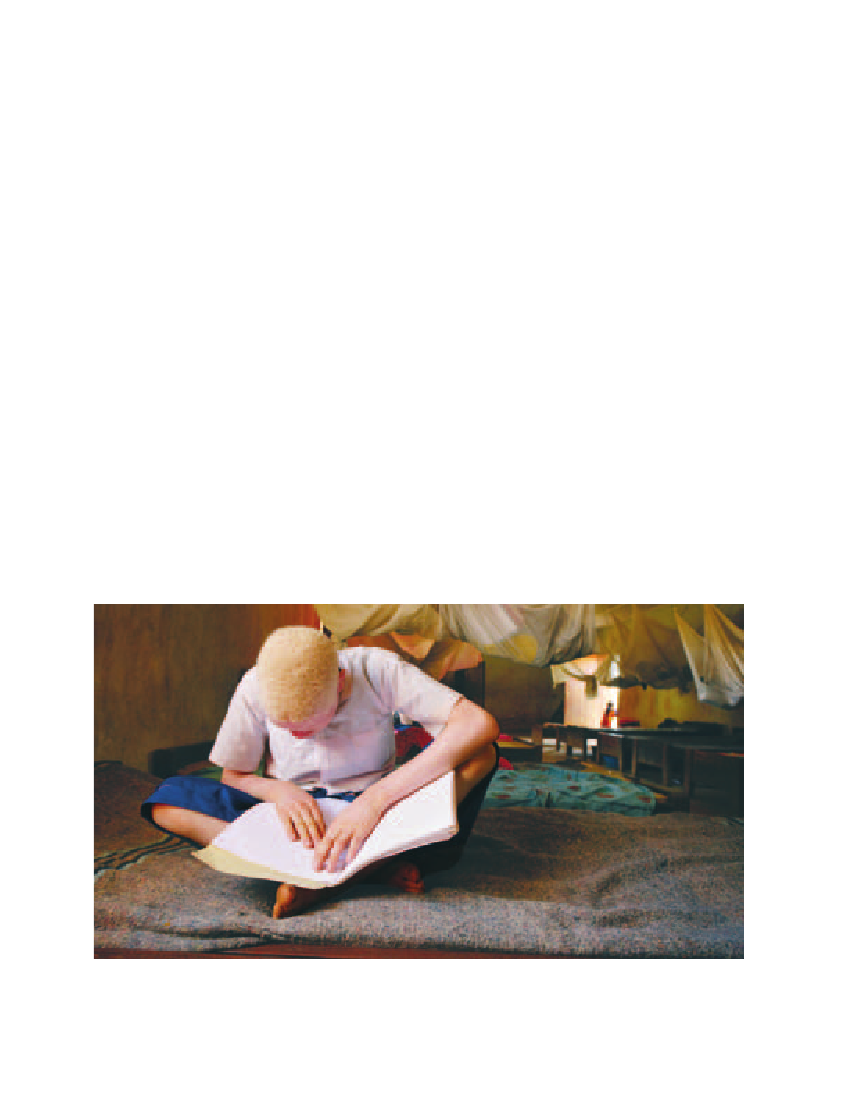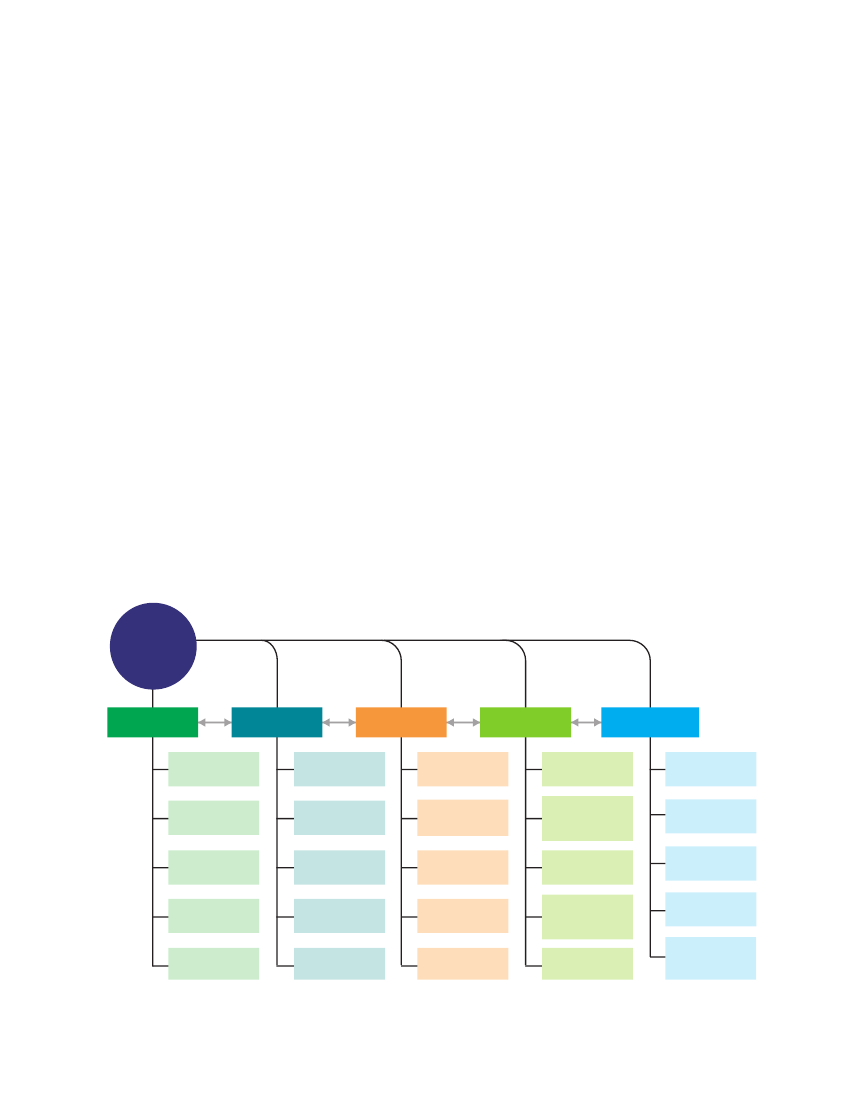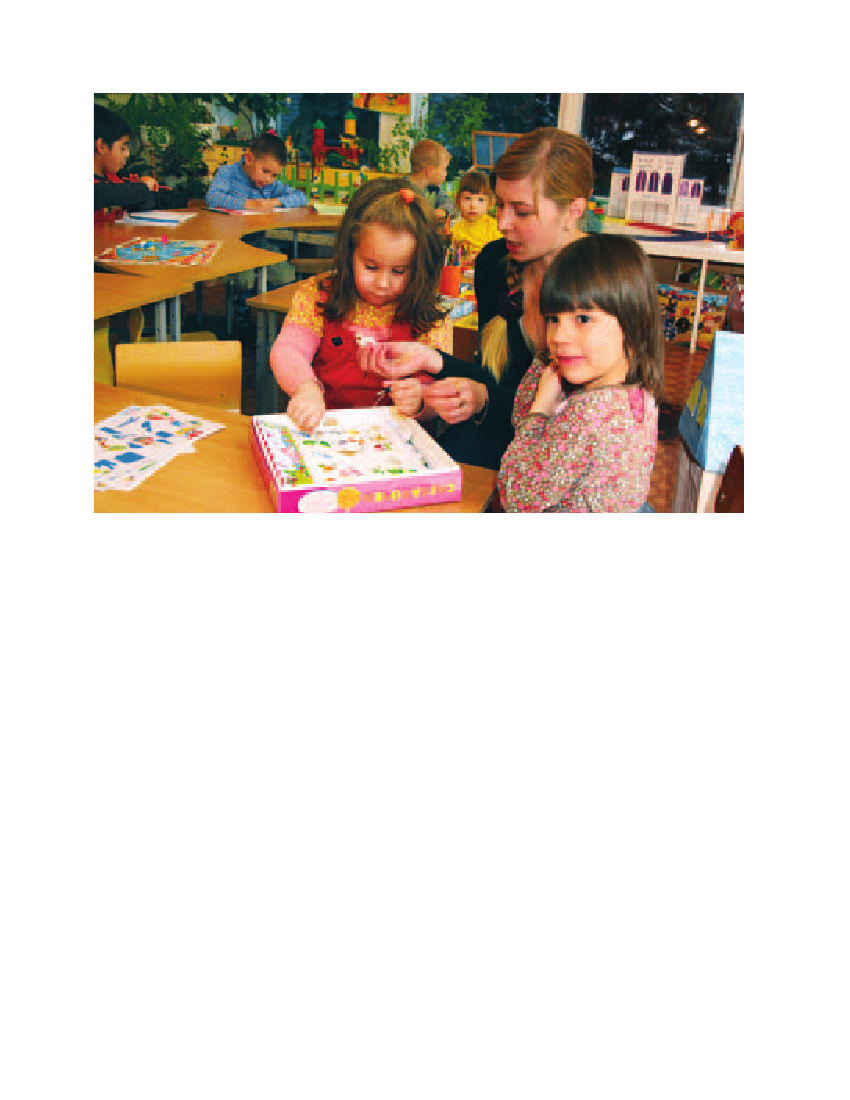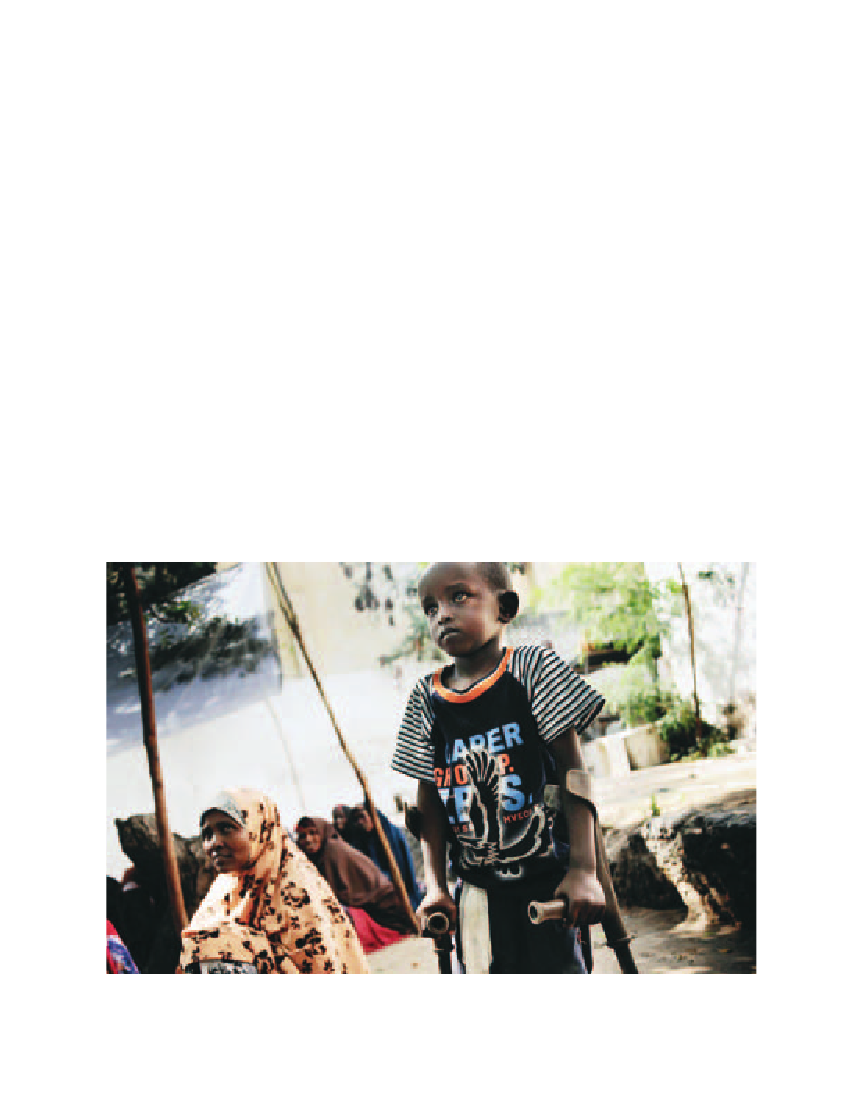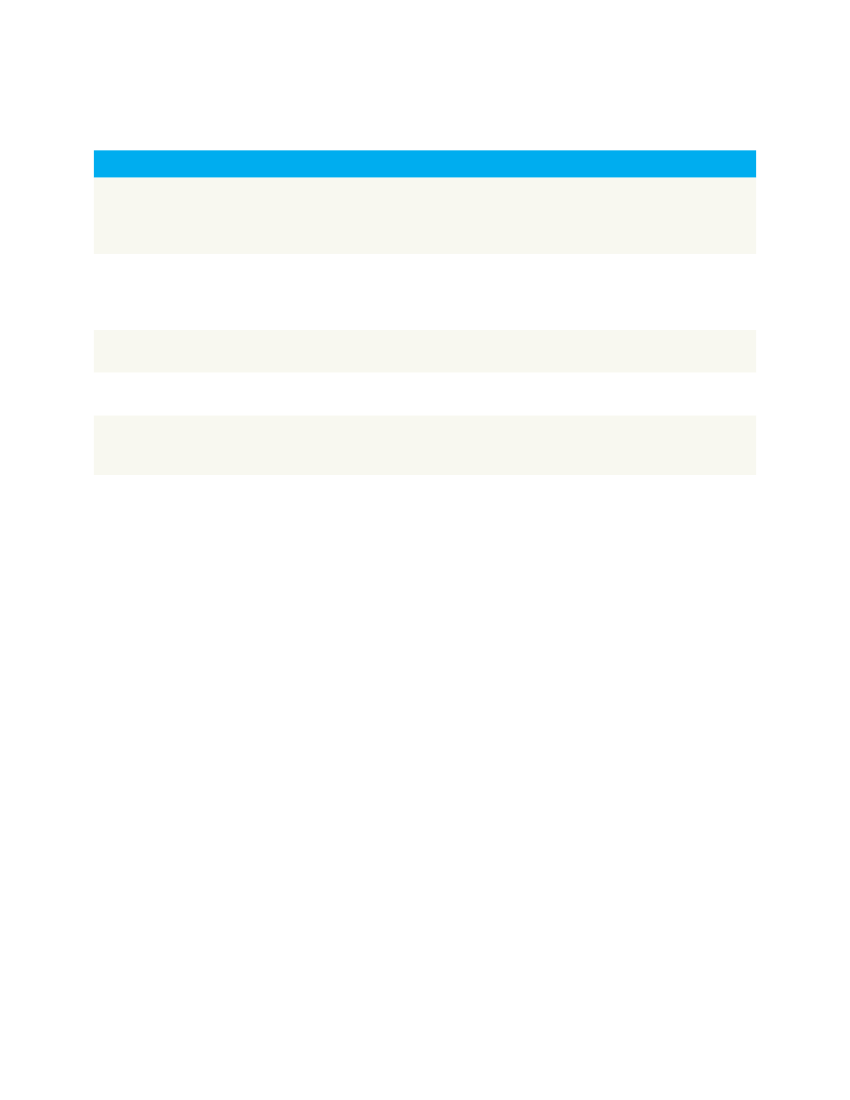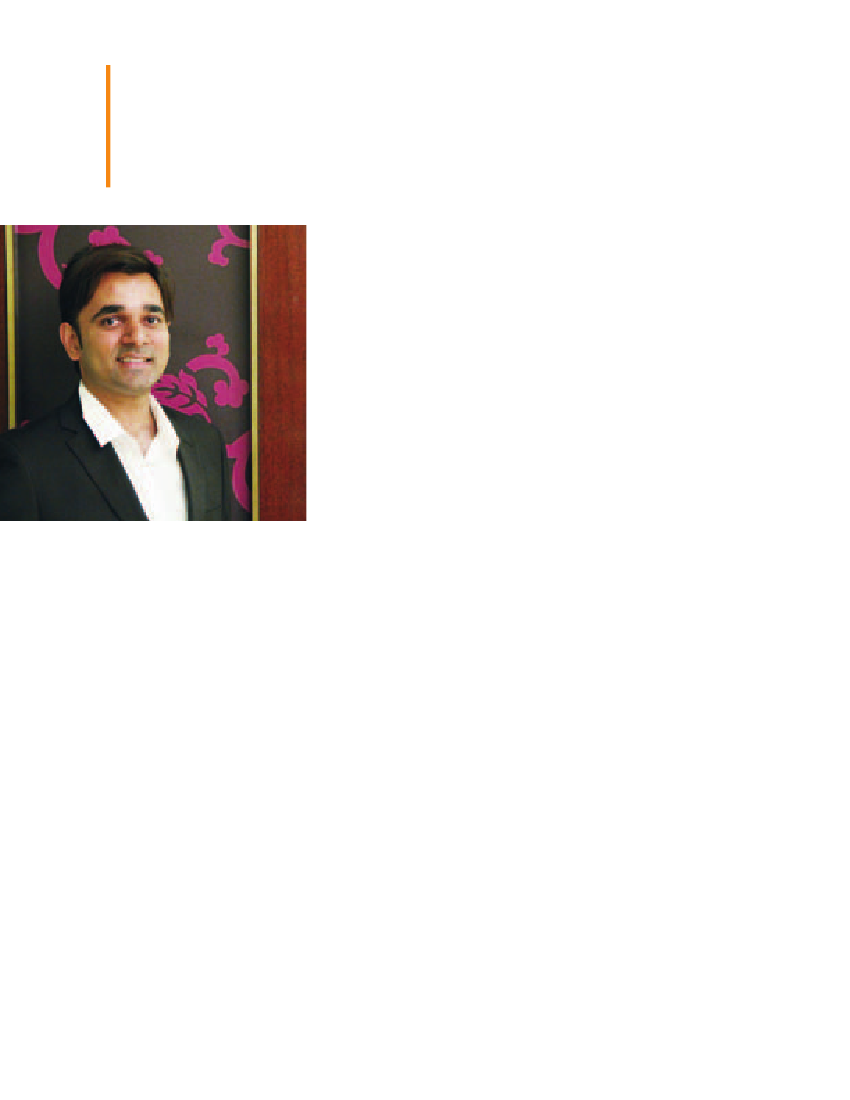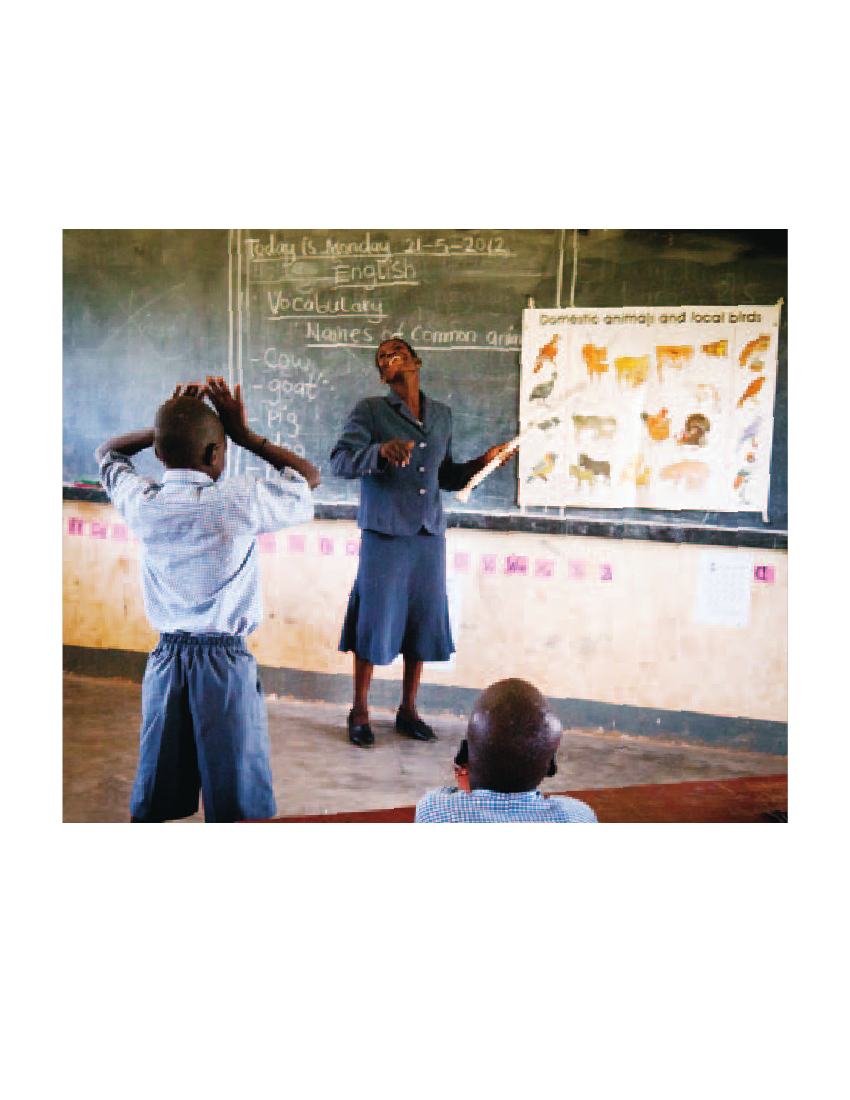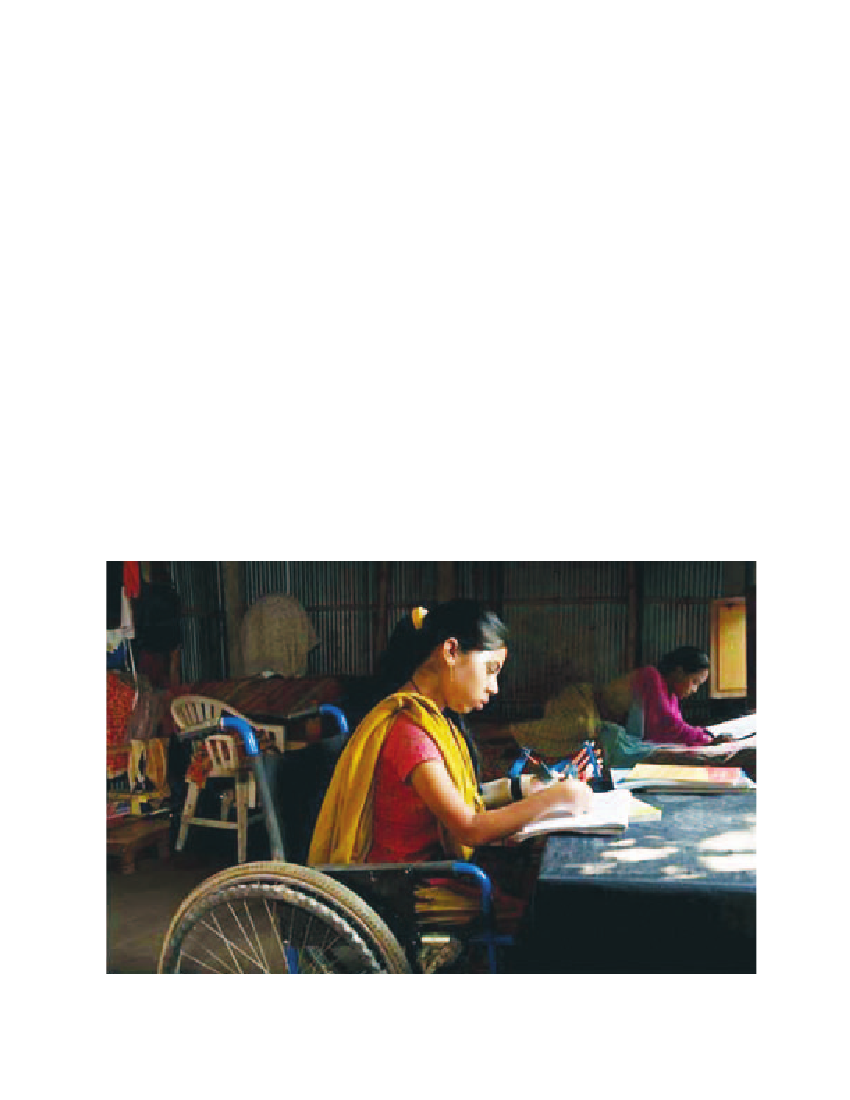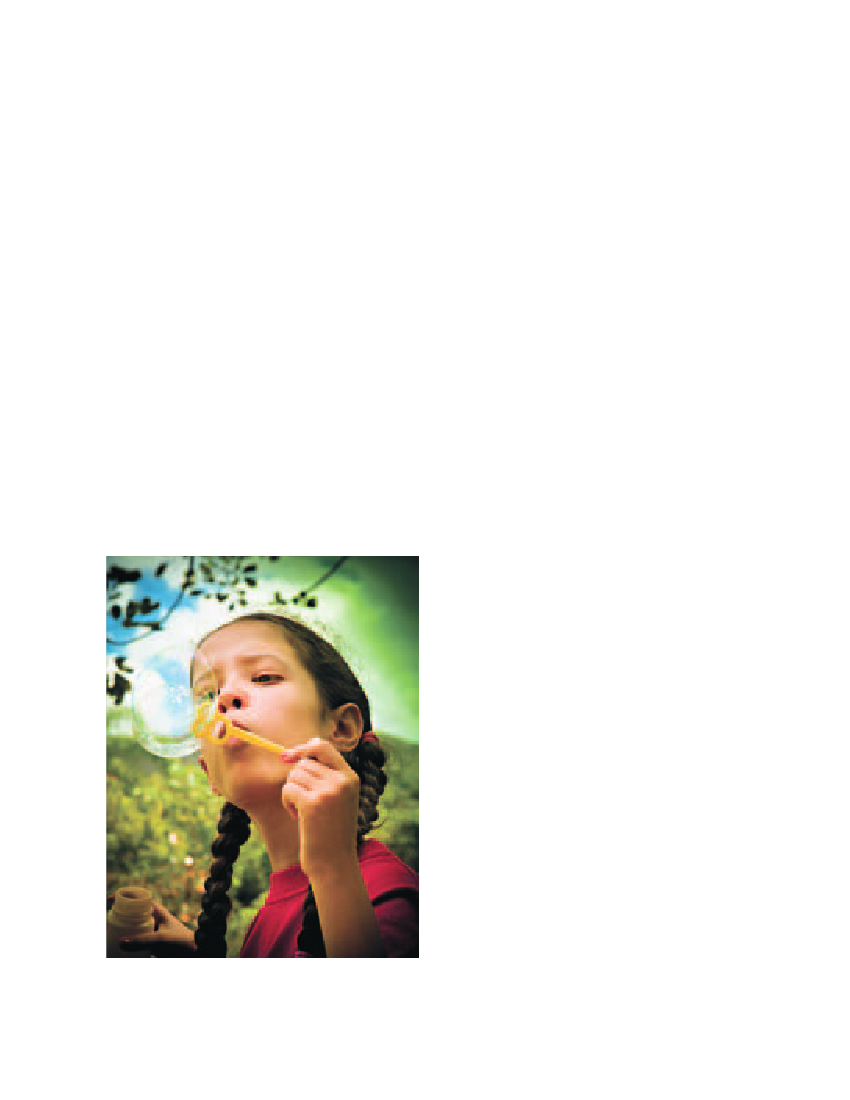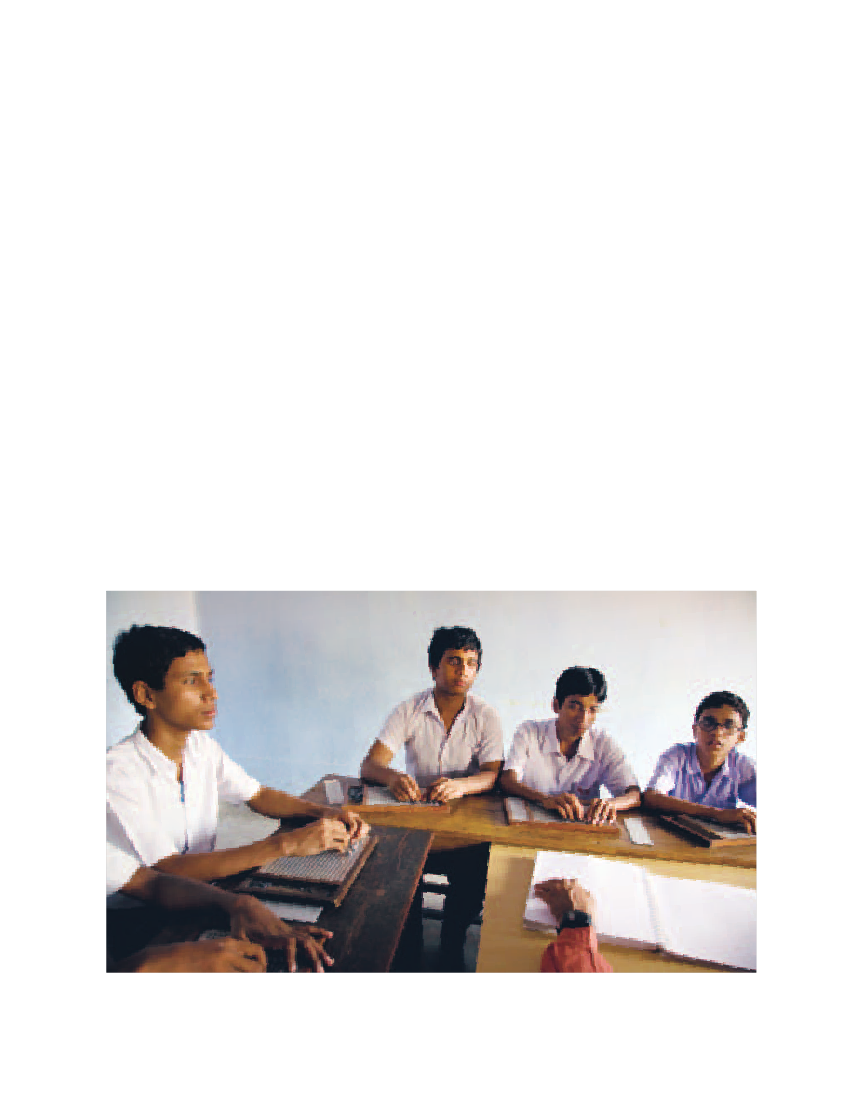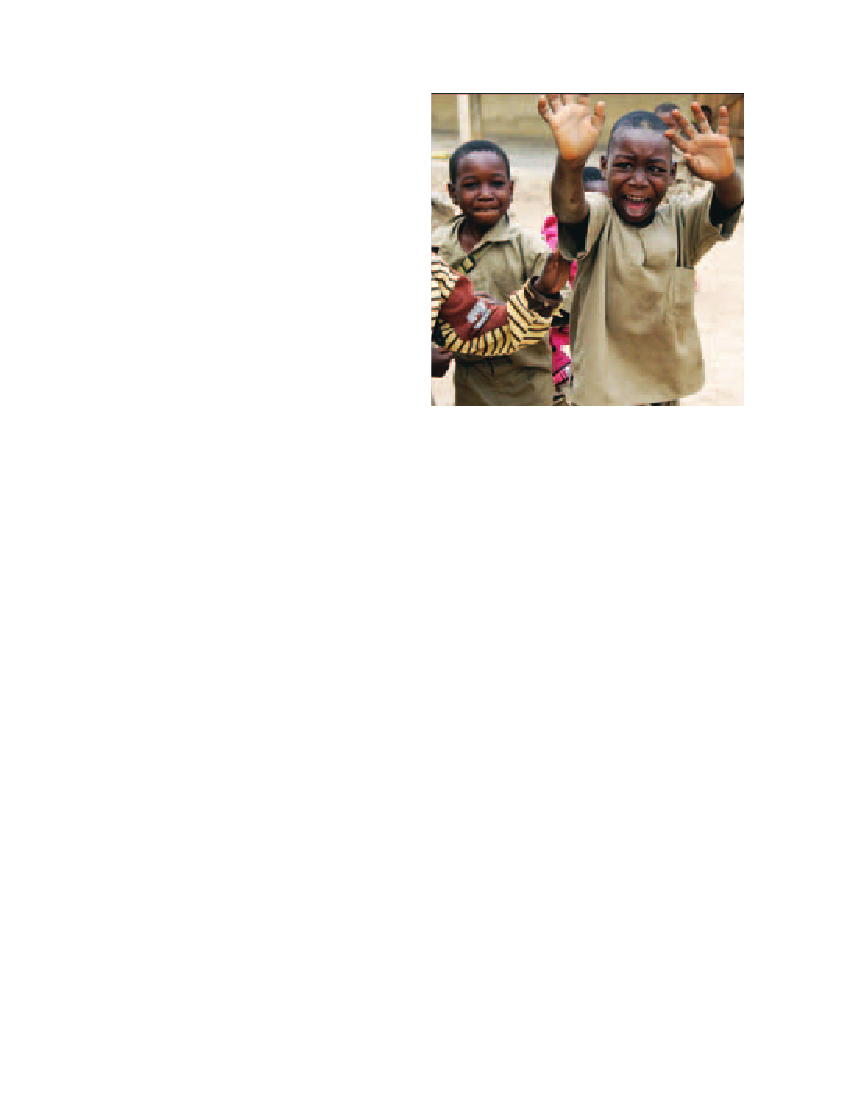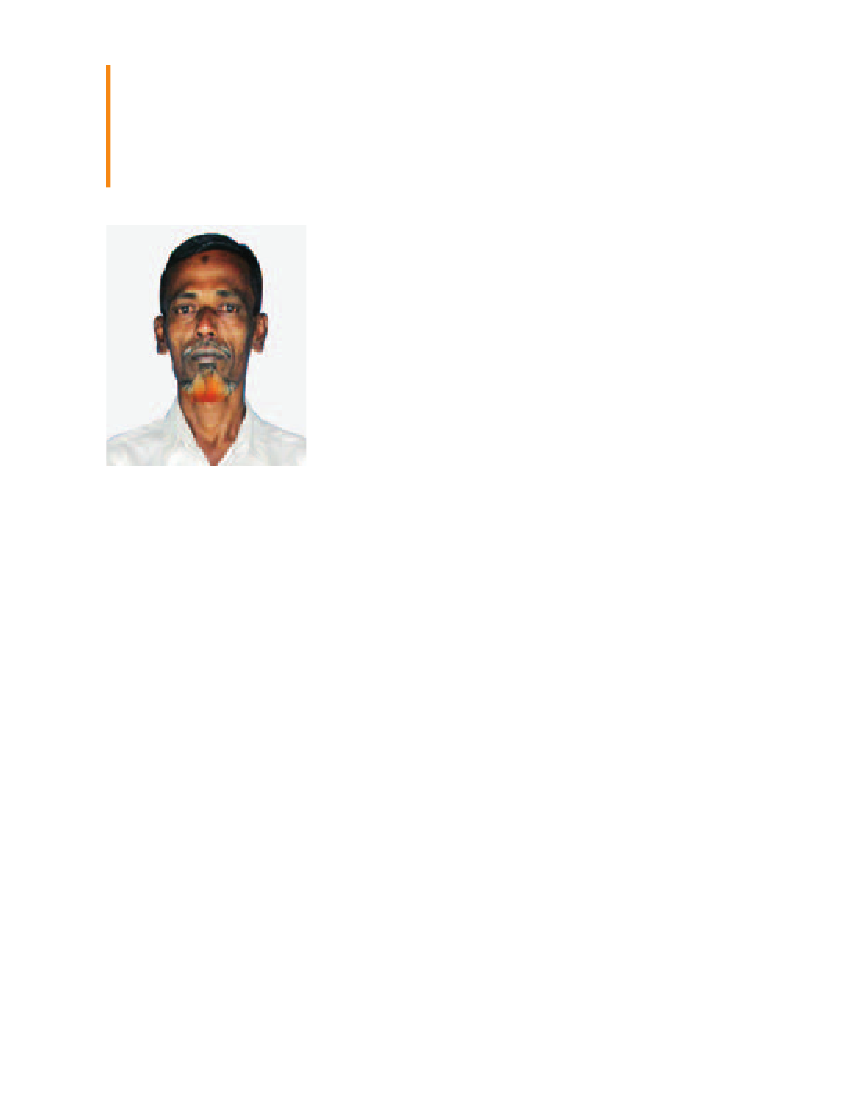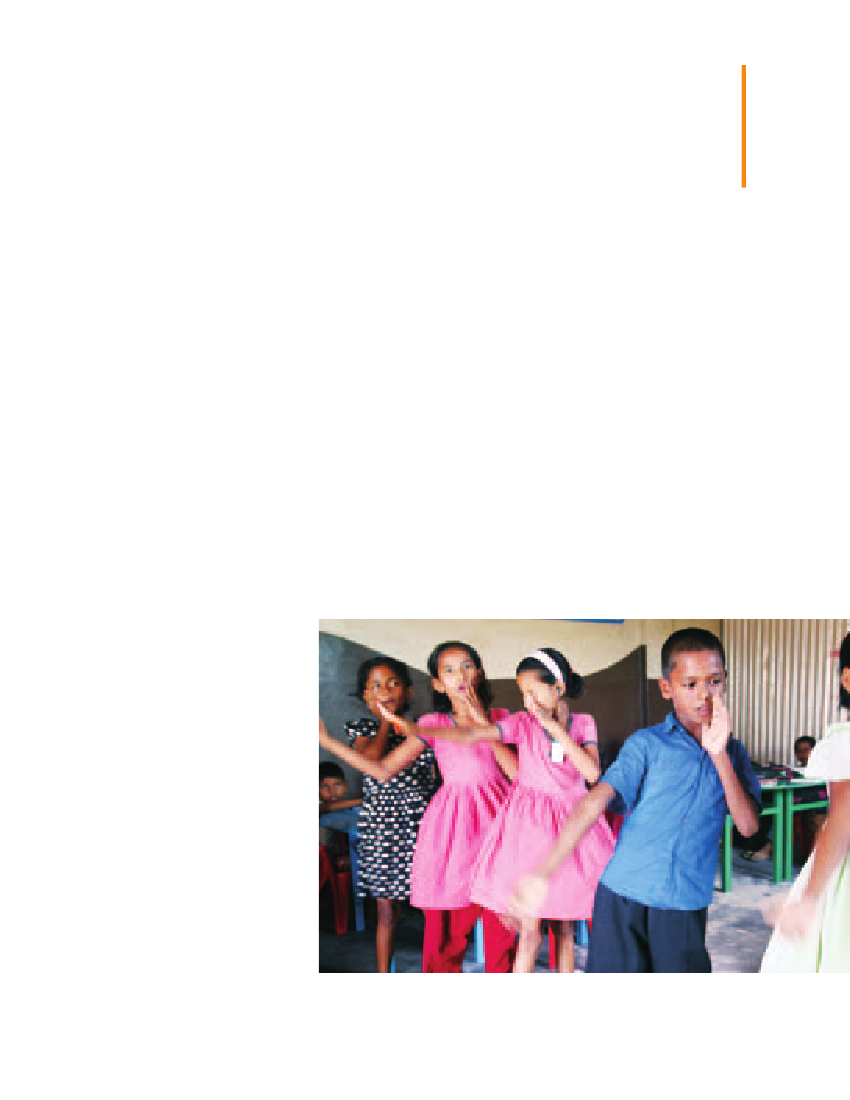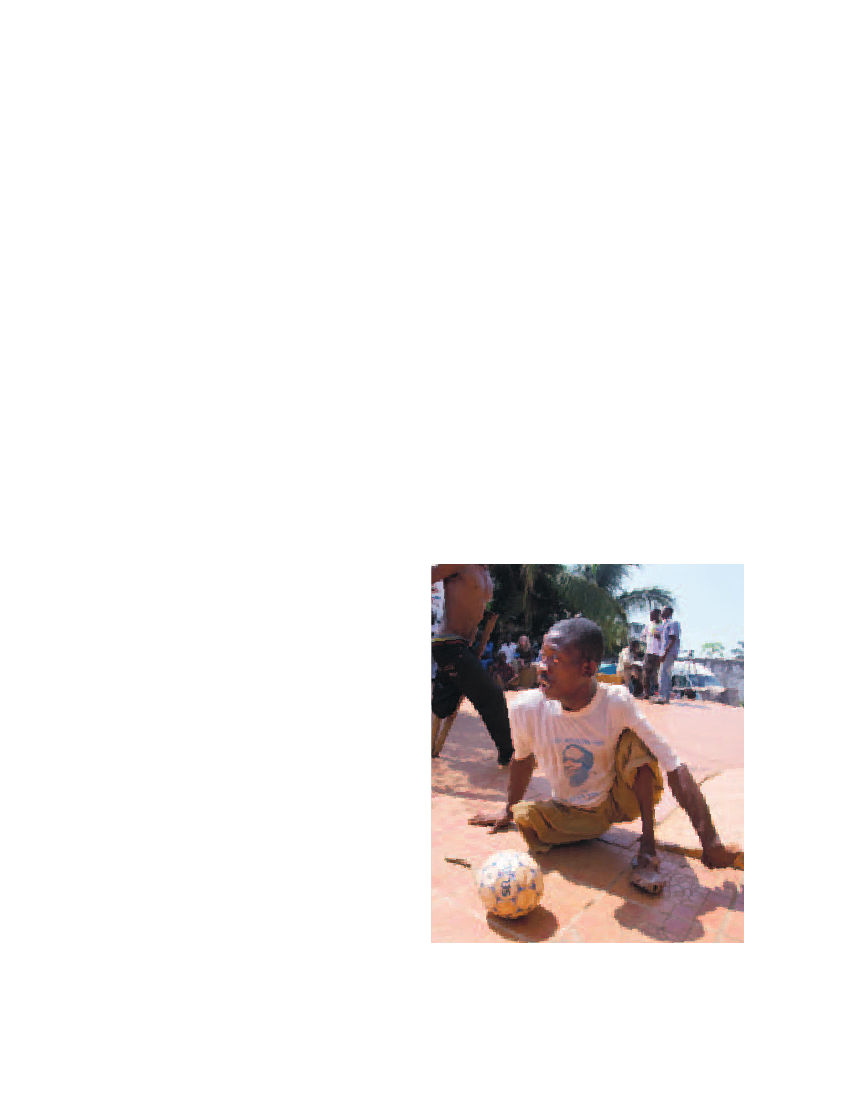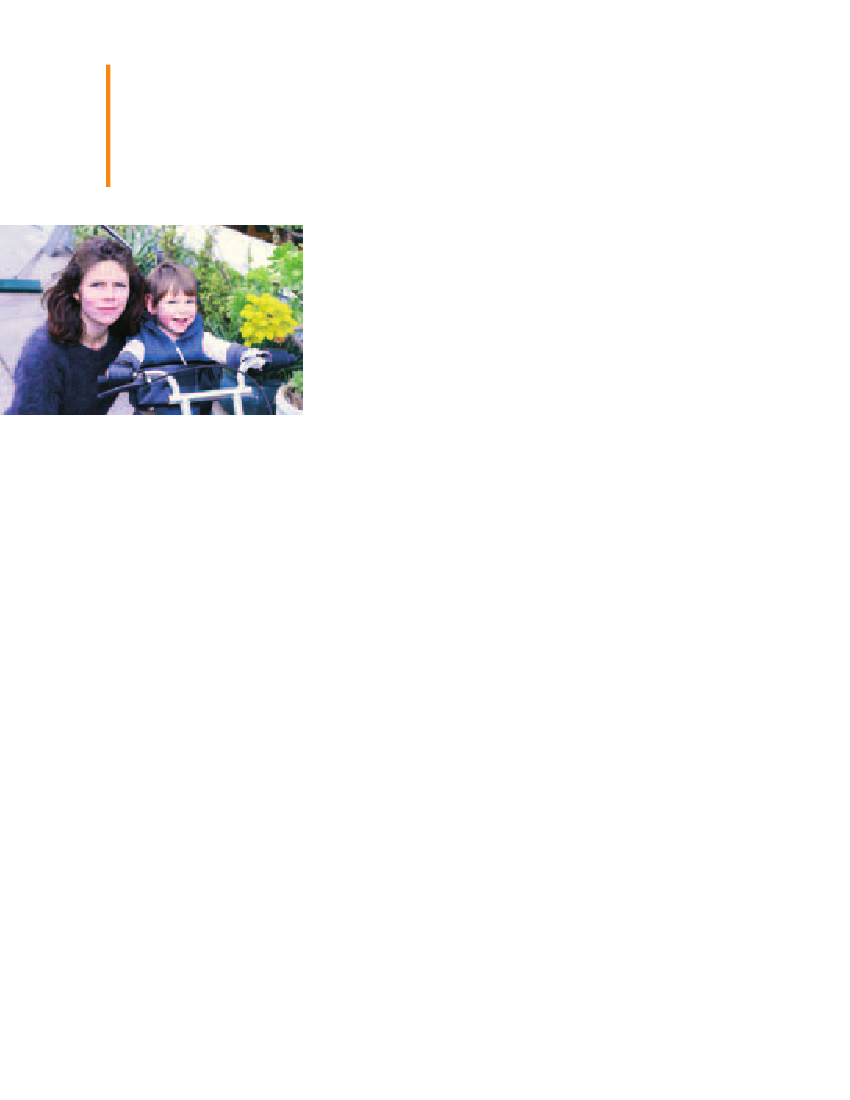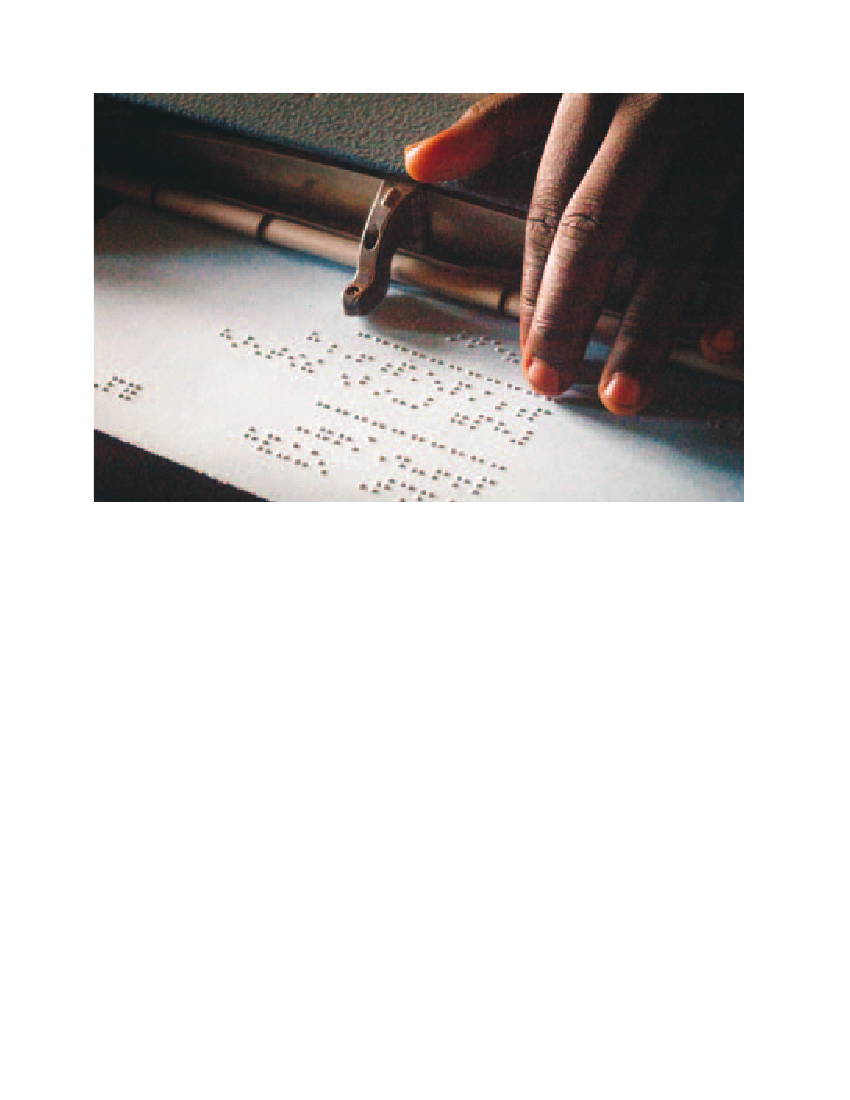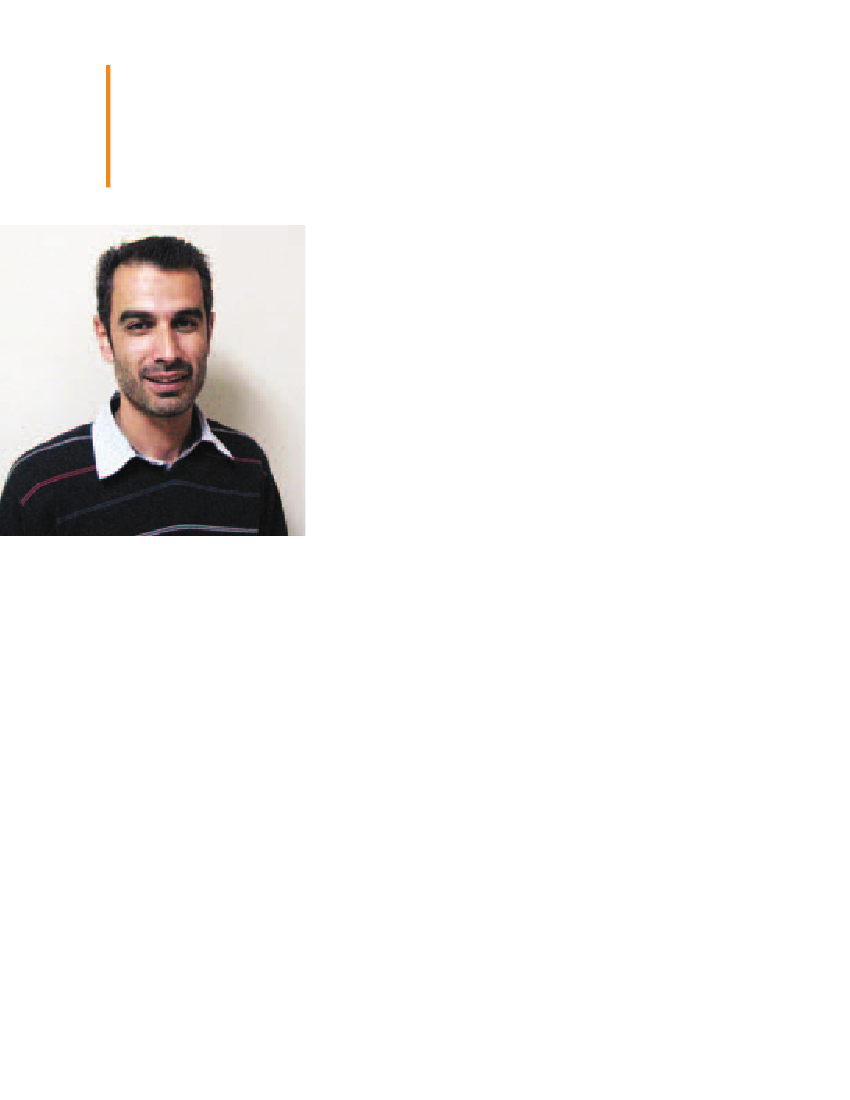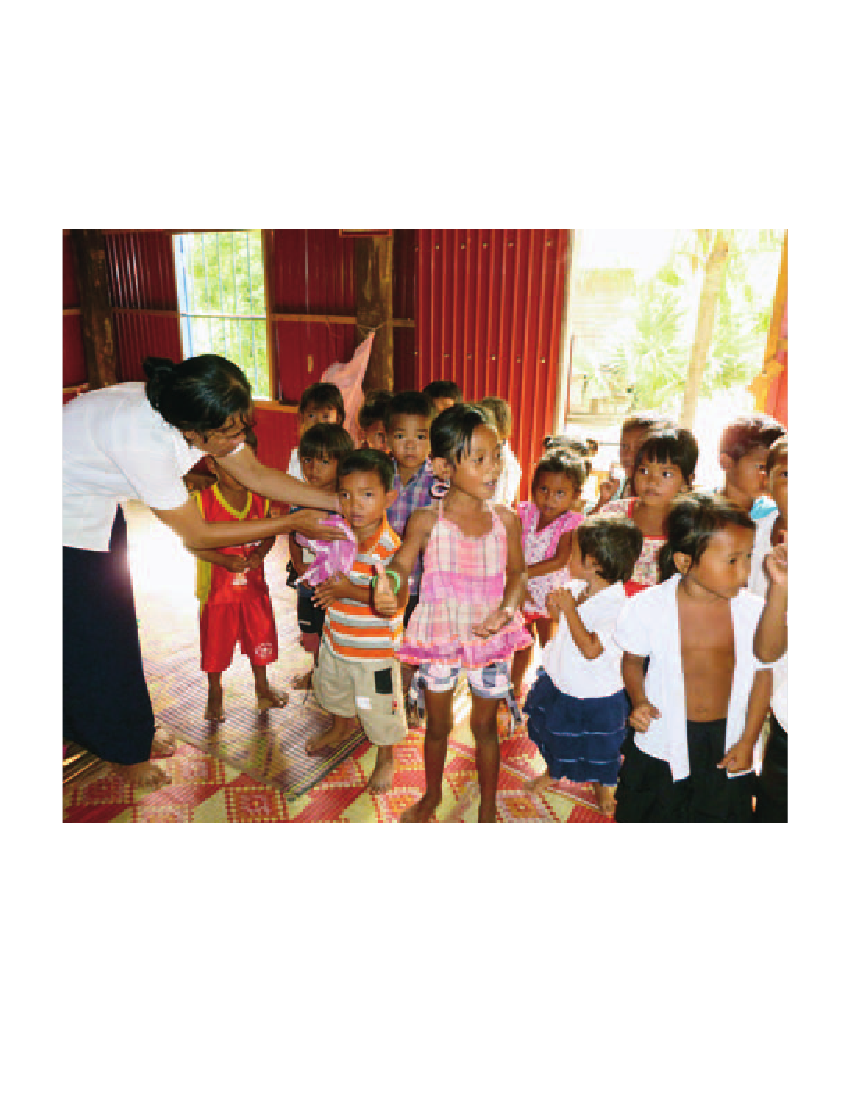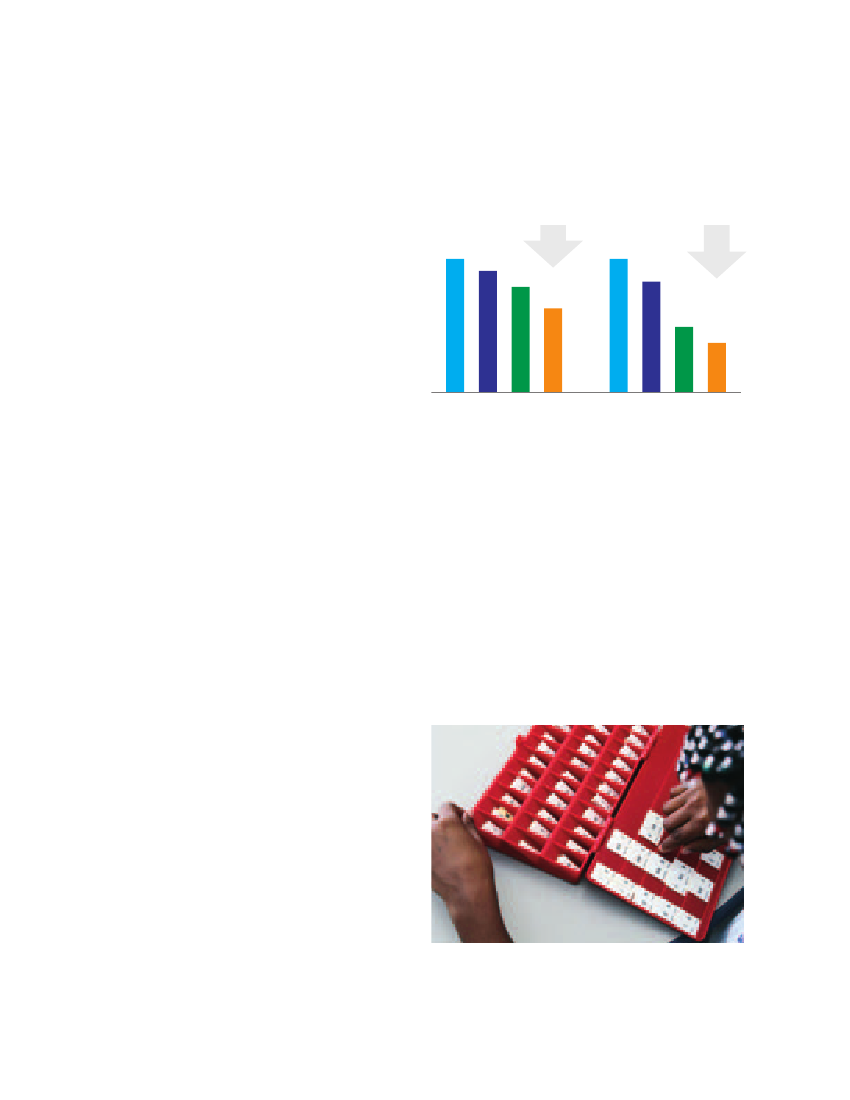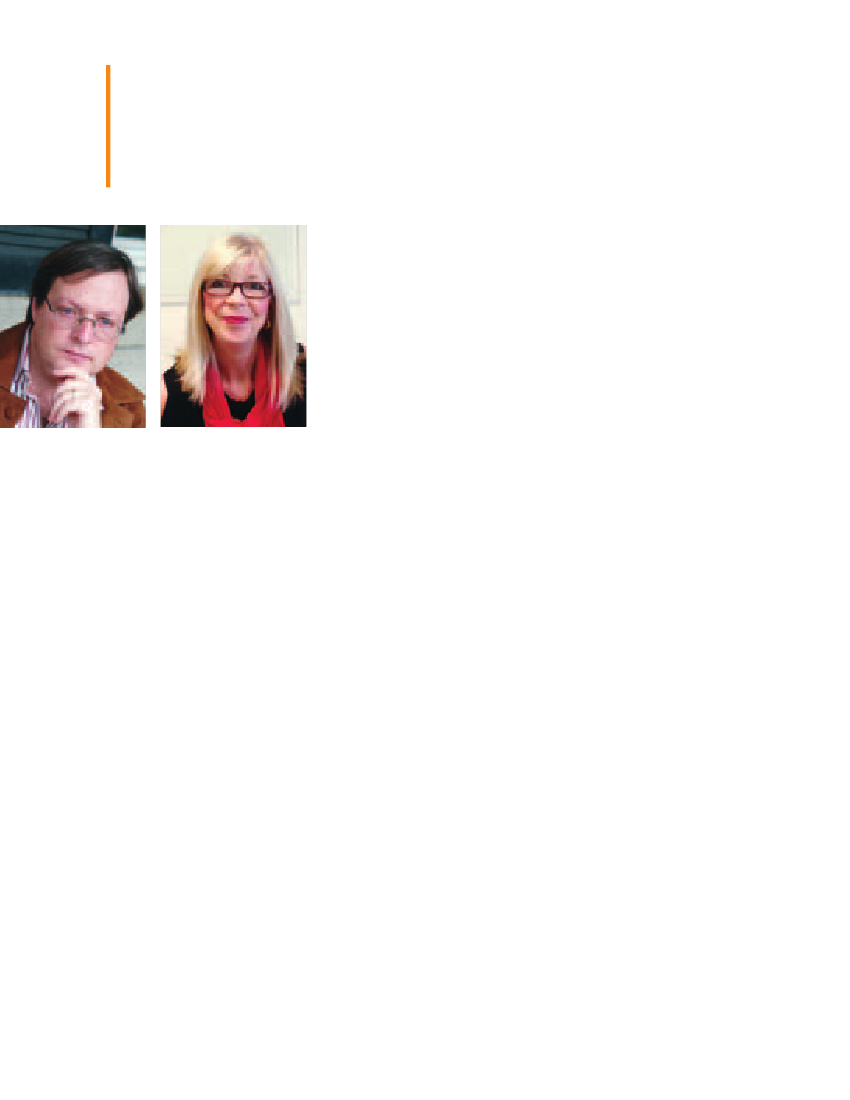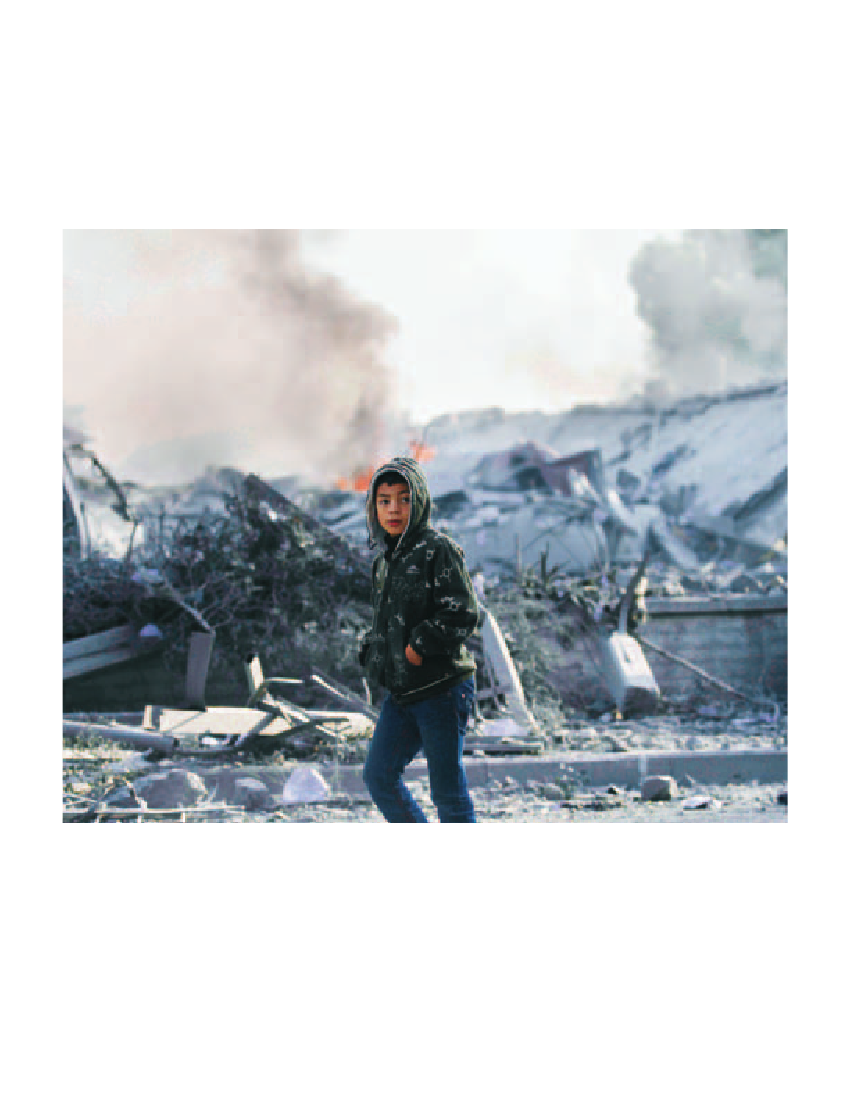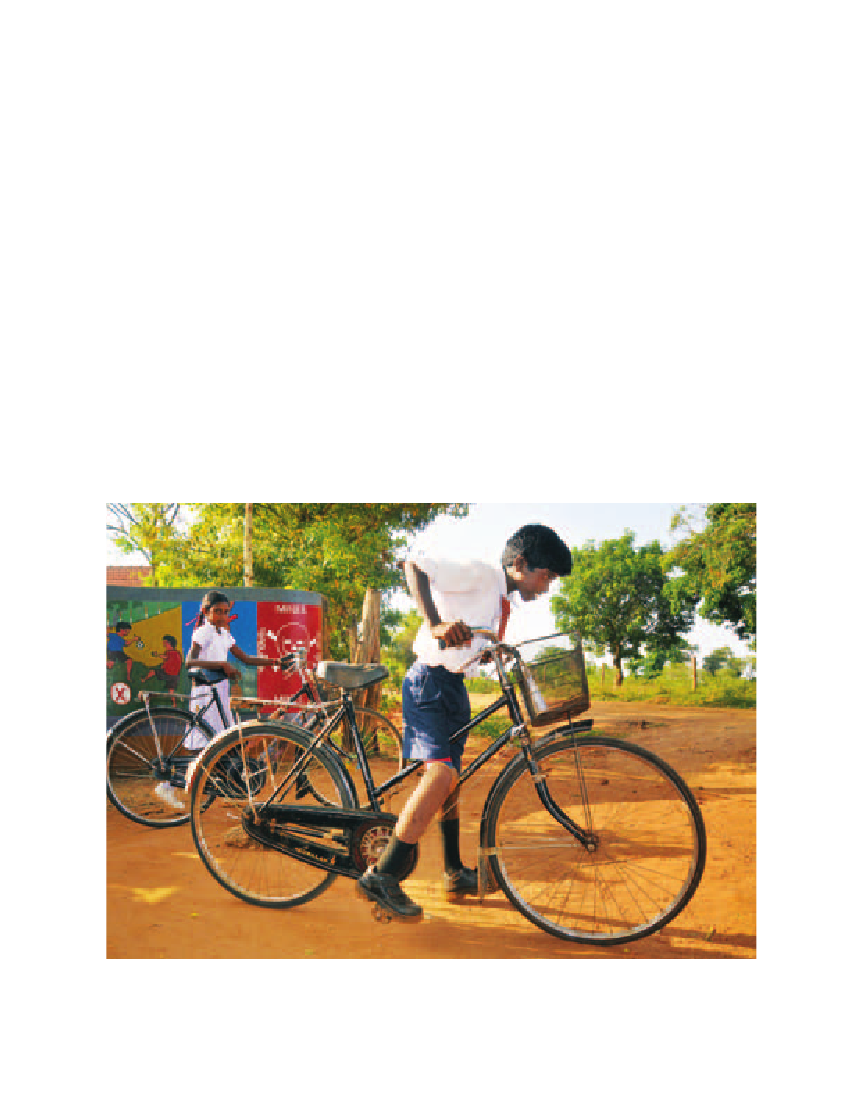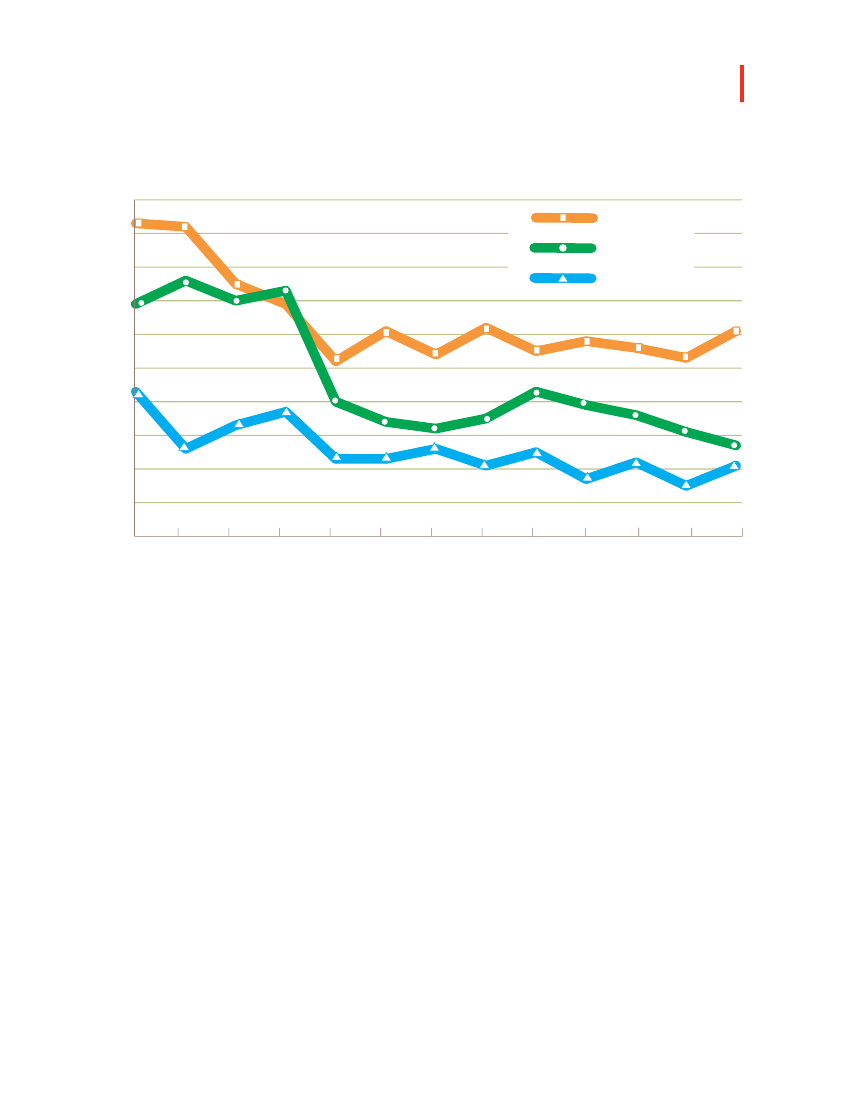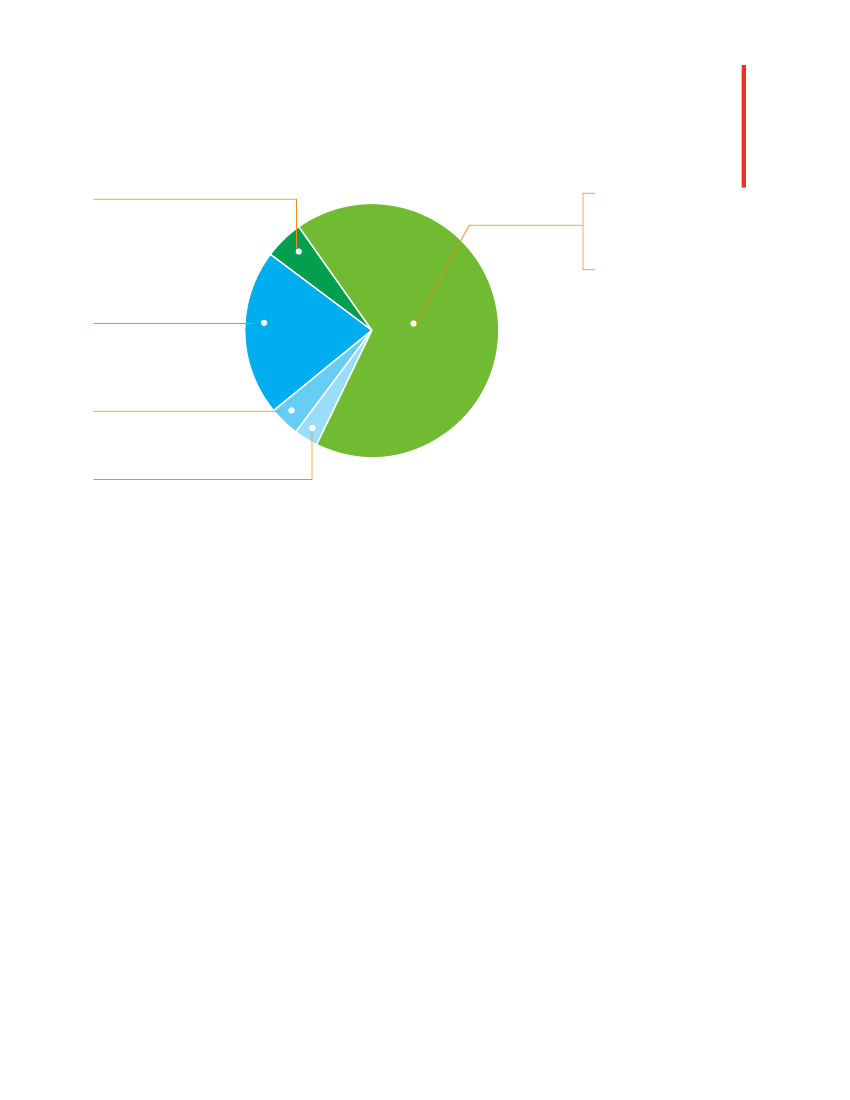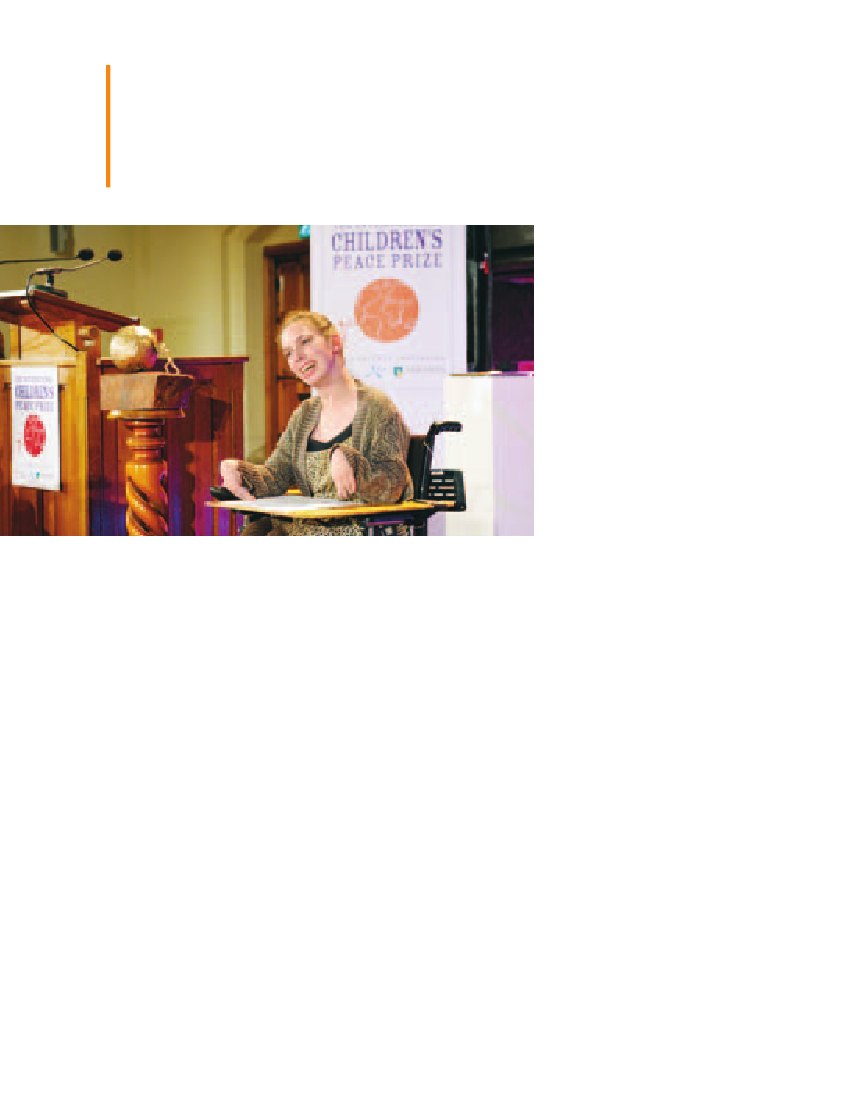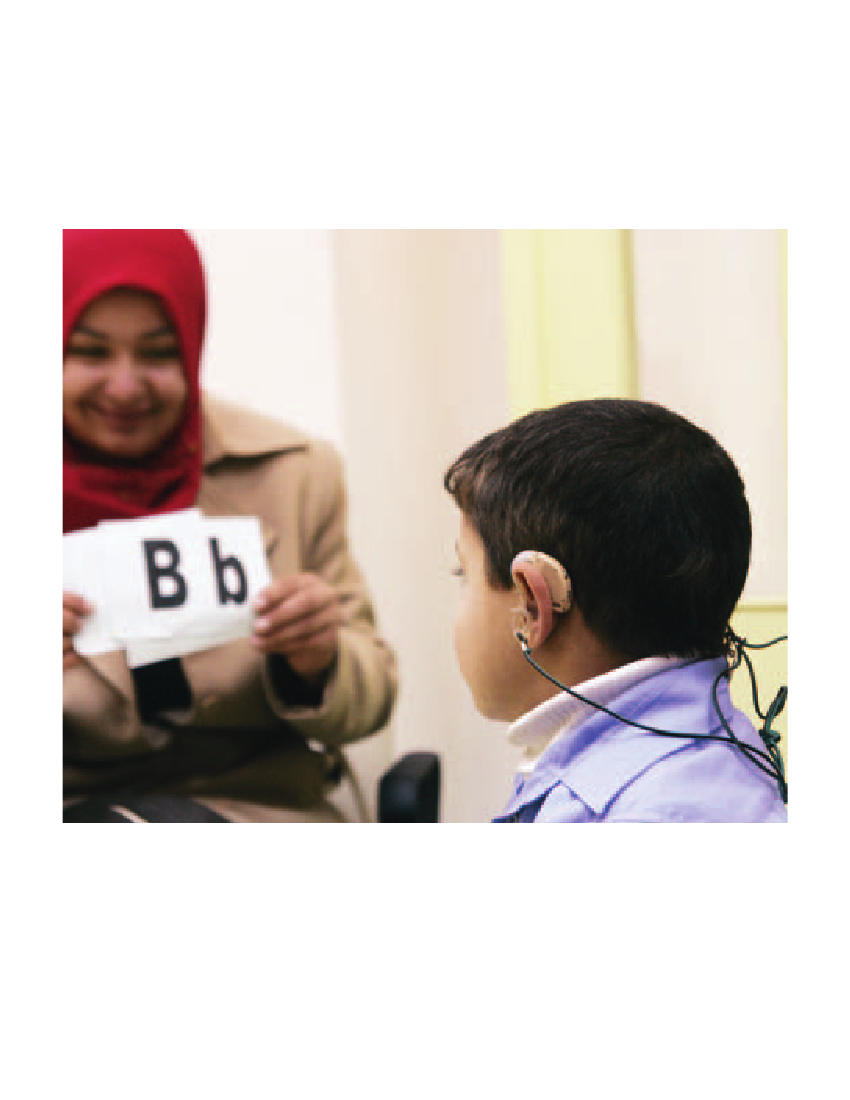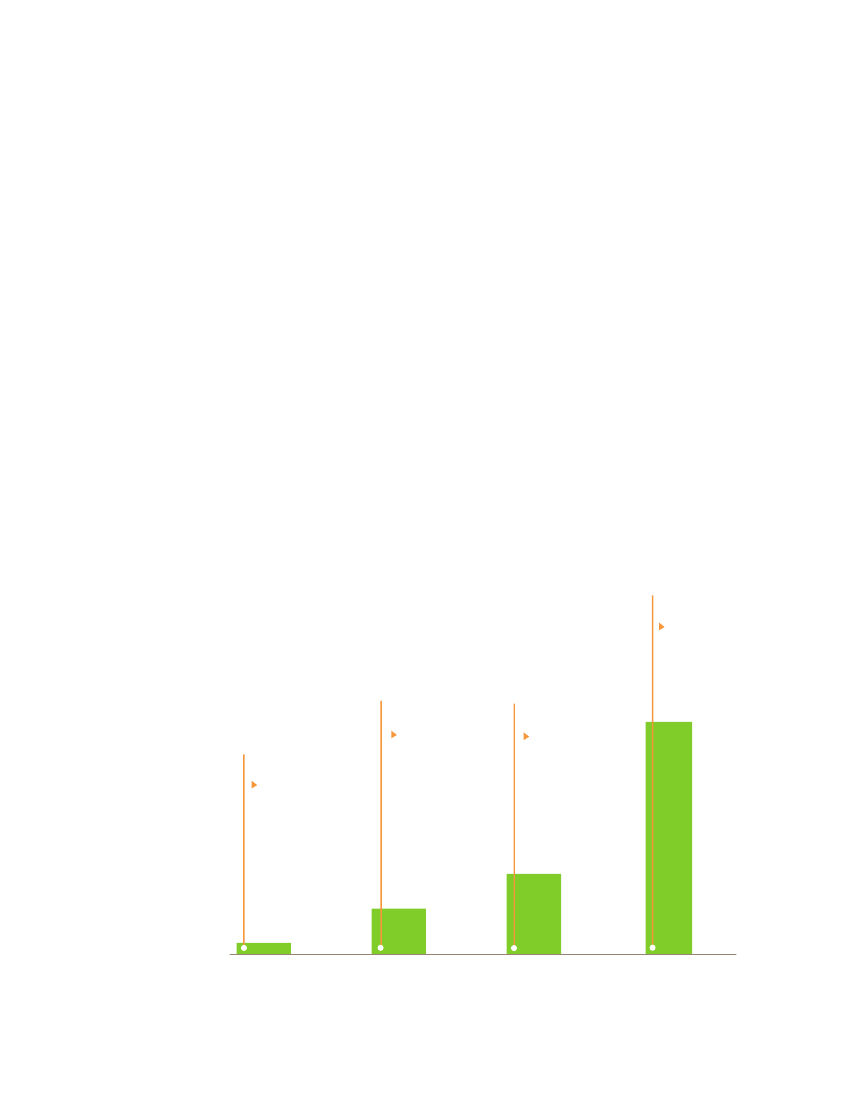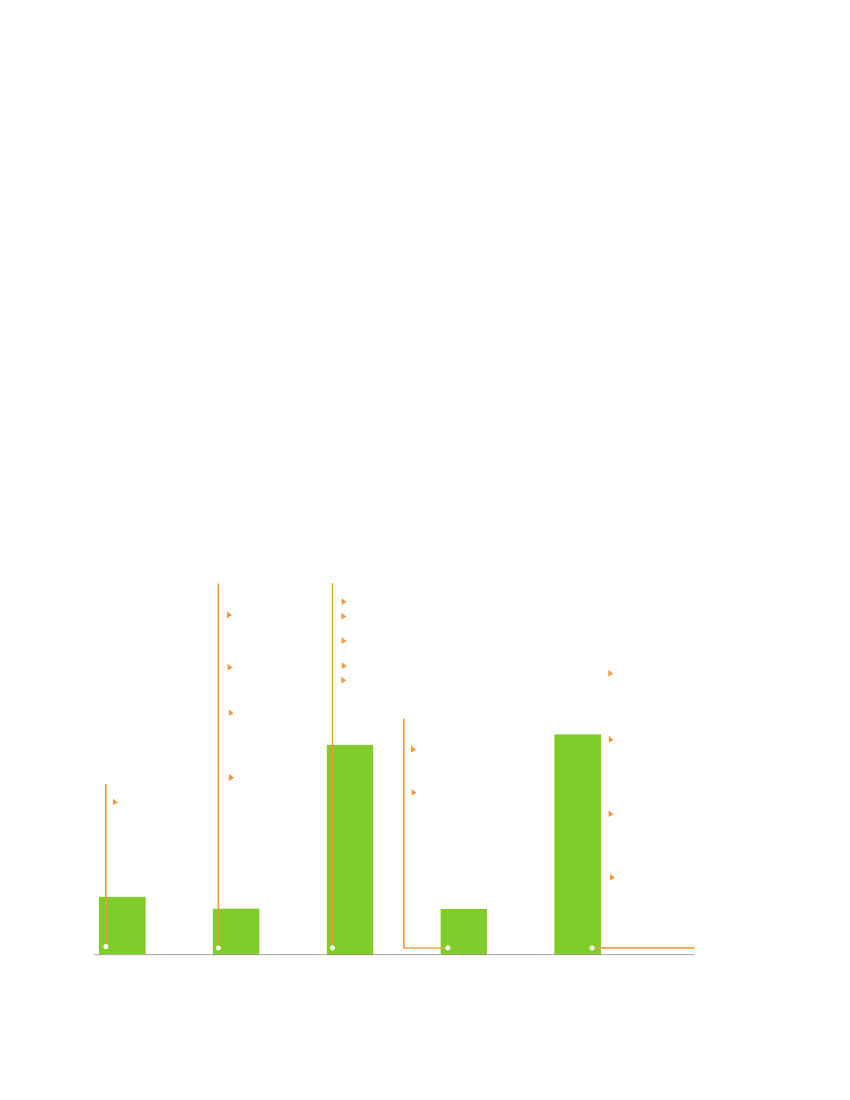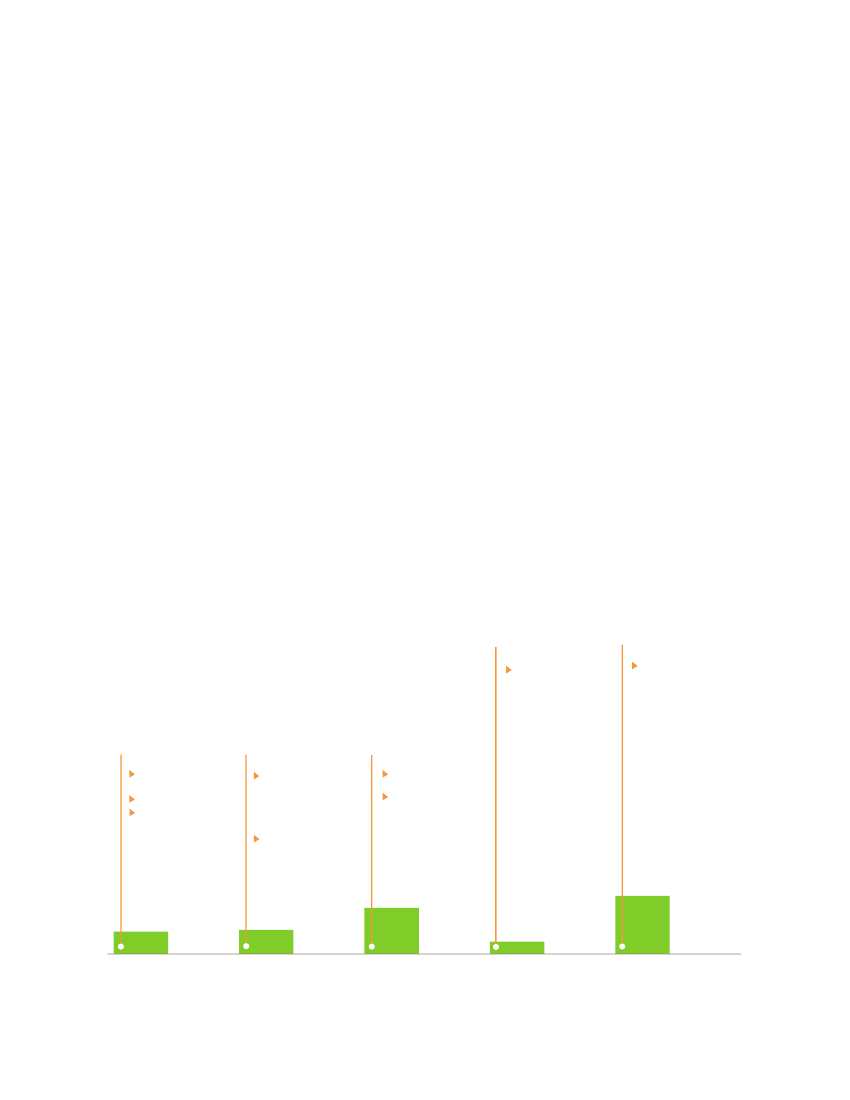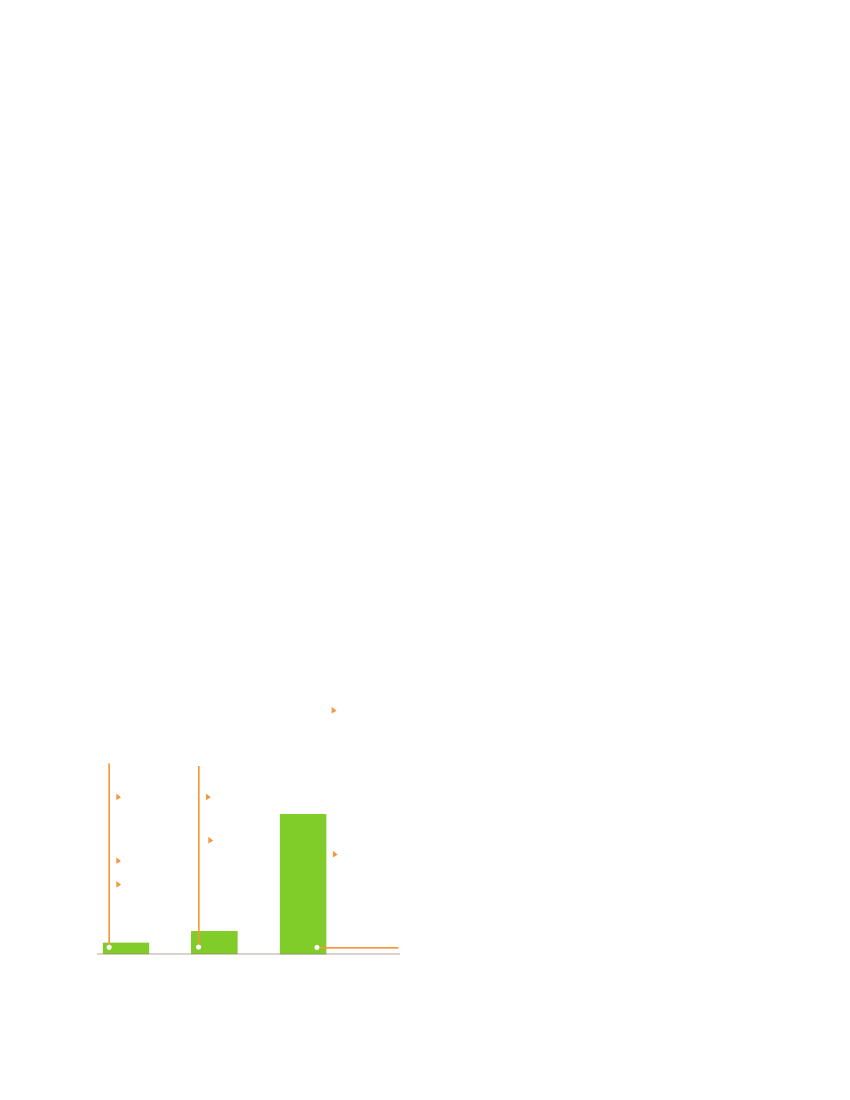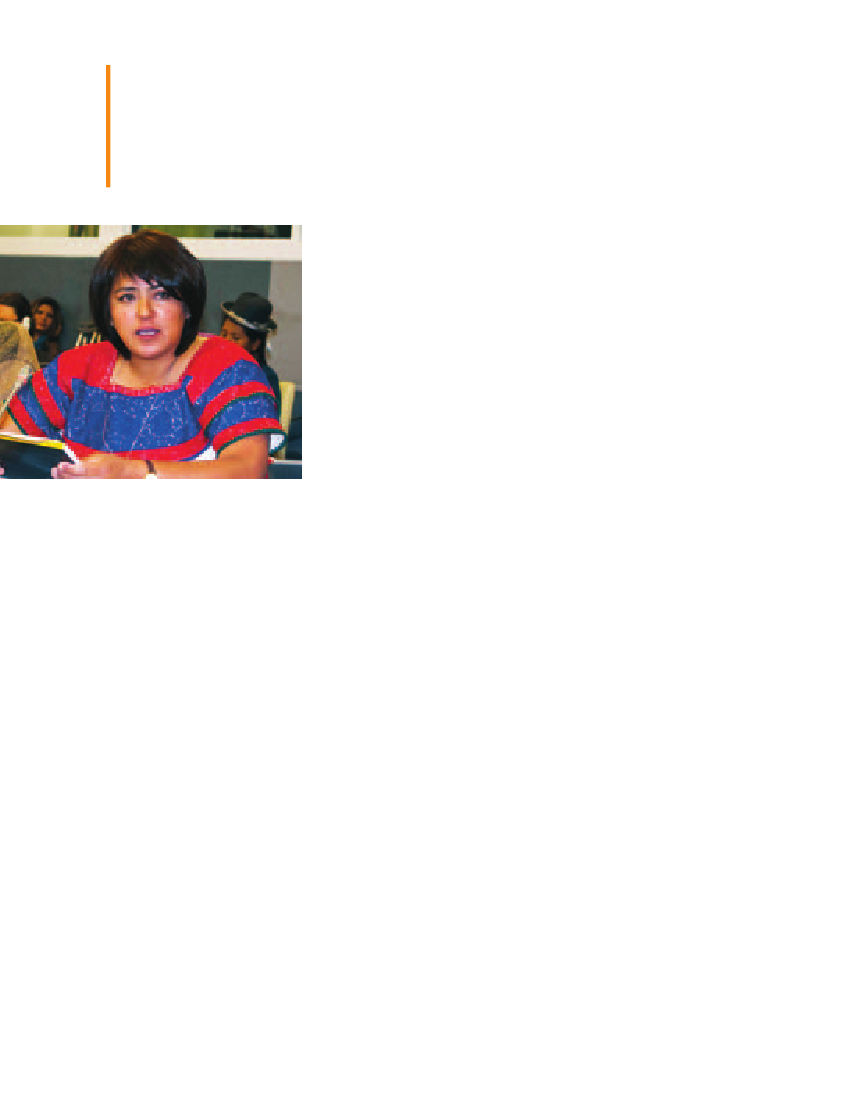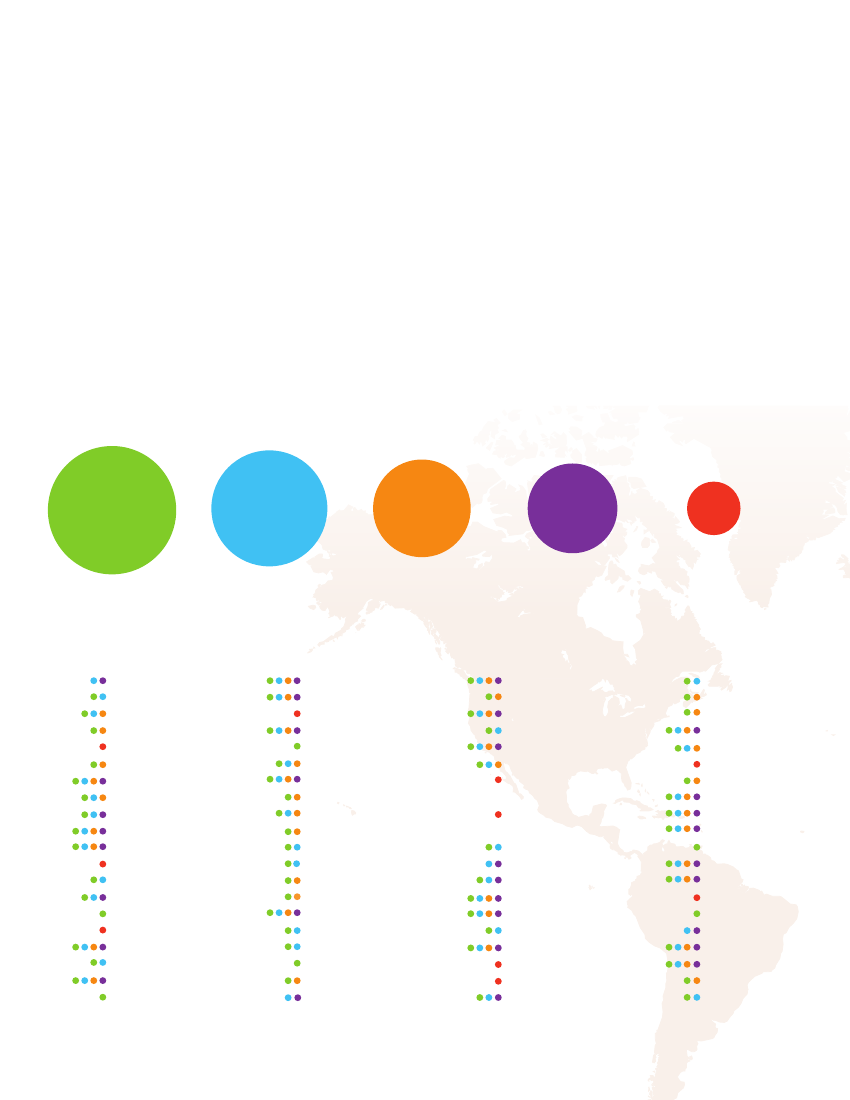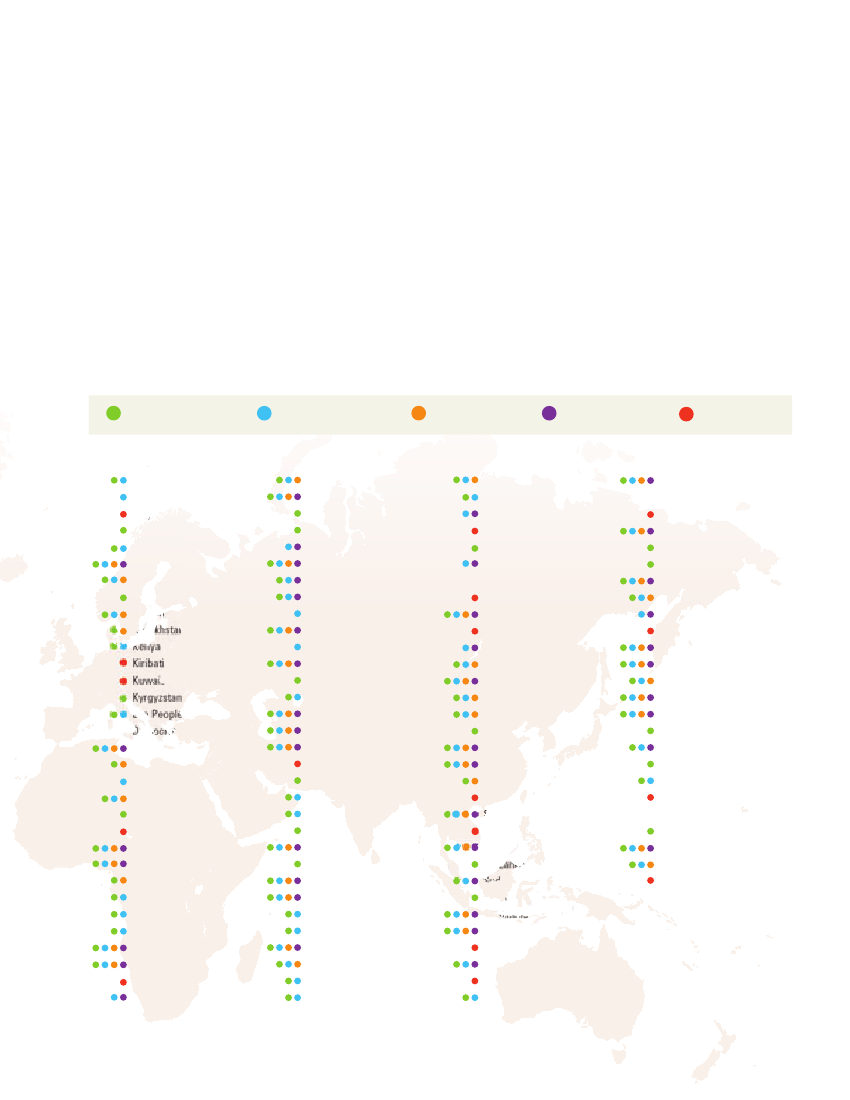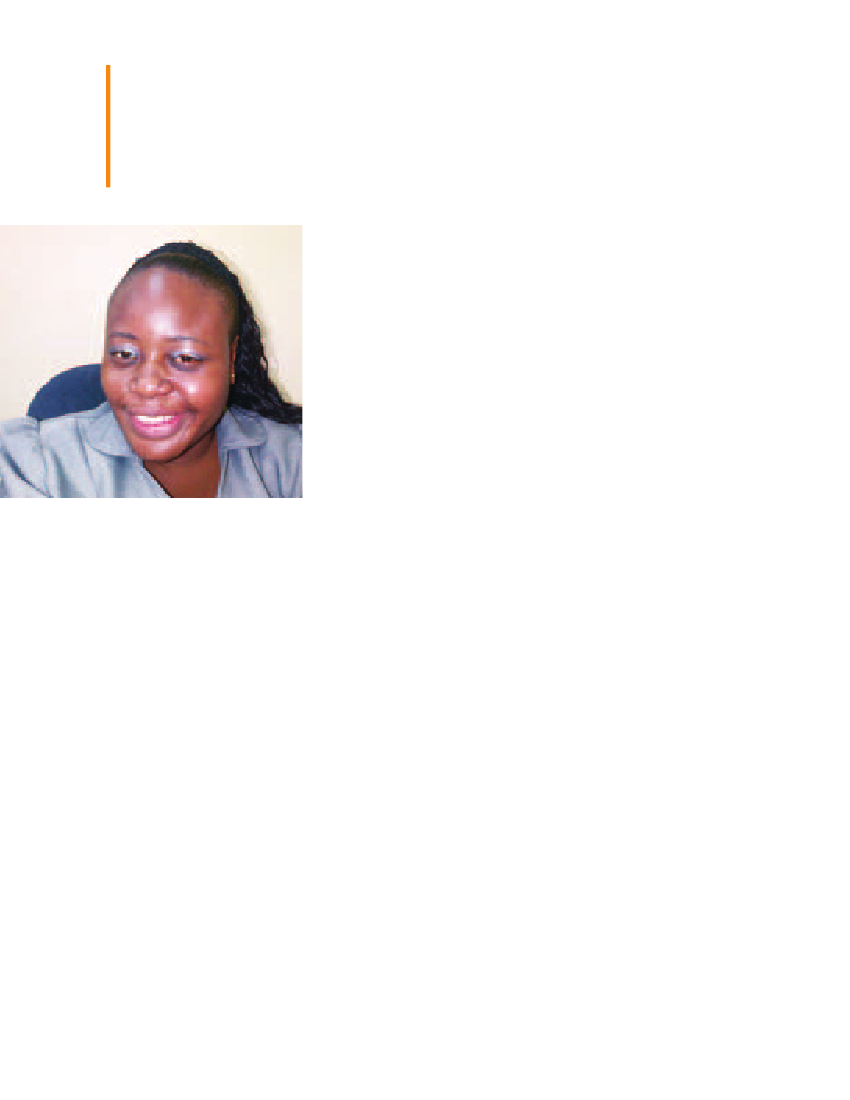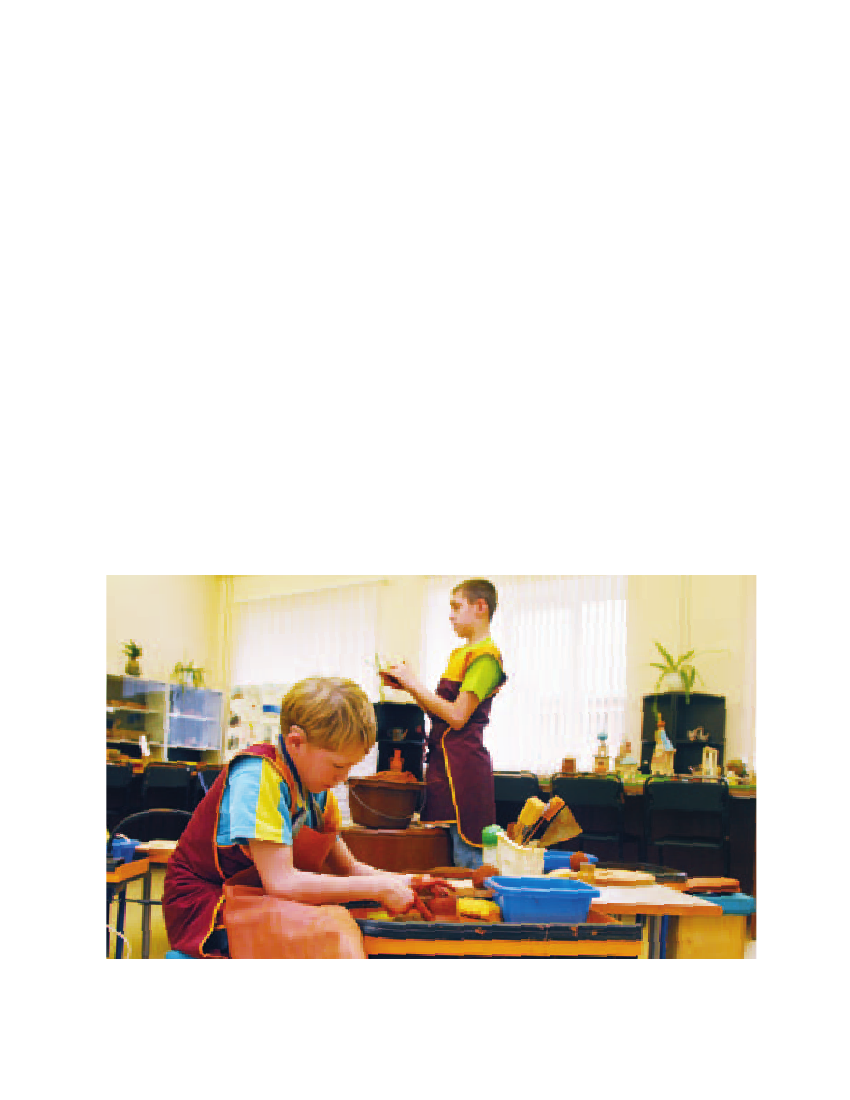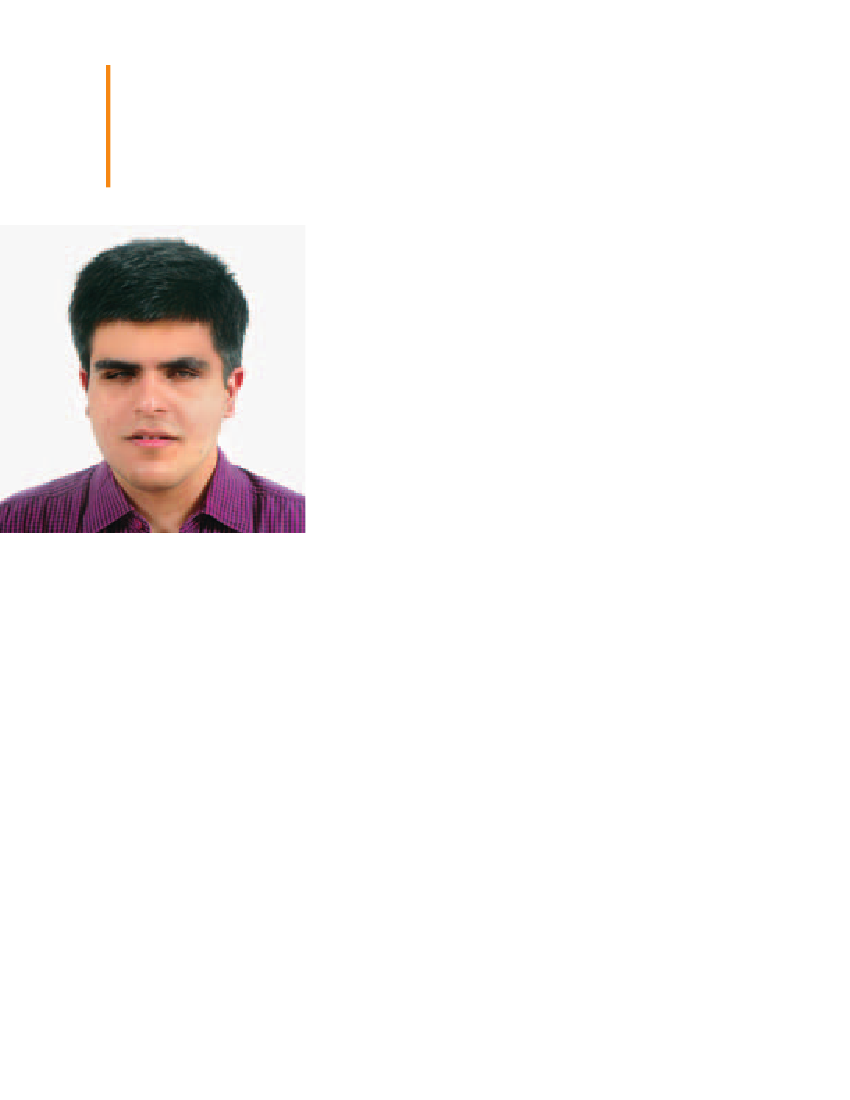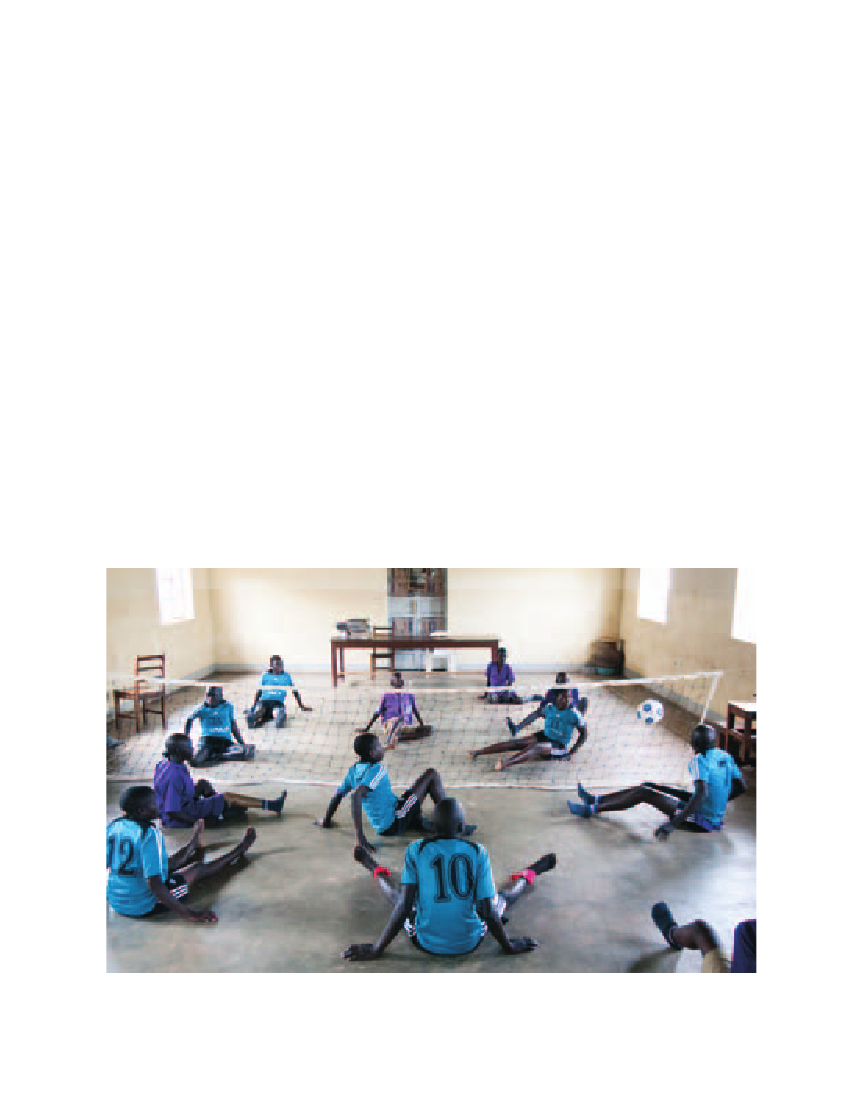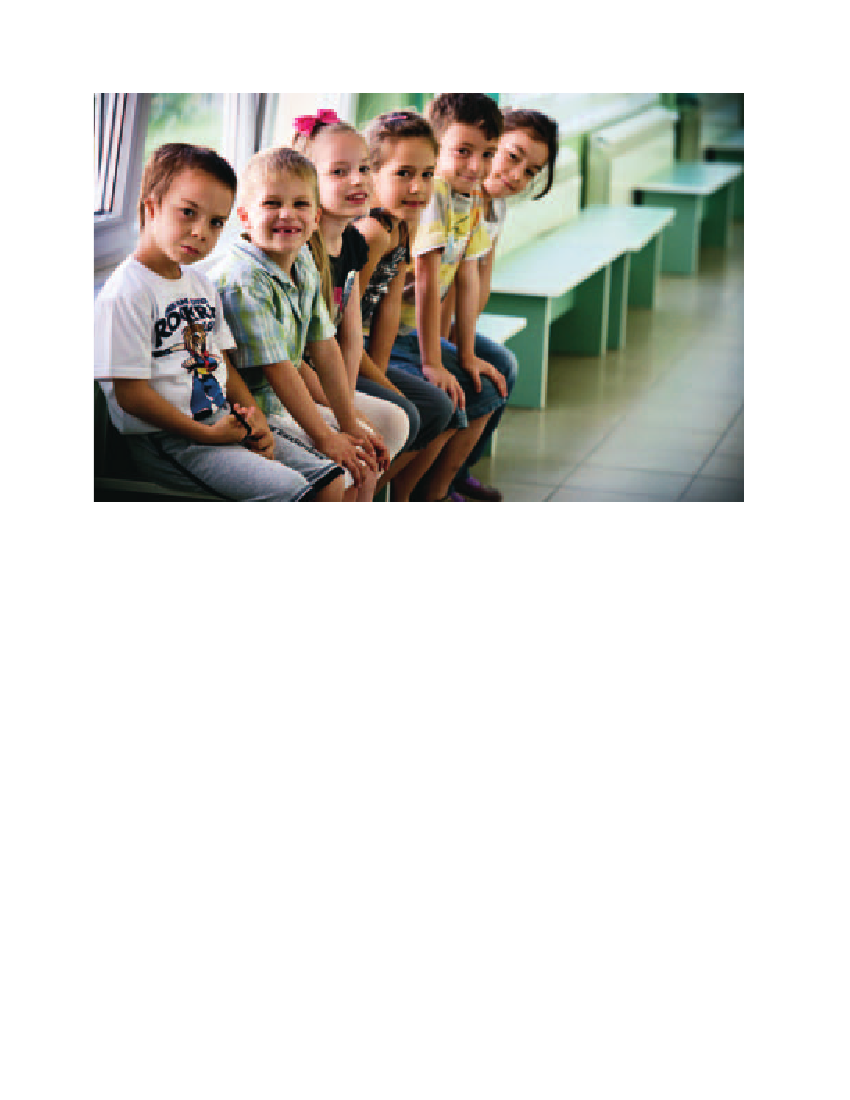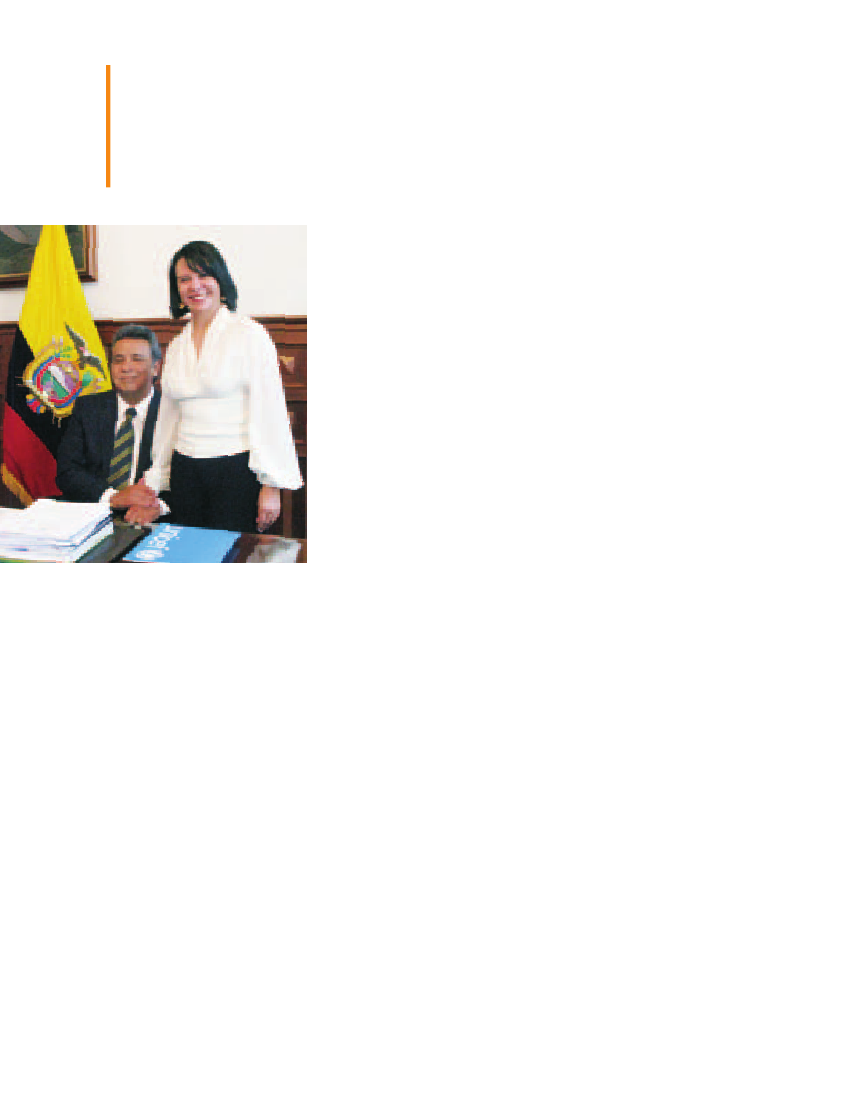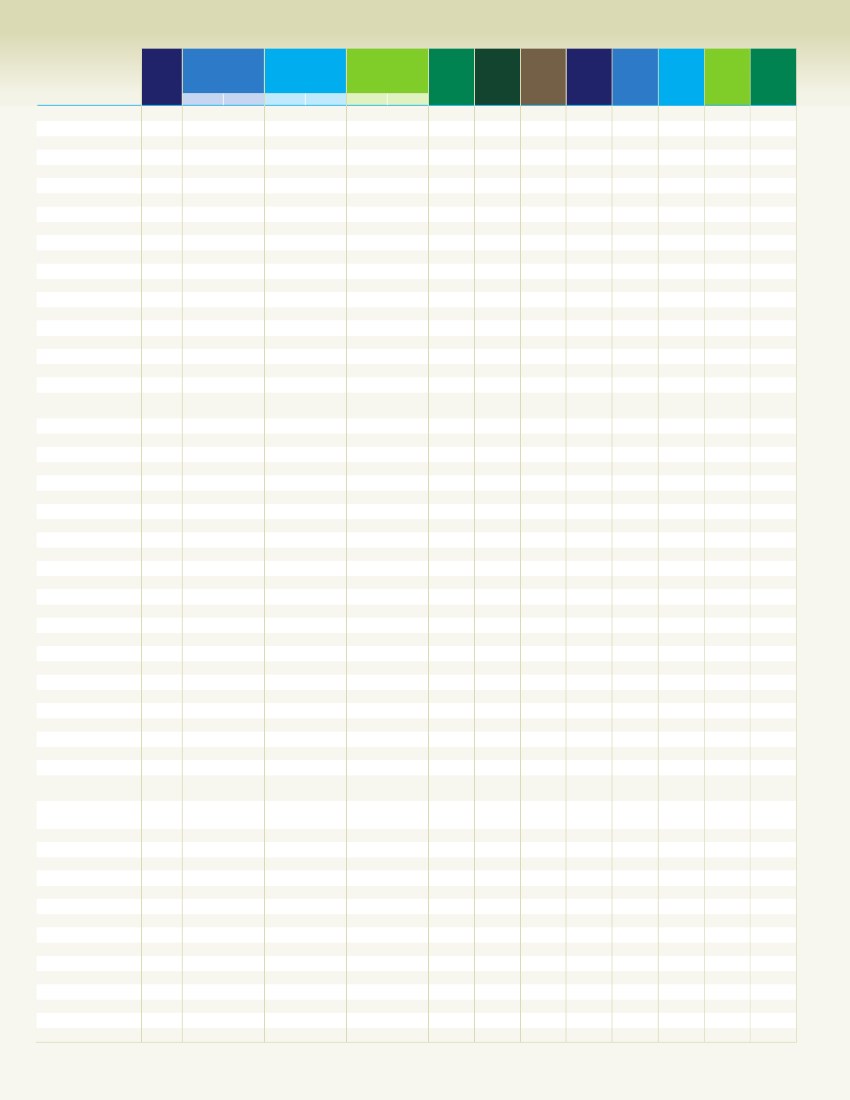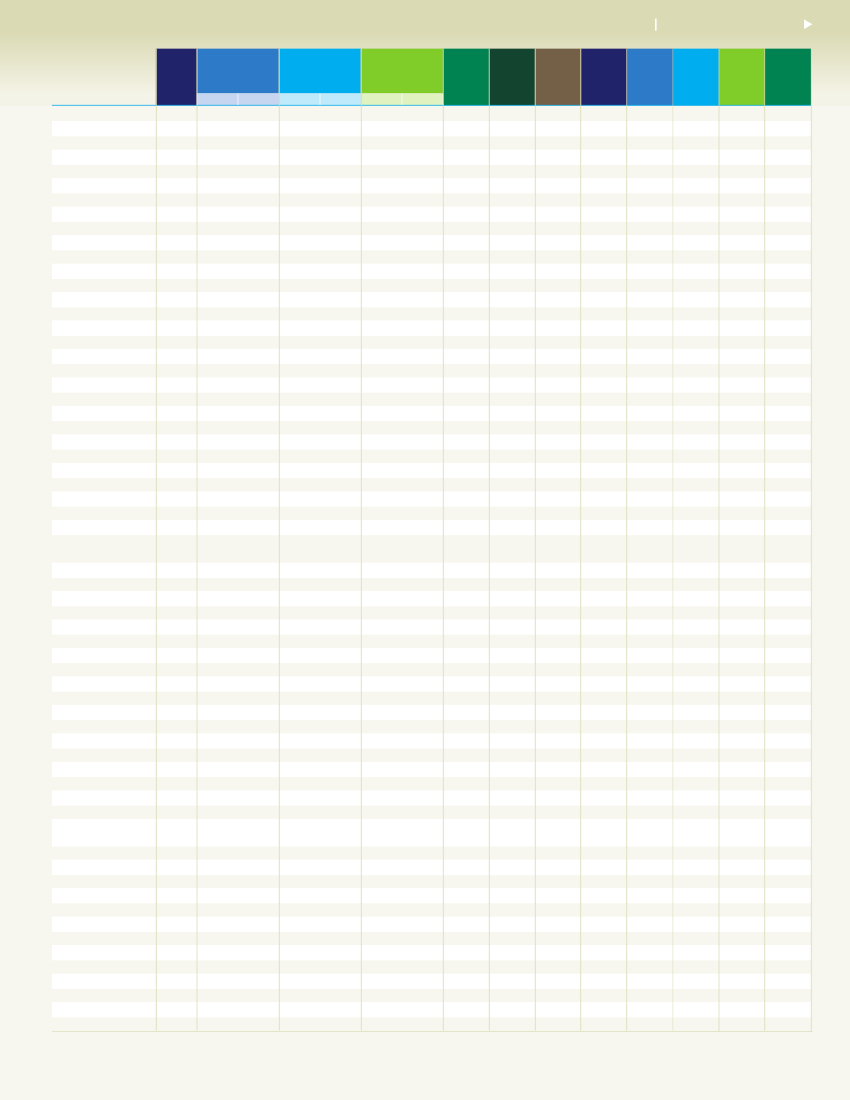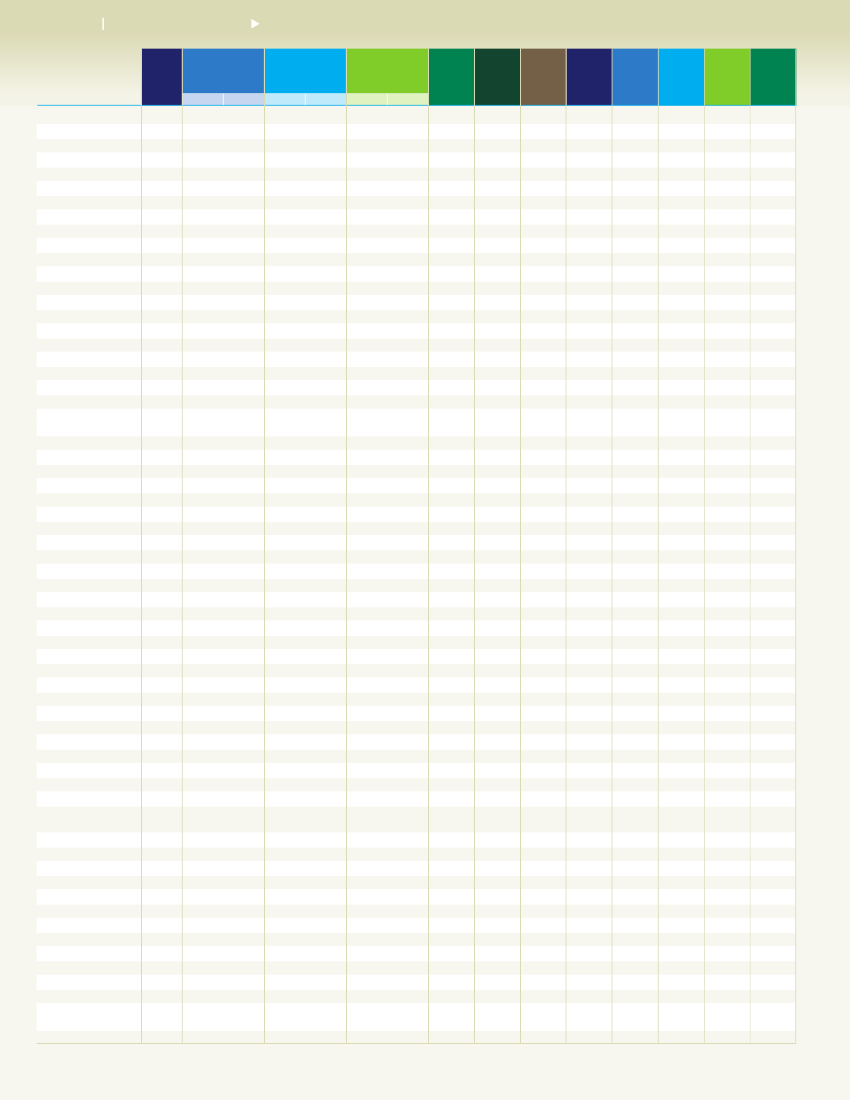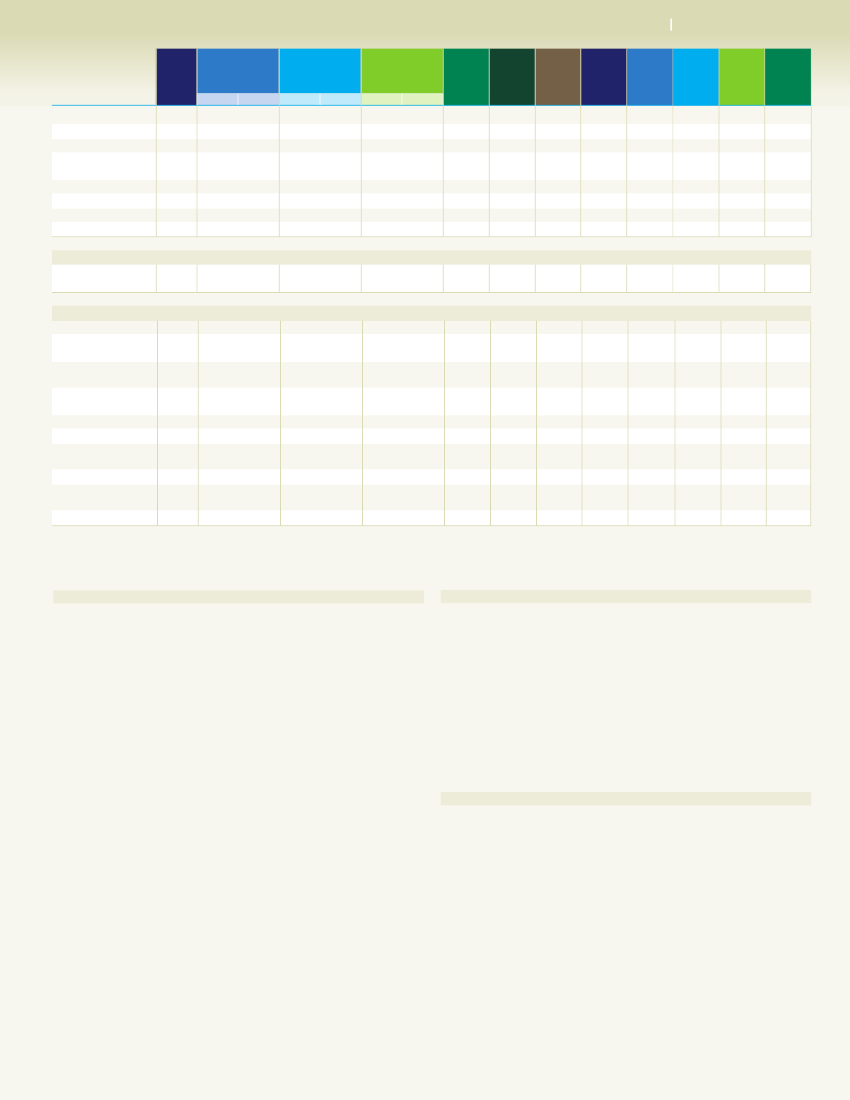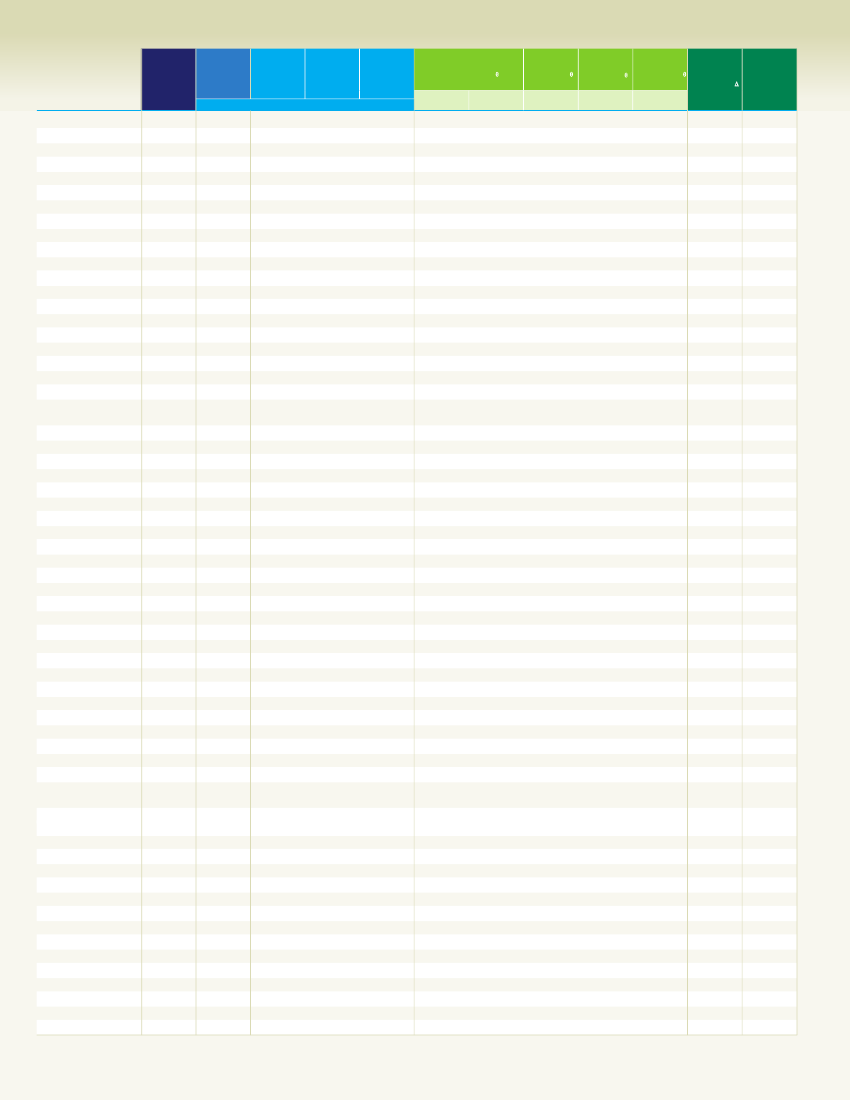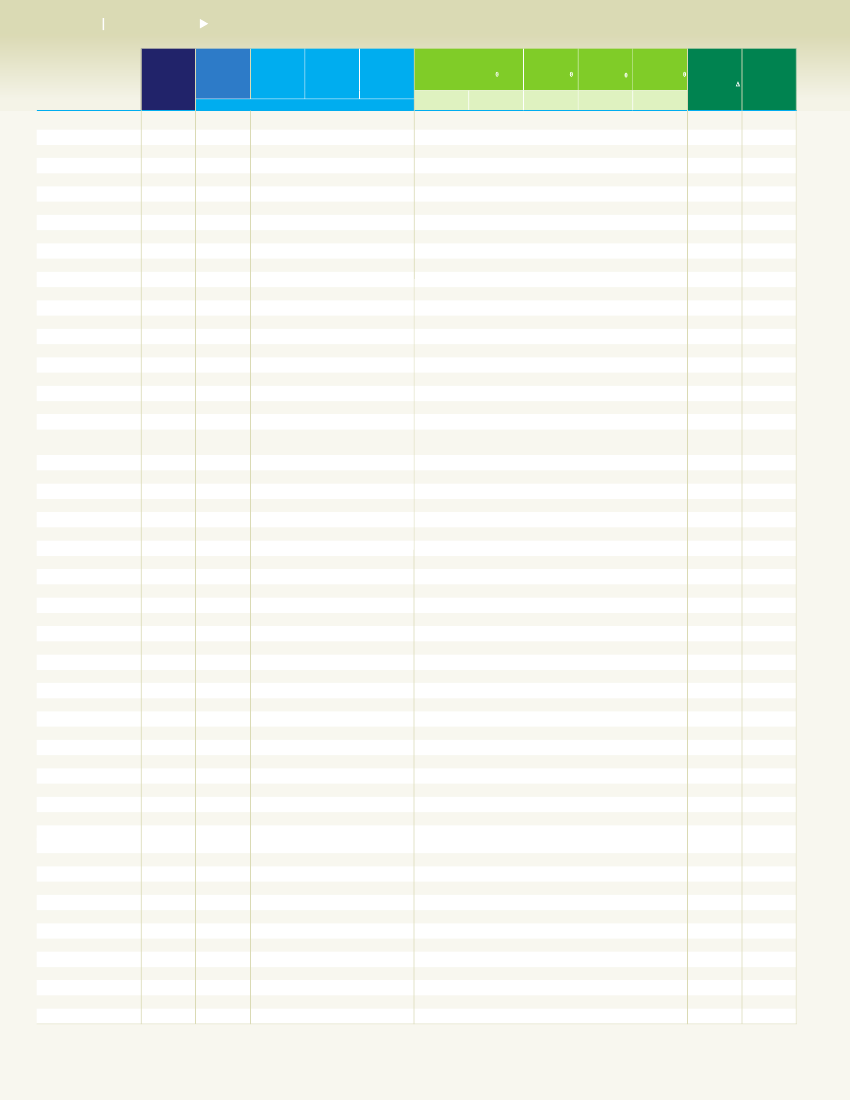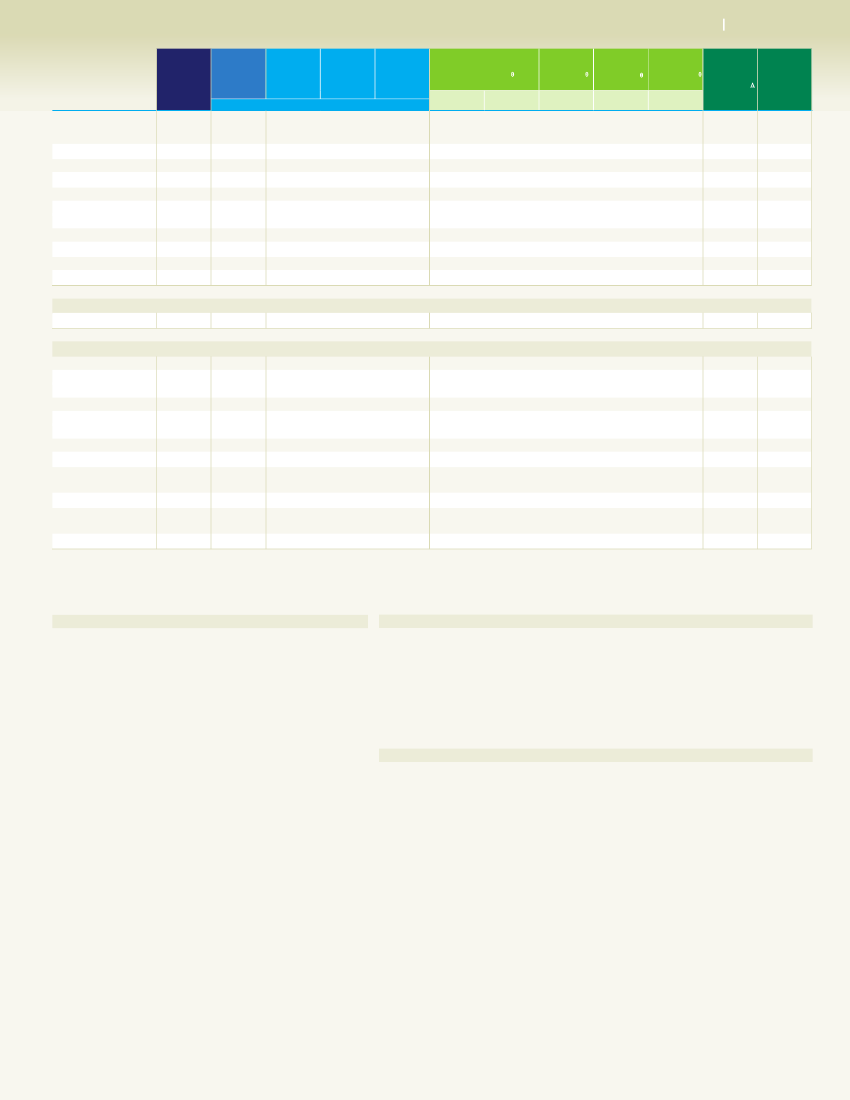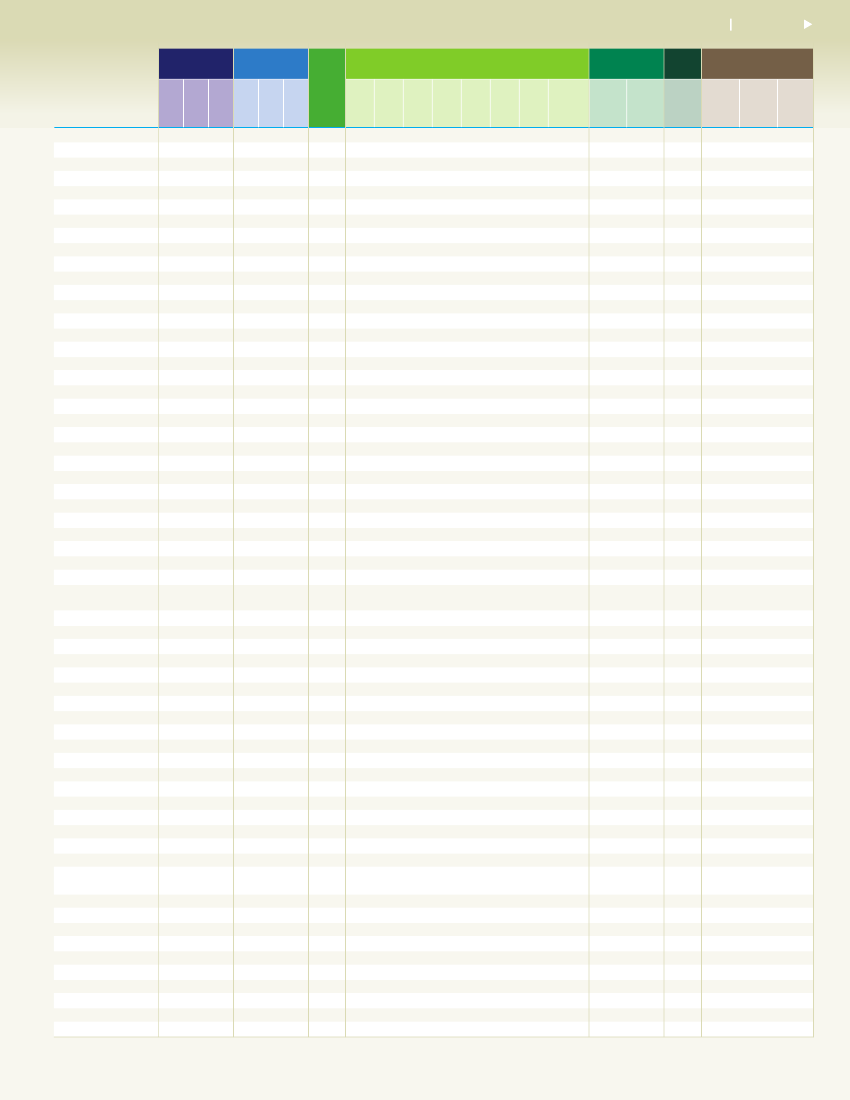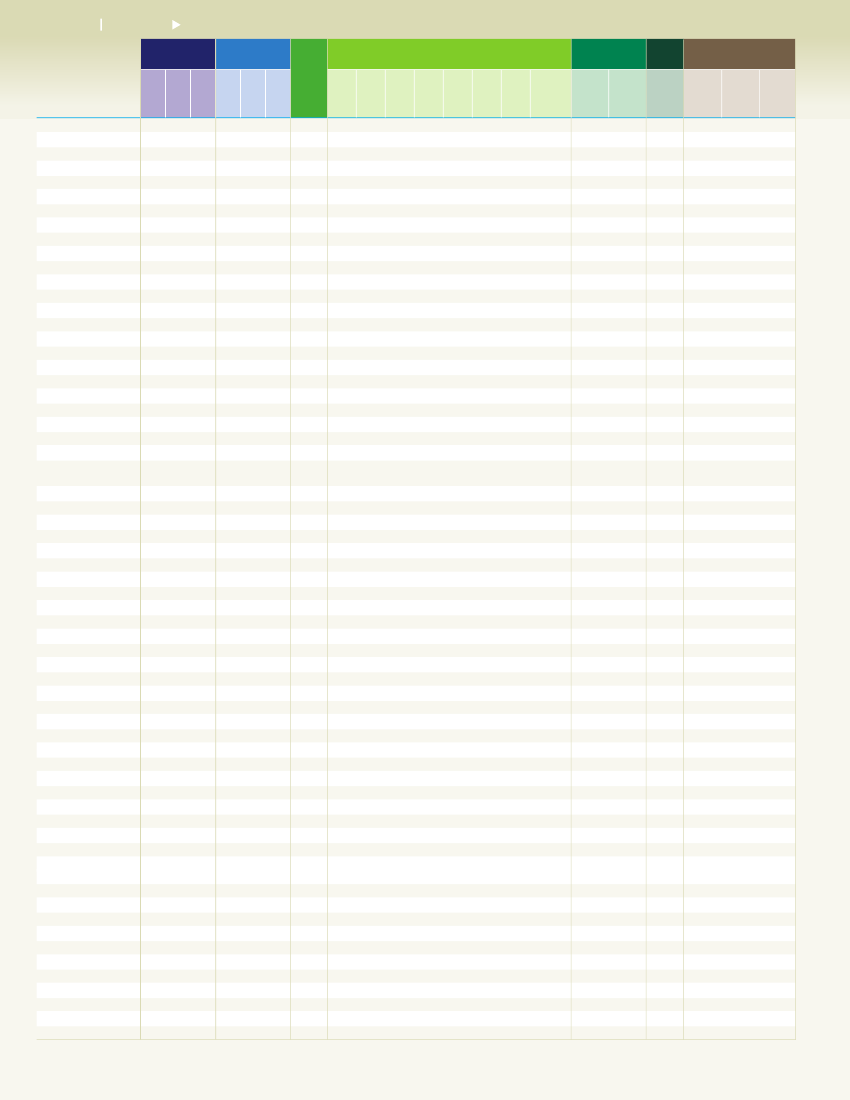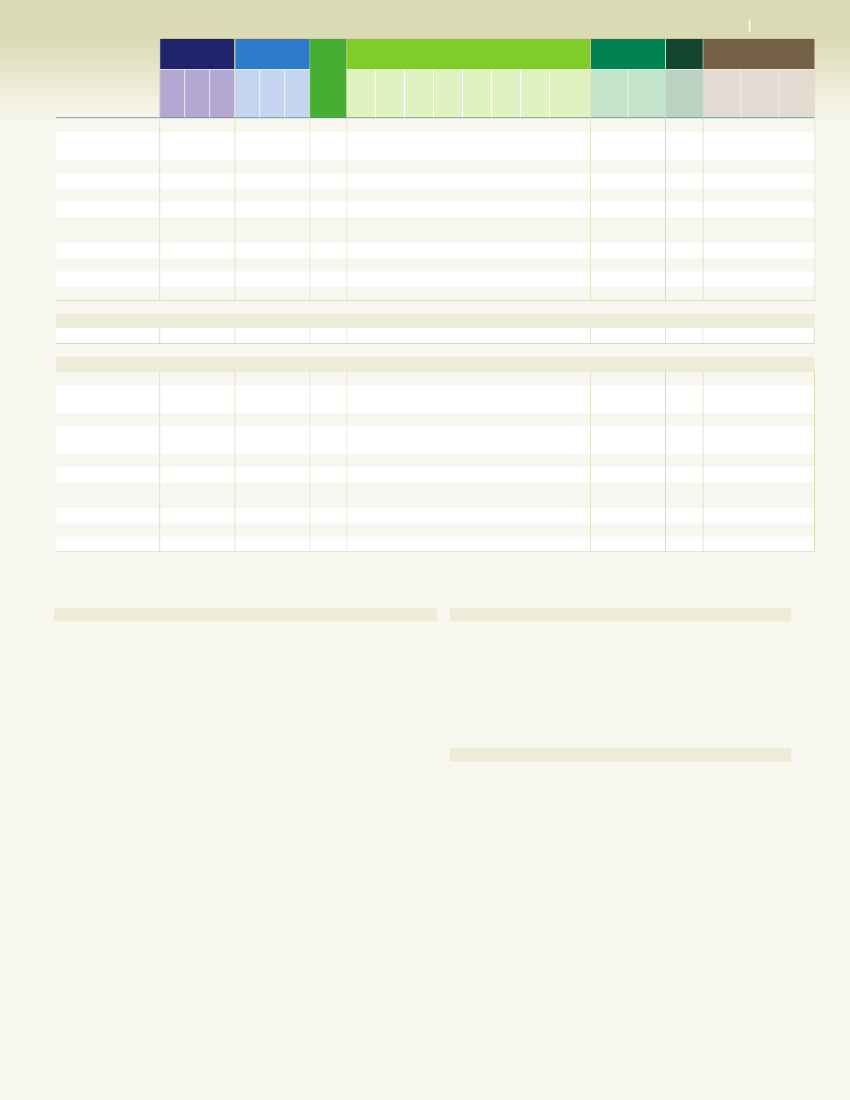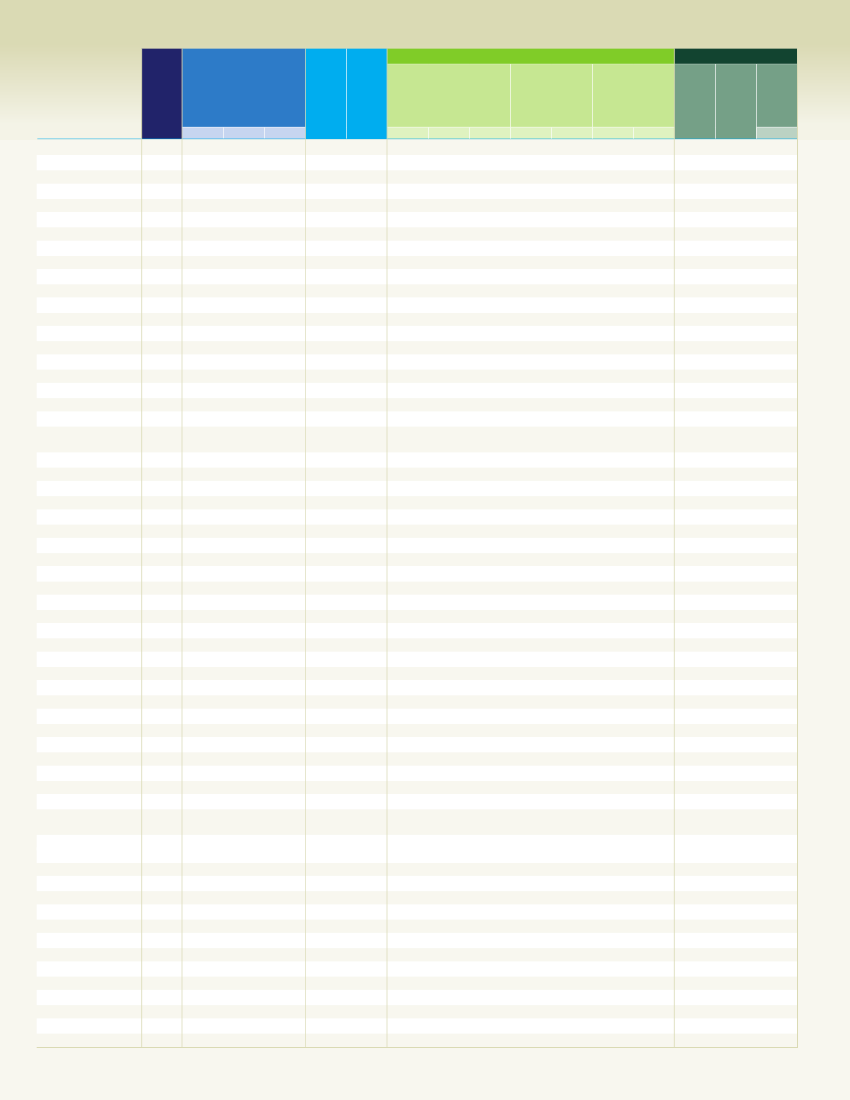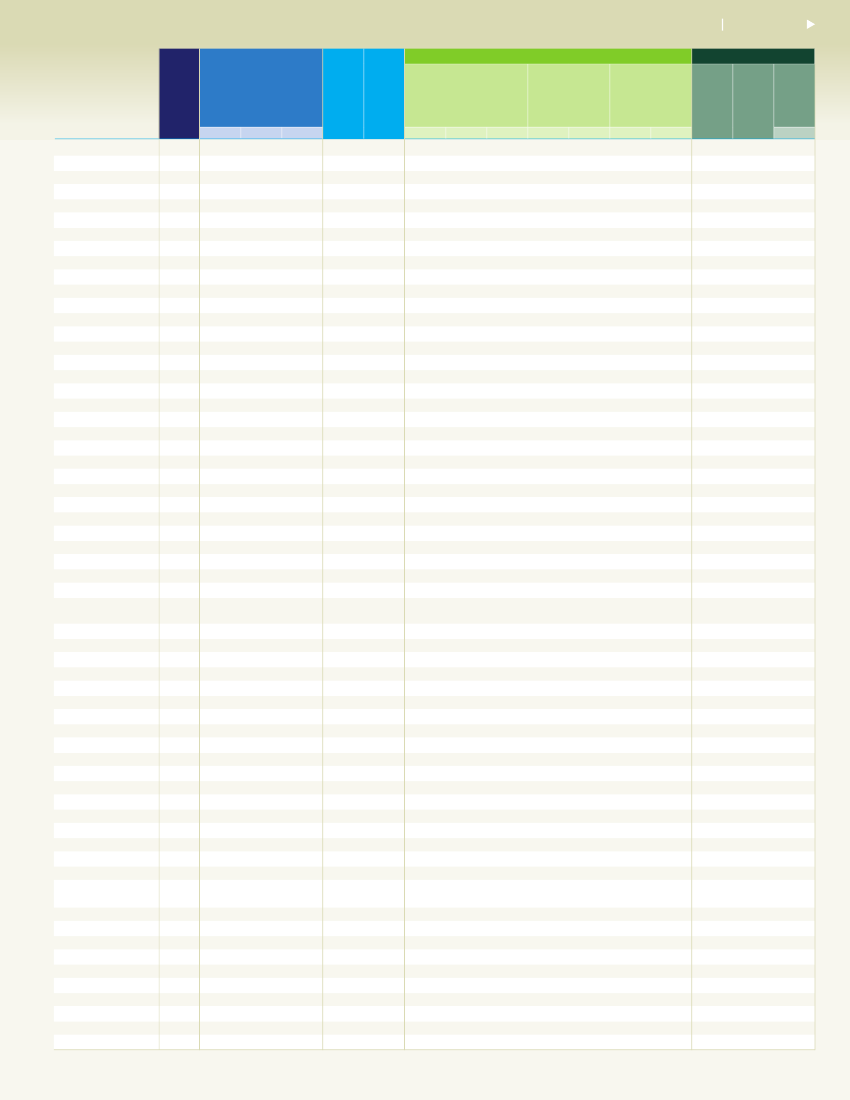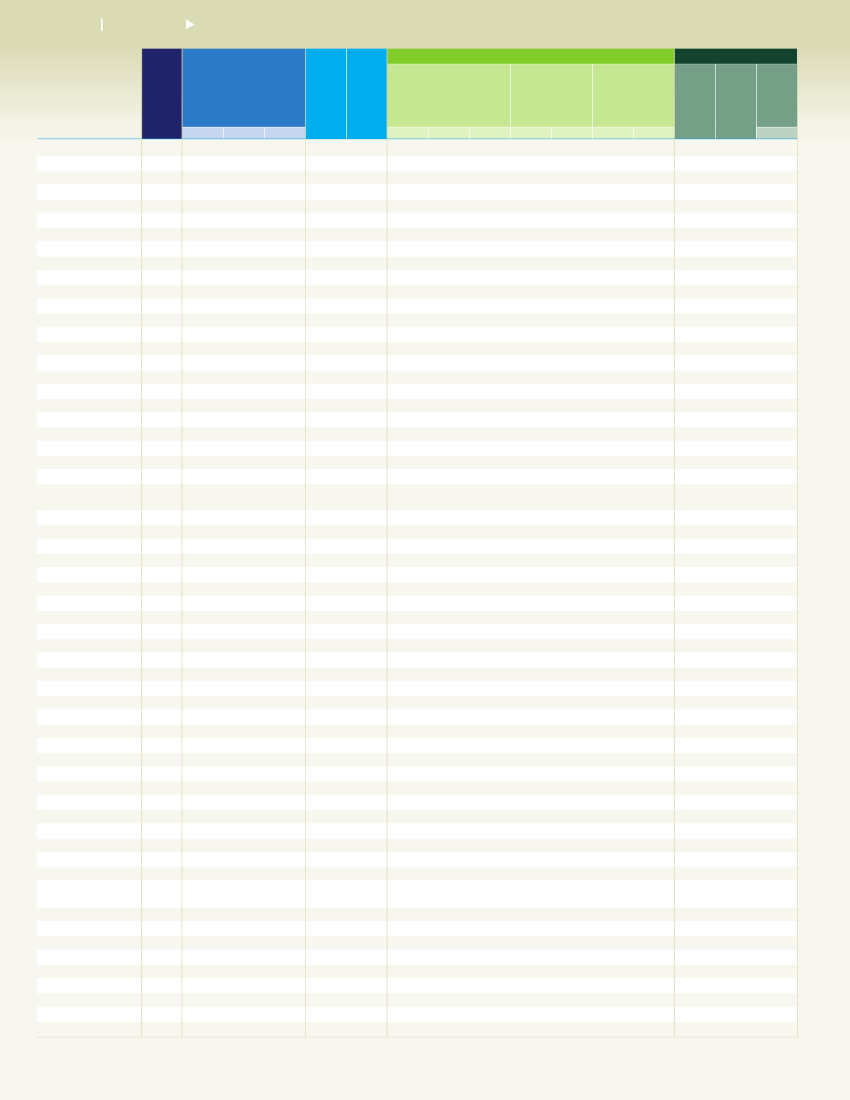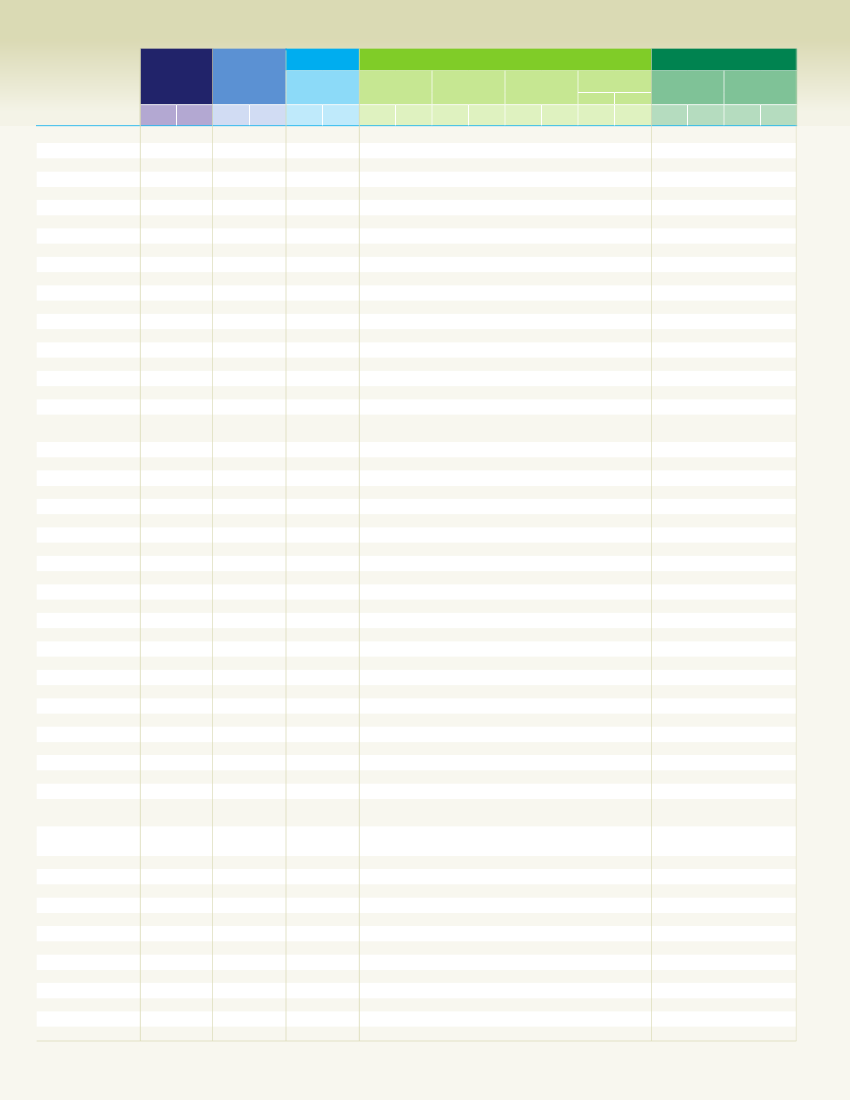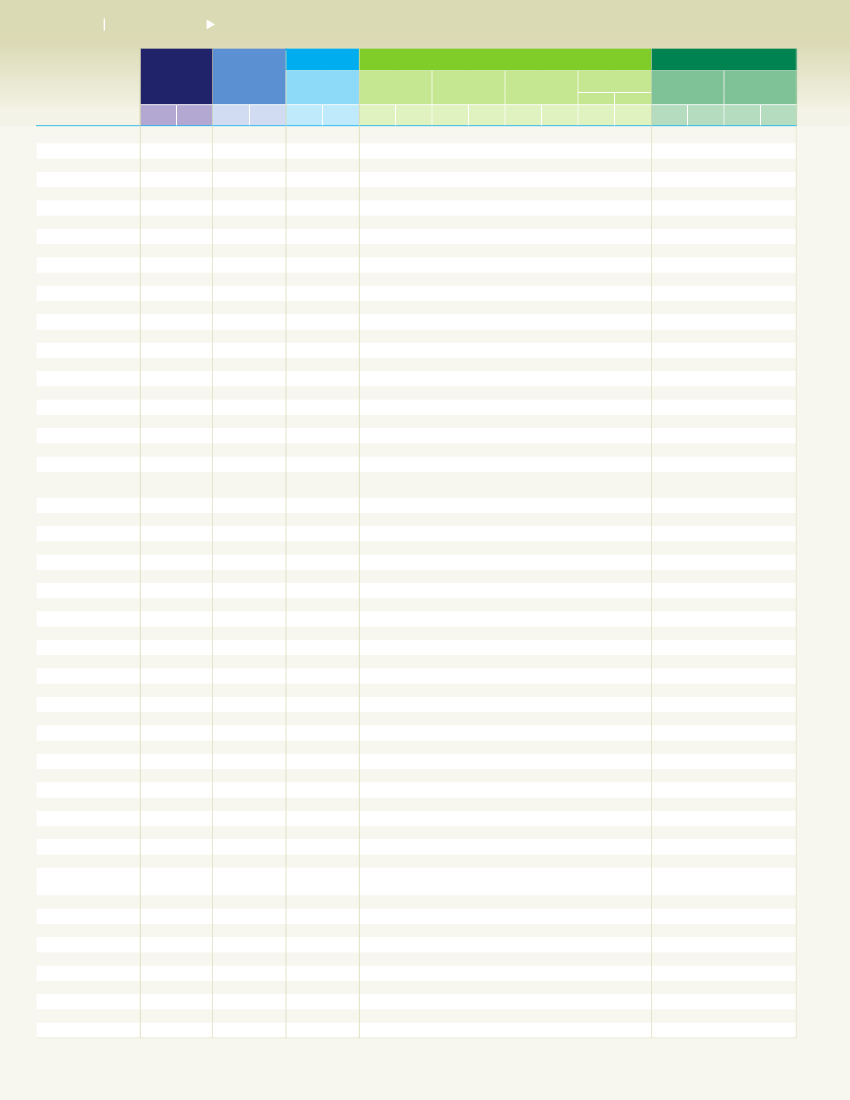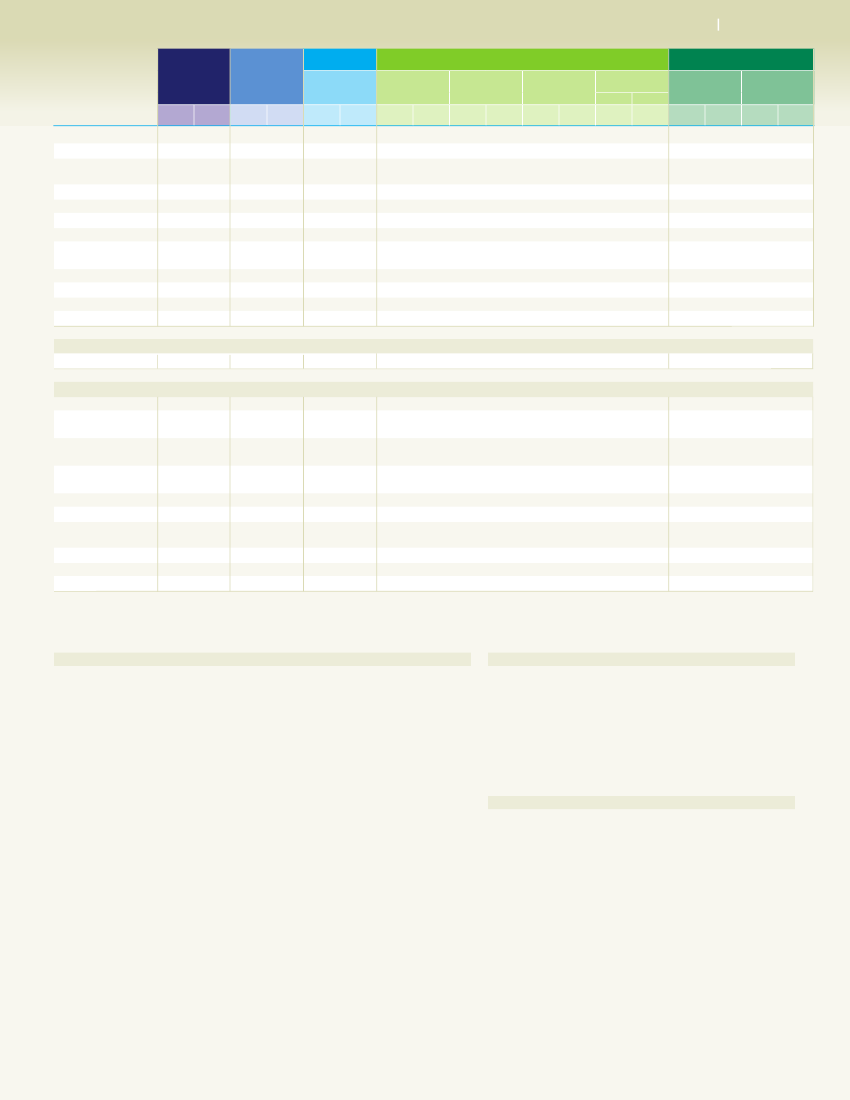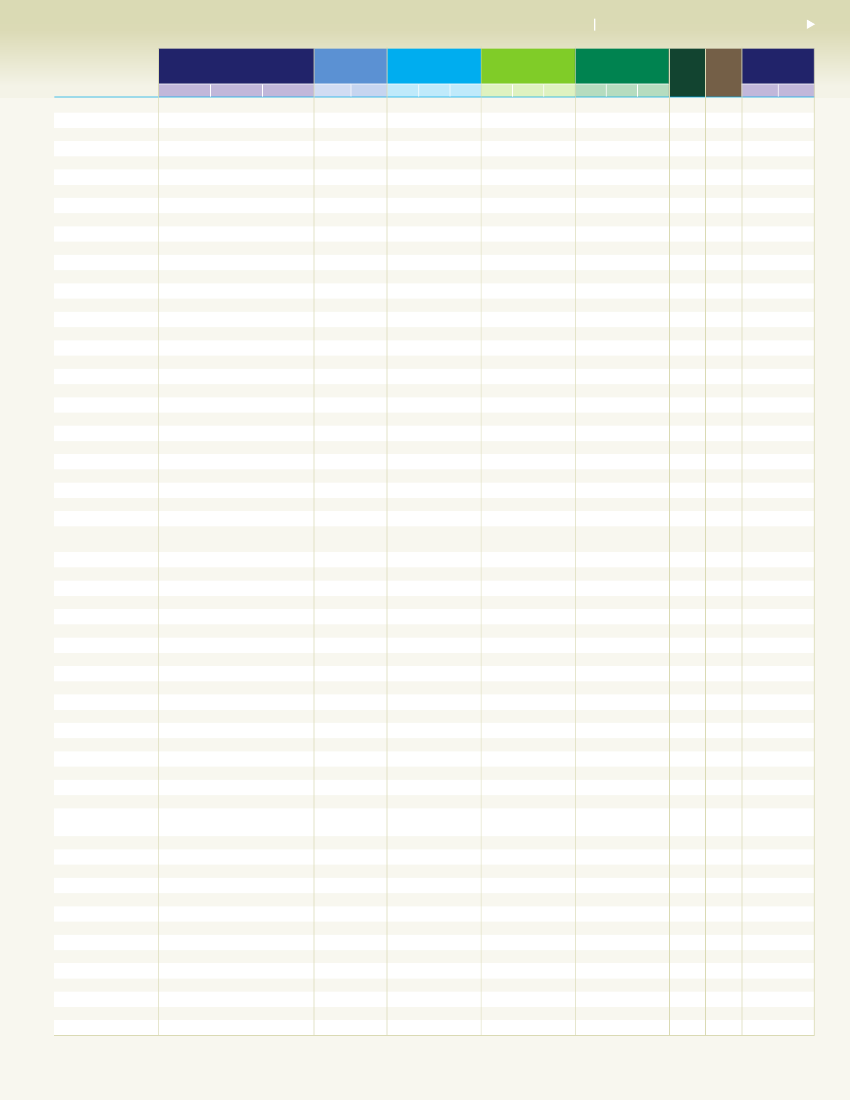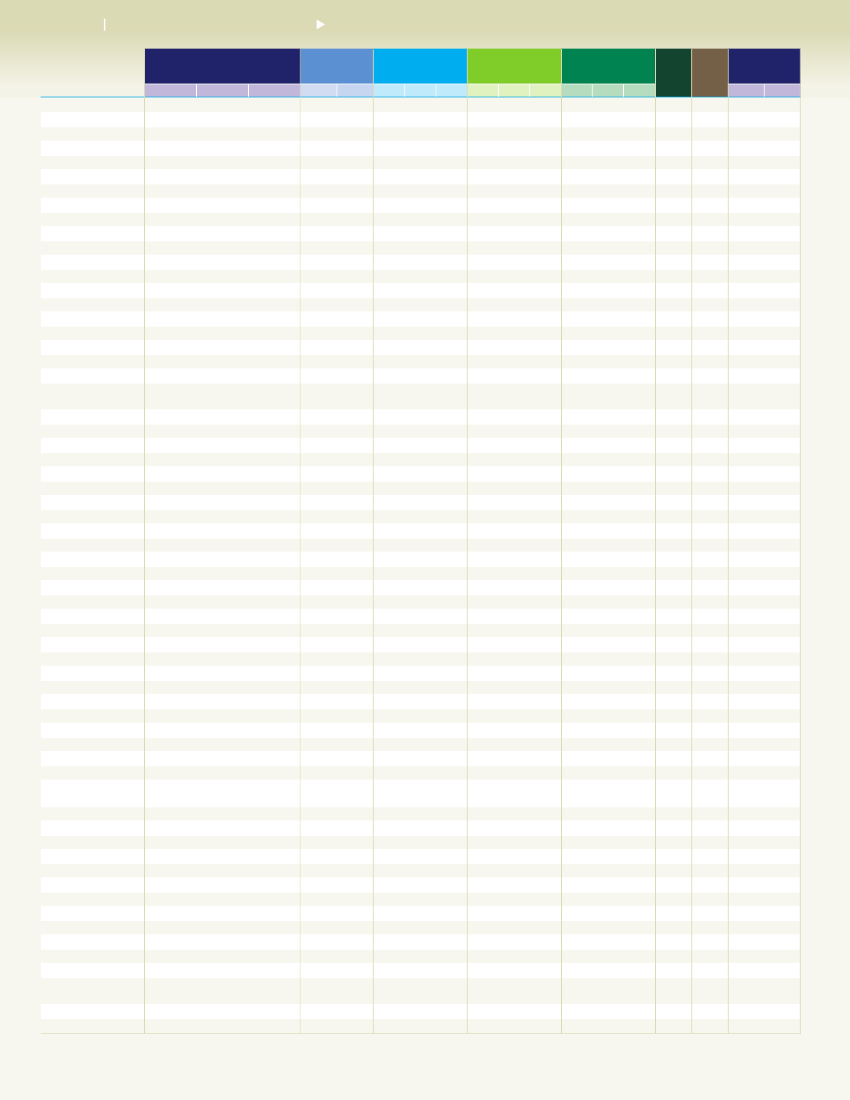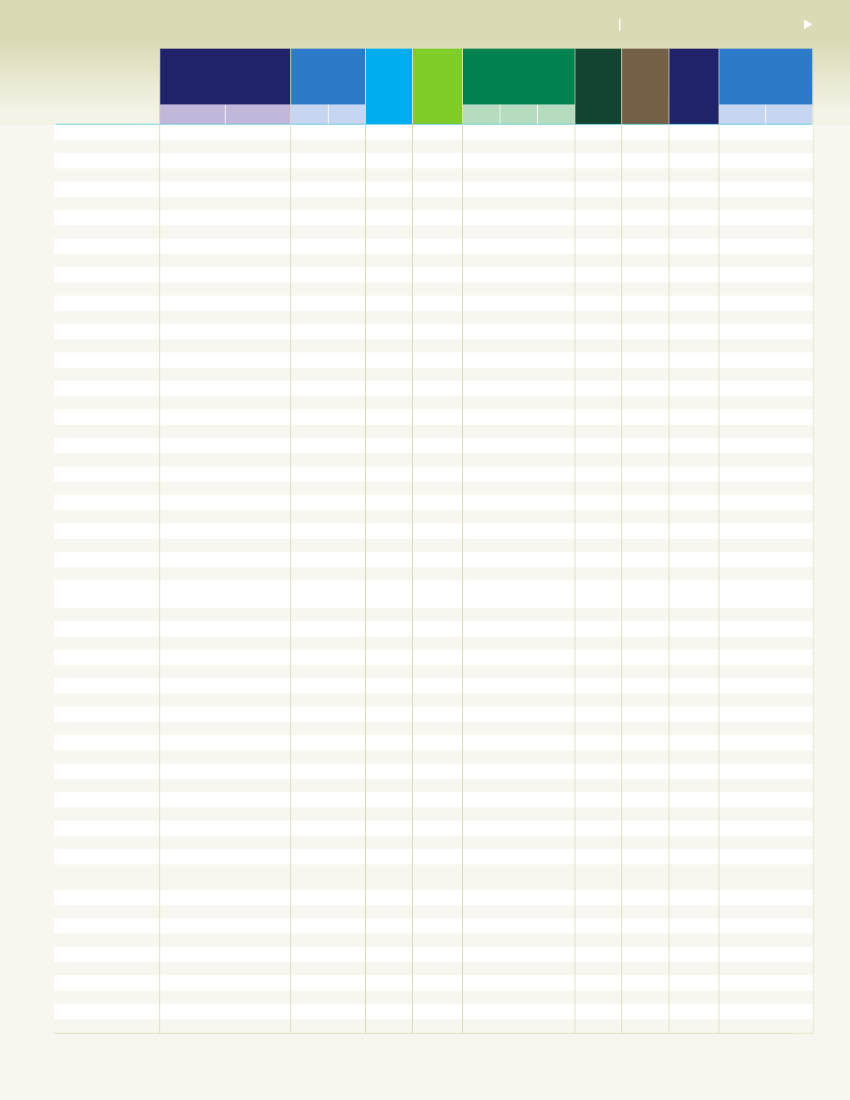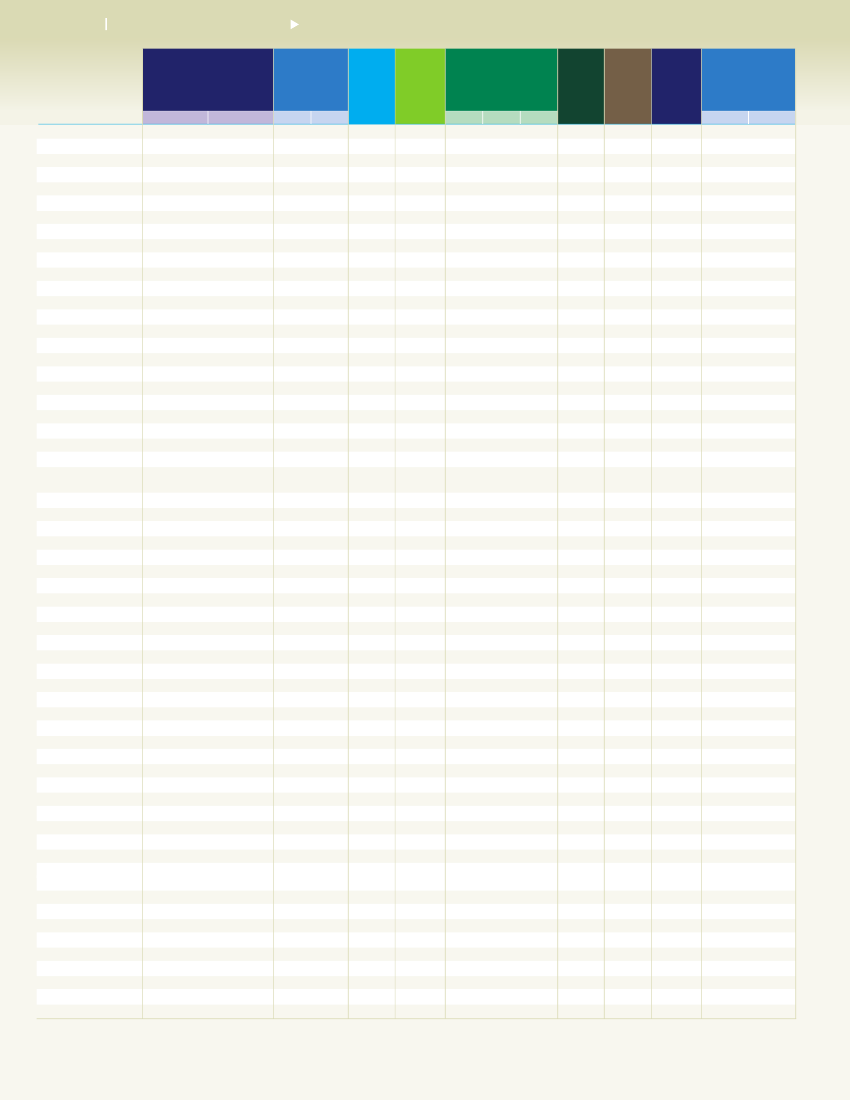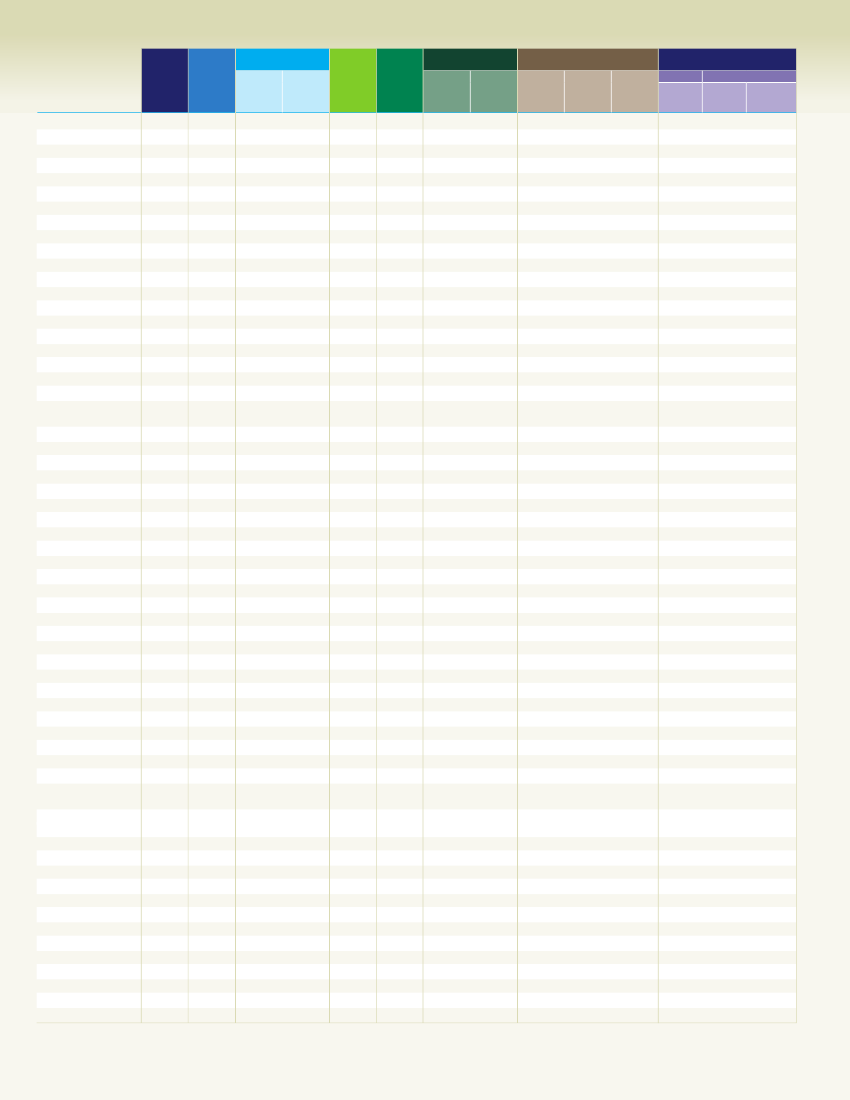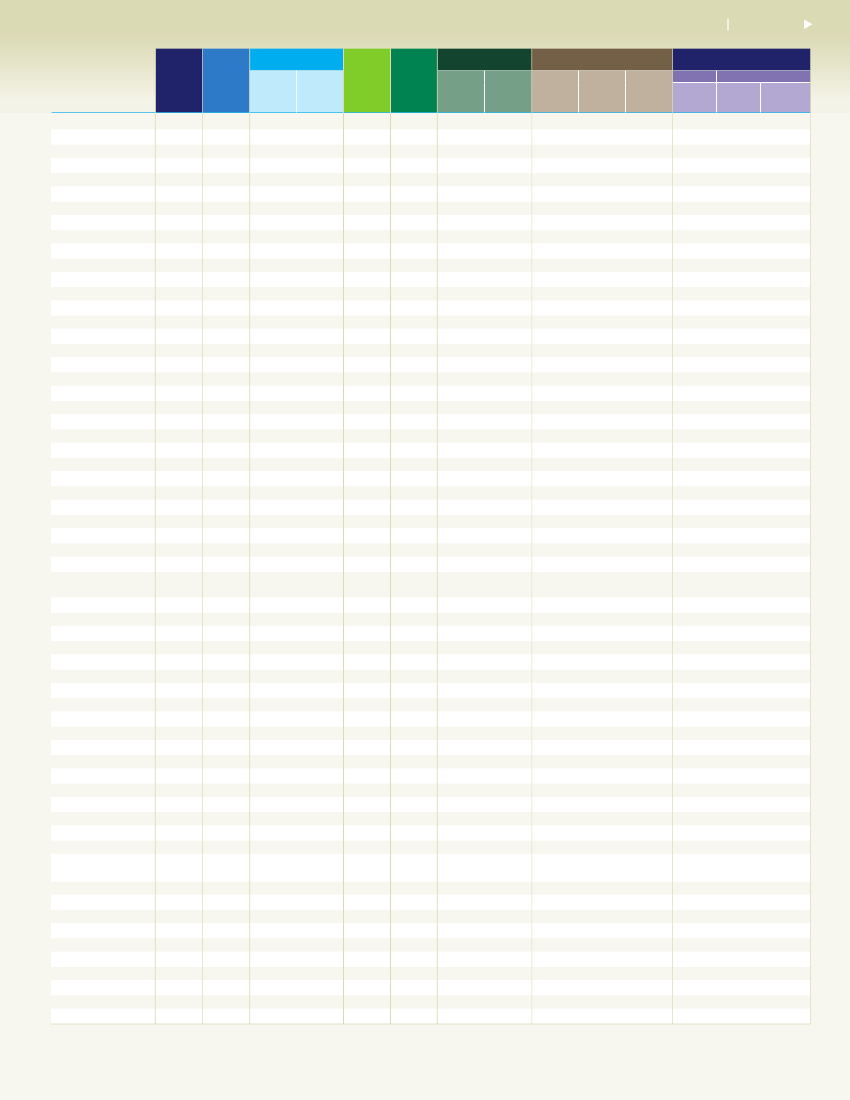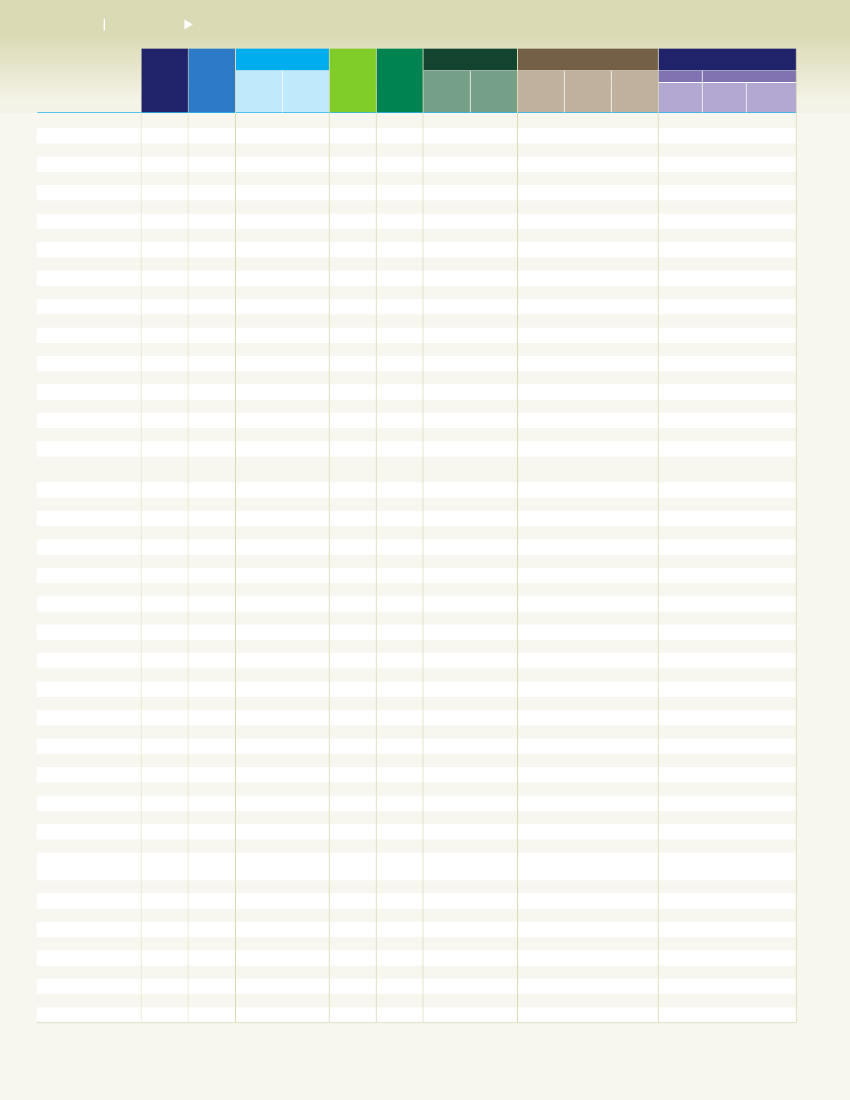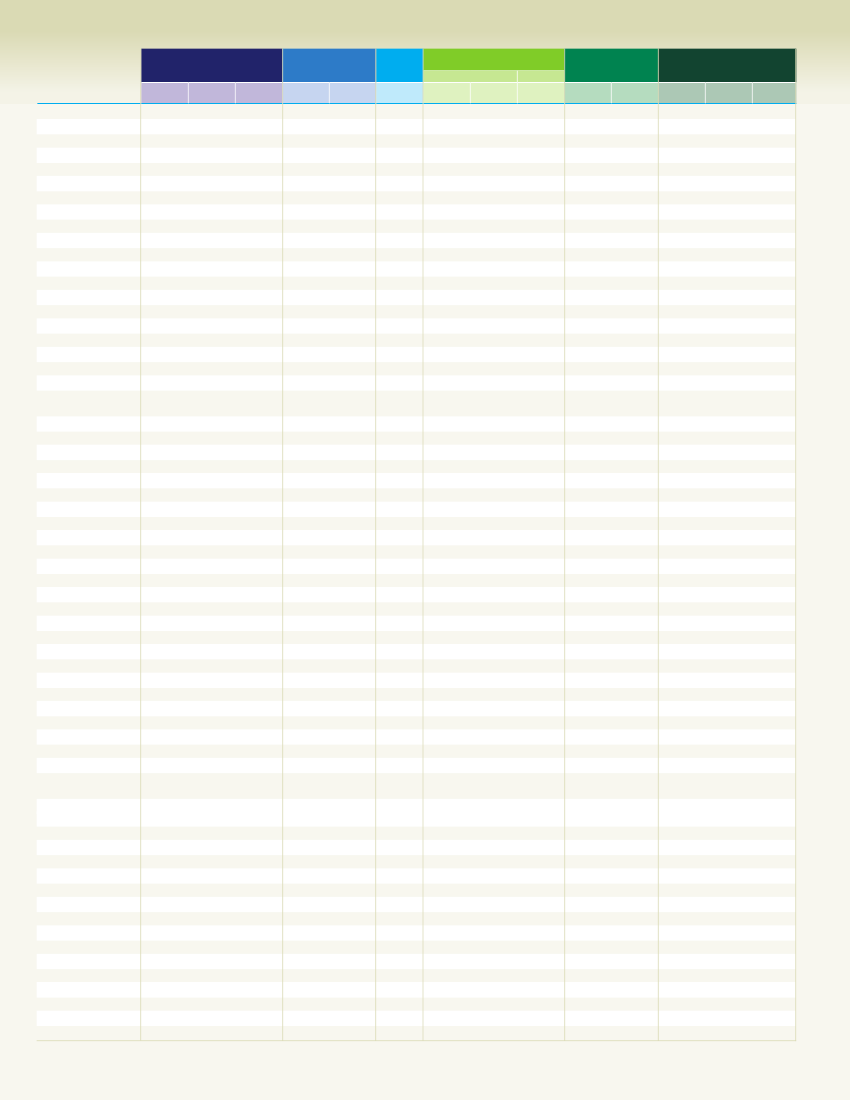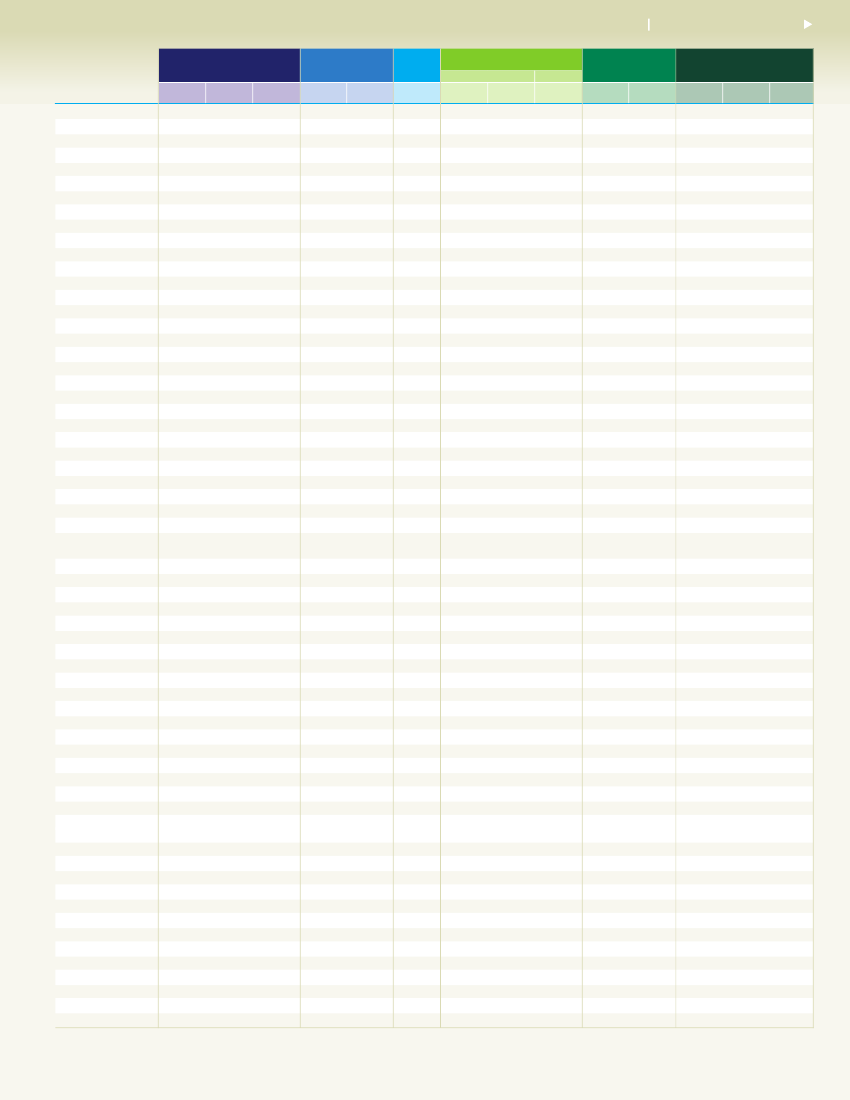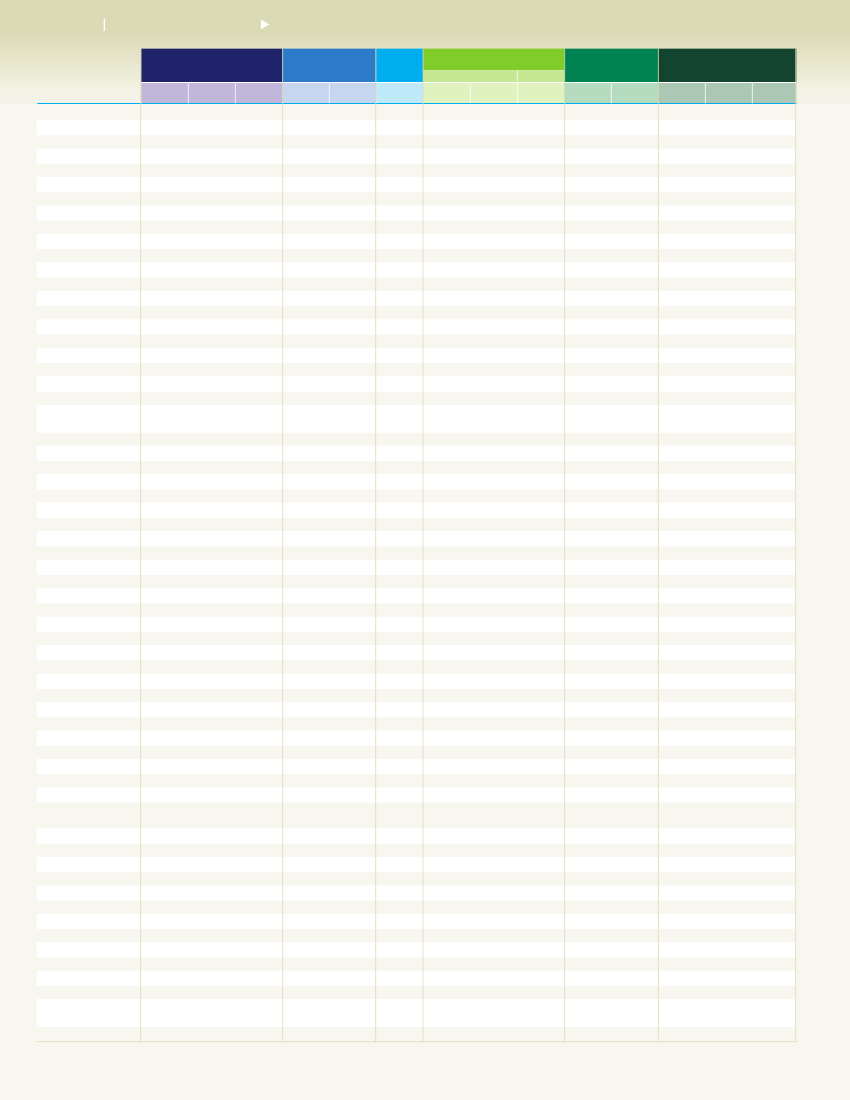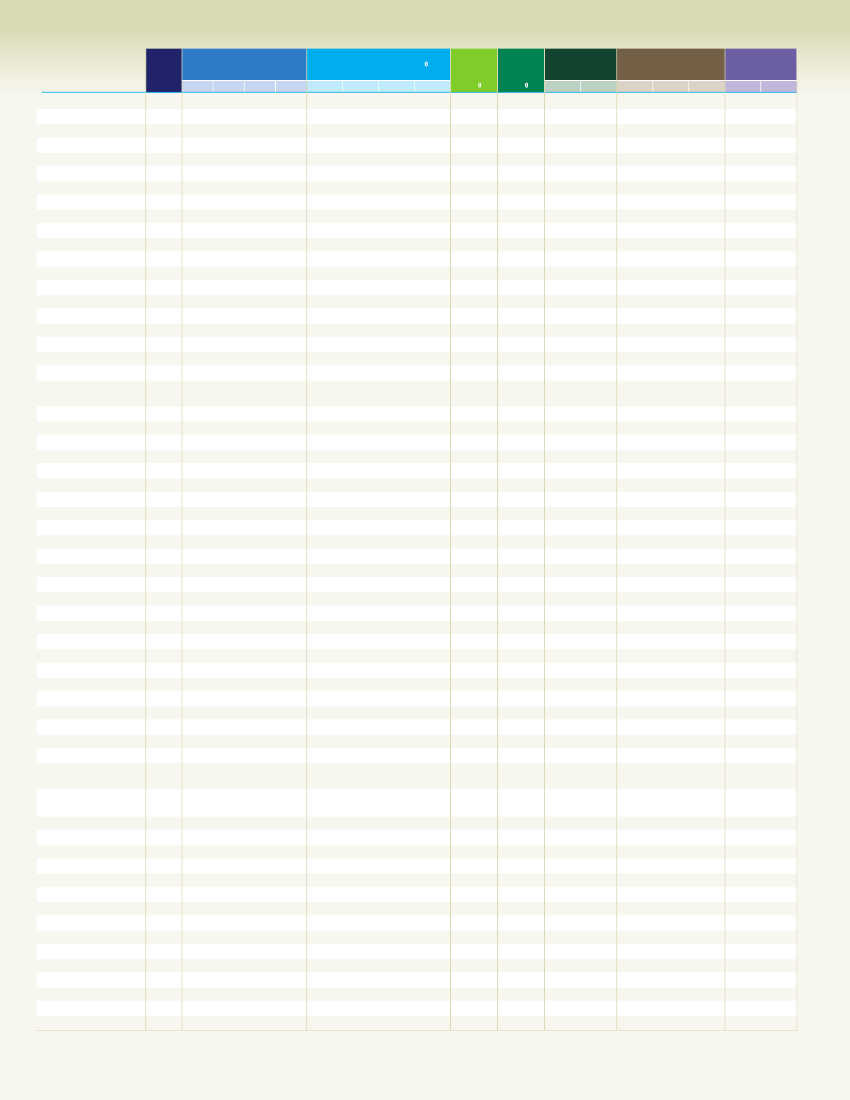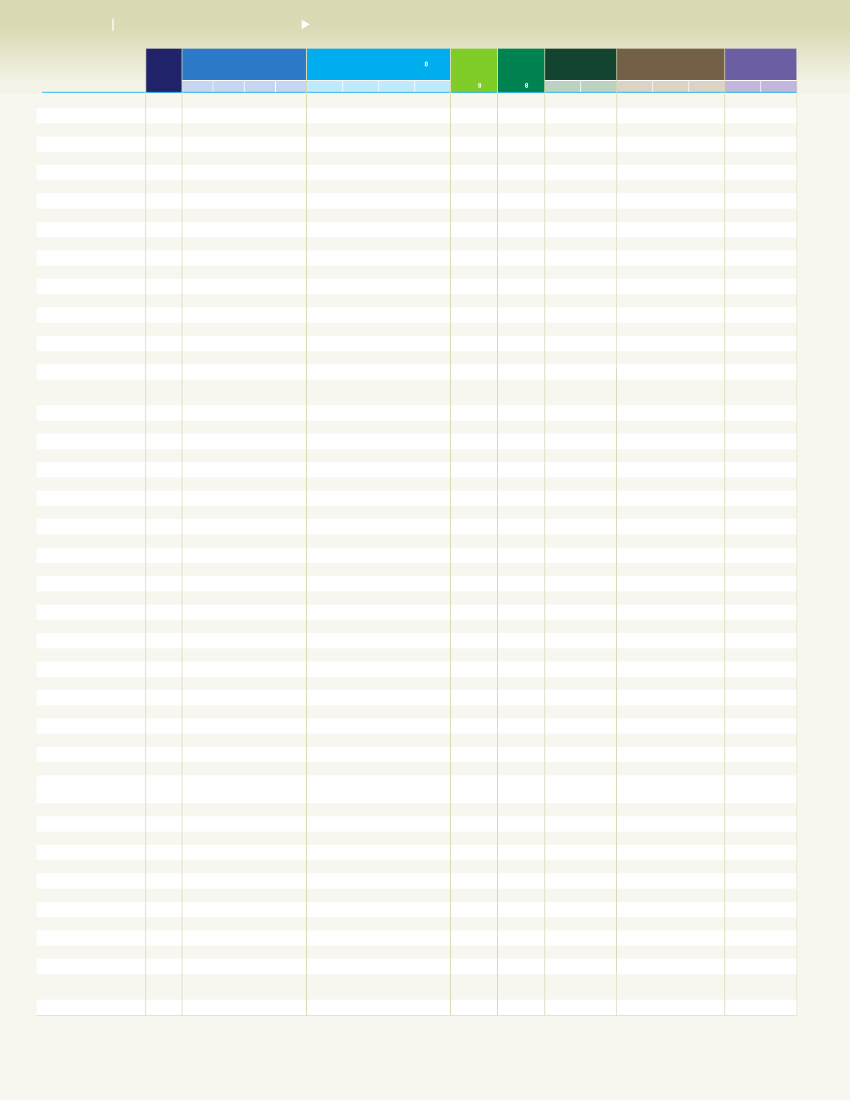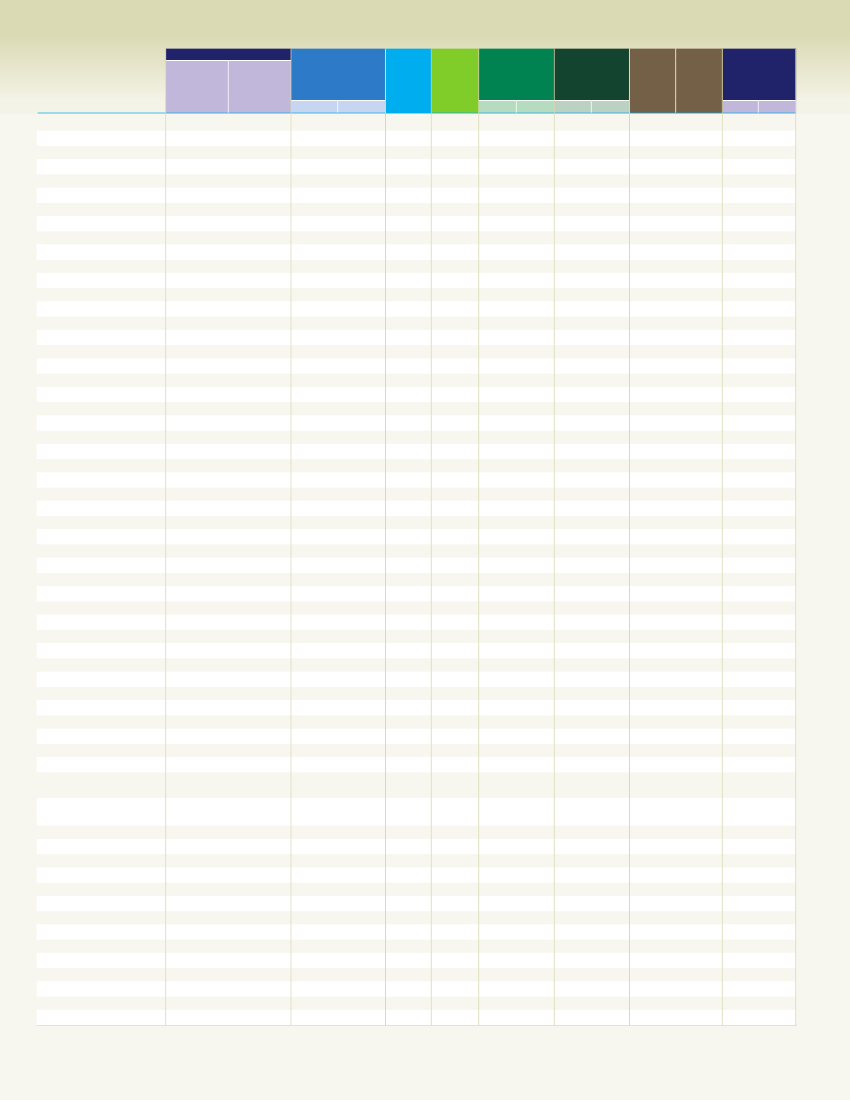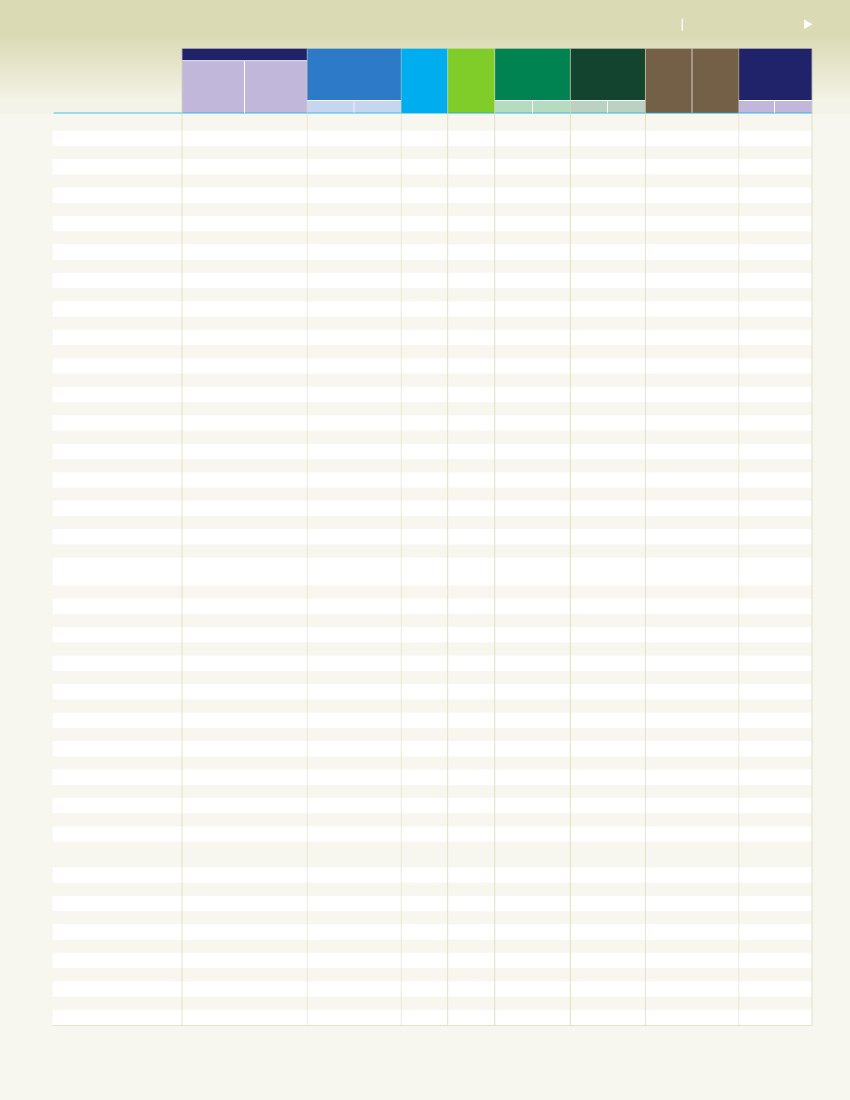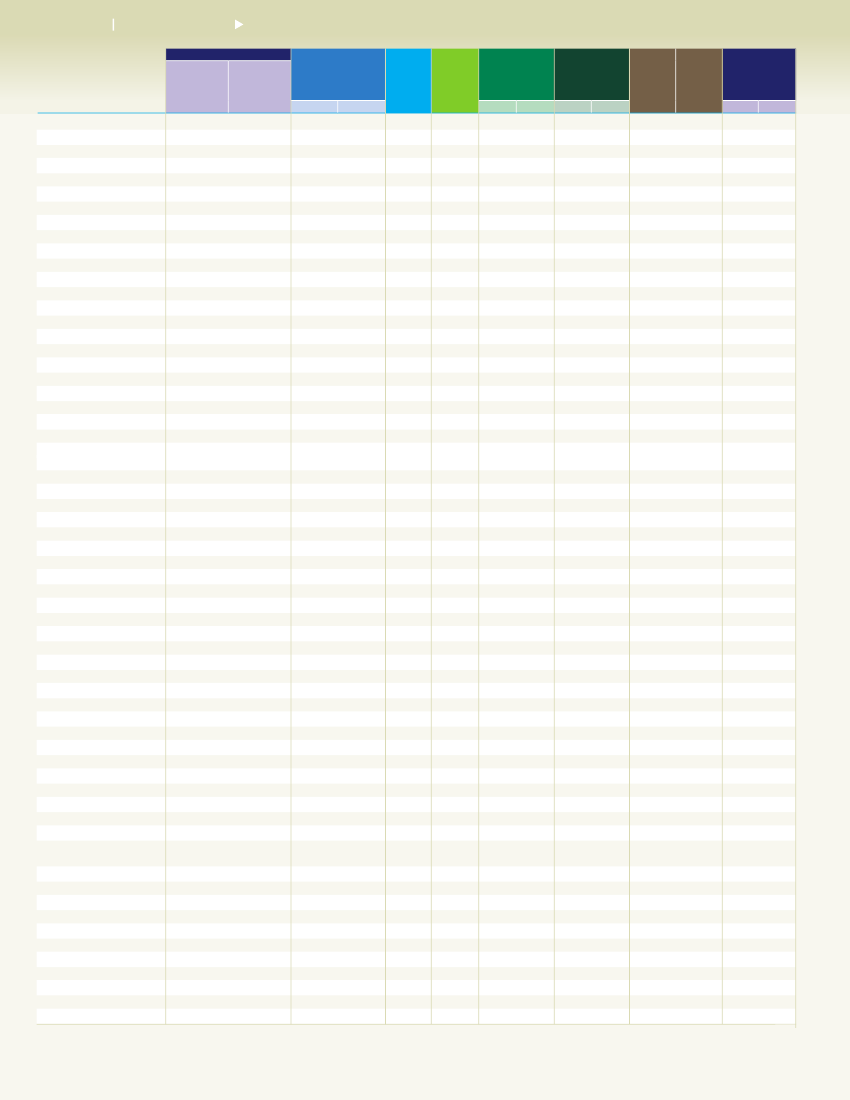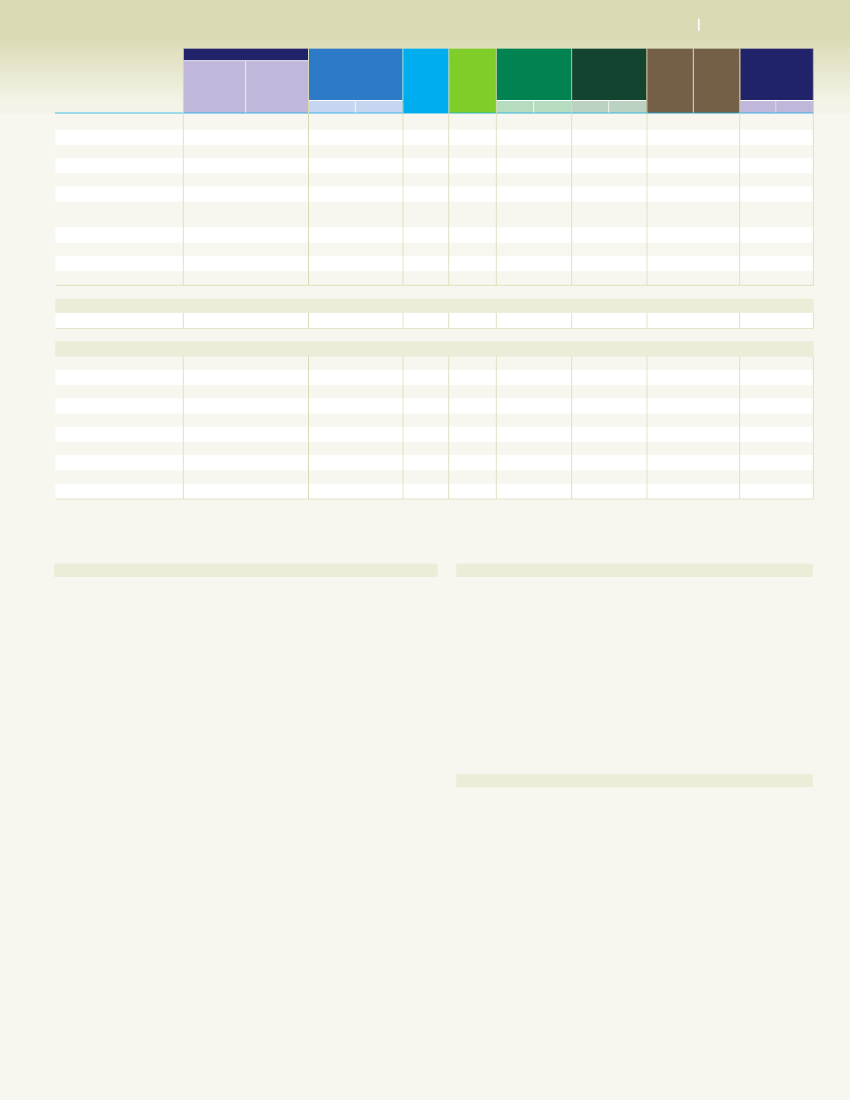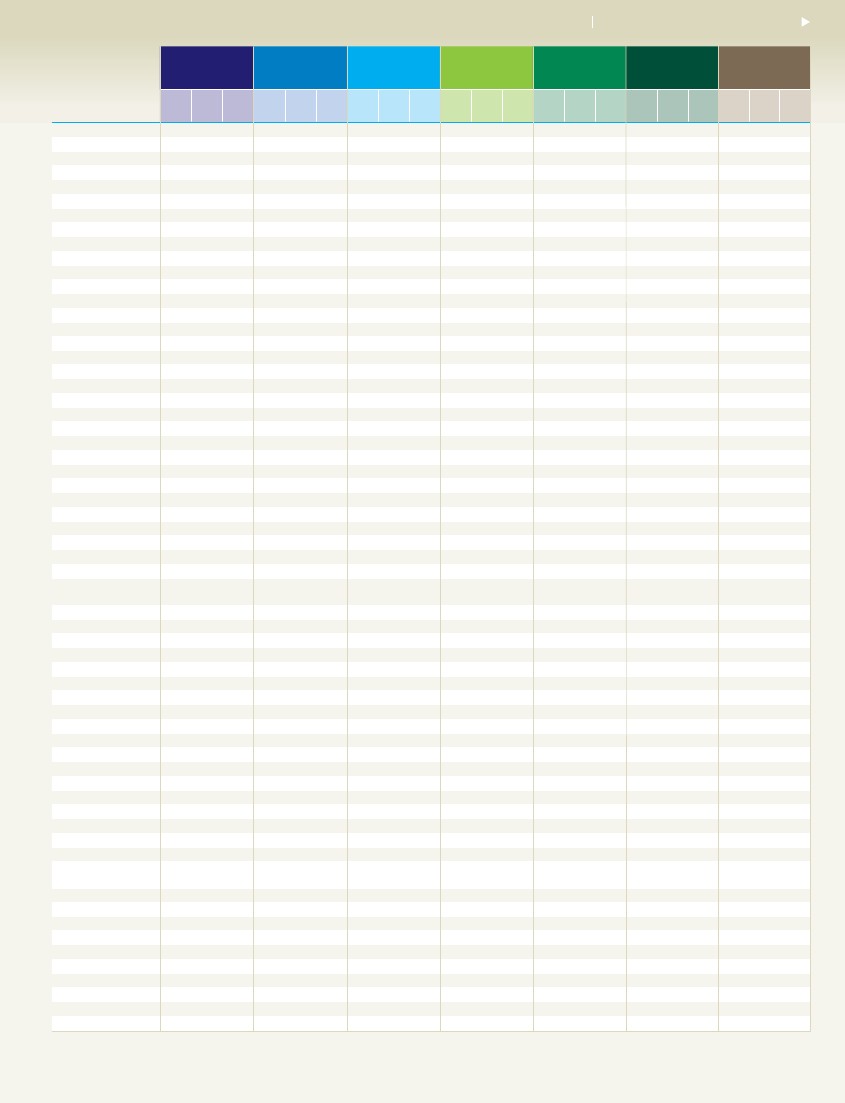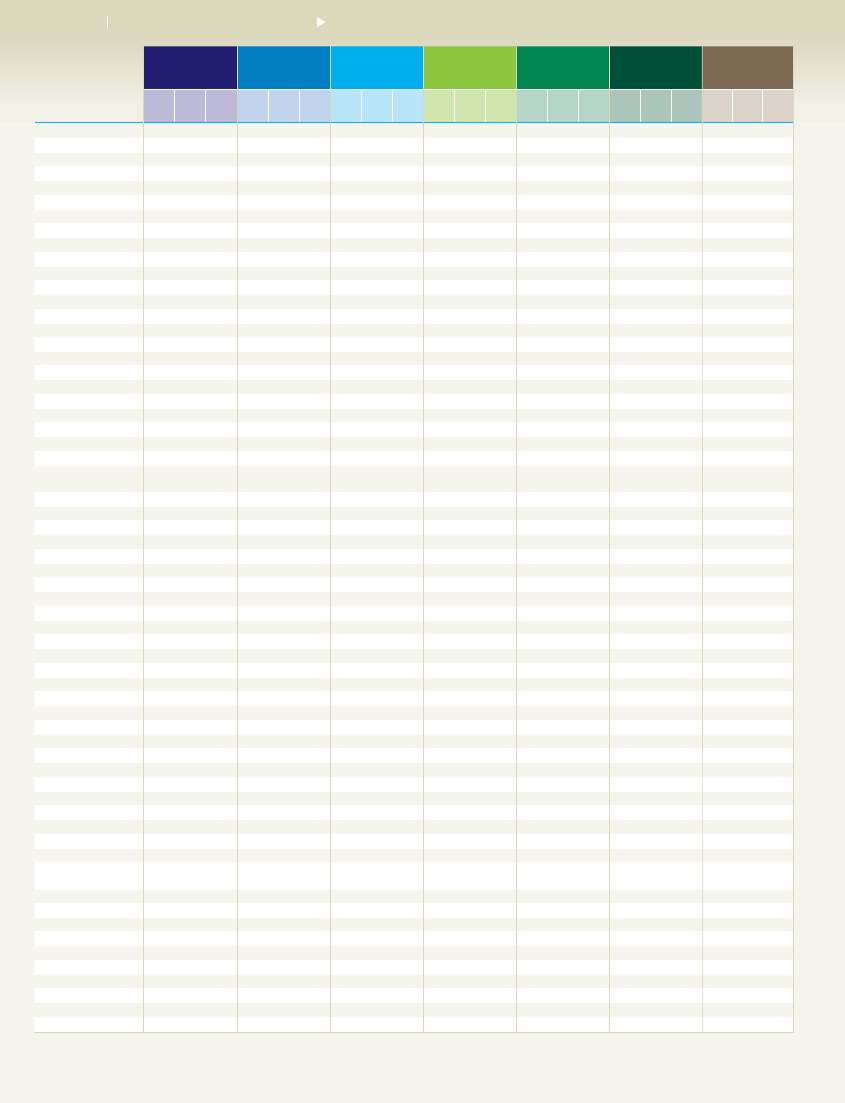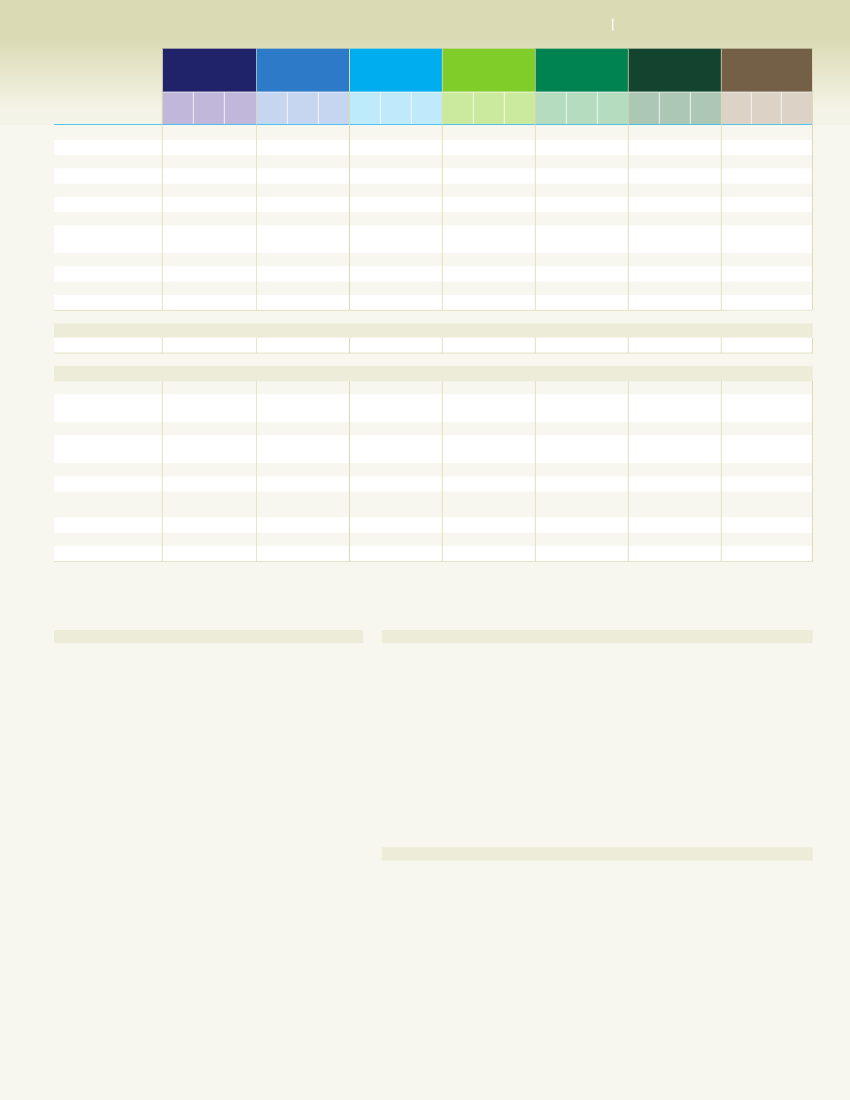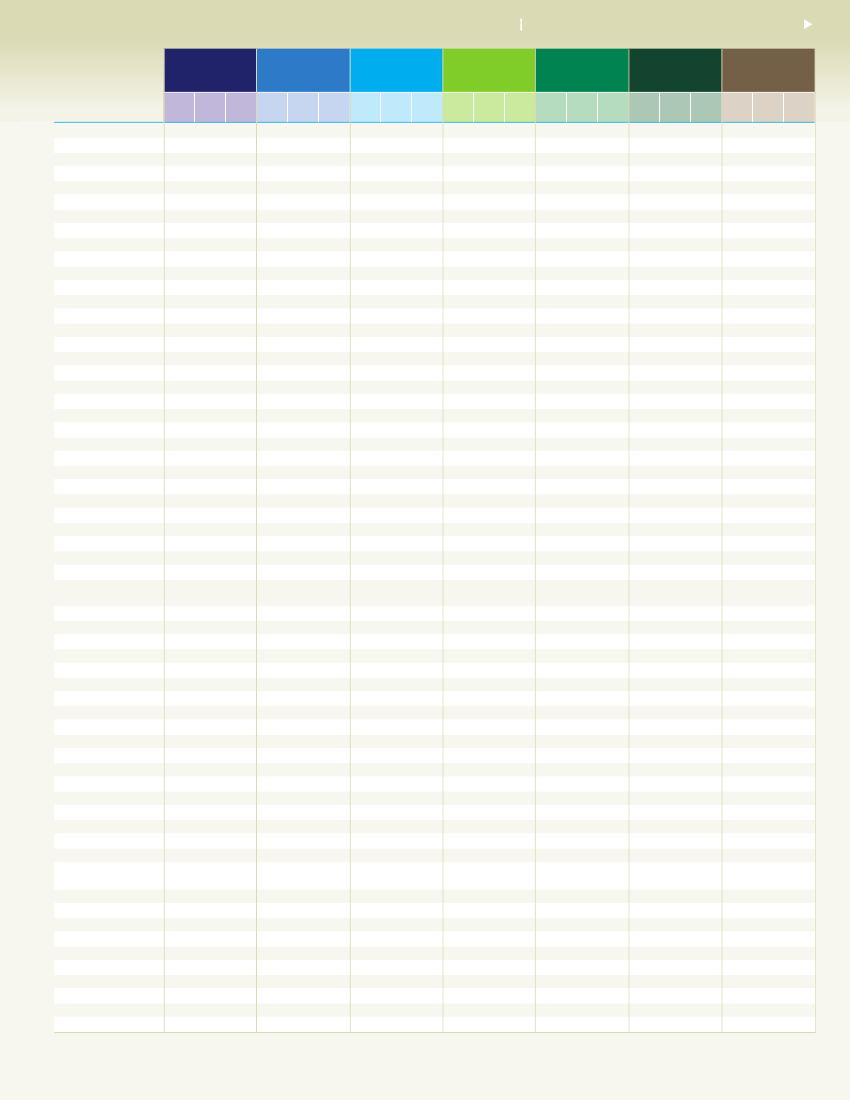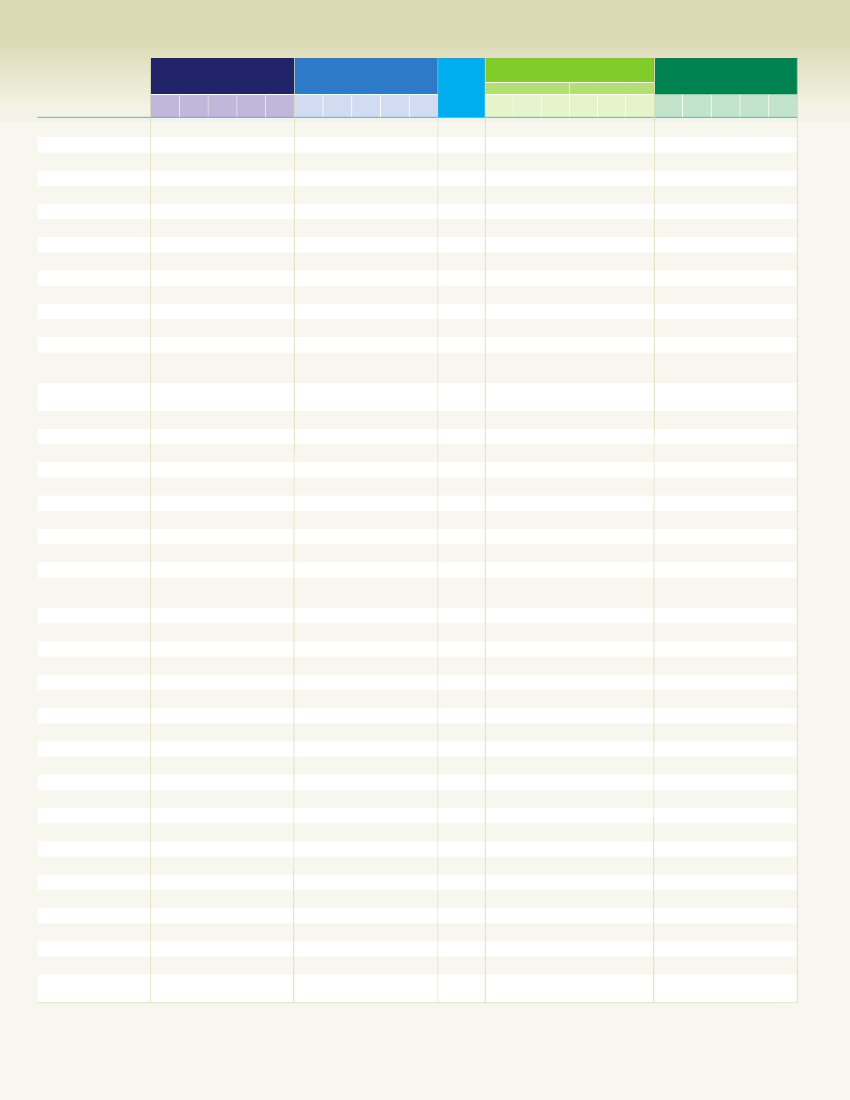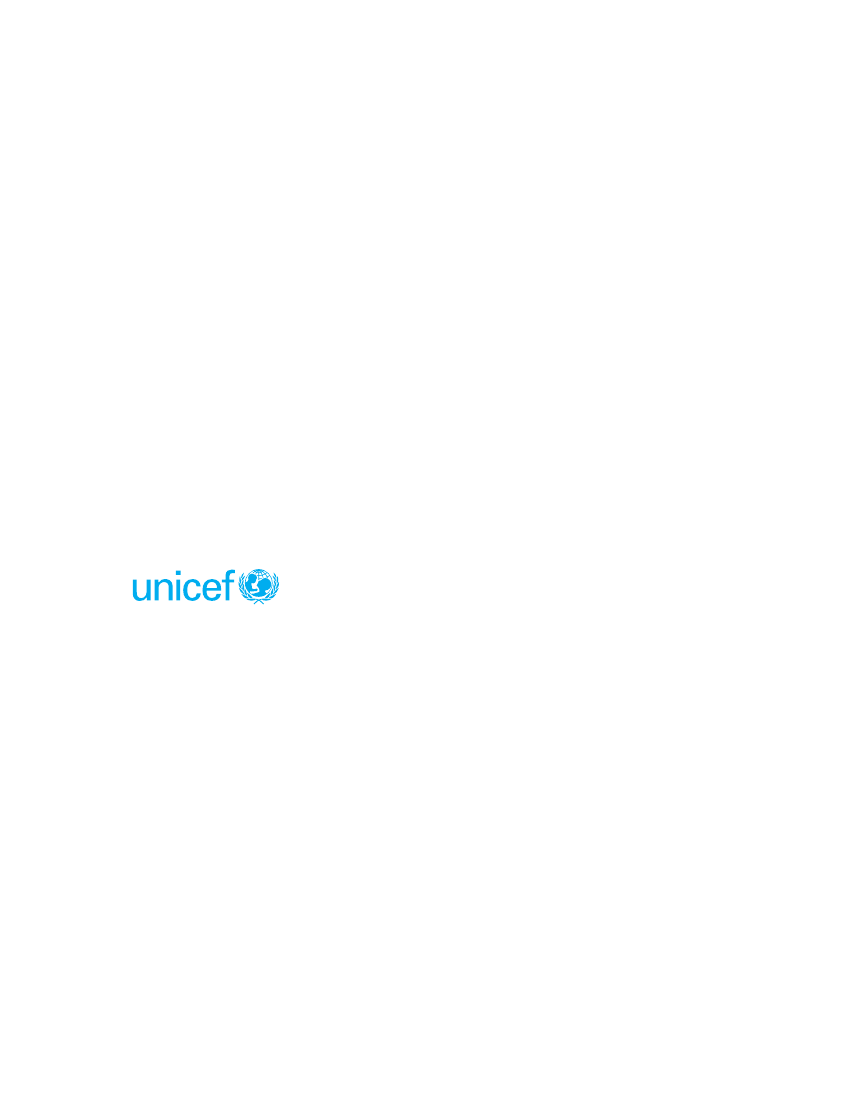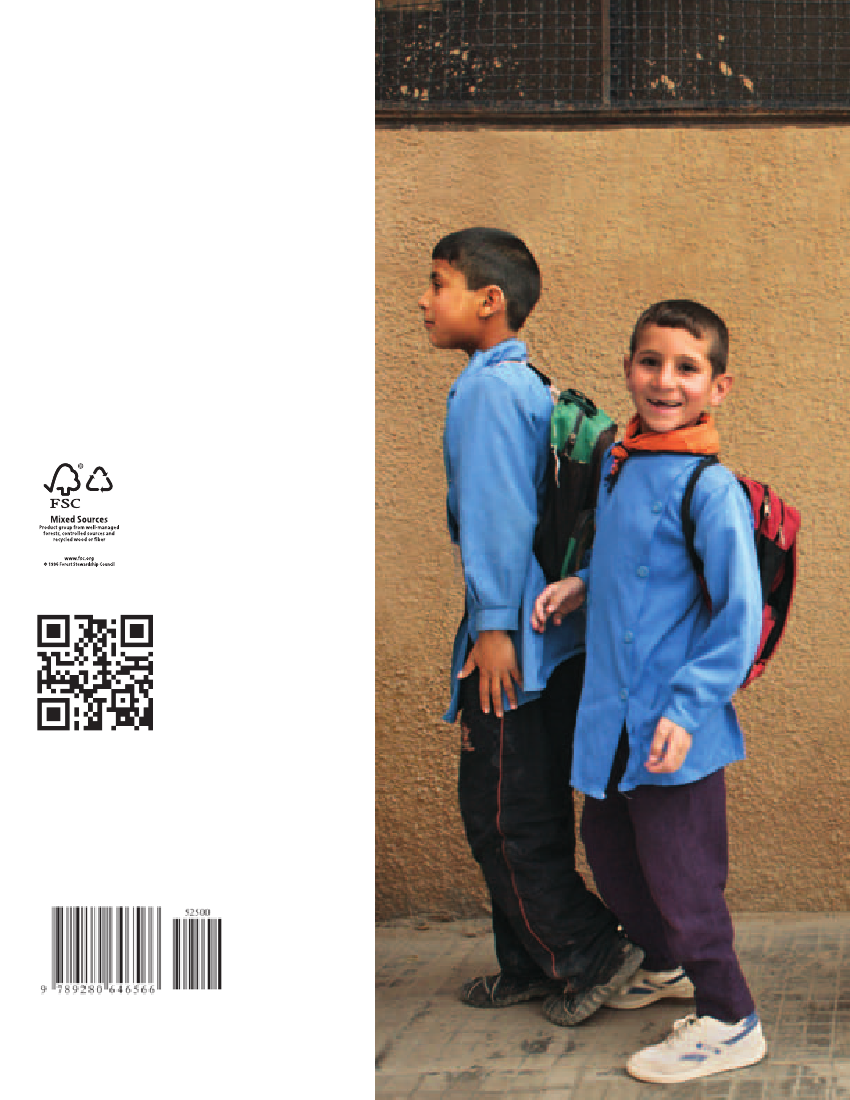Udenrigsudvalget 2012-13
URU Alm.del Bilag 185
Offentligt
THE STATE OF THE WORLD’S CHILDREN2013
Children withDisabilities
� United Nations Children’s Fund (UNICEF)May 2013Permission is required to reproduce any part of this publication. Permission will befreely granted to educational or non-profit organizations. Others will be requestedto pay a small fee. Please contact:Division of Communication, UNICEFAttn: Permissions H6F3 United Nations Plaza, New York, NY 10017, USATel: +1 (212) 326-7434Email: [email protected]This report and additional online content are available at <www.unicef.org/sowc2013>. Perspective and Focus essays represent the personal views ofthe authors and do not necessarily reflect the position of the United NationsChildren’s Fund.For corrigenda subsequent to printing, please see <www.unicef.org/sowc2013>.For latest data, please visit <www.childinfo.org>.ISBN: 978-92-806-4656-6eISBN: 978-92-806-4662-7United Nations publication sales no.: E.13.XX.1Cover photo:Schoolchildren queue to enter their classroom in this 2007 photograph from theSyrian Arab Republic. � UNICEF/HQ2007-0745/Noorani
THE STATE OF THEWORLD’S CHILDREN 2013
ACKNOWLEDGEMENTSThis report is the result of collaboration among too many individuals and institutions to acknowledge here. The editorial and research teamthanks all who gave so willingly of their time, expertise and energy, in particular:Vesna Bosnjak (International Social Services); Shuaib Chalklen (UN Special Rapporteur on Disability); Maureen Durkin (University of Wisconsin); Nora Groce and Maria Kett(Leonard Cheshire Disability and Inclusive Development Centre, University College London); Nawaf Kabbara (Arab Organization of Disabled People); Lisa Jordan (Bernardvan Leer Foundation); Connie Laurin-Bowie (International Disability Alliance); Barbara LeRoy (Wayne State University); Charlotte McClain-Nhlapo (United States Agency forInternational Development); Helen Meekosha (Women with Disabilities Australia); Peter Mittler (University of Manchester); Roseweter Mudarikwa (Secretariat of the AfricanDecade on Persons with Disabilities); David Mugawe (African Child Policy Forum); Ghulam Nabi Nizamani (Pakistan Disabled Peoples’ Organization); Victor Santiago Pineda(Victor Pineda Foundation); Tom Shakespeare (World Health Organization); Aleksandra Posarac (World Bank); Shantha Rau Barriga (Human Rights Watch); Eric Rosenthal(Disability Rights International); Albina Shankar (Mobility India); and Armando Vásquez (Pan American Health Organization) for serving on the External Advisory Board.Judith Klein (Open Society Foundations); Gerrison Lansdown (independent); Malcolm MacLachlan and Hasheem Mannan (Trinity College Dublin); Susie Miles (independent);Daniel Mont (Leonard Cheshire Disability); and Diane Richler (International Disability Alliance) for authoring background papers.Sruthi Atmakur (City University of New York); Parul Bakshi and Jean-Francois Trani (Washington University in St. Louis); Nazmul Bari and Amzad Hossain (Centre for Disabilityin Development); Simone Bloem and Mihaylo Milovanovitch (Organization for Economic Co-operation and Development); Johan Borg (Lund University); Megan Burke,Stephane De Greef and Loren Persi Vicentic (Landmine and Cluster Munition Monitor); James Conroy (Center for Outcome Analysis); Audrey Cooper, Charles Reilly and AmyWilson (Gallaudet University); Alexandre Cote (International Disability Alliance); Marcella Deluca, Sunanda Mavillapalli, Alex Mhando, Kristy Mitchell, Hannah Nicolls andDiana Shaw (Leonard Cheshire Disability/Young Voices); Avinash De Souza (De Souza Foundation); Catherine Dixon (Handicap International); Fred Doulton (Secretariat of theConvention on the Rights of Persons with Disabilities); Natasha Graham (Global Partnership for Education); Jean Johnson (University of Hawaii); Chapal Khasnabis and AlanaOfficer (World Health Organization); Darko Krznaric (Queen’s University); Gwynnyth Llewellyn (University of Sydney); Mitch Loeb (Centers for Disease Control and Prevention/National Center for Health Statistics); Rosemay McKay (Australian Agency for International Development); Amanda McRae (Human Rights Watch); Sophie Mitra (FordhamUniversity); David Morissey, Sherzodbek Sharipoo and Andrea Shettle (United States International Council on Disabilities); Zelda Mycroft (The Chaeli Campaign); EmmaPearce (Women’s Refugee Commission); Natalia Raileanu (Keystone Human Services); Richard Rieser (World of Inclusion); Marguerite Schneider (Stellenbosch University);Morsheda Akter Shilpi (Organization for the Poor Community Advancement); Silje Vold (Plan Norway) for writing background material or providing advice and information.Tracy Achieng; Grace Okumu Akimi; Sophia Rose Akoth; Abeida Onica Anderson; Washinton Okok Anyumba; Beatrice Atieno; Ssentongo Deo; Ivory Duncan; Argie Ergina;Mary Charles Felix; Michael Salah Hosea; Amna Hissein Idris; Tiffany Joseph; Hannah Wanja Maina; Saitoti Augustin Maina; Dianne Mallari; Modesta Mbijima; ShidaMganga; Nicole Mballah Mulavu; Joseph Kadiko Mutunkei; Ann Napaashu Nemagai; Rachael Nyaboke Nyabuti; Alice Akoth Nyamuok; Sarah Omanwa; Benson Okoth Otieno;Nakafu Phiona; Shalima Ramadhani; Rosemarie Ramitt; Nambobi Sadat; Veronicah Shangutit Sampeke; Ladu Michel Seme; Josephine Kiden Simon; Muhammad Tarmizi binFauzi; Elizabeth Mamunyak Tikami; Shemona Trinidad; and the 20 other young people who participated anonymously in surveys and focus groups conducted specially for thisreport by facilitators from the Leonard Cheshire Disability Young Voices network.Bora Shin and Matthew Manos (veryniceDesign) for the infographic on universal design published online at <www.unicef.org/sowc2013>.UNICEF country and regional offices and headquarters divisions contributed to this report or to related online content or advocacy materials by submitting findings or photo-graphs, taking part in formal reviews or commenting on drafts. Many UNICEF offices and national committees arranged to translate or adapt the report for local use.Programme, policy, communication and research advice and support were provided by Yoka Brandt, Deputy Executive Director; Geeta Rao Gupta, Deputy Executive Director;Gordon Alexander, Director, Office of Research and colleagues; Nicholas Alipui, Director, Programme Division and colleagues; Ted Chaiban, Director, Office of EmergencyOperations and colleagues; Colin Kirk, Director, Office of Evaluation and colleagues; Jeffrey O’Malley, Director, Division of Policy and Strategy and colleagues; and EdwardCarwardine, Deputy Director, Division of Communication and colleagues. This edition also benefited from the close cooperation of Rosangela Berman-Bieler, Chief, andcolleagues in the Disability Section of UNICEF’s Programme Division.Special thanks to David Anthony, Chief, Policy Advocacy Section; Claudia Cappa, Statistics and Monitoring Specialist; Khaled Mansour, Director of Communication untilJanuary 2013; and Julia Szczuka, deputy editor of this report until September 2012, for their generosity of intellect and spirit.
REPORT TEAM
EDITORIAL AND RESEARCHAbid Aslam, EditorChristine Mills, Project ManagerNikola Balvin, Sue Le-Ba, Ticiana Maloney, Research OfficersAnna Grojec, Perspectives EditorMarc Chalamet, French EditorCarlos Perellon, Spanish EditorHirut Gebre-Egziabher (Lead), Lisa Kenney, Ami Pradhan, Research AssistantsCharlotte Maitre (Lead), Carol Holmes, Pamela Knight, Natalie Leston,Kristin Moehlmann, Copy EditorsAnne Santiago, Nogel S. Viyar, Judith Yemane, Editorial support
PUBLISHING AND DISSEMINATIONCatherine Langevin-Falcon, Chief, Publications Section; Jaclyn Tierney, ProductionOfficer; Germain Ake; Christine Kenyi; Maryan Lobo; Jorge Peralta-Rodriguez;Elias Salem
STATISTICAL TABLESTessa Wardlaw, Associate Director, Statistics and Monitoring Section, Divisionof Policy and Strategy; David Brown; Claudia Cappa; Liliana Carvajal; ArchanaDwivedi; Anne Genereux; Elizabeth Horn-Phathanothai; Priscilla Idele; ClaesJohansson; Rouslan Karimov; Rolf Luyendijk; Colleen Murray; Jin Rou New;Holly Newby; Khin Wityee Oo; Nicole Petrowski; Tyler Porth; Chiho Suzuki;Andrew Thompson; Danzhen YouDesign by Prographics, Inc.Printed by Hatteras Press, Inc.
ii
THE STATE OF THE WORLD’S CHILDREN 2013: Children with Disabilities
FOREWORDIs there a child who does not dream of being counted and having her or his giftsand talents recognized? No. All children have hopes and dreams – including childrenwith disabilities. And all children deserve a fair chance to make their dreams real.This edition ofThe State of the World’s Childrenincludes contributions byyoung people and parents who show that, when given that chance, children withdisabilities are more than capable of overcoming barriers to their inclusion, of taking their rightful placeas equal participants in society and of enriching the life of their communities.But for far too many children with disabilities, the opportunity to participate simply does not exist. Fartoo often, children with disabilities are among the last in line for resources and services, especiallywhere these are scarce to begin with. Far too regularly, they are the objects simply of pity or, worse,discrimination and abuse.The deprivations faced by children and adolescents with disabilities are violations of their rights and theprinciple of equity, at the heart of which lies a concern for the dignity and rights ofallchildren – includingthe most vulnerable and marginalized members of society.As this report documents, the inclusion of children with disabilities in society is possible – but it requiresfirst a change of perception, a recognition that children with disabilities hold the same rights as others;that they can be agents of change and self-determination, not merely the beneficiaries of charity; thattheir voices must be heard and heeded in our policymaking and programmes.We contribute to their exclusion by failing to gather enough data to inform our decisions. When we failto count these children, we are failing to help them count for all they should in their societies.Fortunately, progress is being made – albeit unevenly. This report not only examines the challengesinvolved in ensuring that children with disabilities have the fair access to services that is their right. Italso explores initiatives that show promise in such areas as health, nutrition, education and emergencyprogramming – and in the data collection and analysis needed to improve policies and operations in allthese fields. Other chapters also discuss principles and approaches that can be adapted to advance thesechildren’s inclusion.Somewhere, a child is being told he cannot play because he cannot walk, or another that she cannotlearn because she cannot see. That boy deserves a chance to play. And we all benefit when that girl,and all children, can read, learn and contribute.The path forward will be challenging. But children do not accept unnecessary limits. Neither should we.
Anthony LakeExecutive Director, UNICEF
iii
CONTENTSACKNOWLEDGEMENTS................................................. iiFOREWORDAnthony Lake, Executive Director, UNICEF .............................. iiiCHAPTER 4
ESSENTIALS OF PROTECTION........................... 41Abuse and violence .................................................................... 41Institutions and inappropriate care .......................................... 42Inclusive justice .......................................................................... 43
CHAPTER 1
INTRODUCTION................................................................ 1From exclusion to inclusion ........................................................ 1On the numbers............................................................................ 3A framework for action ............................................................... 3
CHAPTER 5
HUMANITARIAN RESPONSE............................... 49CHAPTER 6
MEASURING CHILD DISABILITY....................... 63Evolving definitions ................................................................... 63Putting disability in context ..................................................... 64Data collection ............................................................................ 65Questionnaire design ................................................................. 66Purpose and consequences ....................................................... 67A way forward ............................................................................ 68
CHAPTER 2
FUNDAMENTALS OF INCLUSION................... 11Changing attitudes ..................................................................... 12It’s about ability .......................................................................... 13Supporting children and their families .................................... 13Community-based rehabilitation .............................................. 16Assistive technology .................................................................. 18Universal design ......................................................................... 18
CHAPTER 7
AN AGENDA FOR ACTION.................................... 75CHAPTER 3
Ratify and implement the Conventions ................................... 75Fight discrimination ................................................................... 75Dismantle barriers to inclusion ................................................. 77End institutionalization ............................................................. 80Support families ......................................................................... 81Move beyond minimum standards .......................................... 81Coordinate services to support the child ................................ 81Involve children with disabilities in making decisions........... 84Global promise, local test ......................................................... 85
A STRONG FOUNDATION...................................... 23Inclusive health ........................................................................... 23Immunization .............................................................................. 23Nutrition ...................................................................................... 24Water, sanitation and hygiene ................................................... 25Sexual and reproductive health and HIV/AIDS ........................ 26Early detection and intervention ............................................... 26Inclusive education .................................................................... 27Starting early .............................................................................. 29Working with teachers ............................................................... 32Involving parents, communities and children ........................ 33Lines of responsibility ................................................................ 36
iv
THE STATE OF THE WORLD’S CHILDREN 2013: Children with Disabilities
FOCUSViolence against children with disabilities .............................. 44Risk, resilience and inclusive humanitarian action ................. 52Explosive remnants of war ....................................................... 54Lessons learned .......................................................................... 69From screening to assessment ................................................. 70
FIGURESEstimated rates of primary school completion ....................... 12Community-based rehabilitation .............................................. 16Assistive technology products.................................................. 19Children with disabilities and secondary education .............. 42Last to benefit............................................................................. 43Child casualties in countries heavily affected bymines and explosive remnants of war, 2011 ........................... 56
PERSPECTIVEFrom pioneer to advocate for inclusionNancy Maguire............................................................................. 4Living with albinism, discrimination and superstitionMichael Hosea.............................................................................. 6I want good memoriesNicolae Poraico............................................................................. 8For deaf young people, language is the keyKrishneer Sen............................................................................. 20My son HanifMohammad Absar..................................................................... 30The new normalClaire Halford.............................................................................. 34Adjusting, adapting and empoweringYahia J. Elziq............................................................................... 38Segregation and abuse in institutionsEric Rosenthal and Laurie Ahern.............................................. 46One bite of the elephant at a timeChaeli Mycroft............................................................................. 60From invisibility to inclusion forindigenous children with disabilitiesOlga Montufar Contreras........................................................... 72Open the doors to education – and employmentIvory Duncan............................................................................... 78End the ‘book famine’ with bettertechnology, attitudes and copyright lawKartik Sawhney........................................................................... 82Children with disabilities anduniversal human rightsLenín Voltaire Moreno Garcés................................................... 86Additional Focus and Perspective essays are available online at<www.unicef.org/sowc2013>.
Child casualties in the most affectedcountries (1999–2011) ................................................................ 57Child casualties by type of explosive ....................................... 59Four case studies: Percentage of populationreporting some form of disability............................................. 64Convention on the Rights of Persons with Disabilitiesand Optional Protocol: Signatures and ratifications .............. 76
REFERENCES....................................................................... 88
STATISTICAL TABLES................................................ 93Overview ..................................................................................... 94Under-five mortality rankings ................................................... 99Table 1. Basic indicators .......................................................... 100Table 2. Nutrition ...................................................................... 104Table 3. Health .......................................................................... 108Table 4. HIV/AIDS ..................................................................... 112Table 5. Education .................................................................... 116Table 6. Demographic indicators ............................................ 120Table 7. Economic indicators .................................................. 124Table 8. Women ........................................................................ 128Table 9. Child protection.......................................................... 132Table 10. The rate of progress ................................................ 136Table 11. Adolescents .............................................................. 140Table 12. Disparities by residence .......................................... 144Table 13. Disparities by household wealth ............................ 148Table 14. Early childhood development ................................. 152
A NOTE ON TERMSConventions, optional protocols, signatures andratifications ............................................................................... 154
v
Victor, a 13-year-old with cerebral palsy, has fun in the water in Brazil. � Andre Castro/2012
CHAPTER 1
INTRODUCTIONReports such as this typically begin with a statisticdesigned to highlight a problem. The girls and boys towhom this edition ofThe State of the World’s Childrenis dedicated are not problems.Rather, each is a sister, brother or friend who hasa favourite dish, song or game; a daughter or sonwith dreams and the desire to fulfil them; a childwith a disability who has the same rights as anyother girl or boy.Given opportunities to flourish as others might,children with disabilities have the potential tolead fulfilling lives and to contribute to thesocial, cultural and economic vitality of theircommunities – as the personal essays in thisvolume attest.Yet surviving and thriving can be especiallydifficult for children with disabilities. They areat greater risk of being poor than peers withoutdisabilities. Even where children share the samedisadvantages – of poverty or membership in aminority group, say – children with disabilitiesconfront additional challenges as a result of theirimpairments and the many barriers that societythrows in their way. Children living in poverty areamong the least likely to enjoy the benefits of edu-cation and health care, for example, but childrenwho live in poverty and have a disability are evenless likely to attend their local school or clinic.In many countries, responses to the situationof children with disabilities are largely limitedto institutionalization, abandonment or neglect.These responses are the problem, and they arerooted in negative or paternalistic assumptionsof incapacity, dependency and difference that areperpetuated by ignorance. Unless this changes,children with disabilities will continue to have theirrights neglected; to experience discrimination,violence and abuse; to have their opportunitiesrestricted; to be excluded from society.What is needed is a commitment to thesechildren’s rights and their futures, giving priorityto the most disadvantaged – as a matter of equityand for the benefit of all.
From exclusion to inclusionChildren with disabilities encounter differentforms of exclusion and are affected by them tovarying degrees, depending on factors such asthe type of disability they have, where they liveand the culture or class to which they belong.Gender is also a crucial factor: Girls are lesslikely than boys to receive care and food and aremore likely to be left out of family interactionsand activities. Girls and young women withdisabilities are ‘doubly disabled’. They confrontnot only the prejudice and inequities encounteredby many persons with disabilities, but are alsoconstrained by traditional gender roles andbarriers.1Girls with disabilities are also less likelyto get an education, receive vocational training orfind employment than are boys with disabilitiesor girls without disabilities.2
INTRODUCTION
1
At the heart of these differing forms and degreesof exclusion, however, lies the shared experienceof being defined and judged by what one lacksrather than by what one has. Children with disabili-ties are often regarded as inferior, and this exposesthem to increased vulnerability: Discriminationbased on disability has manifested itself in margin-alization from resources and decision-making, andeven in infanticide.3Exclusion is often the consequence of invisibility.Few countries have reliable information on howmany of their citizens are children with disabili-ties, what disabilities they have or how thesedisabilities affect their lives. In some countries,families raising children with disabilities faceostracism. Because of this, even loving parentsand family members can be reluctant to reportthat a child of theirs has a disability – whetherbecause they are trying to avoid being shunned,because they are being overprotective of the
child, or both. If the child is born with an impair-ment, its birth might not even be registered.Children excluded in this way are unknown to,and therefore cut off from, the health, educationand social services to which they are entitled.Childhood deprivations can have lasting effects– by limiting access to gainful employment orparticipation in civic affairs later in life, forexample. Conversely, access to and use ofsupportive services and technology can positiona child with a disability to take her or hisplace in the community and contribute to it.Indeed, the future is far from grim. Effectivemeans are available to build inclusive societiesin which children with and without disabilitiescan enjoy their rights equally. Physical, attitudi-nal and political barriers are being dismantled,although the process is uneven and has farto go.
Rahmatuallah, 14, who lost his leg in a landmine explosion, takes part in a training workshop for electricians at a centre forwar-affected children in Kandahar, Afghanistan. � UNICEF/AFGA2007-00420/Noorani
2
THE STATE OF THE WORLD’S CHILDREN 2013: Children with Disabilities
Under the Convention on the Rights of theChild (CRC) and the Convention on the Rights ofPersons with Disabilities (CRPD), governmentsaround the world have taken upon themselvesthe responsibility of ensuring that all children,irrespective of ability or disability, enjoy theirrights without discrimination of any kind. As ofFebruary 2013, 193 countries had ratified the CRCand 127 countries and the European Union hadratified the CRPD.These two Conventions bear witness to a grow-ing global movement dedicated to the inclusionof children with disabilities in community life.Concern for inclusion is rooted in the recognitionthat all children are full members of society: thateach child is a unique individual who is entitledto be respected and consulted, who has skillsand aspirations worth nurturing and needs thatdemand fulfilment and whose contributions areto be valued and encouraged. Inclusion requiressociety to make physical infrastructure, informa-tion and the means of communication accessibleso all can use them, to eliminate discriminationso none is forced to suffer it and to provide pro-tection, support and services so every child witha disability is able to enjoy her or his rights asdo others.Inclusion goes beyond ‘integration’. The latterimplies that children with disabilities are to bebrought into a pre-existing framework of pre-vailing norms and standards. In the context ofeducation, for example, integration might beattempted simply by admitting children withdisabilities to ‘regular’ schools. This would fallshort of inclusion, which is possible only whenschools are designed and administered so thatall children can experience quality learning andrecreation together. This would entail provid-ing students with disabilities with such neededaccommodations as access to Braille, signlanguage and adapted curricula that allowthem equal opportunity to learn and interact.Inclusion benefits everyone. To continue with theexample of education, ramps and wide doorways
On the numbersBy one widely used estimate, some 93 million children– or 1 in 20 of those aged 14 or younger – live with amoderate or severe disability of some kind.Such global estimates are essentially speculative. Theyare dated – this one has been in circulation since 2004– and derived from data of quality too varied and meth-ods too inconsistent to be reliable. In order to providea context for and illustrate the issues under discussion,this report presents the results of national surveys andindependent studies, but even these must be interpret-ed with caution and should not be compared to oneanother. This is because definitions of disabilitydiffer by place and time, as do study design, methodol-ogy and analysis. These issues, and promising initia-tives aimed at improving the quality and availabilityof data, are discussed in Chapter 6 of this report.
can enhance access and safety for all children,teachers, parents and visitors in a school, notjust those who use wheelchairs. And an inclusivecurriculum – one that is child-centred and thatincludes representations of persons with disabili-ties in order to reflect and cater to a true crosssection of society – can broaden the horizons notonly of children whose disabilities would other-wise limit their ambitions or options, but also ofthose without disabilities who stand to gain anappreciation of diversity and of the skills and pre-paredness necessary to build a society inclusiveof all. Where educational attainment leads to a jobor other means of earning a living, the child witha disability is able to advance and to take her orhis place as a full and equal member of the adultworld, one who produces as well as consumes.
A framework for actionChildren with disabilities should not be treated orregarded simply as the recipients of charity. Theyhave the same rights as others – among these,the right to life and to the opportunities that flowfrom good health care, nutrition and education,(continued on p. 9)
INTRODUCTION
3
PERSPECTIVE
From pioneer to advocatefor inclusionBy Nancy Maguire
Nancy Maguire is a disabilityactivist from the United Kingdom.She is a qualified social worker but,after travelling abroad, decided tocampaign for the rights of peoplewith disabilities, especially youngwomen. She has worked withdisabled people’s organizationsin Asia and Southern Africa, andhopes to obtain a Master’s degreein policy and development.
In the 1980s, inclusive educationwas still a fairly new concept.Like most parents of a disabledchild, mine were advised tosend me to a special school.My mother is a teacher, andafter visiting the recommendedschool she was convinced thatit would provide a substandardeducation. My parents havealways used my older sisterKaty, who did not have a dis-ability, to gauge what is accept-able for me: If they thoughtsomething wasn’t good enoughfor Katy, then it wasn’t goodenough for me.I was the first child with a dis-ability to attend my primaryschool, and in many ways I feltlike a guinea pig for inclusion.For example, despite having apositive attitude towards includ-ing me in all aspects of schoollife, my teachers lacked experi-ence in how to adapt physicaleducation so that I could getinvolved in a meaningful way.Like most childhoods, minewasn’t always easy. I spent alot of time in hospital, and evenwithin an ‘inclusive’ mainstreameducation system, there weretimes when I was excluded.For example, I wasn’t allowedto go to my nursery Christmasparty because the teachers wereworried I would break a bone.
Also, at high school they had aseparate table in the canteen forchildren with disabilities and theteachers could not understandwhy I refused to sit at it. Despitesetbacks and obstacles, how-ever, I managed to flourish botheducationally and socially.I was always encouraged to trynew things. My extracurricularactivities included swimming,ballet, wheelchair tennis, dramaand singing. In many of these,I was also the only child with adisability. Interestingly, I oftenfound these groups more inclu-sive than school in terms ofhow much I could participateand contribute. I felt wantedand people found creativeways for me to get involved.Nonetheless, there were manythings I found difficult to dobecause of my limited mobility.I would sometimes feel upsetbecause I couldn’t do things aswell as the other children, andas I grew older and more self-conscious, I became reluctant toput myself in situations wheremy difficulties were on show.In my teenage years a lot of myfriends went through phasesof being a ‘goth’ or a ‘rudegirl’, which involved dressingor behaving in ways designedto attract attention. Whilst theywere doing everything they
I was born in London in 1986and have a condition calledosteogenesis imperfecta, com-monly known as brittle bones.Many children with brittle bonesgrow up protected – overpro-tected, some might say – fromany possibility of hurting them-selves. My parents wanted meto be safe, but they also wantedme to have the opportunity toplay, make friends and lead asnormal a childhood as possible.
4
THE STATE OF THE WORLD’S CHILDREN 2013: Children with Disabilities
People with disabilities are becoming more visible in many walksof life – in politics and the media, for example. This is instrumentalin improving children’s perceptions of what they can achieve.
could to stand out and be dif-ferent, I was desperate to be‘normal’ and fit in. Growing upwith a disability, I received a lotof attention. People in the streetwould often stare at me, makecomments and ask my parents,“What’s wrong with her?” I haddays when I was able to brush itoff, but no amount of resilienceor family support can stop thatfrom affecting you.I developed extremely low self-esteem and poor body image,made worse because I wassignificantly overweight. I foundexercise difficult, and like manygirls my age, I ate to comfortmyself. I had also internalizedthe medical terminology thatwas used to describe me – inparticular the word ‘deformed’(I had a curvature of the spine,since corrected). When I was 14,I developed an eating disorder,partly because I wanted to loseweight – but also because myweight felt like one aspect of myphysical appearance that I couldactually control.Although I had incrediblysupportive family and friends,being disabled was never some-thing I viewed as a positivething. I thought I had to over-come it, like adversity. I becameobsessed with being as ‘undis-abled’ as possible, and I was
convinced that if I could walk,my life would be a lot better.Ironically, although I no longeruse a wheelchair, in many waysI feel more aware of my disabilitythan ever. People still make com-ments about me because I havesmall stature, and make assump-tions about my life and ability;I always have to prove myself,particularly in the workplace.Though I am not defined by mydisability, it has been pivotal inshaping who I am and whatI have achieved. Having a disabil-ity is now something I embrace:I no longer see it as a negativething or something I should beembarrassed about. In manyways being disabled has workedto my advantage and createdopportunities that might neverhave been available to me –like writing this article.Every child’s experience isdifferent. I come from a lower-middle-class family in the UnitedKingdom, where I had accessto free health care and a goodeducation. But I strongly believethat the issues of belonging,self-esteem and aspirationtranscend such distinctions asgender, class and nationality.To develop a greater sense ofself-worth, children withdisabilities need the opportunityto participate and contribute inall aspects of their lives.
People with disabilities arebecoming more visible in manywalks of life – in politics andthe media, for example. Thisis instrumental in improvingchildren’s perceptions of whatthey can achieve. When I wasgrowing up, the only role modelI had was Stevie Wonder.I admired him because he wasa successful and respectedmusician despite being blind.However, it would have helpedme to see people with disabili-ties doing everyday jobs – asteachers, doctors or shopkeep-ers. I think that would also havehelped my parents. My mumsaid that when I was a child,she tried not to think aboutmy future because it made herscared. She knew that I wascapable but feared that myoptions would be limited.As it turns out, my disability hasnot prevented me from achiev-ing any of the important things.I am a qualified social worker,passed my driving test whenI was 16, left home when I was19 and have lived and workedin Asia and Africa. In the futureI hope to be an advocate forchildren with disabilities on aninternational level, as I passion-ately believe in the inalienablehuman rights and untappedpotential of these children.
INTRODUCTION
5
PERSPECTIVE
Living with albinism,discrimination and superstitionBy Michael Hosea
to protect my eyes. I also havetroubles at school. SometimesI can’t see the blackboard, andI always have to sit in theshade. This country doesnot have sufficient vision-enhancing technology, suchas glasses, magnifiers andspecial computer equipment,and without it children withalbinism have a hard timegraduating from school andfinding employment. My familyis poor, so getting money forschool fees is also difficult.Life is complicated even moreby the way people treat us.There is a lot of discriminationagainst people with albinism,and I sometimes lack the com-pany of friends. Some peoplealso believe horrible mythsabout us: that we are nothuman and never die, thatalbinism is a curse from thegods and that anyone whotouches us will be cursed.Worst of all, practitioners ofwitchcraft hunt and kill us touse our hair, body parts andorgans in charms and potions.For centuries some peoplehave believed that if they goto a witch doctor with albino
Michael Hosea was born in 1995.He is the eldest of six children andone of three persons with albinismin his immediate family. He livesin Dodoma, United Republic ofTanzania, and is about to graduatefrom school. He advocates forthe rights of young people withdisabilities, particularly those withalbinism, through the LeonardCheshire Disability Young Voicesnetwork.
I was born in Mwanza, thesecond largest city in theUnited Republic of Tanzania.I am the eldest son and livewith my siblings and parents inDodoma, the capital. There aresix children in our family; oneof my sisters and one of mybrothers are also albinos.The impairments caused bymy condition make life verydifficult. I always have troublewith the sun and have to coverup with heavy, long-sleevedclothing and wear sunglasses
6
THE STATE OF THE WORLD’S CHILDREN 2013: Children with Disabilities
Education is the key to stopping the murder, abuse anddiscrimination. It is important that others – even members ofmy extended family – learn that we are people just like them.
body parts, they will becomerich and prosperous. Eventhough it is illegal to kill peoplewith albinism, it still happens –it’s greed that makes peopledo it. But it’s all based on lies:There are people who havedone these terrible things, yettheir lives have remainedthe same.A few months ago, thanks to afriend of my father, my siblingsand I escaped being the victimsof murder for witchcraft. Myfather’s friend came to warn himthat his three albino childrenwere in danger of being hunted,and he begged my father toleave Mwanza. This wasn’t easybecause my parents’ financialsituation was not good, but wepacked up everything and leftat 3 a.m. that night.We travelled over 500 kilome-tres to Dodoma and after twodays received news from homethat people had broken into ourhouse in Mwanza looking tokill us.When these people found thatwe had escaped, they wentto our next-door neighbour’shouse. He was our local albino
representative and had done somuch to help us and advocatefor albino rights in our commu-nity. They cut off his genitalsand arms, and left him there todie. We later received a phonecall from another neighbourtelling us what they did to him.This news hurt me so muchthat I cried a lot, but whatcould I do? This is the waythings are.I don’t understand why peopledo such things to fellow humanbeings. But I think education isthe key to stopping the murder,abuse and discrimination. It isimportant that others – evenmembers of my extendedfamily – learn that we arepeople just like them. Weare all the same.To escape life’s difficulties, I loveto write songs and sing. I havejust written a song about albinosand our struggle. My dream isto one day be able to record mymusic in a studio and spreadmy message. I pray that peoplearound the world can one dayunderstand that albinos are nodifferent from them. We are allhuman beings and deserve to betreated with love and respect.
Note:Albinism is a rare, geneticallyinherited condition found in allethnicities. People with albinismhave little or no pigmentation intheir eyes, hair and skin owing to alack of melanin. They are sensitive tobright light and have a higher thanaverage risk of skin cancer from sunexposure. Most people with albinismare also visually impaired. Underthe Same Sun, a Canadian non-governmental organization, estimatesthat albinism affects 1 in 2,000Tanzanians. Although the medicalcondition itself does not affect lifeexpectancy, in the United Republicof Tanzania the average lifespanof a person with albinism is around30 years.
INTRODUCTION
7
PERSPECTIVE
I want good memoriesBy Nicolae Poraico
I was 11 when I went to the insti-tution with my brother Grisha. Iam now 16. Our mother sent usthere because we did not haveenough money to buy or renta house, and she had to worknights. She came to see us often.I do not remember the day Iwent to the institution. I evenforgot some of my memories ofbeing there, and I hope in time Iwill forget the other ones. I wantnew memories, good memories.At holidays the food was good. Itwas also good on other days; wewere fed four times a day. Aftereating I cleaned the kitchen.The teachers taught us to recitepoems and sing songs andshowed us different games.I know a poem about Gigeland two about Mother.We had naptime from 1 to4 p.m. I would not sleep:I laughed, talked to other boys.I put my head on the pillow, keptmy eyes open and looked at theboys. We were all living in oneroom, all 16 boys from my class.There was one boy, Victor. Heworked in the kitchen. We wentto the stadium nearby. He tookjust me to the stadium; he hadbread and sour milk, and we atetogether. When my mother took
me and my brother home, Victordid not know as he was sleep-ing. He gave me his picture so Iwould not forget him, but I for-got it there.Sometimes the staff beat us. Ido not know why. They beat meso much with different sticksthat my back was injured. I wasnot the only one. Other boyswere injured, too. And someboys had knives. Some boys hitothers, and sometimes I foughtwith them, with fists. Whatcould I do? If I did not defendmyself, they could kill me. Theybeat Grisha, but I defended him.I didn’t want to stay there. If mymother had left us there, theadministration could have sentus to different families and mymother would never find us. ButI want to visit the institution, justto see Victor and take his phonenumber.At home, it is very good.I now play with Colea, Igorand Dima. Here, nobody beatsme. Sometimes we discussproblems with our motherand ask for advice. We getalong very well and I go toschool every day. I like physicaleducation and Romanianlanguage classes. I am gladI came here. I am happy thatI am in Lapusna.
Nicolae Poraico and his brotherGrisha spent several years in aresidential home for children withmental disabilities in the Republicof Moldova. Nicolae was diagnosedwith a moderate intellectualdisability and his brother with asevere intellectual disability. In2010 Nicolae and Grisha reunitedwith their mother in the villageof Lapusna. This was madepossible with the assistance ofthe Community for All – Moldovaprogramme, which is implementedby the Keystone Human ServicesInternational Moldova Associationwith financial support from theOpen Society Mental HealthInitiative and the Soros FoundationMoldova.
8
THE STATE OF THE WORLD’S CHILDREN 2013: Children with Disabilities
(continued from p. 3)
the right to express their views and participatein making decisions, and the right to enjoy equalprotection under the law. They belong at thecentre of efforts to build inclusive and equitablesocieties – not only as beneficiaries, but asagents of change. After all, who is in a betterposition to comprehend their needs and evaluatethe response?In any effort to promote inclusion and fairness,children with disabilities should be able to enlistthe support of their families, disabled people’sorganizations, parents’ associations and com-munity groups. They should also be able tocount on allies further afield. Governments havethe power to help by aligning their policies andprogrammes with the spirit and stipulations ofthe CRPD, CRC and other international instru-ments that address or affect child disability.International partners can provide assistancecompatible with the Conventions. Corporationsand other entities in the private sector canadvance inclusion – and attract the best talent– by embracing diversity in hiring.The research community is working to improvedata collection and analysis. Their work will helpto overcome ignorance and the discriminationthat often stems from it. Furthermore, becausedata help to target interventions and gauge theireffects, better collection and analysis helps inensuring an optimal allocation of resources andservices. But decision-makers need not wait forbetter data to begin building more inclusive infra-structure and services: As some have alreadyfound, inclusion involves and benefits entirecommunities, and its elements can be applied tonew projects across the board. All that is neededis for these efforts to remain flexible so they canbe adapted as new data come to light.The next chapter of this report discusses exclu-sion and the factors that propagate it, along withsome philosophical and practical fundamentalsof inclusion. Subsequent chapters – each ofwhich applies the same approach of explor-ing barriers as well as solutions that show
promise – are dedicated to specific aspects ofthe lives of children with disabilities. Chapter 3examines the health, nutritional and educationalservices that can provide a strong foundationon which children with disabilities can buildfull and fulfilling lives. Chapter 4 explores theopportunities and challenges of ensuring legalrecognition and protection against exploitationor abuse. Chapter 5 discusses inclusion in thecontext of humanitarian crises.Many of the deprivations endured by childrenwith disabilities stem from and are perpetuatedby their invisibility. Research on child disabilityis woefully inadequate, especially in low- andmiddle-income countries. The resulting lack ofevidence hinders good policymaking and servicedelivery for children who are among the mostvulnerable. Therefore, Chapter 6 of this reportexamines the challenges and opportunitiesconfronting researchers – and ways in whichchildren with disabilities can be rendered vis-ible through sound data collection and analysis.Chapter 7, which concludes this edition ofTheState of the World’s Children,outlines necessaryand feasible actions that will enable govern-ments, their international partners, civil societyand the private sector to advance equity throughthe inclusion of children with disabilities.
Wenjun, 9, walks with her foster mother in China.� UNICEF/China/2010/Liu
INTRODUCTION
9
Children with and without disabilities participate in school festivities in Bangladesh. � UNICEF/BANA2007-00655/Siddique
CHAPTER 2
FUNDAMENTALS OFINCLUSIONAdopting an approach grounded in respect for the rights,aspirations and potential of all children can reduce thevulnerability of children with disabilities to discrimination,exclusion and abuse.The Convention on the Rights of the Child (CRC)and the Convention on the Rights of Persons withDisabilities (CRPD) challenge charitable approach-es that regard children with disabilities as passiverecipients of care and protection. Instead, theConventions demand recognition of each childas a full member of her or his family, communityand society. This entails a focus not on traditionalnotions of ‘rescuing’ the child, but on investmentin removing the physical, cultural, economic, com-munication, mobility and attitudinal barriers thatimpede the realization of the child’s rights – includ-ing the right to active involvement in the makingof decisions that affect children’s daily lives.It is often said that whenyouchange, the worldchanges. Underestimation of the abilities ofpeople with disabilities is a major obstacle totheir inclusion. It exists not only in society atlarge but also in the minds of professionals,politicians and other decision-makers. It can alsooccur in families, among peers and in individualswith a disability, especially in the absence of evi-dence that they are valued and supported in theirdevelopment. Negative or ill-informed attitudes,from which stem such deprivations as the lack ofreasonable accommodation for children withdisabilities, remain among the greatest obstaclesto achieving equality of opportunity.Negative social perceptions may result in chil-dren with disabilities having fewer friends andbeing isolated or bullied, their families experi-encing additional stress, and their communi-ties treating them as outsiders. Early studiesof the way children with disabilities are treatedby their peers have found that even at the pre-school level, they may be overlooked as friendsor playmates, sometimes because other chil-dren believe that they are not interested or ableto play and interact.4A survey of families ofchildren with disabilities in the United Kingdomfound that 70 per cent thought that understand-ing and acceptance of disability among theircommunity was poor or unsatisfactory, andalmost half encountered problems in accessingsuch support services as childcare.5Accordingto a 2007 UK study involving children with spe-cial educational needs, 55 per cent said thatthey had been treated unfairly because of theirdisability.6In Madagascar, one study found thatignorance about disability was common amongparents – and that even among the presidentsof parents’ associations, 48 per cent believed,mistakenly, that disability is contagious.7A2009 study in the Vietnamese city of Da Nangreported that although the community adoptedgenerally tolerant attitudes towards childrenwith disabilities and their families, instancesof stigmatization and discrimination persisted.The appearance of children with disabilities inpublic on such holidays as Tet, which marks thenew lunar year, was considered detrimental togood fortune.8
FUNDAMENTALS OF INCLUSION
11
It is no wonder, then, that children with disabili-ties are among the most vulnerable to low self-esteem and feelings of isolation. No child shouldbe defined by a disability. Each child is uniqueand has the right to be respected as such. Whensocieties embrace inclusive principles and dem-onstrate this support for equity in practice, chil-dren with disabilities are able to enjoy the samerights and choices as other children. Enablingparticipation in the community and providingeducational, cultural and recreational options isof paramount importance for the healthy physi-cal and intellectual development of every child.Where specialized support – for communicationsor mobility, for example – is needed to facilitateinteraction and promote self-reliant participationin everyday activities, access should be free andavailable to all.
change. Ignorance about the nature and causesof impairments, invisibility of the children them-selves, serious underestimation of their potentialand capacities, and other impediments to equalopportunity and treatment all conspire to keepchildren with disabilities silenced and marginal-ized. Major public awareness campaigns thatare sponsored by governments, include childrenas key presenters and are supported by all civilsociety stakeholders can inform, challenge andexpose these barriers to the realization of rights.Furthermore, parents and disabled persons’ orga-nizations can – and often do – play pivotal rolesin campaigning for acceptance and inclusion.Bringing disability into political and social dis-course can help to sensitize decision-makers andservice providers, and demonstrate to society atlarge that disability is ‘part of the human condi-tion’.9The importance of involving children withdisabilities cannot be overstated. Prejudice canbe effectively reduced through interaction, andactivities that bring together children with andwithout disabilities have been shown to fostermore positive attitudes.10Social integration ben-efits everyone. It follows that if societies seekto reduce inequalities, they should start withchildren who are best fitted to build an inclusivesociety for the next generation. Children whohave experienced inclusive education, forexample, can be society’s best teachers.Inclusive media also have a key part to play.When children’s literature includes children andadults with disabilities, it sends out positive mes-sages that they are members of families andneighbourhoods. It is important for membersof all groups, and especially those that may bediscriminated against on the grounds of race,gender, ethnicity or disability, to be included instories and textbooks for children – not neces-sarily as the main protagonists but simply tonote their presence and participation. Books, filmand media portrayal play an important role inteaching children about social norms. Just as theportrayal of girl characters in mainstream chil-dren’s media carries implicit notions of gender
Changing attitudesLittle will change in the lives of children withdisabilities until attitudes among communities,professionals, media and governments begin to
Estimated rates of primaryschool completionwithdisabilitywithoutdisability
51%61%42%53%
withdisabilitywithoutdisability
Source:World Health Organization, based on surveys in 51 countries.
12
THE STATE OF THE WORLD’S CHILDREN 2013: Children with Disabilities
hierarchy and traditional expectations of gender,so the routine absence, misrepresentation orstereotyping of people with disabilities createsand reinforces social prejudices and leads to theunderestimation of the roles and place of peoplewith disabilities in society.Similarly, participation in social activities helpsto promote a positive view of disability. Sport, inparticular, has helped overcome many societalprejudices. Physical activity can be a powerfulmeans of promoting respect – it is inspirationalto see a child surmount the physical and psycho-logical barriers to participation, including lackof encouragement and support or limited adap-tive equipment. In one study, physically activechildren with disabilities were rated as morecompetent than their non-disabled counterparts.11However, care must be taken not to create anartificial atmosphere in which children with dis-abilities who demonstrate physical heroism aredeemed worthy and those who do not are madeto feel inferior.Sport has also been helpful in campaigns toreduce stigma. Athletes with disabilities areoften among the most recognized representa-tives of people with disabilities, and many usesuch platforms as the Paralympics and SpecialOlympics to campaign and to become rolemodels for children with physical or intellectualimpairments. Moreover, experiences in Bosniaand Herzegovina, the Lao People’s DemocraticRepublic, Malaysia and the Russian Federationshow that access to sport and recreation is notonly of direct benefit to children with disabilitiesbut also helps to raise their standing in the com-munity as they are seen to participate alongsideother children in activities valued by society.12Encouraging children with disabilities to takepart in sport and recreation in company with alltheir peers is more than a matter of changingattitudes. It is a right and a specific requirementof the CRPD, which instructs States parties to“ensure that children with disabilities have equalaccess with other children to participation in play,
It’s about abilityMontenegro’s ‘It’s About Ability’ campaign waslaunched in September 2010 and has had an impact onthe public’s knowledge of and attitudes and practicestowards children with disabilities. The campaign bringstogether a broad coalition of 100 national and inter-national organizations ranging from the Governmentof Montenegro to the European Union, the Council ofEurope, the Organization for Security and Co-operationin Europe, United Nations agencies, embassies, asso-ciations of parents of children with disabilities, printand electronic media, the private sector, local officialsand children with and without disabilities. One of thecampaign’s strategies involved the use of billboards allover the country to show children with disabilities asactive members of society, portraying them as athletes,friends, musicians, dancers, students, daughters, sons,brothers and sisters.A November 2011 survey measuring the impact of thecampaign reported that it contributed to an 18 percent increase in the number of people who considerchildren with disabilities as equal members of society.Behaviour toward children with disabilities andcommunication between them and people withoutdisabilities were also seen to improve.
recreation and leisure and sporting activities,including those activities in the school system.”
Supporting children andtheir familiesThe CRPD underlines the role of the family as thenatural unit of society and the role of the Statein supporting the family. It says that “personswith disabilities and their family members shouldreceive the necessary protection and assistanceto enable families to contribute towards the fulland equal enjoyment of the rights of personswith disabilities.”13The process of fulfilling the rights of a child witha disability – of including that child in community
FUNDAMENTALS OF INCLUSION
13
Social protection for children with disabilitiesand their families is especially important becausethese families often face a higher cost of livingand lost opportunities to earn income.Estimates of the additional costs of disabilityborne by families range from 11–69 per centof income in the United Kingdom to 29–37 percent in Australia, 20–37 per cent in Ireland, 9 percent in Viet Nam and 14 per cent in Bosnia andHerzegovina.14Costs associated with disabilityinclude such direct expenses as medical treat-ment, travel, rehabilitation or assistance withcare, and such opportunity costs as the incomeforgone when parents or family members giveup or limit their employment to care for a child orchildren with disabilities.15The International Labour Organization has esti-mated that in 10 low- and middle-income coun-tries, the economic costs of disability amount to3–5 per cent of gross domestic product.16A reviewof 14 developing countries found that peoplewith disabilities were more likely to experiencepoverty than those without disabilities.17Peoplewith disabilities tended to be less well off in termsof education, employment, living conditions,consumption and health. In Malawi and Uganda,households with members who have disabilitieshave been found more likely to be poorer thansimilar households without disabled members.18Households with members with disabilities gener-ally have lower incomes than other householdsand are at greater risk of living below the povertyline.19In developing countries, households with amember or members who have disabilities spendconsiderably more on health care.20This meansthat even a household that technically standsabove the poverty line but includes a memberor members with disabilities can actually havea standard of living equivalent to that of a house-hold below the poverty line but without memberswith disabilities.The evidence is clear that childhood disabilitydiminishes a person’s life chances. Children withdisabilities grow up poorer, have less access
Marmane, 8, looks over her shoulder in a rehabilitationcentre run by the international non-governmentalorganization Médecins sans Frontières in Port-au-Prince,Haiti. � UNICEF/HQ2005-1970/LeMoyne
life – begins with establishing a home settingconducive to early intervention. It involves stimu-lation and interaction with parents and caregiversfrom the first days and weeks of life through thedifferent stages of the child’s educational andrecreational development. Inclusion is importantat all ages but the earlier children with disabilitiesare given the chance to interact with peers andthe larger society, the greater the likely benefitsfor all children.Under the CRPD, children with disabilities andtheir families have the right to an adequate stan-dard of living, including adequate food, clothingand housing. Children with disabilities and thoseresponsible for their care are also entitled to suchsubsidized or free support services as day care,respite care and access to self-help groups.
14
THE STATE OF THE WORLD’S CHILDREN 2013: Children with Disabilities
to education and health-care services, and areworse off on a host of measures including thelikelihood of family break-up and abuse.States can tackle the consequent, increased risk ofchild poverty with such social protection initiativesas cash transfer programmes. These programmesare relatively easy to administer and provide forflexibility in meeting the particular needs of par-ents and children. They also respect the decision-making rights of parents and children.Cash transfer programmes have been shownto benefit children,21although it can be diffi-cult to gauge the extent to which they are usedby and useful to children with disabilities andthose who care for them.22A growing number oflow- and middle-income countries are buildingon promising results from these broader effortsand have launched targeted social protectioninitiatives that include cash transfers specificallyfor children with disabilities. These countriesinclude Bangladesh, Brazil, Chile, India, Lesotho,Mozambique, Namibia, Nepal, South Africa,
Turkey and Viet Nam, among others. The typeof allowances and criteria for receiving themvary greatly. Some are tied to the severity ofthe child’s impairment. Routine monitoring andevaluation of the transfers’ effects on the health,educational and recreational attainment of chil-dren with disabilities will be essential to makesure these transfers achieve their objectives.Another tool governments can use is disability-specific budgeting. For instance, a governmentthat has committed to ensuring that all childrenreceive free, high-quality education would includespecific goals regarding children with disabilitiesfrom the outset and take care to allocate a suf-ficient portion of the available resources to cover-ing such things as training teachers, making infra-structure and curricula accessible, and procuringand fitting assistive devices.Effective access to services including education,health care, habilitation (training and treatmentto carry out the activities of daily living), reha-bilitation (products and services to help restore
A young boy with albinism reads Braille at school in the town of Moshi, United Republic of Tanzania.� UNICEF/HQ2008-1786/Pirozzi
FUNDAMENTALS OF INCLUSION
15
function after an impairment is acquired) andrecreation should be provided free of charge andbe consistent with promoting the fullest possiblesocial integration and individual development ofthe child, including cultural and spiritual develop-ment. Such measures can promote inclusion insociety, in the spirit of Article 23 of the CRC, whichstates that a child with a disability “should enjoya full and decent life, in conditions which ensuredignity, promote self-reliance and facilitate thechild’s active participation in the community.”23States parties to the CRPD have obligatedthemselves to take action to eliminate discrimi-nation against children with disabilities andto make their inclusion in society a priority.Comprehensive national strategies with mea-surable outcomes will make it more likely forall children to realize their rights. Internationalcooperation and exchange of information andtechnical assistance – including advances inteaching or community-based approaches to
early intervention – could further these aims.Development assistance programmes focusingon children can help by taking into account theneeds of children with disabilities and their fami-lies, particularly in low-income settings wheresystems to protect and promote the rights ofchildren with disabilities may be weak.Services for children with disabilities aredelivered by a range of government andnon-governmental institutions. Appropriatemulti-sectoral coordination involving familymembers would help to avoid gaps in provisionand should be attuned to changes in the child’scapacities and needs as she or he grows andexperiences life.
Community-based rehabilitationCommunity-based rehabilitation (CBR) pro-grammes are designed and run by local com-munities. CBR seeks to ensure that people with
Community-based rehabilitationCBRMATRIXHEALTHPROMOTION
EDUCATIONEARLYCHILDHOODPRIMARY
LIVELIHOODSKILLSDEVELOPMENTSELF-EMPLOYMENTWAGEEMPLOYMENTFINANCIALSERVICESSOCIALPROTECTION
SOCIAL
EMPOWERMENTPERSONALASSISTANCERELATIONSHIPSMARRIAGE &FAMILYCULTURE &ARTSRECREATION,LEISURE &SPORTSJUSTICEADVOCACY &COMMUNICATIONCOMMUNITYMOBILIZATIONPOLITICALPARTICIPATIONSELF-HELPGROUPSRECREATION,LEISURE &SPORTS
PREVENTION
MEDICAL CARE
SECONDARY &HIGHERNON-FORMALLIFELONGLEARNING
REHABILITATIONASSISTIVEDEVICESSource:World Health Organization.
16
THE STATE OF THE WORLD’S CHILDREN 2013: Children with Disabilities
An inclusive kindergarten in Nizhny Novgorod, Russian Federation. � UNICEF/RUSS/2011/Kochineva
disabilities have equal access to rehabilitationand other services and opportunities – health,education, livelihoods. Developed by the WorldHealth Organization (WHO) in the late 1970s andearly 1980s, it is practised in more than 90 coun-tries and represents a move away from the con-centration of care in institutions and at the handsof specialists towards community self-reliance,collaboration and ownership in addressing theparticular needs of people with disabilities –critically, with their own active participation.24CBR can prove effective in addressing multipledeprivations. Children with disabilities who livein rural and indigenous communities contendwith multiple disadvantages: They have dis-abilities, they belong to a marginalized groupand they live in remote locations. They havelittle or no access to services that could ensuretheir development, protection and participationin community life.25An outreach initiative led
by the Centre for Research and Post-SecondaryStudies in Social Anthropology (CIESAS) inOaxaca, Mexico, provides an example of CBRfor indigenous children with disabilities, theirfamilies and community. In collaboration withUNICEF and with financing from the state welfareagency DIF-Oaxaca, CIESAS used CBR to advancethe inclusion of children with disabilities in fourremote rural communities26with large indigenouspopulations and low Human Development Indexscores. Teams – made up of a doctor, a physicalor occupational therapist, an educator and twocommunity activists fluent in local indigenouslanguages – were trained and sent into the com-munities to conduct workshops on discrimina-tion, inclusion and children’s rights. They pro-moted the formation of local support networksamong the families of children with disabilitiesand, where appropriate, provided referrals to med-ical treatment or therapy. During the three-yearperiod 2007–2010, the initiative led to increased
FUNDAMENTALS OF INCLUSION
17
acceptance of indigenous children with disabilitiesby their own families and communities. Benefitsalso included improved provision of social ser-vices, community-led construction of wheelchairramps to make public spaces accessible, agree-ment by state and federal hospitals to provideservices free of charge to children with disabilitiesreferred by the project – and 32 new enrolments ofchildren with disabilities in mainstream schools.27
technology.30The provision and uses of assistivetechnology are discussed in a Focus article pub-lished online at <www.unicef.org/sowc2013>.
Universal designInclusive approaches are built around the con-cept of accessibility, with the aim of making themainstream work for everyone rather than creat-ing parallel systems. An accessible environmentis essential if children with disabilities are toenjoy their right to participate in the community.For instance, access to all schools is necessaryif children with disabilities are to take part ineducation. Children who are educated along-side their peers have a much better chance ofbecoming productive members of their societ-ies and of being integrated in the lives of theircommunities.31Accessibility can refer to the design of anenvironment, product or structure. Universaldesign is defined as the design of products
Assistive technologyDepending on the type of disability, a child mayneed any of a number of assistive devices andservices (seenext page).According to the WorldHealth Organization, however, in many low-income countries only 5–15 per cent of the peoplewho need assistive technology are able to obtainit.28Reasons for this include costs, which can beespecially prohibitive in the case of children, whoneed their assistive devices replaced or adjustedfrom time to time as they grow.29Children areoften less likely than adults to access assistive
Liban, 8, uses crutches after losing a leg to a bomb explosion in Mogadiscio, Somalia. � UNICEF/HQ2011-2423/Grarup
18
THE STATE OF THE WORLD’S CHILDREN 2013: Children with Disabilities
Assistive technology productsCategoryMobility
Examples of products• • • • • • • • Walking stick, crutch, walking frame, manual and powered wheelchair, tricycleArtificial leg or hand, caliper, hand splint, club foot braceCorner chair, special seat, standing frameAdapted cutlery and cooking utensils, dressing stick, shower seat, toilet seat, toilet frame, feeding robotEyeglasses, magnifier, magnifying software for computerWhite cane, GPS-based navigation deviceBraille systems for reading and writing, screen reader for computer, talking book player, audio recorder and playerBraille chess, balls that emit sound
Vision
Hearing
• Headphone, hearing aid• Amplified telephone, hearing loop
Communication• Communication cards with texts, communication board with letters, symbols or pictures• Electronic communication device with recorded or synthetic speechCognition• Task lists, picture schedule and calendar, picture-based instructions• Timer, manual or automatic reminder, smartphone with adapted task lists, schedules, calendars and audio recorder• Adapted toys and games
Source:Johan Borg; International Organization for Standardization (2008), <http://www.iso.org/iso/home/store/catalogue_tc/catalogue_tc_browse.htm?commid=53782>.
and environments to be usable by all people,to the greatest extent possible, without theneed for adaptation or specialized design.The approach focuses on design that worksfor all people regardless of age, ability orsituation.The principles of universal design were devel-oped by architects, product designers, engi-neers and environmental design researchers.They cut across design disciplines and may beapplied to guide the design process or evaluateexisting designs. There are seven principles:equitable use; flexibility in use; simple andintuitive use; perceptible information; toler-ance for error; low physical effort; and sizeand space for approach and use.
In practice, universal design can be found inthe form of curb cuts or sidewalk ramps, audiobooks, Velcro fastenings, cabinets with pull-outshelves, automatic doors and low-floor buses.The cost of integrating accessibility into newbuildings and infrastructure can be negligible,amounting to less than 1 per cent of the capitaldevelopment cost.32However, the cost of makingadaptations to completed buildings can be muchhigher, especially for smaller buildings, whereit can reach 20 per cent of the original cost.33Itmakes sense to integrate accessibility consid-erations into projects at the early stages of thedesign process. Accessibility should also be aconsideration when funding developmentprojects.
FUNDAMENTALS OF INCLUSION
19
PERSPECTIVE
For deaf young people,language is the keyBy Krishneer Sen
Access to information andmeans of communication areessential for anyone to realizetheir rights as a citizen. Withoutways to gather knowledge,express opinions and voicedemands, it is impossible toobtain an education, find a jobor participate in civic affairs.In my country, Fiji, lack ofaccess to information andmeans of communication arethe biggest issue facing deafchildren. Information andcommunication technology(ICT), which I am studyingat university, is helping deafpeople around the world, creat-ing opportunities that simplywould not have been possiblea generation ago. Where avail-able, ICT provides deaf peoplewith the chance to communi-cate and connect with friends,reduces their isolation andopens up avenues for their par-ticipation in political, economic,social and cultural life. Thosewho lack access – because theylive in rural areas, are poor orlack education, or for whomappropriately adapted devicesare not yet available – experi-ence frustration and exclusion.Deaf Fijians like me havelimited access to the media,
emergency services – and evensimple telephone conversa-tions. In the absence of suchassistive technology as cap-tioned telephones, we mustrely on people who can hear toserve as interpreters, or resortto text messaging. This will notchange until ICT and mediapolicy for people with disabili-ties become a top governmentpriority.Deaf people can succeed andcontribute to society just likehearing people. Developingtheir abilities begins with edu-cation and language. Becausedeaf children grow up in ahearing world, quality educa-tion necessarily means bilin-gual education. In Fiji, deafchildren should be taught FijiSign Language in additionto the languages commonlytaught to hearing Fijian chil-dren (English, Fijian and Hindi),and this should start at birth.Bilingual education helps deafchildren develop their abilityto communicate using the lan-guages of hearing people: Deafchildren who can communicateeffectively in sign language willfind it easier to learn other lan-guages, like English. I believethat bilingualism will give deafchildren better access to the
Krishneer Sen, a deaf youth activistfrom Suva, Fiji, and recipient of theWorld Deaf Leadership scholarship,is studying information technologyat Gallaudet University, UnitedStates. In 2012, he served as anintern with UNICEF Fiji.
20
THE STATE OF THE WORLD’S CHILDREN 2013: Children with Disabilities
We need to make media more accessible to deaf childrenby captioning or interpreting television programmes anddeveloping children’s programmes that use sign language.
education they need to functionas equal citizens.As a kid, I used to watch car-toon programmes on Fijian TVwith no subtitles or sign lan-guage interpreters. My familydidn’t know sign language well.Later on, I realized that the rea-son I was still struggling withmy English was that I had notbeen exclusively taught usingsigns at home. Parents havean important role in facilitatingdeaf children’s ability to com-municate and access informa-tion; along with other peoplewho interact with deaf children,they need to take the initiativeand use sign language to com-municate in their daily lives, athome and school.We need to make media moreaccessible to deaf children bycaptioning or interpreting tele-vision programmes and devel-oping children’s programmesthat use sign language. Weneed an environment freeof communication barriers. Iwould like to see Fijian SignLanguage used in a range ofprogrammes, from news tocartoons. In addition to televi-sion, social media can providepowerful tools to enhanceknowledge about Fiji and
international affairs and ensurethat everyone, including peoplewith disabilities, has access toinformation about the politi-cal situation and can cast aninformed vote during elections.Making ICT available to deafchildren can facilitate theirsocial and emotional devel-opment, help them learn inmainstream schools and pre-pare them for future employ-ment. I took a basic computerclass at a special school, andit changed my life for the bet-ter: It was through the Internetthat I learned about GallaudetUniversity, where I now study.In addition to enhancing edu-cation, ICT provides deaf andother young people with dis-abilities to learn about theirrights and band together tocampaign for their realization.By facilitating activism, ICTmay thus help increase theprofile of persons with dis-abilities within society at largeand allow them to participateactively.My dream is to see deaf peoplecommunicate freely with hear-ing people through the use ofassistive technologies. OnceI graduate, I plan to start a
project to set up communica-tion technologies in Fiji in orderto facilitate communicationbetween hearing and deaf peo-ple, using sign language inter-preters as well as video calling.I will be working with the FijiAssociation for the Deaf, ofwhich I have been a memberfor many years, to advocatefor human rights, opportunitiesand equality.If the government is to con-sider the needs of deaf peoplea priority, deaf people mustadvocate on our own behalf.To facilitate activism amongdeaf people, we must educatedeaf children to use both signlanguage and the languages ofthe hearing communities theylive in, and we must work toexpand access to technologiesthrough which they can findinformation and communicatewith others, deaf and hearing.
FUNDAMENTALS OF INCLUSION
21
A teacher with a hearing impairment teaches a class of hearing-impaired children in Gulu, Uganda. � UNICEF/UGDA2012-00108/Sibiloni
CHAPTER 3
A STRONGFOUNDATIONGood health, nutrition and a solid education: These arethe building blocks of life that children and their parentswant, and to which all children are entitled.Inclusive healthUnder the Convention on the Rights of theChild (CRC) and the Convention on the Rightsof Persons with Disabilities (CRPD), all childrenhave the right to the highest attainable standardof health. It follows that children with disabilitiesare equally entitled to the full spectrum of care– from immunization in infancy to proper nutri-tion and treatment for the ailments and injuriesof childhood, to confidential sexual and reproduc-tive health information and services duringadolescence and into early adulthood. Equallycritical are such basic services as water,sanitation and hygiene.Ensuring that children with disabilities actuallyenjoy these rights on a par with others is theobjective of an inclusive approach to health. Thisis a matter of social justice and of respecting theinherent dignity of all human beings. It is alsoan investment in the future: Like other children,those with disabilities are tomorrow’s adults.They need good health for its own sake, forthe crucial role it plays in facilitating a happychildhood and for the boost it can give theirprospects as future producers and parents.cost-effective of all public health interventions,with the strong potential to reduce the burden ofmorbidity and mortality, particularly for childrenunder 5 years of age. For this reason, immuniza-tion has been a cornerstone of national and inter-national health initiatives. More children than everbefore are being reached. One consequence hasbeen that the incidence of polio – which can leadto permanent muscle paralysis – fell from morethan 350,000 cases in 1988 to 221 cases in 2012.34There is still a considerable way to go. In 2008,for example, over a million children under5 died from pneumococcal disease, rotavirusdiarrhoea and Haemophilus influenzae type B.Vaccination can actually prevent a large numberof these deaths.35The inclusion of children with disabilities inimmunization efforts is not only ethical butimperative for public health and equity: Goalsof universal coverage can only be achieved ifchildren who have disabilities are included inimmunization efforts.36While immunization is an important means ofpre-empting diseases that lead to disabilities, itis no less important for a child who already has adisability to be immunized. Unfortunately, manychildren with disabilities are still not benefitingfrom increased immunization coverage, thoughthey are at the same risk of childhood diseasesas all children. If they are left unimmunized or
ImmunizationImmunizations are a critical component ofglobal efforts to reduce childhood illness anddeath. They are among the most successful and
A STRONG FOUNDATION
23
only partially immunized, the results can includedelays in reaching developmental milestones,avoidable secondary conditions and, at worst,preventable death.37It will help to bring children with disabilitiesinto the immunization fold if efforts to promoteimmunization include them. Showing childrenwith disabilities alongside others on campaignposters and promotional materials, for example,can help to promote awareness. Enhancingpopular understanding of the importance ofimmunizing each child also involves reachingout to parents through public health campaigns,civil society and disabled peoples’ organizations,schools and mass media.
or chronically malnourished, and more than 100million are considered underweight. Insufficientfood or a poorly balanced diet short of certainvitamins and minerals (iodine, vitamin A, ironand zinc, for example) can leave infants andchildren vulnerable to specific conditions ora host of infections that can lead to physical,sensory or intellectual disabilities.38Between 250,000 and 500,000 children are con-sidered to be at risk of becoming blind each yearfrom vitamin A deficiency, a syndrome easilyprevented by oral supplementation costing justa few cents per child.39For a similarly minuteamount – five cents per person per year – saltiodization remains the most cost-effective wayof delivering iodine and preventing cognitiondamage in children in iodine-deficient areas.40These low-cost measures help not only childrenwith disabilities but also their mothers as theylabour to raise infants and children in strainedcircumstances.
NutritionAbout 870 million people worldwide are thoughtto be undernourished. Among them, some 165million under-fives are believed to be stunted,
Doing homework in Bangladesh. � Broja Gopal Saha/Centre for Disability in Development
24
THE STATE OF THE WORLD’S CHILDREN 2013: Children with Disabilities
Early childhood stunting, which is measured aslow height for age, is caused by poor nutritionand diarrhoea. A multi-country study showedthat each episode of diarrhoea in the first twoyears of life contributes to stunting,41which isestimated to affect some 28 per cent of childrenyounger than 5 in low- and middle-incomecountries.42The consequences of stunting, suchas poor cognitive and educational performance,begin when children are very young but affectthem through the rest of their lives. However,community-based efforts to improve basic healthpractices have been shown to reduce stuntingamong young children.43Malnutrition in mothers can lead to a number ofpreventable childhood disabilities. Approximately42 per cent of pregnant women in low- andmiddle-income countries are anaemic, and morethan one in two pregnant women in these coun-tries suffer iron deficiency anaemia.44Anaemiaalso affects more than half of pre-school agedchildren in developing countries. It is one of themost prevalent causes of disability in the world– and therefore a serious global public healthproblem.45Malnutrition in lactating mothers canalso contribute to poorer infant health,46increas-ing the risk of diseases that can cause disability.Healthy mothers can help reduce the incidenceof some disabilities and are better prepared tominister to their children’s needs.While malnutrition can be a cause of disability,it can also be a consequence. Indeed, childrenwith disabilities are at heightened risk of mal-nutrition. For example, an infant with cleft pal-ate may not be able to breastfeed or consumefood effectively. Children with cerebral palsymay have difficulty chewing or swallowing.47Certain conditions, such as cystic fibrosis, mayimpede nutrient absorption. Some infants andchildren with disabilities may need specific dietsor increased calorie intake in order to maintain ahealthy weight.48Yet they may be hidden awayfrom community screening and feeding initia-tives. Children with disabilities who do not attendschool miss out on school feeding programmes.
A combination of physical factors and attitudesmay adversely affect child nutrition. In somesocieties, mothers may not be encouraged tobreastfeed a disabled child. Stigma and discrimi-nation may also result in a child with a disabilitybeing fed less, denied food or provided with lessnutritious food than siblings without disabili-ties.49Children with some types of physical orintellectual disabilities may also have difficultyin feeding themselves, or need additional timeor assistance to eat. It is probable that in somecases what is assumed to be disability-associatedill health and wasting may in fact be connectedwith feeding problems.50
Water, sanitation and hygieneIt is a widely acknowledged but little documentedfact that throughout the developing world, per-sons with disabilities routinely face particulardifficulties in accessing safe drinking water andbasic sanitation. Children with physical impair-ments may be unable to collect water or carryit for long distances; others may find well wallsand water taps too high. Hardware and wash-room doors can be difficult to manipulate andthere may be nowhere to rest the water containerwhile filling it, or there may be nothing to holdon to for balance to avoid falling into a well,pond or toilet. Long or slippery paths and poorlighting also limit the use of latrines by childrenwith disabilities.Barriers to persons with disabilities extend beyondphysical and design issues. Social barriers vary indifferent cultures. Children with disabilities oftenface stigma and discrimination when using house-hold and public facilities. Wholly inaccurate fearsthat children with disabilities will contaminatewater sources or soil latrines are frequently report-ed. When children or adolescents, and particularlygirls, with disabilities are forced to use differentfacilities than other members of their households,or are compelled to use them at different times,they are at increased risk of accidents and physicalattack, including rape. Issues preventing disabledchildren from accessing water and sanitation in
A STRONG FOUNDATION
25
such settings may vary depending on cultural andgeographical context, as well as by the type ofdisability a child may have: A child with a physi-cal impairment may face significant difficulties inusing a hand pump or an outdoor latrine; a childwho is deaf or who has an intellectual disabilitymay have little physical difficulty but be vulner-able to teasing or abuse, which can render thesefacilities inaccessible.Children with disabilities might not attend schoolfor want of an accessible toilet. Children with dis-abilities often report that they try to drink and eatless to cut down the number of times they needto go to the toilet, especially if they have to asksomeone to help them. This adds to the risk thatthese children will be poorly nourished. It is alsocause for concern that in some places, new water,sanitation and hygiene (WASH) facilities are stillbeing designed and built without adequate con-cern for children with disabilities. Low-tech, low-cost interventions for persons with disabilities
are increasingly available – new step latrinesand easy-to-use water pumps, for example. Thisinformation has yet to be widely disseminatedamong WASH professionals or incorporated intoWASH policies and practice.51
Sexual and reproductive health andHIV/AIDSChildren and young people who live with aphysical, sensory, intellectual or psychosocialdisability have been almost entirely overlookedin sexual and reproductive health and HIV/AIDSprogrammes. They are often – and incorrectly –believed to be sexually inactive, unlikely to usedrugs or alcohol, and at less risk of abuse, vio-lence or rape than their non-disabled peers, andtherefore to be at low risk of HIV infection.52In consequence, children and young peoplewho have disabilities are at increased risk ofbecoming HIV-positive.People with disabilities of all ages who areHIV-positive are less likely to receive appropri-ate services than peers without disabilities.Treatment, testing and counselling centres arevery rarely adapted to their needs, and health-care personnel are seldom trained to deal withchildren and adolescents with disabilities.53Many young people with disabilities do notreceive even basic information about how theirbodies develop and change. Structured educationabout sexual and reproductive health and rela-tionships is seldom a part of the curriculum andeven where it is, children with disabilities maybe excluded. Many have been taught to be silentand obedient and have no experience of settinglimits with others regarding physical contact.54The risk of abuse is thus increased, as illustratedby a study in South Africa that suggests deafyouth are at heightened risk of HIV infection.55
Early detection and interventionBeatriz, a 10-year-old girl with cerebral palsy, blows soapbubbles in Brazil. � Andre Castro/2012
Children develop rapidly during the first threeyears of life, so early detection and intervention
26
THE STATE OF THE WORLD’S CHILDREN 2013: Children with Disabilities
are particularly important. Developmentalscreening is an effective means of detecting dis-ability in children.56It can take place in primary-health-care settings, for example, during immu-nization visits or growth monitoring check-upsat community health centres. The purpose ofscreening is to identify children at risk, to referthem for further assessment and interventionas needed, and to provide family members withvital information on disability. Screening involvesvision and hearing examinations as well asassessments of children’s progress against suchdevelopmental milestones as sitting, standing,crawling, walking, talking or handling objects.Health-care systems in high-income countriesprovide numerous opportunities to identify andmanage developmental difficulties early in achild’s life. But interventions to improve youngchildren’s development are becoming increasing-ly available in low- and middle-income countries.These include such interventions as treating irondeficiency, training caregivers and providingcommunity-based rehabilitation.57Recent studies in high- and low-income coun-tries have shown that up to 70 per cent of chil-dren and adults newly diagnosed with epilepsycan be successfully treated (i.e., their seizurescompletely controlled) with anti-epileptic drugs.After two to five years of successful treatment,drugs can be withdrawn without danger ofrelapse in about 70 per cent of children and60 per cent of adults. However, approximatelythree quarters of people with epilepsy in low-income countries do not get the treatmentthey need.58The treatments exist – efficientdissemination is often lacking.The detection and treatment of impairments isnot a separate area of medicine but an integralaspect of public health. Nevertheless, policymak-ers and researchers typically characterize thesemeasures as being in competition for resourceswith measures to promote the health of peoplewithout disabilities.59This merely serves toperpetuate discrimination and inequity.
Children with disabilities who overcome thediscrimination and other obstacles that standbetween them and health care may yet find thatthe services they access are of poor quality.Children’s feedback should be invited so facili-ties and services can be improved to meet theirneeds. In addition, health workers and other pro-fessionals dealing with children stand to benefitfrom being educated about the multiple issuesof child development and child disability andfrom being trained to deliver integrated services– where possible, with the participation of theextended family. International cooperation canplay an important role in efforts to make higher-quality services available to children identified ashaving or at risk of developing disabilities, and inchanging the competitive approach to allocatingresources described in the preceding paragraph.
Inclusive educationEducation is the gateway to full participationin society. It is particularly important for chil-dren with disabilities, who are often excluded.Many of the benefits of going to school accrueover the long run – securing a livelihood inadult life, for example – but some are almostimmediately evident. Taking part at school is animportant way for children with disabilities tocorrect misconceptions that prevent inclusion.And when these children are able to attendschool, parents and caregivers are able to findtime for other activities including earning aliving and resting.In principle, all children have the same right toeducation. In practice, children with disabilitiesare disproportionately denied this right. In con-sequence, their ability to enjoy the full rightsof citizenship and take up valued roles in soci-ety – chiefly, through gainful employment – isundermined.Household survey data from 13 low- and middle-income countries show that children with dis-abilities aged 6–17 years are significantly lesslikely to be enrolled in school than peers without
A STRONG FOUNDATION
27
disabilities.60A 2004 study in Malawi found thata child with a disability was twice as likely tohave never attended school as a child without adisability. Similarly, a 2008 survey in the UnitedRepublic of Tanzania found that children with dis-abilities who attended primary school progressedto higher levels of education at only half the rateof children without disabilities.61As long as children with disabilities are deniedequal access to their local schools, governmentscannot reach the Millennium Development Goalof achieving universal primary education (MDG2), and States parties to the Convention on theRights of Persons with Disabilities cannot fulfiltheir responsibilities under Article 24.62A recentmonitoring report of the Convention on the Rightsof the Child acknowledged that “the challengesfaced by children with disabilities in realizing theirright to education remain profound” and that theyare “one of the most marginalized and excludedgroups in respect of education.”63
Although the Conventions make a powerful casefor inclusive education, they can also sometimesbe misused to justify the perpetuation of segre-gated education. For example, children in resi-dential special schools may be said to be access-ing their right to be ‘included’ in education – eventhough their right to live with their families andto be a part of their own community is beingviolated.Inclusive education entails providing meaningfullearning opportunities to all students within theregular school system. Ideally, it allows childrenwith and without disabilities to attend the sameage-appropriate classes at the local school, withadditional, individually tailored support as need-ed. It requires physical accommodation – rampsinstead of stairs and doorways wide enough forwheelchair users, for example – as well as a new,child-centred curriculum that includes representa-tions of the full spectrum of people found in soci-ety (not just persons with disabilities) and reflects
Students learning mathematics use Braille in West Bengal, India. � UNICEF/INDA2009-00026/Khemka
28
THE STATE OF THE WORLD’S CHILDREN 2013: Children with Disabilities
the needs of all children. In an inclusive school,students are taught in small classes in whichthey collaborate and support one another ratherthan compete. Children with disabilities are notsegregated in the classroom, at lunchtime or onthe playground.Studies across countries show a strong linkbetween poverty and disability64– one that is inturn linked to gender, health and employmentissues. Children with disabilities are often caughtin a cycle of poverty and exclusion: Girls becomecaregivers to their siblings rather than attendschool, for example, or the whole family may bestigmatized, leading to their reluctance to reportthat a child has a disability or to take the childout in public.65The education of those who areexcluded or marginalized, however, brings aboutpoverty reduction.66Inclusive approaches to education have receivednumerous global endorsements, including atthe 1994 World Conference on Special NeedsEducation67and, since 2002, through the globalEducation for All initiative on the right to edu-cation for persons with disabilities.68Theseapproaches are by no means luxuries availableonly to the privileged or in high-income coun-tries. Examples of inclusion in education are tobe found in all regions of the world. To optimizethe potential to include the excluded, all suchefforts should apply the principles of universaldesign to learning systems and environments.An example of this is provided by the infographicpublished online at <www.unicef.org/sowc2013>.
Ashiraff plays with friends at school in Togo after alocal disabled people’s organization and internationalpartners helped to realize his right to education.� UNICEF/Togo/2012/Brisno
A child whose disability or developmental delayis identified at an early stage will have a muchbetter chance of reaching her or his full capacity.Early childhood education, whether it is public,private or provided by the community, shouldbe designed to respond to the child’s individualneeds. Early childhood is important preciselybecause approximately 80 per cent of the brain’scapacity develops before the age of 3 andbecause the period between birth and primaryschool provides opportunities to tailor develop-mental education to the child’s needs. Studiessuggest that the children who are at greatestdisadvantage stand to benefit the most.69Early childhood education is not limited to pre-schools and other childcare facilities – the homeenvironment plays a fundamental role in stimu-lating and facilitating the development of thechild. Studies from Bangladesh,70China,71India72and South Africa73have shown that enhancedinteraction between mother and child andincreased developmental activities benefit cog-nitive development in young children across avariety of settings, from home to health centre.74(continued on p. 32)
Starting earlyThe first steps towards inclusion are taken athome during the early years. If children with dis-abilities do not receive the love, sensory stimula-tion, health care and social inclusion to whichthey are entitled, they can miss important devel-opmental milestones and their potential may beunfairly limited, with significant social and eco-nomic implications for themselves, their familiesand the communities in which they live.
A STRONG FOUNDATION
29
PERSPECTIVE
My son HanifBy Mohammad Absar
to tease his brother, who suffersfrom mental illness. This alwaysmade me sad, and it used todrive my wife crazy. She wouldquarrel with people who said badthings about her children. As forHanif – he became very reluctantto go out. He was miserable.Things began to improve afterthe local, non-governmentalOrganization for the PoorCommunity Advancement(OPCA) started conducting meet-ings in our area to raise aware-ness about disability and encour-age people to have a positiveapproach towards those withspecial needs.A rehabilitation worker fromOPCA visited our home alongwith a teacher from the primaryschool. They encouraged us toenrol Hanif in school. Becausethe local primary school is half akilometre away from our home,I had to carry my son to schoolevery morning. I started a smallshop near the school so I couldbe there to carry him home atthe end of the day. At first, Hanifhad a lot of trouble at school. Hisclassmates, just like his peers inthe neighbourhood, mocked himand called him names.One day, the rehabilitation work-er informed us that the Centrefor Disability in Development
Mohammad Absar lives in thevillage of Maddhyam Sonapahar inMirershorai Province, Bangladesh.He has three sons and threedaughters and supports his familyby running a small tea stall.
(CDD), a nationwide non-governmental organizationbased in Dhaka, would providemy son with an artificial leg.We travelled to the capital,where Hanif was fitted forthe prosthesis and given sev-eral days of training. He alsoreceived a pair of crutches. Hisstump is quite small and thismakes it a bit difficult for him toclimb stairs. Other than that, hecan now do almost everythingon his own.When he first got the new leg,people stared – it was verysurprising to see him walkingagain. I myself had never imag-ined it would be possible. Someof our neighbours came tovisit our home just to see theprosthesis.Now that my son can walkagain and participate in all sortsof activities, other children havestopped calling him names.They don’t push him to theground anymore. I no longerhave to carry Hanif to school –he walks himself, and his class-mates are eager to walk withhim. The most important thingis that Hanif is happier andmore confident. His artificial legallows him to be independent,and he no longer feels inferiorto the other children. He isdoing better in his classes and
My son Hanif is 9 years oldand attends the second grade.When he was 4, he got injuredwhile playing. He started com-plaining about pain in his leg,which became red and swol-len. We took him to ChittagongMedical Hospital. The doctorsthere tried to save Hanif’s leg,but it was severely infected,and eventually they decided toamputate it.After Hanif lost his leg, otherchildren used to torment him:They called him ‘lame’ or ‘leg-less creep’ and pushed him tothe ground when he tried toplay with them. They also used
30
THE STATE OF THE WORLD’S CHILDREN 2013: Children with Disabilities
Look at Hanif and you will see that with proper supportand encouragement, people with disabilities can beeffective in society.
can now enjoy sports like cricketand soccer along with his peers.A rehabilitation worker hasvisited Hanif’s school severaltimes to conduct awarenessmeetings on disability and theimportance of inclusive edu-cation. Hanif’s surroundingenvironment is more disability-friendly than ever before. Hisschool works to accommodatehis needs. For example, Hanifhas trouble climbing stairs, sowhen one of his classes wasscheduled on the first floor,the principal agreed to move itdownstairs to make it easier forHanif to attend.While he’s in school, Hanifenjoys drawing pictures.Outside of school and duringbreaks, he loves to play. Hewants to be a teacher whenhe grows up, just like his rolemodels – his schoolteachers Mr.Arup and Mr. Shapan. They loveHanif very much and supporthim in every way they can.Because our family is verypoor, my son’s artificial limband associated expenses wereprovided by CDD through thePromoting Rights for Personswith Disabilities project fund-ed by the Manusher JonnoFoundation. If Hanif has anyproblem with the prosthesis,rehabilitation workers visit our
home and take care of it. AsHanif has grown, they haveadjusted his artificial limb.Hanif also receives a disabilityallowance of 300 Bangladeshtaka each month from ourdistrict’s Department of SocialServices. I take him to the localbank to receive his allowance.Hanif will need additional sup-port to ensure that he cancontinue his education withoutinterruption.Above all, I want my son to bewell educated. An educationwill empower him and helpguide him so that he can build a
meaningful life. I think it wouldbe best for Hanif to get a deskjob so he doesn’t have to walkor stand too much. Perhaps hemight work in an organizationlike CDD, where the environ-ment is very disability-friendly.I saw people with various dis-abilities working there. Suchan environment would helpmy son work to the best of hiscapacity, while at the same timesecuring an honourable posi-tion for him. He can becomean example: Look at Hanif andyou will see that with propersupport and encouragement,people with disabilities can beeffective in society.
Hanif taking part in class. � Centre for Disability in Development
A STRONG FOUNDATION
31
(continued from p. 29)
Age-old biases and low expectations with regardto children with disabilities should not stand inthe way of early childhood development. It isclear that with family and community supportfrom the earliest days of their lives, children withdisabilities are better placed to make the most oftheir school years and to prepare themselves foradulthood.
Positive views on inclusion translated into lessrestrictive placements for specific students withdisabilities.78Another study from 2001 found thata course on inclusion for those studying to beteachers was effective in changing their attitudes,so that they favoured including children withmild disabilities in the classroom.79The greatest opportunity appears to exist amongteachers who are still fresh in the profession. Arecent systematic literature review of countries asdiverse as China, Cyprus, India, Iran, the Republicof Korea, the State of Palestine, the United ArabEmirates and Zimbabwe found that teachers withthe least general teaching experience had morepositive attitudes than those with longer service.Teachers who had received training in inclusiveeducation had more positive attitudes than thosewho had received no training, and those who hadthe most positive attitudes were those with actualexperience of inclusion.80Yet pre-service training rarely prepares teach-ers to teach inclusively. Where training exists,it is of variable quality. Although numeroustoolkits exist, these are not always geared to aspecific context, and so will frequently containforeign concepts. Group learning is one example.Teachers have responded negatively to picturesof children with and without disabilities seated ingroups, as this is at odds with the way studentsinteract in more traditional classrooms.81Another challenge is the lack of diversity amongteaching personnel. Teachers with disabilitiesare quite rare and in some settings considerableobstacles exist for adults with disabilities to quali-fy as teachers. In Cambodia, for example, the lawstates that teachers must be “free of disabilities.”82Partnerships with civil society are providingencouraging examples of ways to enhanceteacher training and diversity. In Bangladesh, theCentre for Disability in Development (CDD), anational non-governmental organization (NGO),employs a group of inclusive education trainerswho run 10-day training sessions during school
Working with teachersTeachers are a – and perhapsthe– key elementin a child’s learning environment, so it is impor-tant that they have a clear understanding ofinclusive education and a strong commitmentto teaching all children.All too often, however, teachers lack appropri-ate preparation and support in teaching childrenwith disabilities in regular schools. This is afactor in the stated unwillingness of educatorsin many countries to support the inclusion ofchildren with disabilities in their classes.75Forexample, one study of prospective teachersof special education in Israel found they heldunhelpful preconceptions about people with dis-abilities, and that some discriminated betweendifferent types of disability.76Resources forchildren with disabilities tend to be allocated tosegregated schools rather than to an inclusivemainstream education system. This can provecostly as well as inappropriate: In Bulgaria, thebudget per child educated in a special schoolcan be up to three times higher than that for asimilar child in a regular school.77A review of the situation of children with intel-lectual disabilities in 22 European countrieshighlighted the lack of training of regular teach-ers to work with children with disabilities as amajor concern. Most of the time, these studentswere taught by support staff rather than certifiedteachers. Teacher training has proved effective infostering commitment to inclusion. A 2003 studyfound that school principals who had taken morecourses on disability expressed more inclusiveviews. And shifting attitudes benefit students:
32
THE STATE OF THE WORLD’S CHILDREN 2013: Children with Disabilities
terms for 20 schools at a time, with training pro-vided to one teacher from each school.83Severalof the CDD trainers are visually impaired or haveother disabilities, so they are important rolemodels for teachers and students with and with-out disabilities. And in Mozambique, Ajuda deDesenvolvimento de Povo para Povo, a nationalNGO, has worked closely with the national dis-abled people’s organization known as ADEMO totrain student teachers to work with children withdisabilities and to train student teachers whohave disabilities.84Teachers tend to work in isolation, which meansthey are often unsupported in the classroom,and are often under pressure to complete a nar-row syllabus imposed from above. Inclusiveeducation requires a flexible approach to schoolorganization, curriculum development and pupilassessment. Such flexibility would allow forthe development of a more inclusive pedagogy,shifting the focus from teacher-centred to child-centred to embrace diverse learning styles.Teachers need to be able to call on specialist helpfrom colleagues who have greater expertise andexperience of working with children with dis-abilities, especially children with sensory or intel-lectual impairments. For example, specialists canadvise on the use of Braille or computer-basedinstruction.85Where such specialists are relativelyfew, they can travel between schools as needed.Even these itinerant specialist teachers can be inshort supply in such low-income areas as sub-Saharan Africa.86This presents an opportunity forappropriate support from providers of financialand technical assistance from the internationalto the local level.
Parents can play many roles, from providingaccessible transport to raising awareness, get-ting involved in civil society organizations andliaising with the health sector so that childrenhave access to appropriate equipment and sup-port and with the social sectors to access grantsand credit schemes to reduce poverty. In manycountries, schools have community committeesthat are engaged in a wide range of activitiesto support inclusion. For example, in Viet Nam,Community Steering Committees have beeninvolved in advocacy, local training, securingassistive devices, providing financial supportand developing accessible environments.87It isimportant that parents and community membersrealize that they have contributions to make andthat their contributions are used.Although the importance of child participationand child agency is well documented, they situncomfortably within the existing structures and(continued on p. 36)
Involving parents, communitiesand childrenInclusive education programmes that focus onlyon classroom practices fail to harness parents’potential to contribute to inclusive education –and to prevent such violations as the confinementof children with disabilities to separate rooms.
Boys play football at the Nimba Centre in Conakry, Guinea.The centre provides training for people with physicaldisabilities. � UNICEF/HQ2010-1196/Asselin
A STRONG FOUNDATION
33
PERSPECTIVE
The new normalBy Claire Halford
Claire Halford lives in Melbourne,Australia, with her partner andtheir two children. She worked infashion and the visual arts beforebecoming a full-time caregiver forher son Owen.
My son’s birth, at full term, wasincredibly traumatic. When hefinally entered the world, hecould not breathe. His brain wasdeprived of oxygen. He wasresuscitated and ventilated, andfor two weeks he was swappedbetween intensive care andspecial care. He had his firstseizure at 1 day old. Until he was2 years old, epilepsy invaded ourlives all day, every day.My son was diagnosed withcerebral palsy (CP) at 5 months.Cerebral palsy is a broad termdescribing a brain injury that canoccur in utero, during birth or inearly childhood. In Australia, CPis the most common cause ofphysical disability in childhood,and it is a disability that affectschildren in all countries whetherthey are affluent or poor. Thecondition mostly affects move-ment and muscle tone. Owenhas severe CP: He cannot sit,roll, walk or speak.Following his diagnosis, corre-spondence from doctors arrivedin the post on an almost weeklybasis. Initial letters deliveredbrutal realities, using medical-speak like ‘spastic quadriplegic’,‘cortical visual impairment’and ‘globally developmentallydelayed’ – terms that were com-pletely foreign. Every onlinesearch ended in ‘prognosis poor’.
In those early days, the onlyshining light in all this shockingdarkness was Owen’s beautifulpersonality, infectious laugh,obvious engagement with theworld around him and emerginghandsome looks.The first year was very hard.Anger – no, rage – and disap-pointment, devastation, loneli-ness and disbelief lurked atevery corner. As the midwife hadsuggested, this wasn’t supposedto happen to me, to him, tous – this was a mistake! Friendsand family could say or do noth-ing right, so I sought out otherswho were in a similar position,through support groups in myarea and on the Internet.Around the time of Owen’s diag-nosis, I received a phone callfrom the university at whichI had once worked, asking if I’dlike to return to teach life draw-ing and design part-time. Thisjob was to have been my ticketout of employment in retail; itwas to have been somethingmeaningful I could sink my teethinto. I declined. I had new work:Now I was a full-time caregiver.It turned out that Owen hadintractable seizures that did notrespond to epilepsy medica-tion. So we started 2-year-oldOwen on a medical diet for
Everybody hopes for a healthybaby when expecting a child.When asked, “What are you hav-ing?” expectant mums and dadsrespond, “Oh, we don’t mind, aslong as it’s healthy.”I remember the first-trimestermilestone with my first-born son,Owen: I told the midwife that Ihad stopped smoking and drink-ing, ate a healthy diet, exercisedmoderately and felt pretty goodabout carrying a child. “That’sgreat,” she said in a reassur-ing tone. “After all, what can gowrong with a healthy female ina first-world country in profes-sional medical care?” Little didI know that in about six monthsI would find out exactly whatcould go wrong.
34
THE STATE OF THE WORLD’S CHILDREN 2013: Children with Disabilities
epilepsy. The ketogenic diet isan incredibly strict high-fat, low-carbohydrate diet. In a bizarre,unexpected stroke of grace, itworked. My poor suffering sonwent from having up to 200seizures a day to almost nonein the first three months. He hasbeen virtually seizure-free since.My partner and I have since hadanother son, a healthy toddlerwhom we love as dearly as wedo Owen. He has brought usanother perspective on life. Ourfamily life has come to defineus. The connection we havemakes us stronger – to us, ourlifestyle is normal; we carry on.It’s normal to drive all over townto do physical therapy manytimes a week; it’s normal to haulheavy equipment like standingframes and bath chairs fromroom to room every day. Weknow the children’s hospital likethe backs of our hands and arefamiliar with many of the topspecialists in various fields ofpaediatric medicine.I call myself my son’s‘personal assistant’ becausehe has a never-endingstream of paperwork,funding applications, doctor’sappointments, therapy sessions,check-ups and blood tests. Ido most of his personal care,such as feeding and bathing.My partner helps when he can,but he works very long hours tokeep us all afloat financially – sothat I can care for Owen andwe can have a comfortablelife. We try to keep busy on theweekends, doing family things
like visiting the farmer’s market,going out for Vietnamese foodor checking out a kids’ show.Owen has a pretty fun andbusy life for a 5-year-old. Yetno matter how good things canbe, he has a long and difficultjourney ahead of him.We are hoping to place Owenin a mainstream primary schoolwith the support of the CerebralPalsy Education Centre, an earlyintervention programme. Owenhas shown vast improvementin communication and move-ment since he started goingthere. He also attends activitiesat the Riding for the DisabledAssociation, which we bothlove. Over the years we havespent so much money and timeon therapies and services –some of them good, others notthat helpful. We’re learning aswe go, and we’re getting betterat making practical rather thanemotional decisions. It’s stillhard for us, though; I’m alwaysfighting or waiting for some-thing he desperately needs,sometimes for years.The hardest battles have to dowith people’s perceptions ofOwen. I just want him to betreated and spoken to like aregular kid – but I also want himto receive special attention, andfor people to be more patient.I want my friends and family tohelp him and engage with himmore. Many of them tend tofocus on how I am doing or onsomething else that’s less chal-lenging than Owen’s very realproblems. It’s hard for them,
too – with everything he hasgoing on, I sometimes thinkhe should come with aninstruction manual.I’ve often feared that thethings that defined me beforeI became a caregiver – work,creative interests and a sociallife – have been lost down awell of grief and exhaustion.More often than not, however,I feel like my life before Owenwas born was comparativelysuperficial. Becoming a care-giver for my own child has beenan overwhelmingly profoundand joyful experience. We cel-ebrate small accomplishmentsfeverishly, and my expectationsof what success entails havebeen smashed and rebuilt intosomething beautifully simple:Owen sitting unaided for fiveseconds, or, as he watches theParalympics on television, hear-ing the words ‘cerebral palsy’and ‘champion’ in the samesentence. I have grown throughcaring for Owen – above all,perhaps, in my ability toempathize.I have learned that no matterwhat a child can’t do, she or hewill still always have an identityand a character that will leavea distinctive brushstroke onthis world. If we want to be anenlightened society, our job isto believe and encourage. Onlythen can children who havesuch difficult limitations grow.And then we can all come tosee that things that ‘go wrong’are sometimes just different –and often amazing.
A STRONG FOUNDATION
35
(continued from p. 33)
system of education. This is true for all children,with or without disabilities: Few are involvedin making decisions about their education andlives. Involving children with disabilities in suchdecisions can be particularly challenging, notleast because of ingrained thinking and behav-iour that perceives them as passive victims. Asthe 2011 Report of the Secretary-General on theStatus of the Convention on the Rights of theChild noted, “It remains difficult for children withdisabilities to have their voices heard. Initiativessuch as school councils and children’s parlia-ments, consultative processes to elicit children’sviews, as well as judicial proceedings, commonlyfail to ensure the inclusion of children with dis-abilities, or acknowledge their capacities forparticipation.”88The most underused resource in schools andcommunities all over the world is the childrenthemselves. The Child-to-Child Trust in the UnitedKingdom has worked for many years to promotechildren’s involvement in health education, andin some countries this approach has been usedto good effect as part of inclusive education andcommunity-based rehabilitation programmes.89In participatory research, for example, childrenfrequently highlight the importance of a cleanenvironment and hygienic toilets, and for chil-dren with disabilities, the issues of privacy andaccessibility are paramount.90It stands to reasonthat children with disabilities can and must guideand evaluate efforts to advance accessibility andinclusion. After all, who better to understand themeans and impact of exclusion?
Initiative (FTI) and is now called the GlobalPartnership for Education found that ‘‘a numberof FTI-endorsed countries, particularly thosewhich are approaching universal primary edu-cation, do now have national education sectorplans which address the inclusion of disabledchildren. […] However, in a number of coun-tries, policies and provision for disabled childrenremain cursory or have not been implement-ed.”91The report notes that in five FTI-endorsedcountries there was no mention at all of childrenwith disabilities.Sometimes, the problem is one of divided orunclear mandates: In Bangladesh there is someconfusion about which ministries are responsiblefor children with disabilities of school age. Themandate for implementing Education For All lieswith the Ministry of Education and the Ministry ofPrimary and Mass Education, but the educationof children with disabilities is managed by theMinistry of Social Welfare and is seen as amatter of charity, not a human rights issue.92Since 2002, children with disabilities and thosewith special educational needs have been includ-ed in primary education through the PrimaryEducation Development Programme93underthe Ministry of Education. But managing inte-grated educational provision for children withvisual impairments and running primary schoolsfor children with hearing, visual or intellectualimpairments remains the responsibility theMinistry of Social Welfare.94Ministries of Education should be encouraged totake responsibility for all children of school age.Coordination with partners and stakeholders canplay a strong supporting role in this process. InBangladesh, the National Forum of OrganizationsWorking with the Disabled promotes network-ing between the government and NGOs, andhas been instrumental in encouraging greatereducational inclusion as well as a gradual shiftof ministerial responsibility from social welfareto education. As a consequence, the Campaignfor Popular Education, a national network, hascommitted to ensuring that all children with
Lines of responsibilityAs in other fields of endeavour, it will help torealize aspirations for inclusive education if gov-ernments and their partners are clear about whois to do what and how, and to whom they areexpected to report. Otherwise, the promise ofinclusion risks becoming a matter of lip service.One study of countries engaged in what wasonce known as the Education For All Fast Track
36
THE STATE OF THE WORLD’S CHILDREN 2013: Children with Disabilities
Reading Braille at a school in Uganda. � UNICEF/UGDA2012-00112/Sibiloni
disabilities have access to basic and quality edu-cation, and the non-governmental BangladeshRural Advancement Committee, which is commit-ted to achieving Education For All and povertyreduction, now includes learners with disabilitiesin its schools.Exclusion denies children with disabilities thelifelong benefits of education: a better job, socialand economic security, and opportunities forfull participation in society. In contrast, invest-ment in the education of children with disabilitiescan contribute to their future effectiveness asmembers of the labour force. Indeed, a person’spotential income can increase by as much as 10per cent with each additional year of schooling.95But inclusive education can also reduce currentand future dependence, freeing other householdmembers from some of their caring responsibili-ties, and allowing them to resume productiveactivity – or simply to rest.96
Basic reading and writing skills also improvehealth: A child born to a mother who can read is50 per cent more likely to survive past the age of5.97Lower maternal education has been linkedto higher rates of stunting among children inthe urban slums of Kenya,98Roma settlementsin Serbia,99and in Cambodia.100Better-educatedBangladeshi parents decreased their child’s riskof stunting by up to 5.4 per cent (4.6 per cent inthe case of mothers, and between 2.9 and 5.4 percent for fathers), and better-educated Indonesianparents accounted for up to a 5 per cent decrease(between 4.4 and 5 per cent for mothers, and 3 percent for fathers) in their child’s odds of stunting.101Education is both a useful instrument and a right,the purpose of which, as stated in the Conventionon the Rights of the Child, is to promote “thedevelopment of the child’s personality, talentsand mental and physical abilities to theirfullest potential.”102
A STRONG FOUNDATION
37
PERSPECTIVE
Adjusting, adapting and empoweringBy Yahia J. Elziq
Saja was 7 years old whenI met her.At that time I was workingin one of the three nationalrehabilitation centres in theWest Bank as an occupationaltherapist. Although this centreis not set up to handle Saja’sneeds and demands as a childwith cerebral palsy, we wereable to provide therapy ses-sions to prevent deteriorationin her condition. The two mainobstacles that still preventher from reaching appropri-ate rehabilitation servicesare the absence of referralmechanisms and coordinationbetween services in the WestBank, and the restrictions onmovement that are imposedon Palestinians under occupa-tion. The specialized rehabilita-tion centre for such conditionsis based in East Jerusalem, butSaja’s family was refused per-mission to enter the city.In addition, children with dis-abilities in the West Bank, aselsewhere, confront a generallack of knowledge and skillsabout disability throughoutthe public and private sec-
tors. They are also faced witha dominant perspective thatregards people with disabili-ties as pitiable and as worthyto receive charity – but not asindividuals with rights whohave the same entitlements asothers, and who can and docontribute to society.In this context Saja has beenlucky. After an extensive evalu-ation, our team developed aplan to support and improveher participation in the com-munity. The priority for herand her family was to haveher enrolled in regular school.However, in order to attenda mainstream school, sheneeded various environmen-tal changes – among them,the school premises had tobe physically accessible, andshe needed to have a suitablewheelchair. Full collabora-tion from her family, schooland community were abso-lute necessities. Saja neededintegrated activities involvingmany stakeholders, start-ing from her own parents,who tended to use availableresources in favour of herbrother, who has the same
Yahia J. Elziq is a Technical Advisorfor Handicap International inRamallah, State of Palestine.
38
THE STATE OF THE WORLD’S CHILDREN 2013: Children with Disabilities
Saja opened my eyes to my own ability to adjust and adapt asa professional – and to the positive impact that we therapeuticprofessionals can have if we adopt empowering attitudes.
condition, leaving her withoutthe opportunity to develop toher full potential.Tackling all these issues wasmade difficult because of theabsence of adequate nationalpolicy. There is no inclusiveeducation programme forchildren with disabilities, forexample, and disability-inclusive policies are not pri-orities for decision-makers.For these reasons, the fate ofchildren with disabilities reliesheavily on the willingness ofcommunity members to recog-nize that these children havethe same rights as all chil-dren. When these rights arerecognized, many issues canbe solved – often simply bymobilizing existing communityresources.Fortunately, in Saja’s case,negotiations with the schoolprincipal succeeded and herclassroom was moved fromthe second to the ground floor.The teachers accepted the ideaof having her in their class.By using our own networksof professional and personalcontacts, we were able to get
her a suitable wheelchair and,thanks to some local doctorsand a health centre, her familywas able to obtain free treat-ment to improve her eyesight.Social workers helped raiseawareness of her particularsituation within her family, anda psychologist supported herin overcoming her experienceof discrimination.Over just a couple of years,Saja’s situation improveddramatically as some of herhealth issues were addressed,her mobility improved and herself-esteem and confidenceimproved along with her socialinteractions, knowledge andlife skills. As a person, I wasoverjoyed at seeing Saja’sprogress. As a rehabilitationprofessional, it was highlyrewarding.Saja opened my eyes to myown ability to adjust and adaptas a professional – and to thepositive impact that we thera-peutic professionals can haveif we adopt empowering atti-tudes. More importantly, shehelped me to understand thevalue and importance of taking
a holistic view of the individualchild and of taking a compre-hensive approach in workingwith persons with disabilitiesand their community. This isthe only way to ensure thatchildren with disabilities canhave the same opportunitiesas other children to participatein community life.I want to share this realizationwith policymakers so theycan take a more empowering,holistic approach to their work.Good policies – made with theinvolvement of children withdisabilities and disabled per-sons’ organizations, and prop-erly implemented – will helpto ensure that when the nextSaja comes to us, she and herfamily will know what she isentitled to, and what she mightexpect to achieve – which iswhat every other girl of herage in her community canexpect to achieve. This is themessage that the Conventionon the Rights of Persons withDisabilities and the Conventionon the Rights of the Childgive us, and that we wantto promote every day.
A STRONG FOUNDATION
39
A teacher trained in inclusive education checks on 5-year-old Sok Chea, who is deaf and mute, at a preschool in Cambodia.� UNICEF/Cambodia/2011/Mufel
CHAPTER 4
ESSENTIALS OFPROTECTIONChildren with disabilities are among the most vulnerablemembers of society. They stand to benefit the most frommeasures to count them, protect them against abuseand guarantee them access to justice.Obtaining protection can be a particular chal-lenge for children with disabilities. In societieswhere they are stigmatized and their familiesare exposed to social or economic exclusion,many children with disabilities are not even ableto obtain an identity document. Their births gounregistered: They might not be expected tosurvive,103their parents might not want to admitto them, or they might be considered a potentialdrain on public resources. This is a flagrant viola-tion of these children’s human rights and a fun-damental barrier to their participation in society.It can seal their invisibility and increase their vul-nerability to the many forms of exploitation thatresult from not having an official identity.States parties to the Convention on the Rights ofPersons with Disabilities (CRPD) have given them-selves the clear obligation to guarantee effectivelegal protection for children with disabilities. Theyhave also embraced the principle of ‘reasonableaccommodation’, which requires that necessaryand appropriate adaptations be made so thatchildren with disabilities can enjoy their rights onan equal basis with others. For resulting legisla-tion and efforts to change discriminatory socialnorms to be meaningful, it is also necessary tomake certain that laws are enforced and childrenwith disabilities are informed about their right toprotection from discrimination and about how toexercise this right. Separate systems for childrenwith disabilities would be inappropriate. As withthe other aspects of life and society discussed inthis report, equity through inclusion is the goal.
Abuse and violenceDiscrimination against and exclusion of childrenwith disabilities renders them disproportionatelyvulnerable to violence, neglect and abuse. Studiesfrom the United States have shown that childrenwith disabilities who are in preschool or youngerare more likely to be abused than peers withoutdisabilities.104A national survey of deaf adults inNorway found that girls were twice as likely toexperience sexual abuse, and boys three times aslikely, as peers who had no disability.105Childrenwho may already be suffering stigma and isola-tion have also been shown to be more likely tosuffer physical abuse.Some forms of violence are specific to childrenwith disabilities. For example, they may be subjectto violence administered under the guise of treat-ment for behaviour modification, including electro-convulsive treatment, drug therapy or electricshocks.106Girls with disabilities endure particularabuses, and in many countries are subject to forcedsterilization or abortion.107Such procedures aredefended on grounds of avoidance of menstrua-tion or unwanted pregnancy, or even ascribed to amistaken notion of ‘child protection’, given the dis-proportionate vulnerability of girls with disabilitiesto sexual abuse and rape.108As of the beginning of
ESSENTIALS OF PROTECTION
41
2013, the World Health Organization was devel-oping guidance designed to combat the humanrights abuse of forced sterilization.
Institutions and inappropriate careIn many countries, children with disabilities con-tinue to be placed in institutions. It is rare forthese facilities to provide the individual attentionthat children need to develop to their full capacity.The quality of educational, medical and rehabili-tative care provided in institutions is often insuf-ficient because standards of appropriate care forchildren with disabilities are lacking or, wheresuch standards exist, because they are not moni-tored and enforced.Under the Convention on the Rights of the Child(CRC), children with and without disabilities havethe right to be cared for by their parents (Article7) and to not be separated from their parentsunless this is deemed by a competent authorityto be in the child’s best interest (Article 9). The
CRPD reinforces this in Article 23, which statesthat where the immediate family is unable to carefor a child with disabilities, States parties musttake every measure to provide alternative carewithin the extended family or community.In many countries, foster families are a frequentform of alternative care. Foster families may feelreluctant to take on the care of a child with a dis-ability because of the perceived extra burden ofcare and additional physical and psychologicaldemands. Organizations tasked with placing chil-dren in families can encourage them to considerfostering children with disabilities, and providethem with appropriate training and support.Where authorities have come to see the perilsof institutional care and have moved to returnchildren to their families or communities, chil-dren with disabilities have been among the lastto be removed from institutions and transferredto alternative care. In many countries of Centraland Eastern Europe and the Commonwealth of
Children with disabilities and secondary educationuArmenia,
2011The main reason children with disabilities who arein the care of their families do not attend school isbecause their parents think their children cannotstudy at school.
Children with disabilities who live with their familiesgenerally obtain their secondary education inmainstream schools. Children with disabilities wholive in orphanages tend to not attend secondaryschool at all.Total71%70%67%
Male
Female72%72%72%
Total
Male
Female
48%47%57%26%34%37%29%
12%12%12%GeneralschoolSpecialschool
18%21%17%5%8%2%NoschoolGeneralschool
23%21%21%4%4%3%SpecialschoolNoschoolRefusedadmission6%4%9%Distance/transportation7%8%4%Parents seeno needfor school
19%14%
Children with disabilities in thecare of families
Children with disabilities in thecare of orphanages
Insufficientconditionsat school
Healthcondition
Parents thinkchild cannotstudy at school
Source:Ministry of Labour and Social Issues of the Republic of Armenia and UNICEF,It’s About Inclusion: Access to education, health and social protection servicesfor children with disabilities in Armenia.UNICEF/Yerevan, 2012, <http://www.unicef.org/ceecis/UNICEF_Disability_Report_ENG_small.pdf>.Sample sizes: 5,707 children in total sample; 5,322 children with disabilities in the care of families; 385 children with disabilities in the care of orphanages.Age range: Total sample: 0–18 years old. Secondary education questions: 6–18 years old.
42
THE STATE OF THE WORLD’S CHILDREN 2013: Children with Disabilities
Independent States, institutionalized care is beingreformed and children are being moved fromlarge facilities to smaller group homes or family-based care. Serbia, for example, began wholesalereforms in 2001. Deinstitutionalization was givenpriority and fostering, which had an establishedhistory in the country, was given a boost. A newfamily law was adopted and a fund was estab-lished to help develop community-based socialservices. Progress ensued, but close examinationrevealed that children without disabilities hadbeen released from institutions at a much fasterrate than children with disabilities – about 70per cent of whom had been committed to caredirectly from a maternity ward. This revelationserved to demonstrate the importance of ensur-ing that reforms are designed and implementedso no children are excluded from progress, andit has since led to a renewed commitment todeinstitutionalization.109
Last to benefitUnder Serbia’s welfare reforms, children withdisabilities were released from institutions at aslower rate than children without disabilities.
100%91%79%
DECREASE
37%
100%83%
DECREASE
63%
63%49%37%
2000
2005
2008
2011
2000
2005
2008
2011
Children and youth (0–26 years old)with disabilities in institutions
Children and youth (0–26 years old)without disabilities in institutions
Source:Republican Institute for Social Protection, Serbia.Sample sizes: Children and youth (0–26 years old) with disabilities: 2,020 in2000, 1,280 in 2011. Children and youth (0–26 years old) without disabilities:1,534 in 2000, 574 in 2011.
Inclusive justiceA State’s responsibility to protect the rights of allchildren under its jurisdiction extends equally tochildren with disabilities who are in contact withthe law – whether as victims, witnesses, suspectsor convicts. Specific measures can help: Childrenwith disabilities can be interviewed in appropri-ate languages, whether spoken or signed. Lawenforcement officers, social workers, lawyers,judges and other relevant professionals can betrained to work with children who have disabili-ties. Systematic and continuous training of allprofessionals involved in the administration ofjustice for children is vital, as is the establish-ment of regulations and protocols that enhanceequal treatment of children with disabilities.It is also important to develop alternative solu-tions to formal judicial proceedings, taking intoaccount the range of individual capacities ofchildren who have disabilities. Formal legalprocedures should only be used as a measureof last resort, where this is in the interest ofpublic order, and care should be taken toexplain the process and the child’s rights.Children with disabilities should not be placed inregular juvenile detention facilities, neither whenawaiting nor following a trial. Any decisions result-ing in deprivation of liberty should be aimed atappropriate treatment to address the issues that ledthe child to commit a crime. Such treatment shouldbe carried out in the context of appropriate facilitieswith adequately trained staff, with human rightsand legal safeguards fully respected.110
A child learns the Dutch alphabet at a school for childrenwith learning disabilities in Cura§ao, Netherlands.� UNICEF/HQ2011-1955/LeMoyne
ESSENTIALS OF PROTECTION
43
FOCUS
Violence against childrenwith disabilitiesBy Lisa Jones, Mark A. Bellis, SaraWood, Karen Hughes, Ellie McCoy,Lindsay Eckley, Geoff BatesCentre for Public Health, LiverpoolJohn Moores UniversityChristopher Mikton, Alana Officer,Tom ShakespeareDepartment of Violence and InjuryPrevention and Disability, WorldHealth Organization
Children with disabilities arethree to four times more likelyto be victims of violence.Children and adults with dis-abilities often face a widerange of physical, social andenvironmental barriers to fullparticipation in society, includ-ing reduced access to healthcare, education and other sup-port services. They are alsothought to be at significantlygreater risk of violence thantheir peers without disabilities.Understanding the extent ofviolence against children withdisabilities is an essential firststep in developing effective pro-grammes to prevent them frombecoming victims of violenceand to improve their healthand the quality of their lives.To this end, research teamsat Liverpool John MooresUniversity and the World HealthOrganization conducted the firstsystematic review, includingmeta-analysis, of existing stud-ies on violence against childrenwith disabilities (aged 18 yearsand under).Seventeen studies, all fromhigh-income countries, metthe criteria for inclusion in thereview. Prevalence estimatesof violence against childrenwith disabilities ranged from26.7 per cent for combined
measures of violence to 20.4per cent for physical violenceand 13.7 per cent for sexualviolence. Estimates of riskindicated that children with dis-abilities were at a significantlygreater risk of experiencingviolence than peers withoutdisabilities: 3.7 times morelikely for combined measuresof violence, 3.6 times morelikely for physical violenceand 2.9 times more likely forsexual violence. The type ofdisability appeared to affect theprevalence and risk of violence,although the evidence on thispoint was not conclusive. Forinstance, children with mentalor intellectual disabilities were4.6 times more likely to bevictims of sexual violence thantheir non-disabled peers.This review demonstrated thatviolence is a major problemfor children with disabilities. Italso highlighted the absence ofhigh-quality studies on the topicfrom low- and middle-incomecountries, which generally havehigher population rates of dis-ability, higher levels of violenceand fewer support services forthose living with a disability.This gap in the research urgent-ly needs to be filled.A number of explanations havebeen put forward to account
44
THE STATE OF THE WORLD’S CHILDREN 2013: Children with Disabilities
Children with disabilities are at greater risk of experiencing physicalor sexual violence than peers without disabilities.
for why children with disabili-ties are at much greater risk ofviolence than children withoutdisabilities. Having to care fora child with a disability canput extra strain on parentsor households and increasethe risk of abuse. Significantnumbers of children with dis-abilities continue to be placedinto residential care, which isa major risk factor for sexualand physical abuse. Childrenwith disabilities that affectcommunication may be particu-larly vulnerable to abuse, sincecommunication barriers canhamper their ability to discloseabusive experiences.The Convention on the Rightsof Persons with Disabilitiesaims to protect the rights ofindividuals with disabilitiesand guarantee their full andequal participation in society.In the case of children with dis-abilities, this includes ensuringa safe and stable progressionthrough childhood and intoadulthood. As with all children,a safe and secure childhoodprovides the best chance ofachieving a healthy, well-adjusted adulthood. Adversechildhood experiences, includ-ing violence, are known tobe related to a wide range ofnegative health and social out-comes in later life. The extra
demands placed on childrenwith disabilities – who mustcope with their disabilities andovercome societal barriers thatincrease their risk of pooreroutcomes in later life – meanthat a safe and secure child-hood is particularly important.Children placed away fromhome need increased care andprotection, and institutionalcultures, regimes and struc-tures that exacerbate the riskof violence and abuse shouldbe addressed as a matter ofurgency. Whether they livein institutions or with theirfamilies or other caregivers,all children with disabilitiesshould be viewed as a high-risk group in which it is criti-cal to identify violence. Theymay benefit from interven-tions such as home visitingand parenting programmes,which have been demonstratedto be effective for preventingviolence and mitigating its con-sequences in children withoutdisabilities. The effectiveness ofsuch interventions for childrenwith disabilities should be eval-uated as a matter of priority.
ESSENTIALS OF PROTECTION
45
PERSPECTIVE
Segregation and abusein institutionsBy Eric Rosenthal and Laurie Ahern
social policies and communitysupport services needed to pre-vent isolation or segregationfrom the community.Over the course of 20 years,Disability Rights International(DRI) has documented theconditions of children withdisabilities in institutions in 26countries around the world. Ourfindings are surprisingly con-sistent. We have interviewedheartbroken mothers and fatherswho wish to keep their childrenat home but receive inadequatesupport from governments andcannot afford to stay home fromwork to take care of a child.Doctors often tell parents toplace their daughter or son in anorphanage before they becometoo attached to the child.Raising children in congregatesettings is inherently dangerous.Even in clean, well-managed andwell-staffed institutions, childrenencounter greater risks to theirlife and health compared tothose who grow up in families.Children who grow up in institu-tions are likely to acquire devel-opmental disabilities, and theyoungest among them also facepotentially irreversible psycho-logical damage.Even in institutions with ade-quate food, we often observe
Eric Rosenthal, JD, is founder andExecutive Director of Disability RightsInternational (DRI). Laurie Ahern is itsPresident. Through investigations oforphanages and other institutions inmore than two dozen countries, DRIhas brought international attentionto the human rights of people withdisabilities.
children who are emaciatedbecause they simply stop eat-ing – a condition called ‘failure tothrive’. Infants and children withdisabilities may starve or lackadequate nutrients because staffdo not or cannot take the extratime to feed them. Sometimesstaff will prop a bottle on thechest of a bedridden child, intheory allowing her to grasp itand drink – but in practice, thechild may be unable to pick it up.Many children are left to lan-guish. A DRI investigator cameto the horrific realization, in2007, that a child who looked tobe 7 or 8 years old was, accord-ing to a nurse, 21 years old andhad never been out of his crib in11 years.Without any movement, physicaldisabilities worsen, and childrencan develop life-threateningmedical complications. Somechildren’s arms and legs atrophyand have to be amputated.Without emotional attentionand support, many childrenbecome self-abusive, rockingback and forth, banging theirheads against walls, biting them-selves or poking their own eyes.Most facilities lack trained staffwho can help children stop suchbehaviour. Instead, children aresometimes tied permanently to
Throughout the world, millionsof children with disabilities areseparated from their familiesand placed in orphanages,boarding schools, psychiat-ric facilities and social carehomes. Children who surviveinstitutions face the prospectof lifetime segregation fromsociety in facilities for adults.According to the Conventionon the Rights of Persons withDisabilities (CRPD), segregatingchildren on the basis of theirdisability violates the rights ofevery such child. Article 19 ofthe Convention requires gov-ernments to establish the laws,
46
THE STATE OF THE WORLD’S CHILDREN 2013: Children with Disabilities
It is much harder to protect children and provide them with anopportunity for a life in society when their ties to family havealready been broken.
beds or held in cages – whetherto prevent self-abuse or to helpoverwhelmed staff cope withthe demands of the many chil-dren in their care. The UnitedNations Committee againstTorture and the United NationsSpecial Rapporteur on Torturehave said that the prolongeduse of restraints may constitutetorture.For a child who has alreadybeen institutionalized, falling illcan be a death sentence. Staffmembers at facilities in morethan one country have saidthat children with disabilitiesare routinely denied medicaltreatment. Institution staff havealso told us – incorrectly – thatchildren with developmentaldisabilities lack the ability tofeel pain. So, in some cases,medical procedures are con-ducted without anaesthesia.In one facility, children’s teethwere extracted with pliers;elsewhere, children receivedelectro-convulsive therapywith no anaesthesia ormuscle relaxants.Children have been given elec-tric shocks, physically restrainedfor long periods and isolatedwith the express purpose ofcausing pain, on the theory thatthis ‘aversive therapy’ wouldextinguish behaviour deemed
inappropriate. A teacher in theUnited States described one girl– blind, deaf and non-verbal –who was shocked for moaning.It turned out she had a brokentooth.Without oversight and humanrights protections, children have,in effect, disappeared in institu-tions. Human rights monitoringand enforcement programmes toprotect against violence, exploi-tation and abuse – as required byArticle 16 of CRPD – are absent inmost of the facilities we have vis-ited. In some cases, authoritiesdo not keep track of the namesor numbers of children detainedin these places.Official statistics are unreliableand often understate relianceupon segregated service sys-tems. The numbers are oftenlimited to orphanages and donot include children detained inother types of institutions, suchas boarding schools, health-careor psychiatric facilities, criminaljustice systems or homelessshelters. Private or religiousinstitutions, which may be muchlarger than government orphan-ages, are often not counted.The entrances to some orphan-ages and other institutions areemblazoned with the logos ofgovernments, corporate donors,
churches or private charities.Even when financial assistancefrom international donors ortechnical assistance agenciesmakes up a small portion of aninstitution’s operating budget,this support can provide anapparent ‘seal of approval’. DRIhas found bilateral and multi-lateral support – both officialand from voluntary donationsby staff – for such amenitiesas playgrounds at orphanageswhere children die for want ofmedical care and where theyare tied to beds. These donorsmay be well intentioned butthis support runs counter to theintent of the CRPD and otherrights instruments that protectpeople from segregation.No child should ever be takenaway from her or his family onthe basis of disability. DRI iscalling on every governmentand international donor agencyto commit to preventing anynew placements in orphanages.It is much harder to protect chil-dren and provide them with anopportunity for a life in societywhen their ties to family havealready been broken. The deten-tion of children in institutionsis a fundamental human rightsviolation. We can bring it toan end, on a worldwide scale,through a moratorium on newplacements.
ESSENTIALS OF PROTECTION
47
Fadi, 12, walks past houses destroyed by airstrikes in Rafah, State of Palestine, where ongoing violence hashad substantial psychological impact, especially on children. � UNICEF/HQ2012-1583/El Baba
CHAPTER 5
HUMANITARIANRESPONSEHumanitarian crises, such as those stemming fromwarfare or natural disasters, pose particular risks forchildren with disabilities. Inclusive humanitarian responseis urgently needed – and feasible.Armed conflict and war affect children in directand indirect ways: directly in the form of physi-cal injuries from attack, artillery fire and land-mine explosions or in the form of psychologicalconditions derived from these injuries or fromwitnessing traumatic events; indirectly through,for example, the breakdown of health services,which leaves many illnesses untreated, andfood insecurity, which leads to malnutrition.111Children are also separated from their families,their homes or their schools, sometimesfor years.The nature of armed conflict, a major causeof disabilities among children, is changing.Fighting is increasingly taking the form of recur-ring civil wars and fragmented violence char-acterized by the indiscriminate use of force andweapons. At the same time, natural disastersare expected to affect increasing numbers ofchildren and adults in coming years, especiallyin hazardous regions such as low-lying coastalzones, particularly as climate change-relateddisasters grow in frequency and severity.112Children with disabilities face particular chal-lenges in emergencies. They may be unable toescape during a crisis because of inaccessibleevacuation routes; for example, a child in awheelchair may be unable to flee a tsunami orgunfire and may be abandoned by her or hisfamily. They may be dependent on assistivedevices or caregivers, and in the face of the lossof a caregiver, may be extremely vulnerable tophysical violence or to sexual, emotional andverbal abuse. Children with disabilities mayalso be made invisible by family and commu-nity beliefs – for example, a child with a mentalimpairment might be kept in the house becauseof stigma surrounding her or his condition.In addition, children with disabilities may beexcluded from or unable to access mainstreamsupport services and assistance programmessuch as health services or food distributionbecause of the physical barriers posed by inac-cessible buildings or because of negative atti-tudes. Or they may be forgotten in the establish-ment of targeted services. For example, landminesurvivors may not be able to access physicalrehabilitation services because of distance, thehigh cost of transport or criteria for admission totreatment programmes. Furthermore, childrenwith disabilities may be disregarded in earlywarning systems, which often do not take intoaccount the communication and mobility require-ments of those with disabilities.Disability-inclusive humanitarian action isinformed by and grounded in:• A rights-based approach, based on theConvention on the Rights of the Child (CRC)and the Convention on the Rights of Personswith Disabilities (CRPD). Article 11 of the CRPD
HUMANITARIAN RESPONSE
49
specifically calls on duty bearers to take all nec-essary measures to ensure the protection andsafety of persons with disabilities in situationsof conflict, emergency and disaster, signifyingthe importance of the issue.• An inclusive approach that recognizes thatchildren with disabilities, in addition to theirdisability-specific needs, have the same needsas other children, disability being only oneaspect of their situation: They are children whohappen to have disabilities. Such an inclusiveapproach also addresses the social, attitudinal,informational and physical barriers that impedeparticipation and decision-making by childrenwith disabilities in regular programmes.• Ensuring accessibility and universal design ofinfrastructure and information. This includesmaking the physical environment, all facili-ties, health centres, shelters and schools, and
the organization of health and other services,including communication and information sys-tems, accessible for children with disabilities.• Promoting independent living so that childrenwith disabilities can live as independently aspossible and participate as fully as possiblein all aspects of life.• Integrating age, gender and diversity aware-ness, including paying special attention tothe double or triple discrimination faced bywomen and girls with disabilities.Disability-inclusive humanitarian responseensures that children and adults with disabili-ties, as well as their families, survive and livewith dignity, even as it benefits the populationas a whole. This approach calls for holistic andinclusive programmes, rather than just isolatedprojects and policies targeting disabilities. Key
Vijay, 12, survived a landmine explosion and has gone on to become a mine risk educator in Sri Lanka.� UNICEF/Sri Lanka/2012/Tuladar
50
THE STATE OF THE WORLD’S CHILDREN 2013: Children with Disabilities
Explosive remnants of war (ERW) on display at a school in Ajdabiya, Libya. Students collected the objects from aroundthe city. � UNICEF/HQ2011-1435/Diffidenti
intervention areas for disability-inclusive humani-tarian action include:• Improving data and assessments in order tohave an evidence base for the distinct needsand priorities of children with disabilities.• Making mainstream humanitarian servicesaccessible for children with disabilities andinvolving them in planning and design.• Designing specialized services for children withdisabilities and ensuring that recovery and rein-tegration proceed in environments that fosterwell-being, health, self-respect and dignity.• Putting measures in place to prevent injuriesand abuse and promote accessibility.• Partnering with community, regional andnational actors, including disabled persons’organizations, to challenge discriminatoryattitudes and perceptions and promote equity.
• Promoting participation of children withdisabilities by consulting them and creatingopportunities for their voices to be heard.Parties to conflict have an obligation to protectchildren from the effects of armed violenceand to provide them with access to appropriatehealth and psychosocial care to aid their recoveryand reintegration. The Committee on the Rightsof the Child has recommended that States par-ties to the CRC add explicit reference to childrenwith disabilities as part of their broader commit-ment not to recruit children into armed forces.113Governments should also take care to addressthe recovery and social reintegration of childrenwho acquire disabilities as a result of armedconflict. This is explored in greater detail in thefollowing Focus article.
HUMANITARIAN RESPONSE
51
FOCUS
Risk, resilience and inclusivehumanitarian actionBy Maria KettAssistant Director, Department ofEpidemiology and Public Health,Leonard Cheshire Disability andInclusive Development Centre,University College London
Article 11 of the Conventionon the Rights of Persons withDisabilities compels Statesparties to “ensure the protec-tion and safety of persons withdisabilities in situations of risk,including situations of armedconflict, humanitarian emer-gencies and the occurrenceof natural disasters.”In an emergency – whetherarmed conflict or a natural orhuman-made disaster – chil-dren are among those mostvulnerable to the loss of food,shelter, health care, educationand age-appropriate psycho-social support services. Thisvulnerability can be even moreacute for children with disabili-ties: Even where basic suppliesand relief services are avail-able, they may not be inclusiveor accessible.Knowing how many childrenwith disabilities live in an areaaffected by an emergency isextremely challenging, becauseaccurate numbers may nothave existed even before theemergency. Parents or commu-nities may hide such children
because of stigma, for example.The resulting exclusion is of par-ticular concern because even themost rudimentary reporting sys-tems can unravel in humanitar-ian situations, since registrationand reporting points or centresmay not be accessible.At the same time, increasingnumbers of children may sustaindisabling injuries as a result ofchronic or sudden emergencies.In an earthquake, children maybe disabled by falling objects orwhen buildings collapse. Theymay receive crushing injuriesand undergo psychologicaltrauma during floods and land-slides. Conflict increases the like-lihood that children will becomedisabled as a result of fight-ing, because of landmines, orthrough exposure to other explo-sive remnants of war (ERW).Because children are smaller andat earlier stages in their develop-ment, they often sustain moreseriously disabling injuries thanadults and require continuingphysiotherapy, prostheses andpsychological support.The challenges facing childrenwith disabilities and their fami-lies are rarely acknowledgedwhen the impact of an emergen-cy is assessed. These challengesinclude new environmental bar-riers such as collapsed ramps;
damaged or lost assistivedevices; and the loss of previ-ously established services (signlanguage interpreters or visit-ing nurses) or support systems(social security payments orsocial protection schemes).There are other risks. If fam-ily members die, there may beno one left who knows how tocare for a child with a physi-cal disability or who can com-municate with a child with asensory impairment. If familiesare forced to flee, especially ifthey face a long journey by foot,they may leave behind childrenwho are unable to walk or arein frail health. Families mayalso leave behind children withdisabilities because they fearthey will be refused asylum inanother country if one of theirfamily members has a disability.Several countries practise suchdiscrimination. Institutions andresidential schools may close orbe abandoned by staff, leavingfew people – or no one – to helpthe children in their charge.Children with disabilities, espe-cially those with learning dis-abilities, can also be directlyinvolved in conflict. They maybe pressed into service as fight-ers, cooks or porters preciselybecause they are considered tobe less valuable, or less likely to
52
THE STATE OF THE WORLD’S CHILDREN 2013: Children with Disabilities
resist, than children without dis-abilities. In theory disarmament,demobilization and reintegrationprogrammes include all childex-combatants, but resourcesor programmes for childrenwith disabilities are often non-existent. These children there-fore remain marginalized andexcluded, leaving them poor,vulnerable and often having tobeg, as has been the case inLiberia and Sierra Leone.The risk of violence, includingsexual violence, increases whenfamily protection and socialstructures break down as theydo during conflict and disasters.While girls with disabilities areat particular risk in such situa-tions, boys with disabilitiesare also at risk and are evenless likely to be helped in theaftermath of violence.Recovery and reconstructioncome with their own challengesfor children with disabilities. Asis the case with all crisis-affectedchildren, those with disabilitiesrequire a range of services,including but not limited to tar-geted ones. Disability-specificneeds are extremely important,but they are only part of the pic-ture. During recovery operationsafter the 2004 Indian Ocean tsu-nami, for example, one girl witha disability was given five wheel-chairs – but no one asked her ifshe needed food or clothes.
support their participation andinclusion. These measuresshould be specific to particulargroups and contexts: Boys andgirls have different experiencesof conflict, as do young chil-dren and adolescents. Similarly,emergencies can affect urbanand rural areas differently.As a starting point, children withdisabilities should be given theopportunity to take part in theplanning and implementation ofdisaster risk reduction and peace-building strategies as well as inrecovery processes. Ignoranceand incorrect assumptions thatthey are unable to contributehave often barred them fromdoing so, but this has begun tochange. In Bangladesh, for exam-ple, Plan International learnedto challenge such misconcep-tions through partnerships withdisability organizations and byworking directly with communi-ties in undertaking child-centreddisaster risk reduction.Similarly, provision for childrenwith disabilities is increasing indisaster response. In Pakistan,Handicap International (HI) andSave the Children built child-friendly inclusive spaces anddeveloped sector-wide guidanceon inclusion of persons with dis-abilities, especially in protectionprojects. In Haiti, HI and the faith-based development organizationCBM lobbied the government toincrease the inclusion of personswith disabilities in food distribu-tion and other efforts. The UnitedNations often uses emergenciesas an opportunity to ‘build back
better’, an approach that canyield opportunities for childrenwith disabilities because itoffers all stakeholders achance to work together.Disability is also being main-streamed in such guide-lines as the Sphere Project’sHumanitarian Charter andMinimum Standards inHumanitarian Response,framed by a group of interna-tional organizations to improvethe quality and accountabilityof humanitarian response.The availability of emergencyguidelines on how to includepeople with disabilities – andchildren in particular – isincreasing. These gains need tobe consolidated and extendedto such areas as child nutritionand protection.Also needed is a unifiedapproach to data collection.Collaboration with local andnational disabled people’sorganizations should beemphasized, and these groups’capacity to address issuesspecific to children should bebuilt up where necessary. Andthe extent to which childrenwith disabilities are included inhumanitarian response mustbe audited to monitor andimprove results.Clear standards and inclusionchecklists that can be appliedacross the range of emergen-cies will be essential – but tobe put into practice, they mustbe accompanied by resourceallocations.
Resilience and inclusionChildren have repeatedlydemonstrated their resilience.Measures can be taken to
HUMANITARIAN RESPONSE
53
FOCUS
Explosive remnants of war
By the Victim Assistance EditorialTeam at the Landmine and ClusterMunition Monitor.The Landmine and Cluster MunitionMonitor provides research for theInternational Campaign to BanLandmines and the Cluster MunitionCoalition. It is the de facto monitor-ing regime for the Mine Ban Treatyand the Convention on ClusterMunitions.
Explosive remnants of war(ERW) and anti-personnellandmines have a devastatingimpact on children and repre-sent a significant contributingfactor to child disability. Sincethe signing of the 1997 MineBan Treaty, however, vast tractsof land have been cleared ofthese munitions and returnedto productive use.The 1997 treaty; the 1996Amended Protocol II and2003 Protocol V to the 1980Convention on CertainConventional Weapons; andthe 2008 Convention on ClusterMunitions have all had a posi-tive impact in terms of protect-ing the lives of people livingin areas contaminated by ERWand landmines. The globalmovement to ban landminesand cluster munitions is a tes-tament to the importance ofstrong political will amongkey stakeholders in fosteringglobal change.
Mine action programming,which seeks to address theimpact of landmines and ERW,is understood to be made upof five pillars – clearance, ERW/mine risk education, victimassistance, stockpile destruc-tion and advocacy. Despite thegreat successes in many ofthese pillars, as indicated bya significant global decline inERW and landmine casualties,victim assistance continuesto stand out as a key area ofweakness. This is especially soin the case of children affectedby ERW or landmines.In contrast with the other fourpillars of mine action, victimassistance requires a cross-cutting response that includesmedical and paramedical inter-ventions to ensure physicalrehabilitation, as well as socialand economic interventions topromote reintegration and thelivelihood of victims.To date the bulk of mineaction assistance and fundinghas been dedicated to clear-ance activities. In 2010, 85 percent of global funds relatedto mine action were allocatedto clearance, while only 9 percent were allocated to victimassistance interventions. Whilethe International Mine ActionStandards – the standards in
force for all UN mine actionoperations – address the mineaction programming pillars ofclearance, ERW/mine risk educa-tion and stockpile destruction,they do not tackle the issue ofvictim assistance. Moreover, theright to age- and gender-appro-priate physical rehabilitationand social and economic rein-tegration for survivors of land-mines and ERW is enshrined ininternational human rights andhumanitarian law. However,few survivor assistance pro-grammes have taken into con-sideration the specific needsof children, whether they aredirect survivors or victims in thebroader sense.
The impact on childrenThere has been a significantdecrease in the numbers ofpeople killed or injured bylandmine blasts. Between 2001and 2010, the number of newlandmine and ERW casualtiesreported through the Landmineand Cluster Munitions Monitor,the monitoring arm of the MineBan Treaty and the Conventionon Cluster Munitions, fell from7,987 to 4,191. The chart onthe next page demonstratesa significant reduction in thetotal number of civilian deathsand injuries from landminesand ERW in the five-year periodbetween 2005 and 2010.
54
THE STATE OF THE WORLD’S CHILDREN 2013: Children with Disabilities
Since monitoring began in 1999, there have been at least 1,000child casualties every year. Many casualties go unrecorded, so thereal number is likely much higher.
Nevertheless, the percent-age of total casualties rep-resented by child casualtieshas increased. Annually, since2005, children have accountedfor approximately 20–30 percent of all casualties fromlandmines, remnants of clus-ter munitions and other ERW.Since monitoring began in1999, there have been at least1,000 child casualties everyyear. The number of childcasualties of landmines andERW in 2010 surpassed 1,200,and children accounted for 55per cent of all civilian deaths– children are now the civiliangroup for whom landminesand ERW are most deadly.Given that numerous casual-ties go unrecorded in manycountries, the total numberof child casualties annuallyis likely much higher, andin some of the world’s mostmine-affected countries, thepercentage of casualties rep-resented by children is higherstill: In 2011, children consti-tuted 61 per cent of all civiliancasualties in Afghanistan. Inthe same year, they were 58per cent of civilian casualtiesin the Lao People’s DemocraticRepublic, 50 per cent in Iraqand 48 per cent in the Sudan.If children now constitute themajority of casualties caused
by landmines, remnants ofcluster munitions and otherERW, since 2008, boys havemade up the single largestcasualty group, approximately50 per cent of all civilian casu-alties. In 2006, the first year inwhich the Landmine Monitorbegan disaggregating casualtydata by both age and gender,boys represented 83 per centof child casualties and madeup the largest single casualtygroup among civilians in 17countries. In 2008, boys rep-resented 73 per cent of childcasualties, and were the largest
casualty group in 10 countries.In many contaminated coun-tries, boys are more likely thangirls to come across mines orERW, because they are moreinvolved in outdoor activitiessuch as herding livestock, gath-ering wood and food, or col-lecting scrap metal. Children ingeneral are more likely to delib-erately handle explosive devic-es than adults, often unknow-ingly, out of curiosity or by mis-taking them for toys. Boys aremore likely than girls to tamperwith the explosive devices theycome across. These factors,
Monica and Luis, both 14 in this 2004 photograph from Colombia, sit at poolside.Monica lost a foot when a younger cousin brought home a grenade. It exploded,killing the cousin. � UNICEF/HQ2004-0793/DeCesare
HUMANITARIAN RESPONSE
55
FOCUS(continued)
as well as a tendency towardsengaging in risk-taking behav-iour, make well-planned riskeducation especially importantfor children.
Assistance for childsurvivorsERW and landmine incidentsaffect children differently thanthey do adults, whether theyare directly killed or injured,or become victims as a resultof the death or injury of fam-ily and community members.Child survivors who are injuredhave specific needs that mustbe taken into consideration, interms of both physical rescueand rehabilitation and socialand economic reintegration.Smaller than adults, childrenare more likely to die or sufferserious injuries from a blast,including severe burns, shrap-nel wounds, damaged limbsand other injuries that canlead to blindness or deafness.
Their height means that theirvital organs are closer to thedetonation, and children havea lower threshold for substan-tial blood loss than adults. Ifan anti-personnel landmine isstepped on, its blast will invari-ably cause foot and leg injuries,with secondary infections thatusually result in amputation,causing lifelong disabilities andrequiring long-term rehabilita-tion support.More than one third of allsurvivors require amputation,and while data concerning theexact percentage of affectedchildren requiring amputationare lacking, the percentage canbe expected to be higher forchildren, given their smallersize. When children survivetheir injuries, their physicalrehabilitation is more complexthan that of adult survivors.Children whose injuries resultin amputated limbs require
more complicated rehabilitationand, because their bones growmore quickly than their softtissue, several re-amputationsmay be required. They alsoneed to have prostheses madeas they grow. Few countriesaffected by landmines andERW have the capacity neces-sary to address the specific,complex medical and physicalrehabilitation needs of childsurvivors.In addition to the physicaltrauma, the psychologicalconsequences of survivingan ERW or landmine blastare often devastating for thedevelopment of the child. Theyinclude a sense of guilt, lossof self-esteem, phobias andfear, sleep disorders, inabilityto speak and trauma that if leftuntreated can result in long-term mental disorder. Suchpsychological effects of war onchildren are difficult to docu-ment, and they are not limitedto children who have sustainedphysical injuries.The social and economicreintegration needs of childsurvivors also vary consider-ably from the needs of adults.Addressing the psychosocialimpacts outlined above reliesheavily on age-appropriatepsychosocial support andaccess to education. In manycountries, child survivors areforced to cut short their educa-tion because of the time need-ed for recovery, and because
Child casualties in countries heavilyaffected by mines and explosiveremnants of war, 2011*CountryTotal civiliancasualtiesChildcasualtiesChild casualtiesas percentageof totalcasualties61%68%50%58%48%
AfghanistanDemocratic Republic of the CongoIraqLao People’s Democratic RepublicSudan
609221009762
37315505630
* Includes only casualties for which the civilian/security status and the age was known.Source:Landmine and Cluster Munition Monitor.
56
THE STATE OF THE WORLD’S CHILDREN 2013: Children with Disabilities
FOCUS(continued)
Child casualties in the most affected countries*Percentage of children among civilian casualties (1999–2011)100%90%80%70%60%50%40%30%20%10%0%1999200020012002200320042005200620072008200920102011
AfghanistanCambodiaColombia
* The three States parties to the Mine Ban Treaty with the highest annual casualty rates.Source:Landmine and Cluster Munition Monitor.
rehabilitation represents afinancial burden for families.Access to free education forchildren with disabilities as aresult of a landmine or ERWinjury is necessary both topromote a sense of normalcyin their lives, enabling them torecover from the psychosocialdistress of their injury, and toreintegrate them with theirpeer group and allow them tofully participate in society. Yetchildren left with a disabilityfollowing a landmine or ERWblast are more vulnerable thanothers to the denial of thisright: They may no longer be
able to walk to school, andother transportation alterna-tives are seldom in place. Evenwhen they are able to get toschool, classrooms may not beaccessible for children with dis-abilities, and their teachers maynot be trainedin adapting to the needs ofchildren with disabilities.Opportunities for incomegeneration and livelihoodsupport are especially neces-sary to support children andadolescents left with a dis-ability as a result of landminesor ERW. Unfortunately, such
opportunities seldom if evertake age considerations intoaccount. Where age has beenconsidered, as it was during a2008–2010 project in Cambodia,the challenges to ensuring age-appropriate interventions forchildren and adolescents weresuch as to exclude those under18 from victim assistance liveli-hood interventions altogether.This failure to address thespecific needs of and risks tochildren and adolescents isreflected in the livelihood andeconomic strengthening sectormore generally: A 2011 review
HUMANITARIAN RESPONSE
57
FOCUS(continued)
of 43 studies on the impact ofeconomic strengthening pro-grammes in crisis contexts inlow-income countries foundthat some of these efforts had,paradoxically, increased the riskthat children would be pulledout of school and put to workor that girls would be subjectto violence. The programmesstudied featured such initiativesas microcredit, skills training,and agricultural interventions.The review called on economicstrengthening practitioners to“build children’s protectionand well-being into the assess-ment, design, implementation,monitoring and evaluation ofeconomic strengthening pro-grams.” In addition, livelihoodand income generation oppor-tunities for children and ado-lescents must take into accountnot only their age but also theirsex and the cultural contextin which they live. Becausechildren with disabilities areamong those most vulnerableto deprivation, violence, abuseand exploitation, there is anurgent need to ensure thatvictim assistance programmestake the specific needs of childsurvivors into consideration.Meanwhile, children who arevictims of landmines and otherERW as a result of the death orinjury of caregivers and fam-ily members, including familybreadwinners, also have needsthat differ from those of adults.Like child survivors, they toomay be more vulnerable to the
loss of education opportunities,separation from their families,child labour and other forms ofexploitation or neglect.Despite the particular victimassistance needs of chil-dren, few victim assistanceprogrammes take age- andgender-specific considerationsinto account. While researchhas been conducted on victimassistance in general, and guid-ance has been developed onwhat such programmes shouldlook like, to date there has beenlittle if any focus on childrenand adolescents. Meanwhile,while States parties to the MineBan Treaty, Protocols II and Vof the Convention on CertainConventional Weapons, andthe Convention on ClusterMunitions must regularly reporton national-level implemen-tation of these internationalinstruments, they do not reporton their efforts to address thespecific needs of survivorsaccording to their age. It is notsurprising then that in a 2009survey of more than 1,600 sur-vivors from 25 affected coun-tries conducted by HandicapInternational, almost two thirdsof respondents reported thatservices for children were“never” or “almost never”adapted to address their specif-ic needs or ensure that serviceswere age appropriate.Child victims, including thosedirectly and indirectly affected,have specific and additional
needs in all aspects of assis-tance. However, the informa-tion available about efforts toaddress these needs is limited.Most children involved in mineor ERW incidents are injured.Yet most data collection sys-tems do not record their needs.As children account for anincreasing percentage of thetotal civilian casualties fromERW and landmines, it isessential to implement specificpolicy and programmatic rec-ommendations on victim assis-tance that meets the needs ofchild survivors. These recom-mendations include:• Supporting and promot-ing the establishment ofnational injury surveillancesystems able to providesystematic and continuousinformation on the magni-tude and nature of ERW andlandmine injuries (and othertypes of injuries if appro-priate), including age- andgender-disaggregated dataabout child casualties.• Integrating a victim assis-tance component into theInternational Mine ActionStandards, including throughtechnical notes and best-practices guidelines, withspecific guidance and consid-erations on child-specific sur-vivor and victim assistance.• Developing and promotingthe establishment of victimassistance databases ableto provide systematic data
58
THE STATE OF THE WORLD’S CHILDREN 2013: Children with Disabilities
Child casualties by type of explosive*Undefined mine5%ERW/Clustersubmunitions67%ERW,65%Clustersubmunition,2%
Anti-personnel mine21%
Anti-vehicle mine4%Victim-activated improvisedexplosive device3%*Not including unknown explosive item types.Source:Landmine and Cluster Munition Monitor.
to monitor the rehabilitation,psychosocial and socio-economic needs of each childand adult survivor appropri-ately and across time.• Sensitizing governments,mine action actors, donorsand other relevant stakehold-ers, through both internation-al and national forums, onthe importance of prioritizingvictim assistance (includingfor child survivors and thechildren of people killed byvictim-activated explosives)as a key pillar of mine actionand international laws.• Making government, humani-tarian and developmentalactors and service providers
aware of the importanceof ensuring the availabilityof age- and gender-specifichealth and physical rehabili-tation, psychosocial support,protection, education andlivelihood support servicesfor child survivors and vic-tims of ERW and landmines.• Training health profession-als, including emergencyresponse personnel, sur-geons and ortho-prostheticservice providers, in thespecific considerationsand special needs ofchild survivors.• Training education serviceproviders, including schoolmanagement, teachers and
educators, in providingaccessible and appropriateeducation for child survivorsand victims.• Formulating national laws,plans and policies respond-ing to the needs of survivorsand victims of ERW and land-mines, or of persons withdisabilities in general, so thatthey integrate and respond tothe age- and gender-specificneeds of child survivorsand victims.• Integrating a strong victimassistance component intothe draft UN Inter-AgencyMine Action Strategy, includ-ing specific child-survivorassistance considerations.
HUMANITARIAN RESPONSE
59
PERSPECTIVE
One bite of the elephantat a timeBy Chaeli Mycroft
Chaeli Mycroft, recipient of the2011 International Children’sPeace Prize, is an ability activistand avid wheelchair dancer. Sheis preparing to study politics andphilosophy at the University ofCape Town, South Africa.
Some people see disability asa burden, others as a gift. Mydisability has given me veryunique opportunities and expe-riences that would not havehappened if I were not dis-abled. I am happy and gratefulfor my disability because it hasmoulded me into the personthat I am today.I am in no way saying thathaving a disability is an easything to deal with. It is a verycomplex situation, and it affectsalmost every aspect of yourlife. But I hope, throughoutmy life, to inspire other youngpeople to see their disabilitiesas an opportunity to focuson ability, not just on theirlimitations.
My family has always chal-lenged me to focus on myabilities and has never viewedor treated me with pity. Forthis, I will be eternally gratefulbecause it made me see myselfas equal to any able-bodiedperson. I was also raised know-ing that my contribution is ofequal importance to anyoneelse’s, and to stand up (meta-phorically) for my rights. Myfriends view me as an equaland accept that my disabilitysometimes makes it difficult forme to do things in the samemanner as they do, so we justhave to be slightly more cre-ative to include me in whateverwe’re doing – playing cricketwhen we were younger, forexample. I would be the scorer.The incredible support Ireceived enabled me to workwith children with disabilitiesin South Africa. For this I wonthe International Children’sPeace Prize in 2011 – an eventthat has changed my life in anamazing way. The KidsRightsFoundation, which awards thisprize annually, has given methe opportunity to spread mymessage through a worldwideplatform and to meet peopleI would otherwise never meet.They also pay for my educa-tion and are making it possible
60
THE STATE OF THE WORLD’S CHILDREN 2013: Children with Disabilities
If people with disabilities can’t believe in themselves or if othersdon’t believe in them, I will believe in them – and hopefully mypositivity will spread and encourage more positivity.
for me to go to university nextyear with all the adjustmentsI need.So many children with disabili-ties are not celebrated for theircapabilities and are hiddenaway from the world becauseof fear and ignorance. We needto realize that people with dis-abilities are crucial in our popu-lation. People with disabilitiesare often the ones who thinkoutside the box – because wehave to. We have to make ourdisabilities work for us and notagainst us, and teach othersto be caring and empathetic.Empathy, something the worlddesperately needs.I believe that there are twomain issues to be tackled on aworldwide level – accessibil-ity and attitudes. These issuesare interconnected and cannotbe dealt with one by one. Ifpeople can change the world-wide attitude towards disabilityfrom one of pity, shame andinferiority to one of abundance,acceptance and equality, thenwe will see amazing progress.Positive attitudes can lead toimproved accessibility – just asinaccessibility is an expressionof the view that the needs ofpeople with disabilities are lessimportant than those of able-
bodied people, an attitude thathas negative consequencesfor people with and withoutdisabilities.Improved attitudes shouldalso help address other majorissues, such as our experiencesof education. I have been inevery form of education thata person with a disability cando: special needs school, main-stream state primary and highschool, mainstream privatehigh school. I wouldn’t say I’man expert, but there’s a lot tobe said for experience. It wascertainly not always easy andsimple. Often it was a struggle,and at times I was incrediblyunhappy. I worked really hardto be included and to make iteasier for the people who aregoing to come after me. I amfinishing my school career in aplace where I am fully includedand accepted. When I thinkabout it, all I feel is relief –relief that I don’t have to fightso hard for my own happi-ness anymore. Now I can fightharder for other people withdisabilities and their right tohappiness.It may seem that I am alwaysa super-positive person. Thisis not the case. I have had mystruggles, and I am sure that
they are not over. The thingthat tips the scale towards posi-tivity is the fact that I am sur-rounded by people who believein my ability and are positiveabout my contribution to soci-ety – people who counter mynegative days. I really lovethem for that.My lifetime goal is to have dis-ability become something thatis completely accepted andembraced by the global com-munity. It may be a big task,and it may have many facets,but I believe it’s entirelypossible.It starts with believing. I believein my abilities; I believe whole-heartedly that I can makechange happen – that I canchange lives. If people with dis-abilities can’t believe in them-selves or if others don’t believein them, I will believe in them –and hopefully my positivity willspread and encourage morepositivity. This might seeminsignificant to some but it’sstill change.One bite of the elephant ata time.
HUMANITARIAN RESPONSE
61
A health worker assesses a boy at the Atfaluna Society for Deaf Children, State of Palestine. The organization offers educationand vocational training, free health care, psychosocial services and job placement. � UNICEF/HQ2008-0159/Davey
CHAPTER 6
MEASURING CHILDDISABILITYA society cannot be equitable unless all children areincluded, and children with disabilities cannot beincluded unless sound data collection and analysisrender them visible.Measuring child disability presents a unique setof challenges. Because children develop andlearn to perform basic tasks at different speeds,it can be difficult to assess function and distin-guish significant limitations from variations innormal development.114The varying nature andseverity of disabilities, together with the need toapply age-specific definitions and measures, fur-ther complicate data collection efforts. In addi-tion, the poor quality of data on child disabilitystems, in some cases, from a limited under-standing of what disability is in children and, inother cases, from stigma or insufficient invest-ment in improving measurement. The lack ofevidence that results from such difficulties hin-ders the development of good policies and thedelivery of vital services. As discussed below,however, efforts to improve data collection areunder way – and the very act of gathering infor-mation is sparking positive change.Narrow, medical definitions are likely to yieldlower estimates than broader ones that takeinto account social barriers to functioning andparticipation.115One framework for seeing health and disabilitywithin a broader context of social barriers isthe International Classification of Functioning,Disability and Health (ICF), developed by theWorld Health Organization.116This classificationregards disability in two main ways: as a mat-ter of the body’s structure and functions, and interms of the person’s activity and participation.Disability, as defined by the ICF, is an ordinarypart of human existence. ICF’s definition effec-tively mainstreams disability, shifting the focusfrom cause to effect and acknowledging thatevery person can experience some degree ofdisability. The ICF definition also recognizes thatfunctioning and disability occur in context, andtherefore it is meaningful to assess not only bodi-ly but also societal and environmental factors.While the ICF was principally designed foradult disability, a classification derived from it,the International Classification of Functioning,Disability and Health for Children and Youth(ICF-CY) takes a step towards incorporatingthe social dimension by capturing not only theimpairment but also its effect on children’s func-tioning and participation in their environment.The classification covers four main areas: body
Evolving definitionsWhile there is general agreement that defini-tions of disability should incorporate bothmedical and social determinants, the measure-ment of disability is still predominantly medi-cal, with a focus on specific physical ormental impairments.Estimates of disability prevalence vary depend-ing on what definition of disability is used.
MEASURING CHILD DISABILITY
63
structures (e.g., organs, limbs and structures ofthe nervous, visual, auditory and musculoskeletalsystems), body functions (physiological functionsof body systems, such as listening or remember-ing), limitations on activity (e.g., walking, climb-ing, dressing) and restrictions on participation(e.g., playing with caregivers or other children,performing simple chores).117
discrimination, or who live and work onthe streets.Culture also plays an important role. The inter-pretation of what may be considered ‘normal’functioning varies across contexts and influ-ences measurement outcomes. The attainmentof certain milestones may not only vary amongchildren, but differ also by culture. Children maybe encouraged to experiment with new activitiesat different stages of development. For instance,in one study, 50 per cent of children were ‘ableto use a cup’ at about 35 months of age in urbanIndia, while the corresponding milestone wasreached around 10 months of age in Thailand.119It is therefore important to assess childrenagainst reference values appropriate to localcircumstances and understanding.For these reasons, assessment tools developedin high-income countries, such as the WechslerIntelligence Scale for Children and Griffith’s
Putting disability in contextData should be interpreted in context. Estimatesof disability prevalence are a function of bothincidence and survival, and the results shouldbe interpreted with caution, particularly in coun-tries where infant and child mortality rates arehigh.118A low reported prevalence of disabilitymay be the consequence of low survival ratesfor young children with disabilities, or it mayreflect the failure to count children withdisabilities who are confined to institutions,who are hidden away by families fearful of
Four case studies:Percentage of populationreporting some form of disabilityuUgandaOne questionasked:One questionasked:Is anyone whowas in thehousehold oncensus nightdisabled?Does (name)have anydifficulty inmoving, seeing,hearing,speaking orlearning, whichhas lasted or isexpected to last6 months ormore?
6 questions asked,including:Does (name) havedifficulty seeing,even if he/she iswearing glasses?
One questionasked:Do you have(serious)difficulty inmoving, seeing,hearing,speaking orlearning whichhas lasted oris expected tolast 6 monthsor more?
20%
7%4%1%Census1991Census2002Source:UNICEF, from surveys and censuses identified above.
Uganda NationalHousehold Survey2005/2006
Demographic andHealth Survey(DHS) 2006
64
THE STATE OF THE WORLD’S CHILDREN 2013: Children with Disabilities
Mental Development Scale,120cannot be indiscrim-inately applied in other countries or communities,as their capacity to detect and accurately mea-sure disability in different sociocultural contextsis often untested. Frames of reference may vary,and survey tools may fail to sufficiently capturelocal customs, cultural understanding, languagesor expressions. For example, questionnaires thatevaluate child development on the basis of such‘standard’ activities as preparing breakfast cerealor playing board games may be appropriate insome places but not in those where children donot routinely engage in these activities.121
schemes. Results may be used to determinebenefit entitlement or to plan and determine sup-port provision. For example, the criteria used todefine eligibility for a disability benefit are likelyto be more restrictive than criteria for a surveyconducted to identify all persons with a func-tional limitation, yielding dramatically differentnumbers.122Many children are identified as having a disabil-ity when they come into contact with educationor health-care systems. However, in low-incomecountries or communities, school and clinic staffmay not be able to routinely recognize or regis-ter the presence of children with disabilities. Theresulting paucity of information about childrenwith disabilities in low-income countries has con-tributed to a misconception that disability doesnot merit global priority.123Where schooling or other formal services for chil-dren with disabilities are lacking, other methods
Data collectionThe specific objectives of the data collection arelikely to influence the definition of what consti-tutes ‘disability’, the questions asked and theresulting figures. The measurement of disabilitytype and prevalence is frequently tied to specificpolitical initiatives, such as social protection
uAustralia
12 questionsasked, including:Is thereanyone inthe householdwho has anyloss of sight?Does everyonehave full use oftheir arms andfingers?Is anyonereceivingtreatment fornerves or anyemotionalcondition?
13 questions asked, including:Does anyone have any loss of hearing?Does anyone have any condition that makes themslow at learning or understanding things?Does anyone have any condition that restricts themin physical activities, or in doing physical work?Does anyone have any disfigurement or deformity?Does anyone ever need to be helped or supervisedin doing things because of any mental illness?
CONTINUEDu
17 questionsasked, including:Do you/doesanyone in thehousehold haveanything wrongwith your/theirspeech?Do you/doesanyone in thehousehold haveshortness ofbreath ordifficultybreathing?Do you/doesanyone in thehousehold havechronic orrecurrent pain ordiscomfort?Do you/doesanyone in thehousehold havea nervous oremotionalcondition?
18%
4 questions asked,including:Does the person everneed someone to helpwith, or be with themfor, self-care activities?Does the person everneed someone to helpwith, or be with themfor, communicationactivities?
19%
One question asked:Is this personhandicapped by aserious long-termillness or physicalor mentalcondition?
Is anyone havinglong-termtreatment ortaking anymedicine ortablets for acondition orailment?
5%
4%Survey ofHandicappedPersons 1981Survey ofDisability, Ageingand Carers 1993
4%Census2006Survey ofDisability, Ageingand Carers 2009
Census1976
MEASURING CHILD DISABILITY
65
of enumeration, such as censuses, general andtargeted household surveys, and interviews withkey informants, have been used to estimatedisability prevalence.General data collection instruments are likely tounderestimate the number of children with dis-abilities.124They typically employ a generic orfilter question, such as whether anyone in thehousehold ‘is disabled’, or use the same ques-tions for all household members regardless oftheir age. Children in particular are likely to beoverlooked in surveys that do not specifically askabout them.125Targeted household surveys that specificallyaddress the issue of child disability or includemeasures specifically designed to evaluate dis-ability in children have produced more accurateresults than household surveys or censuses thatask about disability in general.126Such surveystend to report higher prevalence rates because
they usually include more numerous anddetailed questions.
Questionnaire designEven well-designed surveys can misreport dis-ability if a single set of questions is applied tochildren across the age spectrum. The choiceof questions must be tailored to a child’s age inorder to reflect the developmental stages andevolving capacities of children.127Some domains,such as self-care (e.g., washing and dressing),will not be appropriate for very young children.Given the complexity of developmental process-es that take place over the first two years of life,it can be difficult to distinguish disability fromvariations in normal development without spe-cialized tools or assessment.128Questions designed to assess disability in theadult population are not always applicable tochildren, yet many survey instruments use a
FOUR CASE STUDIES (Continued)
uCambodiaOne question asked:If the person isphysically/mentallydisabled, giveappropriate codefrom the list1: in seeing;2: in speech;3: in hearing;4: in movement;5: mental
One question asked:Does (name) haveany of the following:Difficulty seeing,difficulty hearing,difficulty speaking,difficulty moving,difficulties in feelingor sensing,psychological orbehaviouraldifficulties, learningdifficulties, fits, other(specify)?
3 questions asked:Does (name) haveany disability?If yes, what type?What was thecause?
2 questions asked:Is there a personwho usually lives inyour householdwho has any typeof physicalimpairment?Impaired sincebirth or due to anaccident?
2 questions asked:Does (name) haveany disability?What was thecause?
2%Socio-EconomicSurvey 1999
2%Demographic andHealth Survey 2000
4%1%Socio-EconomicSurvey 2003–2004Census2008
5%
Socio-EconomicSurvey 2010
66
THE STATE OF THE WORLD’S CHILDREN 2013: Children with Disabilities
single set of questions for both groups. Examplesof questions with limited relevance to childreninclude those about falling down or memoryloss, as well as questions about tasks childrenmay be too young to accomplish indepen-dently. Questions that link disability with anelderly population are not only irrelevant to childassessment but may also introduce a bias in therespondent’s mind as to which should be con-sidered disability and thus affect the nature andquality of the response.129In order to accuratelyassess disability in children, care must be takento use questionnaires specifically designed forthe purpose.Many data collection instruments, includinghousehold surveys and censuses, are basedon parental responses only, with caregiversnormally expected to assess and report the dis-ability status of children under their care. Whileparents and other caregivers are often very wellplaced to identify difficulties that their children
may experience in performing specific tasks,their responses alone are not sufficient to diag-nose disabilities or establish a prevalence ofdisability. Accurate assessment of disability ina child requires a thorough understanding ofage-appropriate behaviours. Survey respondentsmay have limited knowledge of specific bench-marks used for evaluating children at each stageof development and may not be in a position toadequately detect manifestations of particulartypes of disability. Certain temporary conditions,such as an ear infection, may cause acute difficul-ties in performing certain tasks and be reportedas a form of disability. At the same time, parentsmay overlook certain signs, or hesitate to reportthem, because of a lack of acceptance or stigmasurrounding disability in their culture. The choiceof terminology used in questionnaires can eitherreinforce or correct such statistically distortingand socially discriminatory phenomena.
Purpose and consequencesEfforts to measure child disability represent anopportunity to link assessment with interven-tion strategies. Often an assessment providesthe first chance for a child with a disability to beidentified and referred to or receive some formof immediate care. Unfortunately, capacity andresources for follow-up assessment and supportfor those children who screen positive for dis-ability are often scarce.130Recognizing the criticalrole of early intervention, the possibility of linkingscreening and assessment with simple interven-tions should be explored, especially in low- andmiddle-income settings.Data that capture the type and severity of chil-dren’s disabilities as well as the barriers to thefunctioning and community participation of chil-dren with disabilities, when combined with rel-evant socio-economic indicators, help to informdecisions about how to allocate resources,eliminate barriers, design and provide servicesand meaningfully evaluate such interventions.For instance, data can be used to map whetherincome, gender or minority status affects access
uTurkey
5 questionsasked,including:Do youhave anydisfigurement;restriction ofmovement;bone disease;muscularweakness; lack,shortness orexcess of yourhands, arms,feet, legs,fingers orbackbone?Are you able tospeak, do youhave a speechimpediment,do youspeak with astammer?
3 questionsasked:Do you have avisible physicaldisability, mentaldisorder orpsychologicaldefect?What is itsnature?What was thecause?
2 questionsasked:Do you haveany physicalor mentaldisability?What kind?
12%
1%Census1985
2%Census2000
Turkey Disability Survey2002
MEASURING CHILD DISABILITY
67
to education, immunization or nutritionalsupplementation for children with disabilities.Regular monitoring makes it possible to assesswhether initiatives designed to benefit childrenare meeting their goals.There is a clear need to harmonize child disabil-ity measurement in order to produce estimatesthat are reliable, valid and internationally com-parable. This would facilitate appropriate policy
and programmatic responses by governmentsand their international partners, and thus fulfila requirement of the Convention on the Rightsof Persons with Disabilities. However, the cur-rently fragmented state of child disability datacollection is no excuse to defer meaningful actiontowards inclusion. As new data and analysesemerge, they will present opportunities to adaptexisting and planned programmes for childrenwith disabilities and their families.
A way forwardUNICEF is holding consultations to improve the methodology used to measure child disability in MultipleIndicator Cluster Surveys and other data collection efforts. This work is taking place in partnership with theWashington Group on Disability Statistics, national statistical offices and data collection agencies, academics,practitioners, disabled people’s organizations and other stakeholders. Partnership is seen as essential to achiev-ing a reliable and globally relevant monitoring and reporting system on child disability.The Washington Group was established in 2001 under United Nations sponsorship to improve the quality andinternational comparability of disability measures. It has developed or endorsed questions on disability in adultsthat have been used by several countries in censuses and surveys and, in 2010, began work on developing a setof questions to measure functioning and disability among children and youth.Work by UNICEF and the Washington Group to develop a screening tool that reflects current thinking onchild functioning and disability is based on the conceptual framework of the World Health Organization’sInternational Classification of Functioning, Disability and Health for Children and Youth. The screening toolunder development focuses on limitations to activity and is intended to serve the purposes of any individualcountry in identifying those children at risk of social exclusion and reduced social participation in family lifeor education, for example. The collaborative effort aims to develop a survey module on child functioning anddisability that would produce nationally comparable figures and promote the harmonization of data on childfunctioning and disability internationally. The module covers children aged 2–17 years and assesses speech andlanguage, hearing, vision, learning (cognition and intellectual development), mobility and motor skills, emotionsand behaviours. In addition to these relatively basic types of activity, the screening tool also includes aspects ofchildren’s ability to participate in a range of activities and social interactions. Rather than rely on a simple yes/no approach, these aspects are to be assessed against a rating scale, to better reflect the degree of disability.Also in development is a standardized overall methodology for a more in-depth assessment of disability in chil-dren. This will consist of data collection protocols and assessment tools, as well as a framework for the analy-sis of findings. Recognizing that specialists may be in short supply in some areas, a toolkit is being designed toenable teachers, community workers and other trained professionals to administer the new methodology. Thiswill serve to strengthen local capacity to identify and assess children with disabilities.
68
THE STATE OF THE WORLD’S CHILDREN 2013: Children with Disabilities
FOCUS
Lessons learned
Since 1995, UNICEF has sup-ported countries in trackingprogress in key areas of chil-dren’s and women’s well-being through the MultipleIndicator Cluster Surveys(MICS). These nationallyrepresentative householdsurveys have been conductedin more than 100 low- andmiddle-income countries, andsome have included a moduledesigned to screen child dis-ability. This information is nowbeing built upon to design animproved measurement toolto assess child disability.Disability became part of theMICS questionnaires in 2000–2001 (MICS2). Since then, dataon disability have been col-lected through more than 50surveys, making the MICS thelargest source of comparabledata on child disability in low-and middle-income countries.The standard disability mod-ule included in MICS surveysconducted between 2000 and2010 is the Ten QuestionsScreen (TQ), which wasdeveloped as part of theInternational Pilot Study ofSevere Childhood Disability in1984. Its design reflects howdisability was understood andmeasured at the time.
The TQ process starts withan interview with the primarycaregivers of children aged2–9 years, who are asked toprovide a personal assessmentof the physical and mentaldevelopment and functioningof the children under their care.Questions include whether thechild appears to have difficultyhearing; whether she or heseems to understand instruc-tions, has fits or loses con-sciousness; and whether sheor he was delayed in sitting,standing or walking comparedto other children. Response cat-egories do not accommodatenuances, and children are clas-sified as screening positive ornegative to each question.The validity of the TenQuestions approach has beenwidely tested, but results mustbe interpreted with caution.The TQ is a screening tool, andrequires follow-up medical anddevelopmental assessment inorder to yield a reliable esti-mate of the number of childrenin a given population who havedisabilities. Children who havea serious disability are verylikely to screen positive, butsome who screen positive maybe found to have no disabilityon further evaluation. Somechildren who screen positive
may do so because of tempo-rary health conditions that canbe easily treated. Although theTQ comes with a recommenda-tion that it be followed by anin-depth assessment, few coun-tries have had the budgets orcapacity to conduct the second-stage clinical assessment tovalidate results, and they havebeen further hampered by thelack of a standardized meth-odology for conducting theassessment.Applying the Ten QuestionsScreen during the 2005–2006MICS yielded a wide rangeof results across participatingcountries: The percentage ofchildren who screened posi-tive for disability ranged from3 per cent in Uzbekistan to 48per cent in the Central AfricanRepublic. It was not clearwhether this variance reflectedtrue differences among thepopulations sampled or addi-tional factors. For instance, thelow reported rate in Uzbekistanmight have reflected, amongother things, a large popula-tion of children with disabilitiesliving in institutions, whichare not subject to householdsurveys.
MEASURING CHILD DISABILITY
69
FOCUS
From screeningto assessmentChild disability measurementexperts agree that screeningefforts, such as interviewsusing the Ten Questions Screen(TQ), need to be followed byin-depth assessments. Theseallow the initial screeningresults to be validated, andmake possible a better under-standing of the extent andnature of child disability in acountry. Cambodia, Bhutan andthe former Yugoslav Republicof Macedonia are three coun-tries to have undertaken suchassessments. Their experiencesprovide important lessons forthe measurement of child dis-ability and adaptation of meth-odology to local context. Theyalso testify to the transforma-tive power of data collection.In Cambodia, all childrenwho screened positive underthe Ten Questions and a ran-domly selected 10 per centwho screened negative werereferred for further assess-ment by a multi-professionalteam consisting of doctors,hearing and vision specialists,and psychologists. The teamwas trained and dispatchedaround the country to conductchild disability assessments inlocal health centres and similarfacilities. The decision to usea mobile team of specialistswas made to ensure consistentquality of screening across thecountry and to minimize thelag between screening andassessment.The same sampling approachwas employed in Bhutan,where the screening stageidentified 3,500 children at risk,out of a sample of 11,370 chil-dren. A core team of seven pro-fessionals received two weeksof training in how to conductthe assessment. In turn, theywere responsible for traininganother 120 health and educa-tion professionals. These pro-fessionals were then split intotwo groups. The first consistedof 30 supervisors recruitedfrom among general-practicephysicians, paediatricians, eyespecialists, physiotherapistsand special educators. The sec-ond group of 90 field survey-ors and assessors was madeup largely of primary schoolteachers and health workers.The methodology used in theformer Yugoslav Republic ofMacedonia was derived fromthat used in Cambodia, withsome adaptations shaped bythe technical expertise andtools available in the localcontext. Two studies wereconducted: a national studyand one focusing on the Romapopulation. The assessmentconsisted of one hour with aphysician and psychologist anda 10–15 minute assessmentwith an ophthalmologist andaudiologist.Experiences in all threecountries demonstrate theimportance of partnerships inmobilizing limited resourcesand ensuring high responserates, which in turn provide forrobust findings. These partner-ships involved governmentagencies and their internation-al partners, disabled people’sorganizations and other civilsociety organizations. In theformer Yugoslav Republicof Macedonia, for example,partners made it possibleto conduct assessments inlocal kindergartens during
70
THE STATE OF THE WORLD’S CHILDREN 2013: Children with Disabilities
A strategy for intervention on behalf of children identified ashaving a disability should be incorporated in the assessmentfrom the earliest stages of planning.
weekends, which was conve-nient for children and theirfamilies.It is also important to adaptthe composition of the coreassessment team and the typeof tools used to local capacity.At the time of the study, bothCambodia and Bhutan faced ashortage of qualified assessors.In Cambodia this was overcomeby employing a mobile assess-ment team, while in Bhutanemphasis was put on trainingmid-level professionals. Theavailability of specialists can-not be taken for granted – inthe case of Cambodia, the leadhearing specialist was broughtin from abroad.Assessment tools – question-naires and tests – should belocally validated and culturallyappropriate. Careful attentionmust be paid to language. Oneof the challenges encounteredin Cambodia pertained totranslating assessment instru-ments from English to Khmer,and especially finding linguisticequivalents for the conceptsof impairment and disability.
The diagnostic assessmentform used in the Cambodianstudy was revised to suit theformer Yugoslav Republicof Macedonia and the localChuturich test was utilized forthe psychological componentof the assessment.
Assessment leadsto actionWith assessment comes thepotential for immediate inter-vention. In Cambodia, somechildren who screened positivefor hearing impairment werefound to have an ear infec-tion or a build-up of ear wax.This limited their hearing andin many cases also their par-ticipation in school, but, onceidentified, their conditions wereeasily treated and more seri-ous secondary infections andlonger-term impairments werethus prevented.Assessment can also aidawareness raising and sparkchange even while the process-es of collecting and analysingdata are still under way. Whenclinical assessments in Bhutanshowed a higher incidence
of mild cognitive disabilitiesamong children from poorerhouseholds and those whosemothers had less education,the government decided tofocus on early childhood devel-opment and childcare servicesin rural areas, where incomeand education levels are lower.And in the former YugoslavRepublic of Macedonia, find-ings that revealed unequalaccess to education havespurred plans to improveschool participation and fightdiscrimination against childrenwith disabilities.A strategy for intervention onbehalf of children identified ashaving a disability should beincorporated in the assessmentfrom the earliest stages of plan-ning. Such a strategy shouldinclude a mapping of the avail-able services, the developmentof referral protocols and thepreparation of informativematerials for families on howto adjust children’s surround-ings to enhance functioningand participation in home andcommunity life.
MEASURING CHILD DISABILITY
71
PERSPECTIVE
From invisibility to inclusion forindigenous children with disabilitiesBy Olga Montufar Contreras
Olga Montufar Contreras is thepresident of the Step by StepFoundation, a multiculturalorganization that promotesthe social mainstreaming ofindigenous people with disabilitiesin Mexico. The daughter of adeaf woman, she was trained asan engineer and has a Master’sdegree in development andsocial policy.
Indigenous people have longhad to live with extremepoverty, discrimination andexclusion from society andsocial services. Within ourcommunities, girls and boyswith disabilities are the mostvulnerable and fare the worst.Their marginalization persistseven though three internationalhuman rights instruments – theConvention on the Rights ofPersons with Disabilities, theUnited Nations Declarationon the Rights of IndigenousPeoples and the Convention onthe Rights of the Child – affordus a historic opportunity toaddress the challenges facedby indigenous children withdisabilities.I grew up with physical disabil-ity, brought on by poliomyelitis,in an indigenous communityand I have seen that despite thepassing of the years, the situa-tion has changed little – if at all.Today, just as when I was little,children with disabilities areostracized and their rejectionby the community extends toparents and siblings, becausethe disability is considered asdivine punishment and a childwith a disability is seen as aliability for the community.Now as then, it is extremely
difficult to access services andmeet the additional expensesgenerated by a family memberwith a disability. Grinding pov-erty, geographic isolation andpolitical marginalization sustainand are reinforced by discrimi-nation and prejudice. The con-sequences can be severe: Manymothers, weak and lacking thepower to change things, remainsilent about our condition orresort to infanticide.My family is one of few thatshow solidarity towards theirsons and daughters who havedisabilities. In our case, thiswas partly because we hadmigrated to the city and couldobtain housing closer to ser-vices. But in the desperate cir-cumstances under which mostof our families live, violationsof our human rights are com-mon and fail to spark concernamong others. This is why itis necessary to mobilize thewill and resources to takemeaningful action.One of the most pressingproblems to be addressed isthe lack of data on indigenouscommunities in general andour children with disabilities inparticular. Data can behard to gather: Indigenous
72
THE STATE OF THE WORLD’S CHILDREN 2013: Children with Disabilities
Data can be hard to gather: Indigenous households can bescattered, often in remote areas. There might not be enoughinterviewers who speak indigenous languages.
households can be scattered,often in remote areas. Theremight not be enough interview-ers who speak indigenous lan-guages. In many cases, familiesdeny our existence to the peo-ple who conduct surveys. Evenwhere parents acknowledgeand want to support us, theycan end up providing insuffi-cient information because theyhave little of it to begin with, asthere are few if any screeningor diagnostic services. Becausethe lack of such services con-tributes to our invisibility, it isa threat to our physical andintellectual condition. Addingto the problems, girls and boyswith disabilities often go unreg-istered at birth, and this is oneof the main obstacles to therecognition of our citizenshipand our right to public services.This should motivate researchinto disability among indig-enous populations – and theresults can serve as a startingpoint for developing public pol-icies and services that addressour needs and guarantee ourrights.The lack of access to the main-stream education system mustalso be corrected. The inclusionof indigenous children with dis-abilities is required under the
Convention on the Rights ofPersons with Disabilities, butin practice, inclusion is oftenbeyond the reach of childrenfrom our communities: Thedistances they must travel dailyto get to school can be pro-hibitive. Few schools have theminimum services and facilitiesto make learning accessible.And again, traditional commu-nity practices contribute to thelack of educational inclusion.Clan chiefs determine the rolesof boys and girls from birth andif a child has a disability, it isgenerally thought that sendingher or him to school is a wasteof time as well as an undueeconomic burden on the family.Many people think that thoseof us who have a disability arebroken objects that will not beuseful even if we are patchedup. The situation is even worsefor girls, as it is harder for us toobtain permission to study thanit is for boys with disabilities.Even when the community’sstigmas are overcome and wemanage to attend school, ourteachers face two obstacles:insufficient knowledge ofindigenous languages andinadequate teacher training ininclusive education. This lack oftraining makes it more difficult
to include children with disabil-ities. As a consequence, we areforced to rely on the goodwillof individual teachers to acceptthe challenge of includingindigenous children with dis-abilities in their classrooms.In Mexico as elsewhere, gov-ernments, international agen-cies and community groups arestriving to eliminate the gapbetween what is ideal and whatis currently possible. We mustcontinue to work together toensure more just and equitablechildhoods, to transform thelives of indigenous girls andboys with disabilities with hopeand opportunity – so they, too,can be free to let their dreamstake flight.
MEASURING CHILD DISABILITY
73
Nguyen, who has autism, attends a class specifically tailored to his needs at the Da Nang Inclusive Education Resource Centre in Viet Nam.Such centres were set up to help children prepare for admission to inclusive mainstream schools. � UNICEF/Viet Nam/2012/Bisin
CHAPTER 7
AN AGENDAFOR ACTIONThe nations of the world have repeatedly affirmed theircommitment to building more inclusive societies. As a result,the situation of many children with disabilities and theirfamilies has improved.Progress has varied between and within coun-tries, however. Too many children with disabili-ties continue to face barriers to their participationin the civic, social and cultural affairs of theircommunities. This is true in situations that maybe considered normal as well as during humani-tarian crises. The following recommendationsapply equally urgently in humanitarian situations,and their application in that context is detailedin Chapter 5. Realizing the promise of equitythrough inclusion will require action in theareas and by the actors identified below andthroughout this report.addition, international organizations and donorscan align their assistance with these internationalinstruments. Making good on the promises ofthe Conventions will require not only diligentenforcement but also rigorous monitoring and anunflagging commitment by all to accountabilityand adaptation.
Fight discriminationDiscrimination lies at the root of many of thechallenges confronted by children with disabili-ties and their families. The principles of equalrights and non-discrimination should be reflectedin law and policy and need to be complementedby efforts to enhance awareness of disabilityamong the general public, starting with thosewho provide essential services for children insuch fields as health, education and protection.To this end, international agencies and their gov-ernment and community partners can increaseefforts to provide officials and public servants atall levels of seniority with a deeper understand-ing of the rights, capacities and challenges ofchildren with disabilities so that policymakersand service providers are able to prevail againstprejudice – be it society’s or their own.When communities are accepting of disability aspart of human diversity, when generic systemslike education and recreation are available andinclusive, and when parents are not forced to
Ratify and implement theConventionsThe Convention on the Rights of Persons withDisabilities (CRPD) and the Convention on theRights of the Child (CRC) provide detailed guid-ance for the development of inclusive societies. Asthis year began, 127 countries and the EuropeanUnion had ratified the CRPD and 193 had ratifiedthe CRC. They have thus shown a commitment toall their citizens. Others have yet to join the glob-al movement that these countries represent.Ratification alone will not be enough. The pro-cess of honouring commitments in practice willrequire effort on the part of national governments,local authorities, employers, disabled people’sorganizations and parents’ associations. In
AN AGENDA FOR ACTION
75
carry the entire additional costs associated withdisability, the families of children with disabilitiescan cope and thrive much like other families.Parents’ organizations can play a pivotal role andshould be reinforced so that children with dis-abilities are valued, cherished and supported bytheir families and communities.States parties to the CRPD and the UnitedNations and its agencies have committed them-selves to conducting awareness-raising cam-paigns to change attitudes towards children
with disabilities and their families. Among otherthings, this will involve highlighting their abili-ties and capacities, and promoting communityengagement with and by children with disabili-ties. States parties are also required to provideinformation to families on how to avoid, recog-nize and report instances of exploitation, violenceand abuse.Discrimination on the grounds of disability isa form of oppression. The establishment ofa clear, legal entitlement to protection from
Convention on the Rights of Persons with Disabilities andOptional Protocol: Signatures and ratifications
155128SIGNED THECONVENTION*COUNTRIES HAVE
91SIGNED THEPROTOCOLCOUNTRIES HAVE
76RATIFIED THEPROTOCOLCOUNTRIES HAVE
27COUNTRIES HAVE
RATIFIED THECONVENTION*
COUNTRIES HAVE
NOT SIGNED
AfghanistanAlbaniaAlgeriaAndorraAngolaAntigua and BarbudaArgentinaArmeniaAustraliaAustriaAzerbaijanBahamasBahrainBangladeshBarbadosBelarusBelgiumBelizeBeninBhutan
Bolivia (Plurinational State of)Bosnia and HerzegovinaBotswanaBrazilBrunei DarussalamBulgariaBurkina FasoBurundiCambodiaCameroonCanadaCape VerdeCentral African RepublicChadChileChinaColombiaComorosCongoCook Islands
Costa RicaCôte d’IvoireCroatiaCubaCyprusCzech RepublicDemocratic People’sRepublic of KoreaDemocratic Republicof the CongoDenmarkDjiboutiDominicaDominican RepublicEcuadorEgyptEl SalvadorEquatorial GuineaEritreaEstonia
EthiopiaFijiFinlandFranceGabonGambiaGeorgiaGermanyGhanaGreeceGrenadaGuatemalaGuineaGuinea-BissauGuyanaHaitiHondurasHungaryIcelandIndia
*Includes the European Union.Source:UN Enable; United Nations Treaty Collection. For notes on terms used, see p.154.
76
THE STATE OF THE WORLD’S CHILDREN 2013: Children with Disabilities
discrimination is vital in reducing the vulnerabilityof children with disabilities. Legislation is mademore meaningful when children with disabilitiesare informed of their right to protection from dis-crimination and are shown how to exercise thisright. Where legislation banning discriminationon the basis of disability does not exist, disabledpeople’s organizations and civil society as awhole will continue to have a crucial role to playin pressing for such laws – as they do in provid-ing services and promoting transparencyand accountability.
Dismantle barriers to inclusionAll children’s environments – early childhoodcentres, schools, health facilities, public trans-port, playgrounds and so on – can be built tofacilitate access and encourage the participationof children with disabilities alongside their peers.Universal design – the idea that all products, builtenvironments, programmes and services shouldbe usable to the greatest extent possible by allpeople, regardless of their ability, age or socialstatus – should be applied in the construction of(continued on p. 80)
Signed Convention
Ratified Convention
Signed Protocol
Ratified Protocol
Not signed
IndonesiaIran (Islamic Republic of)IraqIrelandIsraelItalyJamaicaJapanJordanKazakhstanKenyaKiribatiKuwaitKyrgyzstanLao People’sDemocratic RepublicLatviaLebanonLesothoLiberiaLibyaLiechtensteinLithuaniaLuxembourgMadagascarMalawiMalaysiaMaldivesMaliMaltaMarshall IslandsMauritania
MauritiusMexicoMicronesia (Federated States of)MonacoMongoliaMontenegroMoroccoMozambiqueMyanmarNamibiaNauruNepalNetherlandsNew ZealandNicaraguaNigerNigeriaNiueNorwayOmanPakistanPalauPanamaPapua New GuineaParaguayPeruPhilippinesPolandPortugalQatarRepublic of KoreaRepublic of Moldova
RomaniaRussian FederationRwandaSaint Kitts and NevisSaint LuciaSaint Vincent and theGrenadinesSamoaSan MarinoSao Tome and PrincipeSaudi ArabiaSenegalSerbiaSeychellesSierra LeoneSingaporeSlovakiaSloveniaSolomon IslandsSomaliaSouth AfricaSouth SudanδSpainSri LankaSudanδSurinameSwazilandSwedenSwitzerlandSyrian Arab RepublicTajikistanThailand
The former Yugoslav Republicof MacedoniaTimor-LesteTogoTongaTrinidad and TobagoTunisiaTurkeyTurkmenistanTuvaluUgandaUkraineUnited Arab EmiratesUnited KingdomUnited Republic of TanzaniaUnited StatesUruguayUzbekistanVanuatuVenezuela (BolivarianRepublic of)Viet NamYemenZambiaZimbabwe
AN AGENDA FOR ACTION
77
PERSPECTIVE
Open the doors toeducation – and employmentBy Ivory Duncan
Born in 1991, Ivory Duncanis pursuing a degree inCommunications Studies fromthe University of Guyana. Sheadvocates for the rights of youthwith disabilities through theLeonard Cheshire Disability YoungVoices network and volunteersat the National Commission onDisability in Guyana.
Like me, countless other youngpeople with disabilities arestriving towards a future thatcannot be taken for granted.Will we overcome the physi-cal and financial barriers tohigher education? If we makeit through to graduation fromuniversity or vocational school,what jobs await us? Will wehave equal opportunity, or facediscrimination? Will we getthe chance to prove ourselvesin the competitive world ofemployment? And if not, howare we to be full citizens andproducers, members of societyin equal standing with thosewho do not have disabilities?I lost my right leg following atraffic accident when I was 15years old. My parents, peopleof humble means, persevere inhelping to meet my expensesso I can pursue a universityeducation, even as they try toraise two other children withdisabilities. Life can be hard,but I am grateful for my goodfortune: I have a loving familyand am working to accomplishmy dream of getting a degreeand having a career.Fulfilling our dreams takeseffort not required of youngpeople without disabilities. To
get from home to the univer-sity, I have no option but to goby taxi because the only otherway would be to take a boat orcross the Demerara HarbourBridge, neither of which I cando in my wheelchair. Payingfor a taxi is expensive, and myparents struggle to make endsmeet. Attending universityis also a physical challenge.It is difficult making my wayto classes because the class-rooms are often not accessibleto wheelchair users. There arelong flights of stairs, and whenI finally manage to get to aclass, I am tired and frustratedand find it hard to focus onthe lectures. But I am tryingbecause I know it is better totry and fail than to fail to try.The challenges begin longbefore reaching higher educa-tion. Children with disabilitiescan easily become shut-ins,hidden away from society andunable to attend school ormake a meaningful contribu-tion to society. They should beencouraged to attend main-stream schools if possible,while special schools thatinclude vocational trainingand support services shouldalso be available. Special-needs schools should offer a
78
THE STATE OF THE WORLD’S CHILDREN 2013: Children with Disabilities
I would like to be confident that when I graduate and look for ajob, I will not be discriminated against because of my disability,but instead be recognized for my abilities, qualifications andpotential.complete curriculum for stu-dents with disabilities, to helpto develop their minds and givethem opportunities to achieveacademic excellence. Manychildren and young people withdisabilities want to go on tohigher education, so it is veryimportant that they be includedin schools and other learninginstitutions and given the sameoptions as other students interms of choosing courses andactivities. It is up to educationalinstitutions and governmentsto accommodate and supportstudents like me, so that we areable to pursue the educationwe need to achieve whatevergoals we may have.Accommodating children andyoung people with disabilitiesincludes things like adjustingthe entry requirements andcriteria for passing, and mak-ing sure that learning materi-als, examinations and classschedules take our needs intoaccount. Teachers need to beproperly trained and given achance to pursue additionaloverseas instruction in orderto improve the quality of edu-cation. Schools should teachBraille and other forms of com-munication where necessary,and there is also a great needfor special equipment, whichmany schools in Guyana donot have. Making educationalinstitutions disability-friendlyalso means setting up facilitiesand transportation services thatpersons with disabilities canuse; there should be ramps forwheelchair users, accessibletoilets and elevators for peoplewho cannot take the stairs. Allaspects and all levels of educa-tion, from elementary schoolto university, need to be madeaccessible.The ministries for educationand public service should alsowork together to assist aca-demically inclined studentswith disabilities who wish togo beyond secondary school.Because financial difficultiesare a major reason why youngpeople with disabilities areunable to continue their edu-cation, this assistance shouldinclude grants, loans andscholarships.Governments also need tomake sure that educationopens the same doors for stu-dents with disabilities as foreverybody else. My parentshave put in a lot of effort andmore money than they canreally afford to help me to getthrough school and to univer-sity – and now I am workinghard, in spite of the challenges,to come to classes and learn,because I know that is what Ineed to do to get the best outof life. So I would also like tobe confident that when I gradu-ate and look for a job, I willnot be discriminated againstbecause of my disability, butinstead be recognized for myabilities, qualifications andpotential. As a young per-son with a disability who hasworked hard to educate herself,I deserve as much as anyoneelse the opportunity to fulfillmy dreams, make a good livingfor myself and contributeto our society.
AN AGENDA FOR ACTION
79
(continued from p. 77)
public and private infrastructure. When childreninteract and understand each other across levelsof ability, they all benefit.The principles of universal design also apply tothe development of inclusive school curricula andvocational training programmes as well as childprotection laws, policies and services. Childrenneed access to systems designed to equip themwith the educational and life skills to see theminto and through their adult years, and those thatprotect them from neglect, abuse and violenceon their way to adulthood. If protection fails, theyneed to be able to make complaints and seek jus-tice. Governments have the decisive role to playin introducing and implementing the legislative,administrative and educational measures neces-sary to protect children with disabilities from allforms of exploitation, violence and abuse in allsettings. It is not appropriate to create separatesystems for children with disabilities – the goalmust be inclusive, high-quality child protec-tion mechanisms suitable for and accessibleto all children. One such mechanism is birth
registration. Although not a guarantee in itself,it is an essential element of protection. Efforts toregister children with disabilities – and therebyrender them visible – deserve priority.
End institutionalizationAll too often, invisibility and abuse are the fateof children and adolescents with disabilitieswho are confined to institutions. Facilities arepoor substitutes for a nurturing home life even ifthey are well run, responsive to children’s needsand subject to inspection. Immediate measuresto reduce overreliance on institutions couldinclude a moratorium on new admissions. Thisshould be accompanied by the promotion ofand increased support for family-based care andcommunity-based rehabilitation. Additionally,there is a need for broader measures that reducethe pressure for children to be sent away inthe first place. These include the developmentof public services, schools and health systemsaccessible and responsive to children with dis-abilities and their families.
Children with hearing and visual impairments learn the craft of pottery at an orphanage in Moscow Oblast, RussianFederation. � UNICEF/RUSS/2011/Kochineva
80
THE STATE OF THE WORLD’S CHILDREN 2013: Children with Disabilities
Support familiesThe CRC states that children should grow up ina family environment. It follows that the familiesof children and adolescents with disabilities mustbe adequately supported to provide the bestpossible environment and quality of life for theirchildren. Support for families and caregivers –subsidized day care, for example, or by grants tooffset the increased costs and reduced incomethat come with caring for a child with a disabil-ity – can prove critical in reducing the pressure toadmit children with disabilities to institutions inthe first place. Such support can also improve theprospects for children who return to the commu-nity after living in an institution.Disability in the family is often associated withhigher costs of living and lost opportunities toearn income, and thus may increase the risk ofbecoming or remaining poor. Children with dis-abilities who live in poverty can find it especiallydifficult to obtain such services as rehabilitationand assistive technology. To leave them and theirfamilies to fend for themselves would be to danglethe promise of inclusion just beyond their reach.Social policies should take into account the mon-etary and time costs associated with disability.These costs can be offset with social grants,subsidies for transportation or funding for per-sonal assistants or respite care. Cash benefits areeasier to administer and more flexible at meetingthe particular needs of children with disabilitiesand their families. They also respect the decision-making rights of parents and children. Wherecash transfer programmes for families living indifficult circumstances already exist, they can beadapted so that the families of children with dis-abilities are not unintentionally left out or offeredinadequate support. These recommendationswould be urgent under any circumstances butare especially so in these straitened times: Aidand social budgets are being cut, unemploymentremains high, goods and services grow increas-ingly expensive. Families around the world facean increased risk of poverty.
Move beyond minimum standardsExisting supports and services should be con-tinuously assessed with a view to achieving thebest possible quality. The aim must be to movebeyond minimum standards. Attention needs tobe focused on serving the individual child witha disability as well as on transforming entiresystems or societies. The ongoing involvementof children with disabilities and their familiesin evaluating services will help to guaranteeadequate and appropriate provision as childrengrow and their needs change. The importance ofthis participation cannot be overstated. Childrenand young people with disabilities are amongthe most authoritative sources of informationon what they need and whether their needs arebeing met.
Coordinate services to supportthe childBecause the effects of disability cut across sec-tors, services can be coordinated to take intoaccount the full range of challenges confront-ing children with disabilities and their families.A coordinated programme of early interventionacross the health, education and welfare sec-tors would help to promote the early identifica-tion and management of childhood disabilities.Across all sectors, early childhood interventionsshould be strengthened. Studies have shown thatgains in functional capacity can be largest wheninterventions occur early in a child’s develop-ment. When barriers are removed earlier in life,the compounding effect of the multiple barriersfaced by children with disabilities is lessened.As children advance through their early years,their ability to function can be enhanced throughrehabilitation. Improvements in ability will havegreater impact if school systems are willing andable to accept them and meet their educationalneeds. Moreover, acquiring an education wouldbe more meaningful if there were also inclusiveschool-to-work transition programmes andeconomy-wide efforts to promote the employ-ment of people with disabilities.(continued on p. 84)
AN AGENDA FOR ACTION
81
PERSPECTIVE
End the ‘book famine’ with bettertechnology, attitudes and copyright lawBy Kartik Sawhney
Kartik Sawhney is a national-award-winning high school studentin New Delhi, India. He is activein advocating for the rights ofpersons with disabilities and is amember of the Leonard CheshireDisability Young Voices network.
Visually impaired peopleface what at least one writerhas called a ‘book famine’.This is not news to us: Thevisually challenged and print-impaired have been strug-gling for accessibility for along time. ‘Accessibility’ is anall-encompassing term thatincludes access to the physicalenvironment, transportation,information and communica-tion technology, education andother facilities. In my view, itis crucial that accessible mate-rial be readily available. Theurgency is even greater whenwe consider the situation indeveloping nations.When I conducted an informalsurvey of nearly 60 visuallychallenged students in pri-mary and secondary grades inmainstream schools in India,I found that less than 20 percent of them had access tomaterial in their preferredformat, and less than 35 percent to material in any format.Being visually challenged, I’vehad several experiences wherelack of accessibility has imped-ed me from availing myselfof the same opportunities asothers. The effort needed tomake reading material acces-
sible is monumental. Thanksto advances in optical charac-ter recognition (OCR) – a tech-nology that converts printed,handwritten or typewritten textinto machine-encoded text,making it possible for comput-erized voices to read the textaloud – there has been someimprovement. However, techni-cal content remains inacces-sible. I spend around two hoursa day typing out the printedmaterial from my science andmath classes, for example,because OCR software cannotread diagrams and special sym-bols with sufficient accuracy.The plight of rural students iseven worse: They depend onhumans to read volumes ofinformation aloud to them. Forinstance, my friends in a smallvillage have no option but torely completely on volunteerswho come by weekly.Even much online content can-not be read by standard screenreading utilities, primarily as aresult of the varying standardsand platforms used by authorsand designers. Although theWorld Wide Web Consortium(W3C) has produced guide-lines for websites to follow inorder to ensure a wonderful
82
THE STATE OF THE WORLD’S CHILDREN 2013: Children with Disabilities
Being visually challenged, I’ve had several experiences wherelack of accessibility has impeded me from availing myself ofthe same opportunities as others.
experience for all, this visionis far from achieved. I comeacross websites daily that arenot W3C-standard compliant.This calls for greater scrutinyby not only governments, butalso civil society, academia andinternational organizations. TheGovernment of India has takensteps to bring about a positivechange on this front; it nowoffers a National Award for theEmpowerment of Persons withDisabilities in the category of‘Best Accessible Website’. Thisincentive drives organizationsto make their websites acces-sible. If applied by enoughcountries, such measurescould usher in a revolution.This is not just a matter forgovernments: Anyone canmake a positive difference.I recall a historic achievementmade in 2011 by a group ofvisually challenged youth inBangalore, India. Preparing forthe entrance exams to presti-gious business schools in thecountry, they contacted thewell-known educational pub-lisher Pearson Education andrequested that they publishtheir material in an accessibleformat. Pearson agreed andhas since then made much of
their material available for thevisually challenged. However,not all publishers are as sensi-tive and understanding. Lack ofawareness and insensitivity aretwo of the biggest challenges.Unless – until – there is a para-digm shift in attitudes towardspeople who are visually chal-lenged, it will be difficult toovercome the challenges thatplague the print-impairedcommunity today.But there is another barrier toaccess – a political and legal,not technical or attitudinal, one.Currently, only 57 countrieshave amended their copyrightlaws to provide concessionsfor people with visual impair-ments. Thus, providing e-booksfor the visually challenged isunfortunately still consideredan infringement of copyrightin many countries – and thisprevents local publishers fromhelping out within the commu-nity. For a young student, thesefacts are extremely disturbing:Since most countries havepledged to provide maximumsupport and cooperation for thewelfare and empowerment ofpersons with disabilities, thereturns out to be a vast differencebetween the laws on paper and
actual, real-world implementa-tion. The need of the hour is totranslate words into action.I suggest an international bodyto oversee implementation ofinternational disability legisla-tion, to the extent that it doesnot violate national sovereignty.Copyright law must beamended. I hope that countrieswill continue to work on thelegal framework, and that theUnited Nations will take actiontowards a referendum on thisissue. With concerted effort,I believe we will secure thisinalienable right for all peoplewith disabilities, everywhere:the right to access all material!
AN AGENDA FOR ACTION
83
(continued from p. 81)
Involve children with disabilities inmaking decisionsChildren and adolescents with disabilities belongat the centre of efforts to build inclusive societ-ies – not just as beneficiaries, but as agents ofchange. States parties to the CRPD have affirmedthe right of children with disabilities to expresstheir views freely on all matters affecting them. Inso doing, governments have reaffirmed the prin-ciples of the CRC and have obligated themselvesto consult children with disabilities when devel-oping and implementing legislation and policiesthat concern them. This is in States’ interest, forchildren and young people with disabilities canenrich policymaking and service provision withtheir daily experiences and are uniquely qualifiedto provide information on whether their needsare being met and their contributions utilizedacross the full spectrum of issues and interven-tions: from health and nutrition to sexual andreproductive health, education and services forthe transition to adulthood.
The right to be heard applies to all children,regardless of type or degree of disability, andeven children with profound disabilities can besupported to express their choices and desires.A child who is able to express herself or himselfis a child who is much less likely to be abusedor exploited. Conversely, abuse and exploitationthrive where children lack the means to chal-lenge their oppression. Participation is especiallyimportant for such marginalized groups aschildren who live in institutions.To recognize that children and adolescents withdisabilities are the holders of rights, not the recipi-ents of charity, is not to eliminate the need forappropriate rehabilitation, medical treatment oraids and appliances. It does mean, however, thatchildren’s rights, perspectives and choices mustbe respected. In turn, this will entail decision-mak-ers communicating in ways and by means thatare easily accessed and used by children with dis-abilities, so their views can be incorporated in the
Children play netball at Ojwina Primary School in Lira, Uganda. � UNICEF/UGDA2012-00120/Sibiloni
84
THE STATE OF THE WORLD’S CHILDREN 2013: Children with Disabilities
Six-year-old Nemanja (far left) sits with classmates in Novi Sad, Serbia. His primary school was the first to integratechildren with disabilities under a law aimed at reducing institutionalization. � UNICEF/HQ2011-1156/Holt
design, implementation and evaluation of policiesand services.
Global promise, local testIn order to fulfil the promises of the CRPD andCRC, international agencies and donors and theirnational and local partners can include childrenwith disabilities in the objectives, targets andmonitoring indicators of all development pro-grammes. Reliable and objective data are impor-tant to assist in planning and resource allocation,and to place children with disabilities more clearlyon the development agenda. The necessary statis-tical work will take time but would be given vitalimpetus were international donors to promote a
concerted global research agenda on disability. Inthe meanwhile, planning and programming willhave to continue; denying or delaying services tochildren with disabilities because more data areneeded would be unacceptable. Rather, plans,programmes and budgets can be designed toallow for modifications as additional informationis made available.The ultimate proof of all global and nationalefforts will be local, the test being whether everychild with a disability enjoys her or his rights –including access to services, support and oppor-tunities – on a par with other children, evenin the most remote settings and the mostdeprived circumstances.
AN AGENDA FOR ACTION
85
PERSPECTIVE
Children with disabilities anduniversal human rightsBy Lenín Voltaire Moreno Garcés
There can be no such thingas the universal exercise ofhuman rights unless theserights are enjoyed by all people– including the most vulnera-ble. Spurred by this conviction,the Office of the Vice-Presidentof the Republic of Ecuador hasfocused on ascertaining andimproving the situation of peo-ple with disabilities – startingwith children.Beginning in July 2009, weconducted surveys through-out Ecuador under a projectknown as the Manuela EspejoSolidarity Mission. By visiting1,286,331 households in thecountry’s 24 provinces and 221cantons, we were able to iden-tify 293,743 persons with dis-abilities. Of this total, some 24per cent had intellectual disabil-ities and the remaining 76 percent had physical or sensorydisabilities. We estimated theprevalence of major disabilitiesat over 2 per cent of the nation-al population, as measured bythe 2010 census.We found that about 55,000boys and girls under 18 yearsof age had disabilities, account-ing for about 19 per cent ofall persons with disabilities inEcuador. As of June 2012, thesechildren had received 87,629
technical assistance dona-tions consisting of such itemsas wheelchairs, walkers, anti-bedsore mattresses, walkingsticks, hearing aids and visualkits, depending on the needor needs identified. Three newprosthetics shops were estab-lished and expected to deliver1,960 prosthetic and orthopae-dic devices to the country’schildren in 2012 alone.We also found that many fami-lies live in extremely difficultcircumstances. The care ofchildren with severe disabilitiescan be particularly expensive,forcing mothers to abandonthem in order to earn money.So the Joaquín Gallegos LaraSubsidy was established andprovides the equivalent ofUS$240 per month in financialassistance to the primary care-giver of a child or adult with adisability. Training in first-aidservices, hygiene and rehabili-tation is also provided. Ecuadoris thus recognizing, for the firsttime, the labour of love per-formed by families who carefor persons with disabilities.As of June 2012, the subsidieshad benefited 6,585 children,43 per cent of them girls.In addition to support, ourapproach attaches importance
Lenín Voltaire Moreno Garcés,Vice-President of the Republic ofEcuador from 2007 until May 2013,was Latin America’s only holderof high office with a physicaldisability. The statistics in thisessay were drawn from nationalprogramme documents.
86
THE STATE OF THE WORLD’S CHILDREN 2013: Children with Disabilities
We [in government] must understand that disability is not aproblem but rather a circumstance. . . . [We must] assist ouryoungest citizens in entering the mainstream.
to early detection and interven-tion. By 2012, some 1.1 millionchildren under age 9 had beenscreened to detect hearingimpairments and promote earlyintervention. To this end, 1,401diagnostic and aural screen-ing service units were set upin the Ministry of Public Healthnetwork; 1,500 health profes-sionals were trained; 30 speechtherapy service units wereestablished; and 1,508 hearingaids were provided.In 2013, 714,000 children willhave been screened at 24impaired-sight service centresand we expect that some 2,500children will receive aids tohelp them improve their visionor function with blindness.We have also set up a nationalprogramme to screen new-borns for congenital condi-tions that can be treated. ByDecember 2011, this effort,known as ‘Right Foot Forward:The Footprint of the Future’,had screened 98,034 newbornsand found 30 cases of con-genital hypothyroidism, galac-tosaemia, congenital adrenalhyperplasia or phenylketonuria.Each of these 30 girls and boyshas received treatment forconditions that, if left untreat-ed in the first few weeks or
months of life, place children atincreased risk of low cognition,speech impairment and trem-ors, among other impairments.Beyond bio-social support andearly intervention, we are pur-suing social and cultural inclu-sion. Under the banner of ‘AnEcuador of Joy and Solidarity’,70,000 children and young peo-ple with and without disabilitieshave participated in inclusivefairs held throughout the coun-try. Play and games are beingpromoted as means of creatingspace for integration. At thesefairs, persons with disabilitiestake the lead as instructorsin physical exercise, arts andcrafts, games and storytelling.Some 7,700 marginalized orvulnerable children and youngpeople are advancing their per-sonal development, self-esteemand social integration throughsuch pursuits as dance, music,painting and literature. Theyinclude 1,100 children andyoung people who are involvedin the Social Circus, an initia-tive run in collaboration withthe Canadian entertainmentcompany Cirque du Soleil.These innovations have awak-ened interest among Ecuador’sneighbours, a number of whom
are seeking to learn more aboutour experience. The first thingto note is that there is no timeto lose. No child should have towait for the services and sup-ports that are rightfully hers orhis, but this is especially thecase for children with disabili-ties, because their vulnerabilitycan increase with age.We in government must tacklethe tasks at hand withoutdelay. We must understandthat disability is not a problembut rather a circumstance. Itis up to us, regardless of theplace or the role we haveto play, to assist our young-est citizens in entering themainstream. We cannot evendream of a country with socialjustice, one that abides bythe principles of good living,unless we guarantee thatpersons with disabilities,especially children andadolescents, can fullyexercise their rights.Disability does not meanincapability: It is the wonderfuldiversity that enricheshumankind.
AN AGENDA FOR ACTION
87
REFERENCESChapter 1 Introduction112
World Health Organization, ‘Community-based Rehabilitation Guidelines’, WHO,Geneva, 2010, <www.who.int/disabilities/cbr/guidelines/en/index.html>, accessed31 January 2013.Groce, Nora Ellen, ‘Adolescents and Youthwith Disabilities: Issues and challenges’,Asia Pacific Disability RehabilitationJournal,vol. 15, no. 2, July 2004,pp. 13–32.Committee on the Rights of the Child,Convention on the Rights of the ChildGeneral Comment No. 9 (2006): The rightsof children with disabilities, CRC/C/GC/9,Geneva, 27 February 2007, pp. 2, 9; Jones,Lisa, et al., ‘Prevalence and Risk of Violenceagainst Children with Disabilities: A system-atic review and meta-analysis of observa-tional studies’,The Lancet,vol. 380,no. 9845, 8 September 2012, pp. 899–907;World Health Organization and the WorldBank,World Report on Disability,WHO,Geneva, 2011, p. 59.13
International Disability in Sport WorkingGroup and the United Nations Office of theSpecial Advisor to the Secretary-General onSport for Development and Peace, ‘Sportin the United Nations Convention on theRights of Persons with Disabilities’, IDSWG,Northeastern University, Boston, 2007.Convention on the Rights of Persons withDisabilities (CRPD) Preamble.World Health Organization and the WorldBank,World Report on Disability,2011,p. 43.Mont, Daniel M., and Nguyen Viet Cuong,‘Disability and Poverty in Vietnam’,WorldBank Economic Review,vol. 25, no. 2,2011, pp. 323–359.Buckup, Sebastian, ‘The Price of Exclusion:The economic consequences of excludingpeople with disabilities from the worldof work’, International Labour OfficeEmployment Working Paper No. 43,International Labour Organization,Geneva, 2009.Mitra, Sophie, Aleksandra Posarac andBrandon Vick, ‘Disability and Poverty inDeveloping Countries: A snapshot fromthe World Health Survey’, Social ProtectionDiscussion Paper No. 1109, The WorldBank, Washington, D.C., April 2011.Groce, Nora, et al., ‘Disability and Poverty:The need for a more nuanced understand-ing of implications for development policyand practice’,Third World Quarterly,vol. 32, no. 8, 2011, pp. 1493–1513.Loeb, M. E., and Arne H. Eide, eds.,‘Living Conditions among People withActivity Limitations in Malawi: A nationalrepresentative study’, SINTEF HealthResearch, Oslo, 26 August 2004,<www.safod.com/LCMalawi.pdf>, accessed31 January 2013; Hoogeveen, JohannesG., ‘Measuring Welfare for Small butVulnerable Groups: Poverty and disabilityin Uganda’,Journal of African Economies,vol. 14, no. 4, 1 August 2005, pp. 603–631.World Health Organization and the WorldBank,World Report on Disability,2011,pp. 10, 39–40.Gertler, Paul J., and Lia C. Fernald, ‘TheMedium Term Impact ofOportunidadesonChild Development in Rural Areas’, InstitutoNacional de Salud Pública, Cuernavaca,Mexico, 30 November 2004; Behrman,Jere R., and John Hoddinott, ‘ProgrammeEvaluation with Unobserved Heterogeneityand Selective Implementation: The MexicanPROGRESAimpact on child nutrition’,Oxford Bulletin of Economics and Statistics,vol. 67, no. 4, August 2005, pp. 547–569;Hoddinott, John, and Emmanuel Skoufias,‘The Impact of PROGRESA on FoodConsumption’,Economic Developmentand Cultural Change,vol. 53, no. 1,October 2004, pp. 37–61; Maluccio, JohnA., et al., ‘The Impact of an ExperimentalNutritional Intervention in Childhood onEducation among Guatemalan Adults’,Food Consumption and Nutrition DivisionDiscussion Paper 207, International FoodPolicy Research Institute, Washington, D.C.,June 2006.Groce, Nora, et al., ‘Poverty and Disability:A critical review of the literature in low andmiddle-income countries’, Working PaperSeries No. 16, Leonard Cheshire Disabilityand Inclusive Development Centre,University College London, London,September 2011.Office of the United Nations HighCommissioner for Human Rights,Convention on the Rights of the Child,article 23.
24
World Health Organization, ‘Community-Based Rehabilitation’, WHO, Geneva,<www.who.int/disabilities/cbr/en/>,accessed 31 January 2013.Allen-Leigh, Betania, et al.,IniciativaEvaluation: Evaluación externa de dis-eño y resultados del proyecto piloto‘Atención Integral a Niños y Niñas conDiscapacidad en Comunidades Ruralesen Oaxaca’,Instituto Nacional de SaludPública, Cuernavaca, Mexico, 2010, ascited in Secretariat for the Conventionon the Rights of Persons with Disabilities(SCRPD), ’Compilation of best practicesfor including persons with disabilitiesin all aspects of development efforts’,Working document in response to GeneralAssembly Resolution A/65/186 and withthe intention of facilitating the discussionsleading up to the envisaged High LevelMeeting on disability and development atthe 67th session of the General Assemblyin 2012.Municipalities of Santa Maria Guienagati,San Martín Peras, Coicoyan de las Floresand San José Tanago.Allen-Leigh, Betania, et al.,IniciativaEvaluation: Evaluación externa de diseñoy resultados del proyecto piloto ‘AtenciónIntegral a Niños y Niñas con Discapacidaden Comunidades Rurales en Oaxaca’,2010.World Health Organization, ‘AssistiveDevices/Technologies: What WHO is doing’,WHO, Geneva, <www.who.int/disabilities/technology/activities/en/#>, accessed31 January 2013.Borg, Johan, Anna Lindström andStig Larsson,‘Assistive Technology inDeveloping Countries: National and inter-national responsibilities to implement theConvention on the Rights of Persons withDisabilities’,The Lancet,vol. 374, no. 9704,28 November 2009, pp. 1863–1865.Fran§ois, Isabelle, et al., ‘Causes ofLocomotor Disability and Need forOrthopaedic Devices in a HeavilyMined Taliban-Controlled Province ofAfghanistan: Issues and challenges forpublic health managers’,Tropical Medicine& International Health,vol. 3, no. 5, May1998, pp. 391–396; Matsen, S. L., ‘A CloserLook at Amputees in Vietnam: A fieldsurvey of Vietnamese using prostheses’,Prosthetics and Orthotics International,vol. 23, no. 2, August 1999, pp. 93–101;May-Teerink, Teresa Lynn, ‘A Survey ofRehabilitative Services and People Copingwith Physical Disabilities in Uganda, EastAfrica’, pp. 311–316; Bigelow, Jeffrey,et al., ‘A Picture of Amputees and theProsthetic Situation in Haiti’,Disability& Rehabilitation,vol. 26, no. 4, 2004,pp. 246–252; Lindsay, Sally, and IrinaTsybina, ‘Predictors of Unmet Needs forCommunication and Mobility AssistiveDevices among Youth with a Disability: Therole of socio-cultural factors’,Disability andRehabilitation: Assistive Technology,vol. 6,no. 1, January 2011, pp. 10–21.Steinfeld, Edward, ‘Education for All: Thecost of accessibility’, Education Notes, TheWorld Bank, Washington, D.C., August2005, <http://siteresources.worldbank.org/EDUCATION/Resources/Education-Notes/EdNotes_CostOfAccess_2.pdf>, accessed31 January 2013Based on evaluations by the Departmentof Public Works in South Africa, AccessibleDesign Case Studies, 2004, in Metts,Robert, ‘Disability and Development’,Background paper prepared for the dis-ability and development research agendameeting, 16 November 2004, The WorldBank, Washington, D.C., pp. 15–45.
25
2
14
3
15
16
26
17
BOX: On the numbersWorld Health Organization,The Global Burdenof Disease: 2004 update,WHO, Geneva, 2008;United Nations, Department of Economic andSocial Affairs, Population Division,WorldPopulation Prospects: The 2010 revision,United Nations, New York, 2011.
27
18
28
Chapter 2 Fundamentals of inclusion4
19
Bruce Marks, Susan, ‘Reducing Prejudiceagainst Children with Disabilities inInclusive Settings’,International Journalof Disability, Development and Education,vol. 44, no. 2, 1997, pp. 119–120.Contact a Family, ‘What Makes My FamilyStronger: A report into what makesfamilies with disabled children stronger– socially, emotionally and practically’,London, May 2009, <http://89.16.177.37/professionals/research/researchandreports.html>, accessed 31 January 2013.United Kingdom Government, ‘TheConsolidated 3rd and 4th Periodic Reportto UN Committee on the Rights of theChild’, United Kingdom, July 2007, p. 31,<www.ofmdfmni.gov.uk/uk_uncrc-2.pdf>,accessed 31 January 2013.D’Aiglepierre, Rohen, Focus DevelopmentAssociation and United NationsChildren’s Fund, ‘Exclusion Scolaire etMoyens D’Inclusion au Cycle Primaire aMadagascar’, February 2012, p. 67,<www.unicef.org/madagascar/EXCLUSION-INCLUSIONweb.pdf>,accessed 31 January 2013.TNS and United Nations Children’sFund, ‘Research Report on Children withDisabilities and their Families in Da Nang:Knowledge – attitudes – practices’,Viet Nam, November 2009, p. 14.World Health Organization and the WorldBank,World Report on Disability,2011, p. 3.Maras, Pam, and Rupert Brown, ‘Effects ofContact on Children’s Attitudes TowardsDisability: A longitudinal study’,Journalof Applied Social Psychology,vol. 26, no.23, December 1996, pp. 2113–2134, citedin Maras, Pam, and Rupert Brown, ‘Effectsof Different Forms of School Contact onChildren’s Attitudes toward Disabled andNon-Disabled Peers’,British Journal ofEducational Psychology,vol. 70, no. 3,September 2000, p. 339.Barg, Carolyn J., et al., ‘Physical Disability,Stigma, and Physical Activity in Children’,International Journal of Disability,Development and Education,vol. 57, no. 4,December 2010, p. 378.22
29
5
30
20
6
21
7
8
9
31
10
32
23
11
88
THE STATE OF THE WORLD’S CHILDREN 2013: Children with Disabilities
33
South African Disability Institute, SpecialHousing for Disabled People, data pro-vided by Philip Thompson, Africa Chair,International Commission on Technologyand Accessibility, as cited in Metts, Robert,‘Disability and Development’, p. 17; Metts,Robert, ‘Disability and Development’,pp. 15–45.
46
BOX: It’s about abilityUnited Nations Children’s Fund Montenegro,‘“It’s about Ability” Campaign Honoured forthe Best Humanitarian Action in Montenegro’,UNICEF Montenegro, Podgorica, Montenegro,15 February 2011, <www.unicef.org/montenegro/media_16505.html>, accessed 31 January 2013.Perovic, Jelena, ‘Survey: It’s about abilitycampaign results in positive change for chil-dren with disability in Montenegro’, UNICEFMontenegro, Podgorica, Montenegro, 14December 2011, <www.unicef.org/montene-gro/15868_18773.html>, accessed 31 January2013.
Scholl, Theresa O., ‘Maternal Iron Status:Relation to fetal growth, length of gesta-tion, and iron endowment of the neo-nate’,Nutrition Reviews,vol. 69, no. 11,November 2011, S23–S29; Vaughan, OwenR., et al., ‘Environmental Regulation ofPlacental Phenotype: Implications forfetal growth’,Reproduction, Fertility andDevelopment,vol. 24, no. 1, 6 December2011, pp. 80–96.Adams, Melanie S., et al., ‘FeedingDifficulties in Children with Cerebral Palsy:Low-cost caregiver training in Dhaka,Bangladesh’,Child: Care, Health andDevelopment,vol. 38, no. 6, November2012, pp. 878–888.National Institutes for Health (NIH),MedlinePlus, ‘Cystic Fibrosis – NutritionalConsiderations’, <www.nlm.nih.gov/medlineplus/ency/article/002437.htm>,accessed 31 January 2013; O’Brien, S., etal., ‘Intestinal Bile Acid Malabsorption inCystic Fibrosis’,Gut,vol. 34, no. 8, August1993, pp. 1137–1141.United Nations Children’s Fund, ‘Violenceagainst Disabled Children: UN Secretary-General’s report on violence against chil-dren – Summary report’, UNICEF, New York,28 July 2005, pp. 6–7; World Bank, May2004, “Disability in Bangladesh: A situationanalysis” The Danish Bilharziasis Laboratoryfor the World Bank, People’s Republic ofBangladesh <http://siteresources.world-bank.org/DISABILITY/Resources/Regions/South%20Asia/DisabilityinBangladesh.pdf>,p. 15, accessed 31 January 2013World Health Organization,DevelopmentalDifficulties in Early Childhood: Prevention,early identification, assessment andintervention in low- and middle-incomecountries – A review,WHO, Geneva,2012; Thommessen, M., et al., ‘FeedingProblems, Height and Weight inDifferent Groups of Disabled Children’,ActaPaediatrica,vol. 80, no. 5, May 1991,pp. 527–533; Sullivan, Peter B., ed.,Feeding and Nutrition in Children withNeurodevelopmental Disability,Mac KeithPress, London, 2009, p. 61; Adams, MelanieS., et al., ‘Feeding Difficulties in Childrenwith Cerebral Palsy’, pp. 878–888.Groce, N., et al., ‘Water and SanitationIssues for Persons with Disabilities in Low-and Middle-Income Countries: A literaturereview and discussion of implications forglobal health and international develop-ment,’Journal of Water and Health,vol. 9,no. 4, 2011, pp. 617–627.Human Rights Watch, ‘Fact Sheet: HIVand disability’, Human Rights Watch,New York, June 2011. Also, see WorldHealth Organization and the World Bank,World Report on Disability,2011, p. 77 formisconceptions on sexual activity, p. 59for drug/alcohol use and p. 147 for riskof abuse.United Nations Children’s Fund, ‘Towardsan AIDS-Free Generation: Promotingcommunity-based strategies for and withchildren and adolescents with disabilities’,UNICEF, July 2012.World Health Organization and UnitedNations Population Fund,PromotingSexual and Reproductive Health forPersons with Disabilities: WHO/UNFPAguidance note,WHO, 2009, pp. 5–9, 12,<http://www.who.int/reproductivehealth/publications/general/9789241598682/en>, accessed 31 January 2013; UnitedNations Educational, Scientific andCultural Organization,Sexuality Educationin Asia and the Pacific: Review of poli-cies and strategies to implement andscale up,UNESCO Bangkok, Bangkok,2012, p. 2, <http://unesdoc.unesco.org/images/0021/002150/215091e.pdf>,accessed 31 January 2013.
55
Willemse, Karin, Ruth Morgan and JohnMeletse, ‘Deaf, Gay, HIV Positive, andProud: Narrating an alternative identity inpost-Apartheid South Africa’,CanadianJournal of African Studies,vol. 43, no. 1,April 2009, pp. 83–104.Sices, Laura, ‘Developmental Screeningin Primary Care: The effectiveness ofcurrent practice and recommendationsfor improvement’, The CommonwealthFund, New York, December 2007, pp. vand 6; Johnson-Staub, Christine, ‘ChartingProgress for Babies in Child Care Project:Promote access to early, regular, and com-prehensive screening’, CLASP, Washington,D.C., February 2012, p. 1.Ertem, Ilgi O., et al., ’A Guide forMonitoring Child Development in Low- andMiddle-Income Countries’,Pediatrics,vol.121, no. 3, March 2008, pp. e581–e589;World Health Organization,DevelopmentalDifficulties in Early Childhood: Prevention,Early Identification, Assessment andIntervention in low-and middle incomecountries,WHO 2012pp.1World Health Organization, ‘Epilepsy: Factsheet No. 999’, WHO, Geneva, October2012, <www.who.int/mediacentre/factsheets/fs999/en/index.html>, accessed31 January 2013.Metts, Robert, ‘Disability andDevelopment’, pp. 15–45.Filmer, Deon, ‘Disability, Poverty, andSchooling in Developing Countries: Resultsfrom 14 household surveys’,World BankEconomic Review,vol. 22, no. 1, 2008,pp. 141–163, as cited in World HealthOrganization and the World Bank,WorldReport on Disability,2011.United Nations Educational, Scientificand Cultural Organization,EFA GlobalMonitoring Report 2010: Reaching themarginalized,UNESCO and OxfordUniversity Press, Paris and Oxford,UK, 2010, <http://unesdoc.unesco.org/images/0018/001866/186606E.pdf>,accessed 31 January 2013; Loeb, M. E.,and Arne H. Eide, eds., ‘Living Conditionsamong People with Activity Limitations inMalawi: A national representative study’,SINTEF Health Research, Oslo, 26 August2004, <www.safod.com/LCMalawi.pdf>,31 January 2013; Government of theUnited Republic of Tanzania, ‘2008Tanzania Disability Survey’, UnitedRepublic of Tanzania National Bureau ofStatistics, Dar es Salaam, United Republicof Tanzania, 2009, p. 19, <nbs.go.tz/tnada/index.php/ddibrowser/5/download/24>,31 January 2013.World Health Organization and the WorldBank,World Report on Disability,2011,p. 206.United Nations, Report of the Secretary-General on the Status of the Conventionon the Rights of the Child, A/66/230, UnitedNations, New York, 3 August 2011, p. 8.For review, see World Health Organizationand the World Bank,World Report onDisability,2011, pp. 39–40; Filmer, Deon,‘Disability, Poverty, and Schooling inDeveloping Countries: Results from14 household surveys’, pp. 141–163;Sundrum, Ratna, et al., ‘Cerebral Palsyand Socioeconomic Status: A retrospec-tive cohort study’,Archives of Disease inChildhood,vol. 90, no. 1, January 2005,pp. 15–18; Newacheck, Paul W., et al.,‘Disparities in the Prevalence of Disabilitybetween Black and White Children’,Archives of Pediatrics & AdolescentMedicine,vol. 157, no. 3, March 2003,pp. 244–248.
56
47
48
57
49
Chapter 3 A strong foundation34
58
World Health Organization, ‘Fact Sheet:Poliomyelitis’, WHO, Geneva, 2011; PolioNews, Global Polio Eradication Initiative,January 2013.World Health Organization, ‘GlobalImmunization Data’, WHO, Geneva,October 2012.United Nations Department of Economicand Social Affairs, ‘Disabilityand theMillennium Development Goals: A reviewof the MDG process and strategies forinclusion of disability issues in MillenniumDevelopment Goal efforts’,United Nations,New York, December 2011.World Health Organization and the WorldBank,World Report on Disability,2011,pp. 58–60.Gakidou, Emmanuela, et al., ‘ImprovingChild Survival through Environmental andNutritional Interventions: The importanceof targeting interventions toward thepoor’,Journal of the American MedicalAssociation,vol. 298, no. 16, October 2007,pp. 1876–1887.World Health Organization,Nutrition forHealth and Development: A global agendafor combating malnutrition – Progressreport,WHO, Geneva, 2000, pp. 14–15.World Health Organization, ‘Micronutrientdeficiencies: Iodine deficiency disorders’,WHO, Geneva, 2012, <www.who.int/nutrition/topics/idd/en>, accessed31 January 2013Checkley William, et al., ‘Multi-CountryAnalysis of the Effects of Diarrhoea onChildhood Stunting’,International Journalof Epidemiology,vol. 37, no. 4, August2008, pp. 816–830.Walker, Susan P., et al., ‘Inequality in EarlyChildhood: Risk and protective factorsfor early child development’,The Lancet,vol. 378, no. 9799, 8 October 2011,pp. 1325–1338.United Nations Children’s Fund,TrackingProgress on Child and Maternal Nutrition:A survival and development priority’,UNICEF, New York, November 2009, p. 16.Walker, Susan P., et al., ‘Inequality in EarlyChildhood: Risk and protective factors forearly child development’, pp. 1325–1338.World Health Organization, ‘MedicalDevices: Anaemia prevention and control’,WHO, Geneva, 2012, <www.who.int/medi-cal_devices/initiatives/anaemia_control/en/>, accessed 31 January 2013.5250
59
35
60
36
61
37
38
51
39
40
62
41
63
53
42
64
54
43
44
45
REFERENCES
89
65
United Nations Children’s Fund,Promotingthe Rights of Children with Disabilities,Innocenti Digest No. 13, UNICEF InnocentiResearch Centre, Florence, October 2007,p. 15, box 5.1, <www.un.org/esa/socdev/unyin/documents/children_disability_rights.pdf>, accessed 31 January 2013.van der Berg, Servaas,Poverty andEducation,United Nations Educational,Scientific and Cultural Organization, Paris,2008.United Nations Children’s Fund,Promotingthe Rights of Children with Disabilities,Innocenti Digest No. 13, p. 27, box 5.1.UNICEF,The Right of Children withDisabilities to Education: A rights-basedapproach to inclusive education,2012, p.8; United Nations Educational, Scientificand Cultural Organization, ‘The Right toEducation for Persons with Disabilities:Towards inclusion – An Education for Allflagship’, Paris, <http://unesdoc.unesco.org/images/0013/001322/132277e.pdf>,accessed 31 January 2013.United Nations Educational, Scientificand Cultural Organization, ‘Inclusion ofChildren with Disabilities: The early child-hood imperative’, UNESCO Policy Brief onEarly Childhood No. 46, UNESCO, Paris,April–June 2009, <http://unesdoc.unesco.org/images/0018/001831/183156e.pdf>,accessed 31 January 2013.Nahar, Baitun, et al., ‘Effects ofPsychosocial Stimulation on Growth andDevelopment of Severely MalnourishedChildren in a Nutrition Unit in Bangladesh’,European Journal of Clinical Nutrition,vol.63, no. 6, June 2009, pp. 725–731.Jin, X., et al., ‘”Care for Development”Intervention in Rural China: A prospectivefollow-up study’,Journal of Developmentaland Behavioral Pediatrics,vol. 28, no. 3,2007, pp. 213–218.Nair, M. K., et al., ’Effect of ChildDevelopment Centre Model EarlyStimulation among At Risk Babies: Arandomized controlled trial’,IndianPediatrics,vol. 46, supplement, January2009, pp. s20–s26.Potterton, Joanne, et al., ‘The Effect of aBasic Home Stimulation Programme on theDevelopment of Young children Infectedwith HIV’,Developmental Medicine & ChildNeurology,vol. 52, no. 6, June 2010,pp. 547–551.Walker, Susan P., et al., ’Inequality in EarlyChildhood: Risk and protective factors forearly child development’, pp. 1325–1338.Forlin, Chris, et al., ‘DemographicDifferences in Changing Pre-ServiceTeachers’ Attitudes, Sentiments andConcerns about Inclusive Education’,International Journal of Inclusive Education,vol. 13, no. 2, March 2009, pp. 195–209.Felicia Wilczenski’s ‘Attitudes towardInclusive Education Scale’ (ATIES),developed in 1992, has been particularlyinfluential in studies of teacher attitudes:Wilczenski, Felicia L., ‘Measuring Attitudestoward Inclusive Education’,Psychology inthe Schools,vol. 29, no. 4, October 1992,pp. 306–312. For a review, see Kuyini,Ahmed Bawa, and Ishwar Desai, ‘Principals’and Teachers’ Attitudes and Knowledgeof Inclusive Education as Predictors ofEffective Teaching Practices in Ghana’,Journal of Research in Special EducationalNeeds,vol. 7, no. 2, June 2007, pp. 104–113.Tur-Kaspa, Hana, Amatzia Weisel and TovaMost, ‘A Multidimensional Study of SpecialEducation Students’ Attitudes towardsPeople with Disabilities: A focus on deaf-ness’,European Journal of Special NeedsEducation,vol. 15, no. 1, March 2000,pp. 13–23.
77
Latimier, Camille, and Jan Šiška, ‘Children’sRights for All!: Implementation of theUnited Nations Convention on the Rightsof the Child for children with intellectualdisabilities’, Inclusion Europe, Brussels,October 2011, p. 21.Praisner, Cindy L., ‘Attitudes of ElementarySchool Principals toward the Inclusion ofStudents with Disabilities’,ExceptionalChildren,vol. 69, no. 2, 2003, pp. 135–145.Shade, Richard A., and Roger Stewart,‘General Education and Special EducationPreservice Teachers’ Attitudes towardsInclusion’,Preventing School Failure,vol. 46, no. 1, 2001, pp. 37–41.de Boer, Anke, Sip Jan Pijl and AlexanderMinnaert, ‘Regular Primary Schoolteachers’Attitudes towards Inclusive Education:A review of the literature’,InternationalJournal of Inclusive Education,vol. 15,no 3, April 2011, pp. 345–346.Miles, Susie, and Ian Kaplan, ‘UsingImages to Promote Reflection: An actionresearch study in Zambia and Tanzania’,Journal of Research in Special EducationalNeeds,vol. 5, no. 2, June 2005, pp. 79–80.Kalyanpur, Maya, ‘Paradigm and Paradox:Education for All and the inclusion ofchildren with disabilities in Cambodia’,International Journal of InclusiveEducation,vol. 15, no. 10, December2011, p. 1058.Miles, Susie, et al., ‘Education for Diversity:The role of networking in resisting disabledpeople’s marginalisation in Bangladesh’,Compare: A Journal of Comparative andInternational Education,vol. 42, no. 2,2012, p. 293.Schurmann, Erik, ‘Training DisabledTeachers in Mozambique’, EnablingEducation No. 10, Enabling EducationNetwork, Manchester, UK, 2006,<www.eenet.org.uk/resources/docs/enabling_education10.pdf >, accessed31 January 2013.United Nations Children’s Fund,Promotingthe Rights of Children with Disabilities,Innocenti Digest No. 13, p. 30.Lynch, Paul, et al., ‘Inclusive EducationalPractices in Uganda: Evidencing practice ofitinerant teachers who work with childrenwith visual impairment in local mainstreamschools’,International Journal of InclusiveEducation,vol. 15, no. 10, December 2011,pp. 1119–1134; Miles, Susie, and SueStubbs, ‘InclusiveEducation and Childrenwith Disabilities’,UNICEF background dis-cussion paper written forThe State of theWorld’s Children 2013,2012, p. 23.Prag, Anat, ‘Fostering Partnerships forEducation Policy and Reform: Vietnam’,Enabling Education No. 8, EnablingEducation Network, Manchester, UK,2004, <www.eenet.org.uk/resources/docs/eenet_news8.pdf>,accessed 31 January2013.Report of the Secretary-General on theStatus of the Convention on the Rightsof the Child, 3 August 2011.Stubbs, Sue, ‘Inclusive Education: Wherethere are few resources’, The AtlasAlliance, Oslo, September 2008, p. 36,<www.child-to-child.org/about/index.html>, accessed 31 January 2013; Fosere,Mamello, ‘Mamello’s Story’, EnablingEducation No. 5, Enabling EducationNetwork, Manchester, UK, 2001, p. 10,<www.eenet.org.uk/resources/eenet_newsletter/news5/page10.php>.Lewis, Ingrid, ‘Water, Sanitation, Hygiene(WASH) and Inclusive Education’, EnablingEducation No. 14, Enabling EducationNetwork, Manchester, UK, 2010, pp.9–13, <www.eenet.org.uk/resources/docs/Enabling%20Education~issue%2014~2010.pdf>, accessed 31 January 2013.
91
Bines, Hazel, ‘Education’s Missing Millions:Including disabled children in educationthrough EFA FTI processes and nationalsector plans – Main report of study find-ings’, World Vision UK, Milton Keynes,UK, September 2007, p. 3.Munir, Shirin Z., and Sultana S. Zaman,‘Models of Inclusion: Bangladesh experi-ence’, ch. 19 inInclusive Education acrossCultures: Crossing boundaries, sharingideas,edited by Mithu Alur and VianneTimmons, Sage Publications India,New Delhi, 2009, p. 292.Ahsan, Mohammad Tariq, and LindsayBurnip, ‘Inclusive Education inBangladesh’,Australasian Journalof Special Education,vol. 31, no. 1,April 2007, p. 65.Miles, Susie, et al., ‘Education for Diversity:The role of networking in resisting disabledpeople’s marginalisation in Bangladesh’,Compare: A Journal of Comparative andInternational Education,vol. 42, no. 2,2012, pp. 283–302.United Nations Educational, Scientific andCultural Organization,Building HumanCapacities in Least Developed Countriesto Promote Poverty Eradication andSustainable Development,UNESCO,Paris, 2011, p. 8.Lansdown, Gerison, ‘VulnerabilityofChildren with Disabilities’,UNICEF back-ground research paper written forThe Stateof the World’s Children 2013,2012, p. 8.United Nations Educational, Scientific andCultural Organization,Education Counts:Towards the Millennium DevelopmentGoals,UNESCO, Paris, 2011, p. 17.Abuya, Benta A., James Ciera andElizabeth Kimani-Murage, ‘Effect ofMother’s Education on Child’s NutritionalStatus in the Slums of Nairobi’,BMCPediatrics,vol. 12, no. 80, June 2012.Janevic, Teresa, et al., ‘Risk Factorsfor Childhood Malnutrition in RomaSettlements in Serbia’,BMC Public Health,vol. 10, August 2010.Miller, Jane E., and Yana V. Rodgers,‘Mother’s Education and Children’sNutritional Status: New evidence fromCambodia’,Asian Development Review,vol. 26, no. 1, 2009, pp. 131–165.Semba, Richard D., et al., ‘Effect of PaternalFormal Education on Risk of Child Stuntingin Indonesia and Bangladesh: A cross-sectional study’,The Lancet,vol. 371,no. 9609, January 2008, pp. 322–328.Convention on the Rights of the Child,article 29.
78
92
66
79
67
93
68
80
94
81
69
95
82
96
70
83
97
71
84
98
72
99
85
100
73
86
101
74
75
102
87
Chapter 4 Essentials of protection103
Cody, Clare,Count Every Child: The rightto birth registration,Plan Ltd., Woking,UK, 2009.Algood, C. L., et al., ’Maltreatment ofChildren with Developmental Disabilities:An ecological systems analysis,’Childrenand Youth Services Review,vol. 33, no. 7,July 2011, pp. 1142–1148; Stalker, K., andK. McArthur, ’Child Abuse, Child Protectionand Disabled Children: A review of recentresearch,’Child Abuse Review,vol. 21,no. 1, January/February 2012, pp. 24–40.Kvam, Marit Hoem, ‘Sexual Abuse of DeafChildren: A retrospective analysis of theprevalence and characteristics of child-hood sexual abuse among deaf adults inNorway’,Child Abuse & Neglect,vol. 28,no. 3, March 2004, pp. 241–251; Lansdown,Gerison, ‘Vulnerabilityof Children withDisabilities’,p. 6.
88
104
89
105
76
90
90
THE STATE OF THE WORLD’S CHILDREN 2013: Children with Disabilities
106
Mental Disability Rights International,‘Behind Closed Doors: Human rights abusesin the psychiatric facilities, orphanagesand rehabilitation centers of Turkey’, MDRI,Washington, D.C., 28 September 2005,pp. 1, 23, 72, <www.disabilityrightsintl.org/wordpress/wp-content/uploads/turkey-final-9-26-05.pdf>, accessed 31 January2013; Mental Disability Rights International,‘Torture Not Treatment: Electric shock andlong-term restraint in the United Stateson children and adults with disabilitiesat the Judge Rotenberg Center’, MDRI,Washington, D.C., 2010, pp. 1–2,<www.disabilityrightsintl.org/wordpress/wp-content/uploads/USReportandUrgentAppeal.pdf>,accessed 31 January 2013.Human Rights Watch, Open SocietyFoundations, Women with DisabilitiesAustralia, International DisabilityAlliance and Stop Torture in Health Care,‘Sterilization of Women and Girls withDisabilities: A briefing paper’, November2011, <www.hrw.org/sites/default/files/related_material/2011_global_DR.pdf>,accessed 31 January 2013.Dowse, Leanne, ‘Moving Forward or LosingGround?: The sterilisation of women andgirls with disabilities in Australia’, Paperprepared for Women with DisabilitiesAustralia and presented at the DisabledPeoples’ International World Summit,Winnipeg, Canada, 8–10 September 2004.Information obtained from UNICEFSerbia; United Nations Children’s Fundand Serbian Government Ministry ofLabour and Social Policy, ‘TransformingResidential Institutions for Children andDeveloping Sustainable Alternatives’,Belgrade, 2011, pp. 4–8.Convention on the Rights of the ChildGeneral Comment No. 9 (2006), p. 21.
Gilbert, Ruth, et al., ‘Burden and Consequencesof Child Maltreatment in High-IncomeCountries’,The Lancet,vol. 373, no. 9657,3 January 2009, pp. 68–81.Felitti, Vincent J., et al., ‘Relationship ofChildhood Abuse and Household Dysfunctionto Many of the Leading Causes of Death inAdults: The adverse childhood experiences(ACE) study’,American Journal of PreventiveMedicine,vol. 14, no. 4, May 1998, pp. 245–258.MacMillan, Harriet L., et al., ‘Interventions toPrevent Child Maltreatment and AssociatedImpairment’,The Lancet,vol. 373, no. 9659,17 January 2009, pp. 250–266.
Penrose, Angela, and Mie Takaki, ‘Children’sRights in Emergencies and Disasters’,TheLancet,vol. 367, no. 9511, 25 February 2006,pp. 698–699.Plan International, ‘Child-Centred Disaster RiskReduction: Building resilience through partici-pation – Lessons from Plan International’,Plan UK, London, 2010.Handicap International and Save the Children,Out from the Shadows: Sexual Violence againstChildren with Disabilities,Save the ChildrenUK, London, 2011.Tamashiro, Tami, ‘Impact of Conflict onChildren’s Health and Disability’, Backgroundpaper prepared for theEducation for AllGlobal Monitoring Report 2011: The hiddencrisis – Armed conflict and education,UnitedNations Educational, Scientific and CulturalOrganization, Paris, June 2010,<http://unesdoc.unesco.org/images/0019/001907/190712e.pdf>,accessed 31 January 2013.Trani, Jean-Fran§ois, et al., ‘Disability,Vulnerability and Citizenship: To what extentis education a protective mechanism for chil-dren with disabilities in countries affected byconflict?’,International Journal of InclusiveEducation,vol. 15, no. 10, 2011, pp. 1187–1203.United Nations Children’s Fund, ‘Violenceagainst Disabled Children: UN Secretary-General’s Report on Violence against Children– Summary report’, UNICEF, New York, 28 July2005, pp. 4–5, <www.unicef.org/videoaudio/PDFs/UNICEF_Violence_Against_Disabled_Children_Report_Distributed_Version.pdf>,accessed 31 January 2013.United Nations General Assembly, Report ofthe Special Representative of the Secretary-General for Children and Armed Conflict,A/62/228, United Nations, New York,13 August 2007.Women’s Commission for Refugee Womenand Children,Disabilities among Refugeesand Conflict-Affected Populations: Resourcekit for fieldworkers,Women’s Commission forRefugee Women and Children, New York, June2008, <http://womensrefugeecommission.org/resources/cat_view/68-reports/81-disabilities>,accessed 31 January 2013.World Health Organization and the World Bank,World Report on Disability,2011, pp. 34–37.
Chapter 5 Humanitarian Response111
107
Von der Assen, Nina, Mathijs Euwema andHuib Cornielje, ‘Including Disabled Childrenin Psychological Programmes in AreasAffected by Armed Conflict’,Intervention,vol. 8, no. 1, March 2010, pp. 29–39.Bartlett, Sheridan, ‘The Implications ofClimate Change for Children in Lower-Income Countries’,Children, Youth andEnvironments,vol. 18, no. 1, 2008,pp. 71–98.Convention on the Rights of the ChildGeneral Comment No. 9 (2006), p. 22.
112
108
113
109
FOCUSRisk, resilience and inclusivehumanitarian actionAfrican Child Policy Forum, ‘Violence againstChildren in Africa: A compilation of the mainfindings of the various research projectsconducted by the African Child Policy Forum(ACPF) since 2006’, ACPF, Addis Ababa,March 2011.Handicap International, ‘MainstreamingDisability into Disaster Risk Reduction:A training manual’, HandicapInternational, Kathmandu, January 2009,<www.handicap-international.fr/fileadmin/documents/publications/DisasterRiskReduc.pdf>,accessed 31 January 2013.International Committee of the Red Cross,‘Promotion and Protection of the Rights ofChildren: ICRC statement to the United Nations,2011’, ICRC, Geneva, 17 October 2011,<www.icrc.org/eng/resources/documents/statement/united-nations-children-statement-2011-10-18.htm>, accessed31 January 2013.IRIN, ‘DRC: Child disability, the forgottencrisis’, IRIN, Goma, Democratic Republic ofthe Congo, 23 October 2009, <www.irinnews.org/Report/86710/DRC-Child-disability-the-forgotten-crisis>, accessed 2 October 2012.Kett, Maria, and Mark van Ommeren,‘Disability, Conflict and Emergencies’,TheLancet,vol. 374, no. 9704, 28 November 2009,pp. 1801–1803, <www.thelancet.com/journals/lancet/article/PIIS0140-6736%2809%2962024-9/fulltext>, accessed 31 January 2013.Kett, Maria, and Jean-Fran§ois Trani,‘Vulnerability and Disability in Darfur’,ForcedMigration Review,vol. 35, July 2010, pp. 12–14.Nelson, Brett D., et al., ‘Impact of SexualViolence on Children in the Eastern DemocraticRepublic of Congo’,Medicine, Conflict andSurvival,vol. 27, no. 4, October–December2011, pp. 211–225.Pearn, John H., ‘The Cost of War: Childinjury and death’, inContemporary Issues inChildhood Diarrhoea and Malnutrition,1stedition, edited by Zulfigar Ahmed Bhutta,Oxford University Press, Karachi, Pakistan,pp. 334–343.
110
FOCUSViolence against children with disabilitiesJones, Lisa, et al., ‘Prevalence and Risk ofViolence against Children with Disabilities’,pp. 899–907.World Health Organization and the World Bank,World Report on Disability,2011, pp. 29, 59 and137, pp. 29, 59 and 137.Pinheiro, Paulo Sérgio,World Report onViolence against Children,United NationsSecretary-General’s Study on Violence againstChildren, Geneva, 2006.Krug, Etienne G., et al., eds.,World Reporton Violence and Health,World HealthOrganization, Geneva, 2002.Hibbard, Roberta A., et al., ‘Maltreatment ofChildren with Disabilities’,Pediatrics,vol. 119,no. 5, 1 May 2007, pp. 1018–1025.Ammerman, Robert T., et al., ‘Maltreatmentin Psychiatrically Hospitalized Children andAdolescents with Developmental Disabilities:Prevalence and correlates’,Journal of theAmerican Academy of Child & AdolescentPsychiatry,vol. 33, no. 4, May 1994,pp. 567–576.Sullivan, Patricia M., ‘Violence Exposure amongChildren with Disabilities’,Clinical Child andFamily Psychology Review,vol. 12, no. 2,June 2009, pp. 196–216.Ammerman, Robert T., and Nora J. Baladerian,Maltreatment of Children with Disabilities,National Committee to Prevent Child Abuse,Chicago, 1993.United Nations, Convention on the Rights ofPersons with Disabilities, A/RES/61/106,United Nations, New York, 2008.
FOCUSExplosive remnants of warUnder the Mine Ban Treaty, victims are definedas those who are directly impacted and there-fore have been killed by a landmine blast orsurvived one, as well as the surviving familymembers of those killed and injured. Under theConvention on Cluster Munitions, victims alsoinclude affected family members and affectedcommunities. Throughout this document,‘victims’ refers to survivors, family membersof those affected and affected communities;‘casualties’ refers to those directly killed orinjured by blasts; while ‘survivors’ specificallyrefers to those who have been directly impact-ed and survived landmines/Explosive Remnantsof War blasts.Landmine and Cluster Munition Monitor,Landmine Monitor 2011,Mines Action Canada,October 2011, p. 51.‘Mines’ include victim-activated anti-personnelmines, anti-vehicle mines and improvisedexplosive devices; 2010 is the most recent yearfor which verified casualty totals were avail-able for all countries at the time of publication.Please see <www.the-monitor.org>, accessed31 January 2013, for a full definition of casual-ties and devices as presented here and forupdated casualty data.
REFERENCES
91
The Landmine Monitor identified more than1,500 child casualties in 1999 and more than1,600 in 2001.This includes only the casualties for which thecivilian/security status and the age were known.Boys accounted for 1,371 of the 2,735 civiliancasualties caused by explosive remnants of war(ERW) between 2008 and 2010.Landmine and Cluster Munition Monitor,Landmine and Cluster Munition Monitor FactSheet: Impact of mines/ERW on children– November 2011,Landmine and ClusterMunition Monitor, Geneva, p. 2.Landmine and Cluster Munition Monitor FactSheet: Impact of mines/ERW on children –November 2010,pp. 1–3.Landmine and Cluster Munition Monitor FactSheet: Landmines and children – March 2010,pp. 2, 3.Percentages are of civilian casualties forwhich the age was known. Children madeup 30 per cent of casualties from all typesof mines.Landmine and Cluster Munition Monitor, ‘TheIssues: Landmines’, Landmine and ClusterMunition Monitor, Geneva, <www.the-monitor.org/index.php/LM/The-Issues/Landmines>,accessed 31 January 2013.Walsh, Nicolas E., and Wendy S. Walsh,‘Rehabilitation of Landmine Victims: The ulti-mate challenge’,Bulletin of the World HealthOrganization,vol. 81, no. 9, 2003, pp. 665–670.International Save the Children Alliance, ‘ChildLandmine Survivors: An inclusive approachto policy and practice’, International Save theChildren Alliance, London, 2000.Watts, Hugh G., ‘The Consequences forChildren of Explosive Remnants of War: Landmines, unexploded ordnance, improvisedexplosive devices and cluster bombs’,Journalof Pediatric Rehabilitation Medicine: AnInterdisciplinary Approach,vol. 2, 2009,pp. 217–227.Landmine and Cluster Munition Monitor FactSheet: Impact of mines/ERW on children –November 2010,pp. 1–3.Watts, Hugh G., ‘The Consequences forChildren of Explosive Remnants of War’,pp. 217–227.Landmine and Cluster Munition Monitor FactSheet: Landmines and children–June 2009,pp. 1–4.Munoz, Wanda, Ulrike Last and Teng Kimsean,Good Practices from the Project: Towards sus-tainable income generating activities for minevictim and other persons with disabilities inCambodia,Handicap International Federation(HIC) Cambodia, Phnom Penh, Cambodia, 2010.Child Protection in Crisis (CPC) Network,Livelihoods and Economic Strengthening TaskForce,The Impacts of Economic StrengtheningPrograms on Children: a review of the evi-dence,CPC Network, August 2011, pp. ii, 1, 18.Landmine and Cluster Munition Monitor FactSheet: Impact of mines/ERW on children –November 2010,pp. 1–3.Handicap International,Voices from theGround: Landmine and explosive remnants ofwar survivors speak out on victim assistance,Handicap International, Brussels, September2009, p. 210.
Chapter 6 Measuring child disability114
125
United Nations Children’s Fund and theUniversity of Wisconsin,MonitoringChild Disability in Developing Countries:Results from the Multiple Indicator ClusterSurveys,UNICEF, New York, 2008, p. 9.Mont, Daniel, ‘Measuring DisabilityPrevalence’, Social Protection DiscussionPaper No. 0706, The World Bank,Washington, D.C., March 2007, p. 35;Maulik, Pallab K., and Gary L. Darmstadt,‘Childhood Disability in Low- and Middle-Income Countries: Overview of screening,prevention, services, legislation, andepidemiology’,Pediatrics,vol. 120,Supplement 1, July 2007, p. S21.World Health Organization,Towards aCommon Language for Functioning,Disability and Health: ICF – The internation-al classification of functioning, disabilityand health,WHO, Geneva, 2002.Msall, Michael E., and Dennis P. Hogan,‘Counting Children with Disability in Low-Income Countries: Enhancing prevention,promoting child development, and invest-ing in economic well-being’,Pediatrics,vol. 120, no. 1, July 2007, p. 183.Durkin, Maureen, S., ‘The Epidemiologyof Developmental Disabilities in Low-Income Countries’,Mental Retardationand Developmental Disabilities ResearchReview,vol. 8, no. 3, 2002, p. 211; UnitedNations Children’s Fund and the Universityof Wisconsin,Monitoring Child Disability inDeveloping Countries,p. 8.Lansdown, R. G., et al., ‘CulturallyAppropriate Measures for Monitoring ChildDevelopment at Family and CommunityLevel: A WHO collaborative study’,Bulletinof the World Health Organization,vol. 74,no. 3, 1996, p. 287See appendix 2 of Maulik and Darmstadt,2007.Robertson, Janet, Chris Hatton and EricEmerson, ‘The Identification of Childrenwith or at Significant Risk of IntellectualDisabilities in Low and Middle IncomeCountries: A review’, CeDR ResearchReport, no. 3, Centre for DisabilityResearch, Lancaster University, Lancaster,UK, July 2009, p. 22; United NationsChildren’s Fund and the University ofWisconsin,Monitoring Child Disability inDeveloping Countries,pp. 9, 58; Gladstone,M. J., et al., ‘Can Western DevelopmentalScreening Tools Be Modified for Use ina Rural Malawian Setting?’,Archives ofDiseases in Childhood,vol. 93, no. 1,January 2008, pp. 23–29.Mont, Daniel, ‘Measuring DisabilityPrevalence’, p. 35; Washington Group onDisability Statistics, ‘Understanding andInterpreting Disability as Measured Usingthe WG Short Set of Questions’, 20 April2009, p. 2.United Nations Children’s Fund and theUniversity of Wisconsin,Monitoring ChildDisability in Developing Countries,p. 8.Durkin, Maureen S., ‘Population-BasedStudies of Childhood Disability inDeveloping Countries: Rationale and studydesign’,International Journal of MentalHealth,vol. 20, no. 2, 1991, pp. 47–60;United Nations Children’s Fund and theUniversity of Wisconsin,Monitoring ChildDisability in Developing Countries,p. 8.
Durkin, Maureen S., ‘Population-BasedStudies of Childhood Disability inDeveloping Countries’, pp. 47–60.Ibid.; United Nations Children’s Fund and theUniversity of Wisconsin,Monitoring ChildDisability in Developing Countries,p. 9.World Health Organization and the UnitedNations Economic and Social Commissionfor Asia and the Pacific,Training Manualon Disability Statistics,Bangkok, 2008, pp.107–108.United Nations Children’s Fund and theUniversity of Wisconsin,Monitoring ChildDisability in Developing Countries,pp.8–9; Nair, M. K., et al., ‘DevelopmentalScreening Chart’,Indian Pediatrics,vol. 28,no. 8, 1991, pp. 869–872.United Nations Children’s Fund and theUniversity of Wisconsin,MonitoringChild Disability in Developing Countries,p. 9; Durkin, Maureen S., ‘Population-Based Studies of Childhood Disability inDeveloping Countries’, pp. 47–60.Robertson, Janet, Chris Hatton and EricEmerson, ‘The Identification of Childrenwith or at Significant Risk of IntellectualDisabilities in Low and Middle IncomeCountries: A review’, p. 20.
126
115
127
128
116
129
117
130
118
FOCUSLessons learnedUnited Nations Children’s Fund and theUniversity of Wisconsin,Monitoring ChildDisability in Developing Countries: Resultsfrom the Multiple Indicator Cluster Surveys,p. 9;Thorburn Marigold, et al., ‘Identificationof Childhood Disability in Jamaica: The tenquestion screen’,International Journal ofRehabilitation Research,vol. 15, no. 2,June 1992, pp. 115–127.United Nations Children’s Fund and theUniversity of Wisconsin,Monitoring ChildDisability in Developing Countries: Results fromthe Multiple Indicator Cluster Surveys,p. 9.Durkin, Maureen S., ‘Population-BasedStudies of Childhood Disability in DevelopingCountries’, pp. 47–60; United Nations Children’sFund and the University of Wisconsin,Monitoring Child Disability in DevelopingCountries,pp. 9–10.Zaman, Sultana S., et al., ‘Validity of the ‘TenQuestions’ for Screening Serious ChildhoodDisability: Results from urban Bangladesh’,International Journal of Epidemiology,vol. 19,no. 3, 1990, p. 613.Previous UNICEF publications reported that thenumber of participating countries was 20. Thisnumber was correct when those publicationswere printed, but the final number of countriesthat administered the Ten Questions as part ofMICS3 was 25.United Nations Children’s Fund and Universityof Wisconsin,Monitoring Child Disability inDeveloping Countries,p. 23.
119
120
121
122
123
124
FOCUSFrom screening to assessmentMaulik, Pallab K., and Gary L. Darmstadt,‘Childhood Disability in Low- and Middle-Income Countries’, July 2007, p. S6; UnitedNations Children’s Fund and the Universityof Wisconsin,Monitoring Child Disability inDeveloping Countries,p. 58.
92
THE STATE OF THE WORLD’S CHILDREN 2013: Children with Disabilities
Statistical TablesEconomic and social statistics on the countries and areasof the world, with particular reference to children’s well-being.Overview ..............................................................................................94General note on the data ....................................................................94Child mortality estimates ....................................................................94Notes on specific tables ......................................................................95Explanation of symbols.......................................................................98Regional classification.........................................................................98Under-five mortality rankings .............................................................99
TABLES1 Basic indicators ...........................................................................1002 Nutrition .......................................................................................1043 Health ...........................................................................................1084 HIV/AIDS ......................................................................................1125 Education .....................................................................................1166 Demographic indicators .............................................................1207 Economic indicators ...................................................................1248 Women .........................................................................................1289 Child protection ...........................................................................13210 The rate of progress....................................................................13611 Adolescents .................................................................................14012 Disparities by residence .............................................................14413 Disparities by household wealth ...............................................14814 Early childhood development ....................................................152
STATISTICAL TABLES
93
STATISTICAL TABLESOVERVIEWThis reference guide presents the most recent key statistics on child survival, development andprotection for the world’s countries, areas and regions. It includes, for the first time, a table on earlychildhood development.The statistical tables in this volume also support UNICEF’s focus on progress and results towardsinternationally agreed-upon goals and compacts relating to children’s rights and development.UNICEF is the lead agency responsible for monitoring the child-related goals of the MillenniumDeclaration as well as the Millennium Development Goals (MDGs) and indicators. UNICEF is alsoa key partner in the United Nations’ work on monitoring these targets and indicators.Efforts have been made to maximize the comparability of statistics across countries and time.Nevertheless, data used at the country level may differ in terms of the methods used to collect dataor arrive at estimates, and in terms of the populations covered. Furthermore, data presented hereare subject to evolving methodologies, revisions of time series data (e.g., immunization, maternalmortality ratios) and changing regional classifications. Also, data comparable from one year tothe next are unavailable for some indicators. It is therefore not advisable to compare data fromconsecutive editions ofThe State of the World’s Children.The numbers presented in this reference guide are available online at <www.unicef.org/sowc2013>and via the UNICEF global statistical databases at <www.childinfo.org>. Please refer to these websitesfor the latest tables and for any updates or corrigenda subsequent to printing.General note on the dataData presented in the following statistical tables arederived from the UNICEF global databases and are ac-companied by definitions, sources and, where necessary,additional footnotes. The tables draw on inter-agencyestimates and nationally representative household surveyssuch as Multiple Indicator Cluster Surveys (MICS) andDemographic and Health Surveys (DHS). In addition, datafrom other United Nations organizations have been used.Data presented in this year’s statistical tables generally re-flect information available as of August 2012. More detailedinformation on methodology and data sources is availableat <www.childinfo.org>.This volume includes the latest population estimates andprojections fromWorld Population Prospects: The 2010 revi-sionandWorld Urbanization Prospects: The 2011 revision(United Nations Department of Economic and Social Affairs,Population Division). Data quality is likely to be adverselyaffected for countries that have recently suffered disasters,especially where basic country infrastructure has beenfragmented or where major population movementshave occurred.Multiple Indicator Cluster Surveys (MICS):UNICEF sup-ports countries in collecting reliable and globally mappeddata through MICS. Since 1995, around 240 surveys havebeen conducted in over 100 countries and areas. The fifthround of MICS, involving around 60 countries, is under way.MICS are among the largest sources of data for monitoringprogress towards internationally agreed-upon developmentgoals for children, including the MDGs. More information isavailable at <www.childinfo.org/mics.html>.
Child mortality estimatesEach year, inThe State of the World’s Children,UNICEFreports a series of mortality estimates for children – includ-ing the annual infant mortality rate, the under-five mortalityrate and the number of under-five deaths – for at least tworeference years. These figures represent the best estimatesavailable at the time of printing and are based on the workof the United Nations Inter-agency Group for Child MortalityEstimation (IGME), which includes UNICEF, the World HealthOrganization (WHO), the World Bank and the United NationsPopulation Division. IGME mortality estimates are updatedannually through a detailed review of all newly availabledata points, which often results in adjustments to previ-ously reported estimates. As a result, consecutive editionsofThe State of the World’s Childrenshould not be used foranalysing mortality trends over time. Comparable global andregional under-five mortality estimates for the period 1970–2011 are presented on page 95. Country-specific mortalityindicators for 1970–2011, based on the most recent IGME es-timates, are presented in Table 10 (for the years 1970, 1990,2000 and 2011) and are available at <www.childinfo.org>and <www.childmortality.org>.
94
THE STATE OF THE WORLD’S CHILDREN 2013: Children with Disabilities
under-five mortality rate (per 1,000 live births)uNICEF RegionSub-Saharan AfricaEastern and Southern AfricaWest and Central AfricaMiddle East and North AfricaSouth AsiaEast Asia and PacificLatin America and CaribbeanCEE/CISLeast developed countriesWorldunder-five deaths (millions)uNICEF RegionSub-Saharan AfricaEastern and Southern AfricaWest and Central AfricaMiddle East and North AfricaSouth AsiaEast Asia and PacificLatin America and CaribbeanCEE/CISLeast developed countriesWorld19703.11.31.61.25.35.21.20.53.316.919753.21.41.71.15.13.51.10.63.414.819803.41.51.81.05.02.30.90.53.513.119853.51.61.90.84.62.40.80.43.512.719903.81.72.10.74.32.20.60.43.512.019954.01.72.20.53.91.60.50.23.510.820004.01.62.20.43.31.30.40.23.39.620053.81.52.20.42.70.90.30.13.08.220103.41.22.10.42.40.60.20.12.77.120113.41.22.10.42.30.60.20.12.66.91970236214259190195120117882381411975212191237157175921007522312319801971832151221547581682061111985184170202901356265561869619901781621977211955534817187199517015519061104494345156822000154135175528939343513673200513311215544752926281186320101128813537642222221025320111098413236622019219851
Notes on specific tablesTABLE 1. BASIC INdICATORSUnder-five mortality rate by gender:For the first time, IGMEhas produced gender-specific estimates of the under-fivemortality rate. Details on the estimation methods areavailable in the annex of the latest IGME report, at<www.childmortality.org>.Share of household income:The percentage share ofhousehold income received by the wealthiest 20 per centand the poorest 40 per cent of households has been movedfrom Table 1 to Table 7, where it is now presented alongsideother economic indicators.TABLE 2. NuTRITIONUnderweight, stunting, wasting and overweight:UNICEFand WHO have initiated a process to harmonize anthro-pometric data used for computation and estimation ofregional and global averages and trend analysis. As partof this process, regional and global averages for under-weight (moderate and severe), stunting, wasting andoverweight prevalences are derived from a modeldescribed in M. de Onis et al., ‘Methodology for Estimat-ing Regional and Global Trends of Child Malnutrition’
(InternationalJournal of Epidemiology,vol. 33, 2004,pp. 1260–1270). Owing to differences in data sources(i.e., new empirical data are incorporated as made avail-able) and estimation methodology, these regional averageprevalence estimates may not be comparable to the aver-ages published in previous editions ofThe State of theWorld’s Children.Vitamin A supplementation:Emphasizing the importancefor children of receiving two annual doses of vitamin A(spaced 4–6 months apart), this report presents only fullcoverage of vitamin A supplementation. In the absence ofa direct method to measure this indicator, full coverageis reported as the lower coverage estimate from rounds1 and 2 in a given year.TABLE 3. HEALTHDiarrhoea treatment:For the first time, the table includesdiarrhoea treatment with oral rehydration salts (ORS). ORSis a key commodity for child survival and therefore it is cru-cial to monitor its coverage. This replaces the indicator usedin previous years, diarrhoea treatment with oral rehydrationtherapy and continued feeding, which will continue to beavailable at <www.childinfo.org>.STATISTICAL TABLES
95
STATISTICAL TABLES
Water and sanitation:The drinking water and sanitationcoverage estimates in this report come from theWHO/UNICEF Joint Monitoring Programme for WaterSupply and Sanitation (JMP). These are the official UnitedNations estimates for measuring progress towards the MDGtarget for drinking water and sanitation. Full details of theJMP methodology can be found at <www.childinfo.org>and <www.wssinfo.org>. As the JMP estimates use linearregression applied to data from all available householdsample surveys and censuses, and additional data becomeavailable between each issue of estimates, subsequentJMP estimates should not be compared.Immunization:This report presents WHO and UNICEFestimates of national immunization coverage. These areofficial United Nations estimates for measuring progresstowards the MDG indicator for measles-containingvaccine coverage. Since 2000, the estimates are updatedonce annually in July, following a consultation processwherein countries are provided draft reports for reviewand comment. As the system incorporates new empiricaldata, each annual revision supersedes prior data releases,and coverage levels from earlier revisions are notcomparable. A more detailed explanation of the processcan be found at <www.childinfo.org/immunization_countryreports.html>.Regional averages for the six reported antigens are com-puted as follows:•For BCG, regional averages include only those countrieswhere BCG is included in the national routine immuniza-tion schedule.•For DPT, polio, measles, HepB and Hib vaccines, regionalaverages include all countries.•For protection at birth (PAB) from tetanus, regional aver-ages include only the countries where maternal and neo-natal tetanus is endemic.TABLE 4. HIV/AIdSIn 2012, the Joint United Nations Programme on HIV/AIDS(UNAIDS) released new global, regional and country levelHIV and AIDS estimates for 2011 that reflect key changes inWHO HIV treatment guidelines for adults and children andfor prevention of mother-to-child transmission of HIV as wellas improvements in assumptions of the probability of HIVtransmission from mother to child and net survival rates forinfected children. In addition, there are also more reliabledata available from population-based surveys, expandednational sentinel surveillance systems and programme ser-vice statistics in a number of countries. Based on the refinedmethodology, UNAIDS has retrospectively generated newestimates of HIV prevalence, the number of people livingwith HIV and those needing treatment, AIDS-related deaths,new HIV infections and the number of children whose par-ents have died due to all causes including AIDS for past
years. Only new estimates should be used for trend analysis.The new HIV and AIDS estimates included in this table willalso be published in the forthcoming UNAIDSGlobal AIDSReport, 2012.Overall, the global and regional figures published inTheState of the World’s Children 2013are not comparable to es-timates previously published. More information on HIV andAIDS estimates, methodology and updates can be found at<www.unaids.org>.TABLE 8. WOmENMaternal mortality ratio (adjusted):The table presents the‘adjusted’ maternal mortality ratios for the year 2010, asproduced by the Maternal Mortality Estimation Inter-agencyGroup (MMEIG), composed of WHO, UNICEF, the UnitedNations Population Fund (UNFPA) and the World Bank, to-gether with independent technical experts. To derive theseestimates, the inter-agency group used a dual approach:making adjustments to correct misclassification and under-reporting in existing estimates of maternal mortality fromcivil registration systems, and using a model to generateestimates for countries without reliable national-level es-timates of maternal mortality. These ‘adjusted’ estimatesshould not be compared to previous inter-agency estimates.The full report – with complete country and regional esti-mates for the years 1990, 1995, 2000, 2005 and 2010, aswell as details on the methodology – can be found at<www.childinfo.org/ maternal_mortality.html>.TABLE 9. CHILd pROTECTIONViolent discipline:Estimates used in UNICEF publicationsand in MICS country reports prior to 2010 were calculatedusing household weights that did not take into account thelast-stage selection of children for the administration of thechild discipline module in MICS surveys. (A random selec-tion of one child aged 2–14 is undertaken for the adminis-tration of the child discipline module.) In January 2010, itwas decided that more accurate estimates are produced byusing a household weight that takes the last-stage selec-tion into account. MICS 3 data were recalculated using thisapproach. All UNICEF publications produced after 2010,includingThe State of the World’s Children 2013,use therevised estimates.Child labour:New data from the fourth round of MICS(MICS4, 2009–2012) included in the table have been recal-culated according to the indicator definition used in MICS3surveys, to ensure cross-country comparability. In thisdefinition, the activities of fetching water or collecting fire-wood are classified as household chores rather than as aneconomic activity. Under this approach, a child between theages of 5–14 years old would have to be engaged in fetch-ing water or collecting firewood for at least 28 hours perweek to be considered as a child labourer.
96
THE STATE OF THE WORLD’S CHILDREN 2013: Children with Disabilities
TABLE 10. THE RATE OF pROGRESSThe under-five mortality rate (U5MR) is used as theprincipal indicator of progress in child well-being. In 1970,around 16.9 million children under 5 years old were dyingevery year. In 2011, by comparison, the estimated numberof children who died before their fifth birthday stood at6.9 million – highlighting a significant long-term declinein the global number of under-five deaths.u5mR has several advantages as a gauge of childwell-being:•First, U5MR measures an end result of the developmentprocess rather than an ‘input’ such as school enrolmentlevel, per capita calorie availability or number of doctorsper thousand population – all of which are means toan end.•Second, U5MR is known to be the result of a wide vari-ety of inputs: for example, antibiotics to treat pneumo-nia; insecticide-treated mosquito nets to prevent malaria;the nutritional well-being and health knowledge ofmothers; the level of immunization and oral rehydrationtherapy use; the availability of maternal and child healthservices, including antenatal care; income and foodavailability in the family; the availability of safe drinkingwater and basic sanitation; and the overall safety of thechild’s environment.•Third, U5MR is less susceptible to the fallacy of the aver-age than, for example, per capita gross national income(GNI). This is because the natural scale does not allowthe children of the rich to be one thousand times morelikely to survive, even if the human-made scale does per-mit them to have one thousand times as much income.In other words, it is much more difficult for a wealthyminority to affect a nation’s U5MR, and this indicatortherefore presents a more accurate, if far from perfect,picture of the health status of the majority of childrenand of society as a whole.The speed of progress in reducing U5MR can be assessedby calculating its annual rate of reduction (ARR). Unlikethe comparison of absolute changes, ARR measures
relative changes that reflect differences compared to thestarting value.As lower levels of under-five mortality are reached, thesame absolute reduction represents a greater percentagereduction. ARR therefore shows a higher rate of progressfor a 10-point absolute reduction, for example, if thatreduction happens at a lower level of under-five mortalityversus a higher level over the same time period. A 10-pointdecrease in U5MR from 100 in 1990 to 90 in 2011 representsa reduction of 10 per cent, corresponding to an ARR ofabout 0.5 per cent, whereas the same 10-point decreasefrom 20 to 10 over the same period represents a reductionof 50 per cent or an ARR of 3.3 per cent. (A negative valuefor the percentage reduction indicates an increase in U5MRduring the period specified.)When used in conjunction with gross domestic product(GDP) growth rates, U5MR and its rate of reduction cantherefore give a picture of the progress being made by anycountry, area or region, over any period of time, towardsthe satisfaction of some of the most essentialhuman needs.As Table 10 shows, there is no fixed relationship betweenthe annual reduction rate of U5MR and the annual rate ofgrowth in per capita GDP. Comparing these two indicatorshelps shed light on the relationship between economicadvances and human development.Finally, the table gives the total fertility rate for each coun-try and area and the corresponding ARR. It is clear thatmany of the nations that have achieved significant reduc-tions in their U5MR have also achieved significant reduc-tions in fertility.TABLES 12–13. EquITyDiarrhoea treatment:For the first time, these tables includediarrhoea treatment with oral rehydration salts. This re-places the indicator used in previous years, diarrhoea treat-ment with oral rehydration therapy and continued feeding.
STATISTICAL TABLES
97
STATISTICAL TABLES
Explanation of symbolsThe following symbols are common across all tables:– Data are not available.x Data refer to years or periods other than those specified in the column heading. Such data are not included in thecalculation of regional and global averages, with the exception of 2005–2006 data from India.y Data differ from the standard definition or refer to only part of a country. If they fall within the noted referenceperiod, such data are included in the calculation of regional and global averages.* Data refer to the most recent year available during the period specified in the column heading.** Excludes China.Sources and years for specific data points are available at <www.childinfo.org>. Symbols that appear in specific tablesare explained in the footnotes to those tables.
Regional classificationAverages presented at the end of each of the 14 statistical tables are calculated using data from countries and areas asclassified below.Sub-Saharan AfricaEastern and Southern Africa; West and Central Africa;Djibouti; Sudan1Eastern and Southern AfricaAngola; Botswana; Burundi; Comoros; Eritrea; Ethiopia;Kenya; Lesotho; Madagascar; Malawi; Mauritius;Mozambique; Namibia; Rwanda; Seychelles; Somalia; SouthAfrica; South Sudan1; Swaziland; Uganda; United Republic ofTanzania; Zambia; ZimbabweWest and Central AfricaBenin; Burkina Faso; Cameroon; Cape Verde; Central AfricanRepublic; Chad; Congo; Côte d’Ivoire; Democratic Republicof the Congo; Equatorial Guinea; Gabon; Gambia; Ghana;Guinea; Guinea-Bissau; Liberia; Mali; Mauritania; Niger;Nigeria; Sao Tome and Principe; Senegal; Sierra Leone; Togomiddle East and North AfricaAlgeria; Bahrain; Djibouti; Egypt; Iran (Islamic Republicof); Iraq; Jordan; Kuwait; Lebanon; Libya; Morocco; Oman;Qatar; Saudi Arabia; State of Palestine; Sudan1; Syrian ArabRepublic; Tunisia; United Arab Emirates; YemenSouth AsiaAfghanistan; Bangladesh; Bhutan; India; Maldives; Nepal;Pakistan; Sri LankaEast Asia and pacificBrunei Darussalam; Cambodia; China; Cook Islands;Democratic People’s Republic of Korea; Fiji; Indonesia;Kiribati; Lao People’s Democratic Republic; Malaysia;Marshall Islands; Micronesia (Federated States of);Mongolia; Myanmar; Nauru; Niue; Palau; Papua NewGuinea; Philippines; Republic of Korea; Samoa; Singapore;Solomon Islands; Thailand; Timor-Leste; Tonga; Tuvalu;Vanuatu; Viet NamLatin America and CaribbeanAntigua and Barbuda; Argentina; Bahamas; Barbados;Belize; Bolivia (Plurinational State of); Brazil; Chile;Colombia; Costa Rica; Cuba; Dominica; Dominican Republic;Ecuador; El Salvador; Grenada; Guatemala; Guyana; Haiti;Honduras; Jamaica; Mexico; Nicaragua; Panama; Paraguay;Peru; Saint Kitts and Nevis; Saint Lucia; Saint Vincent andthe Grenadines; Suriname; Trinidad and Tobago; Uruguay;Venezuela (Bolivarian Republic of)CEE/CISAlbania; Armenia; Azerbaijan; Belarus; Bosnia andHerzegovina; Bulgaria; Croatia; Georgia; Kazakhstan;Kyrgyzstan; Montenegro; Republic of Moldova; Romania;Russian Federation; Serbia; Tajikistan; the former YugoslavRepublic of Macedonia; Turkey; Turkmenistan; Ukraine;UzbekistanLeast developed countries/areas[Classified as such by the United Nations HighRepresentative for the Least Developed Countries,Landlocked Developing Countries and Small IslandDeveloping States (UN-OHRLLS)]. Afghanistan; Angola;Bangladesh; Benin; Bhutan; Burkina Faso; Burundi;Cambodia; Central African Republic; Chad; Comoros;Democratic Republic of the Congo; Djibouti; EquatorialGuinea; Eritrea; Ethiopia; Gambia; Guinea; Guinea-Bissau;Haiti; Kiribati; Lao People’s Democratic Republic;Lesotho; Liberia; Madagascar; Malawi; Mali; Mauritania;Mozambique; Myanmar; Nepal; Niger; Rwanda; Samoa;Sao Tome and Principe; Senegal; Sierra Leone; SolomonIslands; Somalia; South Sudan1; Sudan1; Timor-Leste; Togo;Tuvalu; Uganda; United Republic of Tanzania; Vanuatu;Yemen; Zambia
98
THE STATE OF THE WORLD’S CHILDREN 2013: Children with Disabilities
under-five mortality rankingsThe following list ranks countries and areas in descending order of their estimated 2011 under-five mortalityrate (U5MR), a critical indicator of the well-being of children. Countries and areas are listed alphabetically inthe tables on the following pages.Under-5mortalityrate (2011)Value Rank185118021763169416851646161715881469139101271112612125131241412115118161151711218110191062010421103221012310123992590269026892886298629833183317933783478347736773673387239704068416841674366446545634662476247614958505451545154515354515549564857475847584660456143624263426342634066Under-5mortalityrate (2011)Value Rank386736683369336932713172317230743074307430742878287826802680268025832583258323862287228722872287219121912191219121912191219120982098191001910018102181021810218102171061610716107161071610716107161071610716107151151511515115151151511515115151151412214122141221312513125131251212812128121281212812128Under-5mortalityrate (2011)Value Rank11133111331013510135101351013510135101359141914191419141814581458145814581458145715171517151715171517151615761576157615761576157615761575165516551655165416941694169416941694169416941694169416941694169416941694169318431843184318431843184318431843184318431842195––––
Countries and areasSierra LeoneSomaliaMaliChadDemocratic Republic of the CongoCentral African RepublicGuinea-BissauAngolaBurkina FasoBurundiCameroonGuineaNigerNigeriaSouth Sudan1Equatorial GuineaCôte d’IvoireMauritaniaTogoBeninSwazilandMozambiqueAfghanistanGambiaCongoDjiboutiUgandaSao Tome and PrincipeLesothoSudan1MalawiZambiaComorosGhanaLiberiaEthiopiaYemenKenyaPakistanHaitiEritreaUnited Republic of TanzaniaZimbabweGabonSenegalTajikistanMadagascarMyanmarIndiaPapua New GuineaBhutanRwandaTimor-LesteTurkmenistanBolivia (Plurinational State of)UzbekistanNepalKiribatiSouth AfricaBangladeshAzerbaijanCambodiaLao People’s Democratic RepublicMicronesia (Federated States of)NamibiaNauru1
Countries and areasIraqGuyanaDemocratic People’s Republic of KoreaMoroccoIndonesiaKyrgyzstanMongoliaAlgeriaGuatemalaSurinameTuvaluKazakhstanTrinidad and TobagoBotswanaMarshall IslandsNicaraguaDominican RepublicIran (Islamic Republic of)PhilippinesEcuadorState of PalestineParaguaySolomon IslandsViet NamCape VerdeEgyptGeorgiaHondurasJordanNiueSaint Vincent and the GrenadinesBarbadosPanamaPalauSamoaArmeniaColombiaJamaicaPeruBelizeBahamasBrazilFijiLibyaMexicoRepublic of MoldovaSaint LuciaTunisiaChinaEl SalvadorMauritiusSyrian Arab RepublicTongaTurkeyVenezuela (Bolivarian Republic of)AlbaniaArgentinaSeychellesGrenadaRomaniaVanuatuBulgariaDominicaRussian FederationSri LankaThailand
Countries and areasKuwaitMaldivesBahrainCook IslandsCosta RicaThe former Yugoslav Republic of MacedoniaUkraineUruguayChileLebanonOmanSaudi ArabiaAntigua and BarbudaBosnia and HerzegovinaLatviaQatarSlovakiaUnited StatesBrunei DarussalamMalaysiaMontenegroSaint Kitts and NevisSerbiaUnited Arab EmiratesBelarusCanadaCubaHungaryLithuaniaMaltaNew ZealandPolandAustraliaCroatiaRepublic of KoreaUnited KingdomAustriaBelgiumCzech RepublicDenmarkEstoniaFranceGermanyGreeceIrelandIsraelItalyMonacoNetherlandsSpainSwitzerlandAndorraCyprusFinlandIcelandJapanLuxembourgNorwayPortugalSingaporeSloveniaSwedenSan MarinoHoly SeeLiechtenstein
Due to the cession in July 2011 of the Republic of South Sudan by the Republic of the Sudan, and its subsequent admission to the United Nations on 14 July 2011, disaggregated data for theSudan and South Sudan as separate States are not yet available for all indicators. Aggregated data presented are for the Sudan pre-cession, and these data are included in the averages for theEastern and Southern Africa, Middle East and North Africa, and sub-Saharan Africa regions as well as the least developed countries/areas category. For the purposes of this report, South Sudanis designated as a least developed country.
STATISTICAL TABLES
99
TABLE 1: BASIC INdICATORSCountriesand areasAfghanistanAlbaniaAlgeriaAndorraAngolaAntigua and BarbudaArgentinaArmeniaAustraliaAustriaAzerbaijanBahamasBahrainBangladeshBarbadosBelarusBelgiumBelizeBeninBhutanBolivia (PlurinationalState of)Bosnia and HerzegovinaBotswanaBrazilBrunei DarussalamBulgariaBurkina FasoBurundiCambodiaCameroonCanadaCape VerdeCentral African RepublicChadChileChinaColombiaComorosCongoCook IslandsCosta RicaCôte d’IvoireCroatiaCubaCyprusCzech RepublicDemocratic People’sRepublic of KoreaDemocratic Republicof the CongoDenmarkDjiboutiDominicaDominican RepublicEcuadorEgyptEl SalvadorEquatorial GuineaEritreaEstoniaEthiopiaFijiFinlandFranceGabonUnder-5mortalityrankUnder-5 mortality rate(U5MR)19902011
U5MR by sex2011malefemale
Infant mortality rate(under 1)19902011
Neonatalmortalityrate2011
Annual no.LifePrimaryTotalAnnual no. of under-5expectancy Total adult school netpopulationof birthsdeathsGNI perat birthliteracy rate enrolment(thousands) (thousands) (thousands) capita (US$)(years)(%)ratio (%)201120112011201120112007–2011* 2008–2011*
2312274184814512210216516961107135609815716910620515514580107151128910621115791641411151023325135135171651571841696951692612883869111516411693610718416944
1924166824327284799952221139181710441771381201953581222208183117145858169208194934122119191715113131114451819122175852866019013820198307994
10114303158814185445161046206417106545182616712146139431276211641699151879991010115563433168490122523211511868477163466
1031532416591619554717104822651910957549281781315114547135623170177101520851031111125663435178495132725221712474482183572
99142831507131544431510441854151035048724147111421333712052015716081416749489105553432158384112321201411261372153459
12936547144232440887518189716149351079683174149919105110859074511211316392886751615104111110132311779414454163471188616118256769
73132639661316443914937184415684239720146118286367951810897813155964898145332611137211212018138046352142349
36717143481133197426103283125225111047344319334104642591132325641331218472338141076372223182225
32,3583,21635,9808619,6189040,7653,10022,6068,4139,3063471,324150,4942749,55910,7543189,10073810,0883,7522,031196,6554067,44616,9688,57514,30520,03034,3505014,48711,52517,2701,347,56546,9277544,140204,72720,1534,39611,2541,11710,53424,45167,7585,5739066810,05614,66682,5376,2277205,4151,34184,7348685,38563,1261,534
1,40841712−803−69347307741845233,016310712383561526432472,9968757302883177163881015651124516,36491028145−7367943110131163482,9126426−2162981,88612626193162,613186179242
128121012001011080013401103611301440110139138820257922491621401750100124650205740231301940033
410 x3,9804,47041,750 x4,06012,0609,7403,36046,200 x48,3005,29021,970 x15,920 x77012,660 x5,83046,1603,6907802,0702,0404,7807,48010,72031,800 x6,5505702508301,21045,5603,54047069012,2804,9306,1107702,270−7,6601,10013,8505,460 x29,450 x18,520d19060,3901,270 x7,0905,2404,1402,6003,48014,54043015,2004003,68048,42042,4207,980
497773–51–767482817176756977708076566767765373787355506352817448507973746157–79557779807869487958–737673725162755969808263
–9673–709998100––100–9257–100––4253 x91988490959829677471–84563499949375––96569910098–10067–––90927284946810039–––88
–8097798688––97–8598––959299979490–8787––10058–9694–9371–94100 z92–9198–619610099–––9645989398969556359682999899–
100
THE STATE OF THE WORLD’S CHILDREN 2013: Children with Disabilities
TABLE 1Neonatalmortalityrate2011
BASIC INdICATORS
Countriesand areasGambiaGeorgiaGermanyGhanaGreeceGrenadaGuatemalaGuineaGuinea-BissauGuyanaHaitiHoly SeeHondurasHungaryIcelandIndiaIndonesiaIran (Islamic Republic of)IraqIrelandIsraelItalyJamaicaJapanJordanKazakhstanKenyaKiribatiKuwaitKyrgyzstanLao People’sDemocratic RepublicLatviaLebanonLesothoLiberiaLibyaLiechtensteinLithuaniaLuxembourgMadagascarMalawiMalaysiaMaldivesMaliMaltaMarshall IslandsMauritaniaMauritiusMexicoMicronesia(Federated States of)MonacoMongoliaMontenegroMoroccoMozambiqueMyanmarNamibiaNauruNepalNetherlandsNew ZealandNicaraguaNiger
Under-5mortalityrank
Under-5 mortality rate(U5MR)19902011
U5MR by sex2011malefemale
Infant mortality rate(under 1)19902011
Annual no.LifePrimaryTotalAnnual no. of under-5expectancy Total adult school netpopulationof birthsdeathsGNI perat birthliteracy rate enrolment(thousands) (thousands) (thousands) capita (US$)(years)(%)ratio (%)201120112011201120112007–2011* 2008–2011*
239116934169125741276840–91157184497183671691691691021849178385813372631451412934107–15718447311511333157801811510763169721516922476366571691578013
16547912113217822821063143–551961148261469121035637579888177014821338824144–17816122717105257115212524495681071881226107734013581166314
10121478413301261613670–2163613225384441832128734711314289867816–636283711176626112151642431733103624240484626125
10723483513331281744074–23735934254145421422327850123444910938317–636587712182729120161747435835107694556494729127
9418472412281231473266–2062642925354431631924674510283989797416–53587961016952310414143632673099563824474522122
78407761217561351254899–4317581544737810828531486464145810217277116133–1479813415761321041812138446761664151774932947950133
58183524102479982953–185247252131343162182548389273478635813–5243536998522761313343267287248303239352266
3415230371539442025–114132151420222111121427195161855392710–32232737494124097172125193430182227331332
1,7764,32982,16324,96611,39010514,75710,2221,54775610,12407,7559,9663241,241,492242,32674,79932,6654,5267,56260,7892,751126,4976,33016,20741,6101012,8185,3936,2882,2434,2592,1944,1296,423363,30751621,31515,38128,85932015,840418553,5421,307114,793112352,80063232,27323,93048,3372,3241030,48616,6654,4155,87016,069
675169977611724733945913266–205100527,0984,3311,2551,14472156557501,0731543451,560–50131140246560157144–35674768657957284−118162,1953−65862088982460−72218164138777
613601014489019–4101,6551343342012143111070146015122–0045524012100130340020218653203410489
6102,86043,9801,41025,0307,2202,8704406002,900 x700–1,97012,73035,0201,4102,9404,520 x2,64038,58028,93035,3304,98045,1804,3808,2208202,11048,900 x9201,13012,3509,1101,22024012,320 x137,070 x12,28078,1304303408,4206,53061018,620 x3,9101,0008,2409,2402,900183,150 x2,3207,0602,970470d4,700−54049,73029,350 x1,170360
5874806480767154487062–737482656973698182827383736757–7568677373485775–7280675474775180–59737769–687572506562–6981817455
50100–6797–754154–49 x–8599–63938578––9987–9310087–949973 x10090906189–100–64759398 x3192 x–588993––979856569289–60––78 x29 x
6910010084–9799777584––9698999899––1009799821009110084–989597969374––999697–97–976694997493100––99839492–86––100999458
STATISTICAL TABLES
101
TABLE 1
BASIC INdICATORSNeonatalmortalityrate2011Annual no.LifePrimaryTotalAnnual no. of under-5expectancy Total adult school netpopulationof birthsdeathsGNI perat birthliteracy rate enrolment(thousands) (thousands) (thousands) capita (US$)(years)(%)ratio (%)201120112011201120112007–2011* 2008–2011*
Countriesand areasNigeriaNiueNorwayOmanPakistanPalauPanamaPapua New GuineaParaguayPeruPhilippinesPolandPortugalQatarRepublic of KoreaRepublic of MoldovaRomaniaRussian FederationRwandaSaint Kitts and NevisSaint LuciaSaint Vincent andthe GrenadinesSamoaSan MarinoSao Tome and PrincipeSaudi ArabiaSenegalSerbiaSeychellesSierra LeoneSingaporeSlovakiaSloveniaSolomon IslandsSomaliaSouth AfricaSouth SudansSpainSri LankaState of PalestineSudansSurinameSwazilandSwedenSwitzerlandSyrian Arab RepublicTajikistanThailandThe former YugoslavRepublic of MacedoniaTimor-LesteTogoTongaTrinidad and TobagoTunisiaTurkeyTurkmenistanTuvaluUgandaUkraineUnited Arab EmiratesUnited KingdomUnited Republicof TanzaniaUnited States
Under-5mortalityrank
Under-5 mortality rate(U5MR)19902011
U5MR by sex2011malefemale
Infant mortality rate(under 1)19902011
149118414139100985087102831571841451651071251285115110791100195281414515112211841451848725815169128872974211841691154612813551191157810711554742613515116541145
2141484812232338853755717152083537271562823273012964313629172678181042180622171129431235283783611435381801472537517294581781922915811
12421397219205822182563851613125471621192899657141853832218047121412228630104341563121054110152816155330901075688
129213976232160252029648517141357817232129210698151943932119050122513239133113351670131157118183118165733971176708
11921386814185520172253741511105161419162868606131762732217044119411218126943414561195110213241514482783965657
127127369527266441544015111762931239522182125116234692514158616934108481299243677446167308929341358521324060754510617198979
78183759141745191420536414111038614201625884761211927218108357641120572669241353119467313251412452558964456
3910253699231391242428872159138129526494914211501938381331163523925862436818109221428543254
162,47114,9252,846176,745213,5717,0146,56829,40094,85238,29910,6901,87048,3913,54521,436142,83610,943531761091843216928,08312,7689,854875,9975,1885,4722,0355529,55750,46010,31446,45521,0454,15234,3185291,2039,4417,70220,7666,97769,5192,0641,1546,1551051,34610,59473,6405,1051034,50945,1907,89162,41746,218313,085
6,458–61504,764–702081585912,3584109721479442211,689449–324–5605471110−227475820174161,052−499373137−10351137746619482422441953201791,289109−1,545494947611,9134,322
756000352011231157200313202300000063010420000714743253950400712100221013205013151412232
1,200–88,89019,260 x1,1207,2507,9101,4802,9705,5002,21012,48021,25080,44020,8701,9807,91010,40057012,4806,6806,1003,19050,400 x1,36017,8201,0705,68011,13034042,93016,07023,6101,110d6,960a30,9902,580a−7,640 x3,30053,23076,3802,750 x8704,4204,7302,730 x5603,58015,0404,07010,4104,1105,0105103,12040,76037,78054048,450
52–817365–76637274697679788169746955–757272–65745975–48817579685153–817573–714981827668747562577270757465–546877805879
61––8755–94619490951009596–999810071–––99–89875098924296–100––89–989195–9587––8310094 x97585799 x997891100–7310090 x–73–
58–999874–99–8698899699969990889699869098959299907895––––97––90–1009489–91869999999890988694–979997––9191–1009896
102
THE STATE OF THE WORLD’S CHILDREN 2013: Children with Disabilities
TABLE 1Neonatalmortalityrate2011
BASIC INdICATORS
Countriesand areasUruguayUzbekistanVanuatuVenezuela(Bolivarian Republic of)Viet NamYemenZambiaZimbabweMEMORANDUMSudan andSouth Sudans
Under-5mortalityrank
Under-5 mortality rate(U5MR)19902011
U5MR by sex2011malefemale
Infant mortality rate(under 1)19902011
Annual no.LifePrimaryTotalAnnual no. of under-5expectancy Total adult school netpopulationof birthsdeathsGNI perat birthliteracy rate enrolment(thousands) (thousands) (thousands) capita (US$)(years)(%)ratio (%)201120112011201120112007–2011* 2008–2011*
1355612511587363143
237539315012619379
1049131522778367
1155141725808673
942121319738061
20623126368911453
942111317575343
5157812322730
3,38027,76024629,43788,79224,80013,47512,754
4958975981,458940622377
1300932704624
11,8601,5102,87011,9201,2601,0701,160640
7768717475654951
98998396936471–
9992–95987893–
–
–
–
–
–
–
–
–
–
1,447
–
1,300 x
61
–
–
SUMMARY INDICATORS#Sub-Saharan AfricaEastern andSouthern AfricaWest andCentral AfricaMiddle East andNorth AfricaSouth AsiaEast Asia and PacificLatin Americaand CaribbeanCEE/CISLeast developedcountriesWorld
1781621977211955534817187
1098413236622019219851
11489138386121212310253
1037912634631917199350
107100116548541424010761
69558328481716186537
34293916321110103322
876,497418,709422,564415,6331,653,6792,032,532591,212405,743851,1036,934,761
32,58414,39916,71210,01737,40228,44810,7905,82328,334135,056
3,3701,1772,0963512,3095902031252,6496,914
1,2691,6219376,2341,3194,8538,5957,6786959,513
55565371667374705969
63685777629491986084
76866790929695958091
sDue to the cession in July 2011 of the Republic of South Sudan by the Republic of the Sudan, and its subsequent admission to the United Nations on 14 July 2011, disaggregated data for the Sudanand South Sudan as separate States are not yet available for all indicators. Aggregated data presented are for the Sudan pre-cession (see Memorandum item).# For a complete list of countries and areas in the regions, subregions and country categories, see page 98.DEFINITIONS OF THE INDICATORSUnder-5 mortality rate –Probability of dying between birth and exactly 5 years of age,expressed per 1,000 live births.Infant mortality rate –Probability of dying between birth and exactly 1 year of age, expressedper 1,000 live births.Neonatal mortality rate –Probability of dying during the first 28 completed days of life,expressed per 1,000 live births.GNI per capita –Gross national income (GNI) is the sum of value added by all residentproducers, plus any product taxes (less subsidies) not included in the valuation of output, plusnet receipts of primary income (compensation of employees and property income) from abroad.GNI per capita is GNI divided by midyear population. GNI per capita in US dollars is convertedusing the World Bank Atlas method.Life expectancy at birth –Number of years newborn children would live if subject to themortality risks prevailing for the cross section of population at the time of their birth.Total adult literacy rate –Number of literate persons aged 15 and above, expressed as apercentage of the total population in that age group.Primary school net enrolment ratio –Number of children enrolled in primary or secondaryschool who are of official primary school age, expressed as a percentage of the total number ofchildren of official primary school age. Because of the inclusion of primary-school-aged childrenenrolled in secondary school, this indicator can also be referred to as a primary adjusted netenrolment ratio.MAIN DATA SOURCESUnder-5 and infant mortality rates –United Nations Inter-agency Group for Child MortalityEstimation (UNICEF, World Health Organization, United Nations Population Division and theWorld Bank).Neonatal mortality rate –World Health Organization, using civil registrations, surveillancesystems and household surveys.Total population and births –United Nations Population Division.Under-5 deaths –United Nations Inter-agency Group for Child Mortality Estimation (UNICEF,World Health Organization, United Nations Population Division and the World Bank).GNI per capita –The World Bank.Life expectancy at birth –United Nations Population Division.Total adult literacy rate and primary school net enrolment ratio –UNESCO Institute forStatistics.NOTESlow-income country (GNI per capita is $1,025 or less).lower-middle-income country (GNI per capita is $1,026 to $4,035).upper-middle-income country (GNI per capita is $4,036 to $12,475).high-income country (GNI per capita is $12,476 or more).Data not available.Data refer to years or periods other than those specified in the column heading. Such dataare not included in the calculation of regional and global averages.z Data provided by the Chinese Ministry of Education. The UNESCO Institute for Statisticsdataset does not currently include net enrolment rates for China.* Data refer to the most recent year available during the period specified in the column heading.abcd−x
STATISTICAL TABLES
103
TABLE 2: NuTRITIONCountriesand areasAfghanistanAlbaniaAlgeriaAndorraAngolaAntigua and BarbudaArgentinaArmeniaAustraliaAustriaAzerbaijanBahamasBahrainBangladeshBarbadosBelarusBelgiumBelizeBeninBhutanBolivia (PlurinationalState of)Bosnia and HerzegovinaBotswanaBrazilBrunei DarussalamBulgariaBurkina FasoBurundiCambodiaCameroonCanadaCape VerdeCentral African RepublicChadChileChinaColombiaComorosCongoCook IslandsCosta RicaCôte d’IvoireCroatiaCubaCyprusCzech RepublicDemocratic People’sRepublic of KoreaDemocratic Republicof the CongoDenmarkDjiboutiDominicaDominican RepublicEcuadorEgyptEl SalvadorEquatorial GuineaEritreaEstoniaEthiopiaFijiFinlandFranceLowbirthweight(%)2007–2011*IntroductionEarlyExclusiveof solid,initiation of breastfeeding semi-solid orbreastfeeding<6 monthssoft foods 6−8(%)(%)months (%)2007–2011*2007–2011*2007–2011*2007–2011*Breastfeedingat age 2(%)2007–2011*Underweight (%)u2007–2011*moderate &severesevere
Stunting (%)u2007–2011*moderate &severe
Vitamin AWasting (%)uOverweight (%)usupplementation Iodized saltfull coverageDconsumption2007–2011*2007–2011*(%)(%)moderate &moderate &severesevere20112007–2011*
–7x6x–12 x5777x7x10 x11–22 x124x–1415 x1065x138–916 x11 x1111 x6x6x1420636x25 x13 x3x717 x5x5–7x6105x10 x1011813913 x14 x4x20 x10 x4x–
–4350 x–55––36––32 x––36 x–21 x–51 x32596457 x4043 x––20 x–6520 x–73 x4329–415725 x39 x––25 x–70 x––1843–67–65–5633–78 x–5257 x––
–397–11––35––12––64–9–10434960182041––25697420–60343–28432119–154–49––
xx
x
xxx
297839–77––48––83––71–38––766783294670––61708263–805646–43863478–9251–77––
xx, yx
y
x
x
y
543122–37–2823––16––90–4–2792664010625––80794324–133259––334521–4037–17––36
xxx
x
xx
3353–16–25––8––36–1–4181341112––26292815––2430–43–11–116––––1924–23–36661135–29–––
xxyx
x
xxx
1221–7–01––2––10–1–153
xxyx
x
xxx
591915–29–819––25––41–4–2243342710317––35584033––4139–1013–30–627––––3243–31–10–29193544–44–––
xxyx
x
xxx
994–8–14––7––16–2–2861472––116116––716–31–8–15––––59–10–2–71315–10–––
xxyx
x
xxx
52313–––1017––14––2–10–14118926117–14–326––231075229–8––––4–––10–8521682–2–––
xx
x
x
xxx
100–––55––––––––94––––98–21–75–––878392–––0––––––––100––––10098–95––––––46–71–––
28 x76 y61 x–45––97 x––54 x––84 x–94 y––8696 x89 y62 x6596 x–100 x34 x98 x83 y49 x–756554–97 y–82 x82 x––84 x–88 x––25 y59–0x–19 x–7962 x33 x68 x–15 y–––
xy
xyx
xx
xx
yyx, yxx, y
x
x
yxx
xxxx
xx
x
x
x
y
10x4–––7875––813––1–3x––5y––––48–5y–0–11y–13 x–9–––
xx
xx
x
x
x
x
xx
y
y
x
65 x37–1–84053312452–5240––
31 x52–35–88777072–43–55–––
x
x
x
xyxx
xx
x
53–18 x–1223 x3554–62 x–82–––
y
y
y
x
xyxx
x
yxx
yxx
xx
104
THE STATE OF THE WORLD’S CHILDREN 2013: Children with Disabilities
TABLE 2IntroductionEarlyExclusiveof solid,initiation of breastfeeding semi-solid orbreastfeeding<6 monthssoft foods 6−8(%)(%)months (%)2007–2011*2007–2011*2007–2011*2007–2011*
NuTRITION
Countriesand areasGabonGambiaGeorgiaGermanyGhanaGreeceGrenadaGuatemalaGuineaGuinea-BissauGuyanaHaitiHoly SeeHondurasHungaryIcelandIndiaIndonesiaIran (Islamic Republic of)IraqIrelandIsraelItalyJamaicaJapanJordanKazakhstanKenyaKiribatiKuwaitKyrgyzstanLao People’sDemocratic RepublicLatviaLebanonLesothoLiberiaLibyaLiechtensteinLithuaniaLuxembourgMadagascarMalawiMalaysiaMaldivesMaliMaltaMarshall IslandsMauritaniaMauritiusMexicoMicronesia (FederatedStates of)MonacoMongoliaMontenegroMoroccoMozambiqueMyanmarNamibiaNauruNepalNetherlandsNew ZealandNicaragua
Lowbirthweight(%)2007–2011*
Breastfeedingat age 2(%)2007–2011*
Underweight (%)u2007–2011*moderate &severesevere
Stunting (%)u2007–2011*moderate &severe
Vitamin AWasting (%)uOverweight (%)usupplementation Iodized saltfull coverageDconsumption2007–2011*2007–2011*(%)(%)moderate &moderate &severesevere20112007–2011*
14 x105–13–91112 x111425 x–10 x9x4x28 x97x15 x–8x–12 x8x136x8––5x11 x5x121114––4x8x1613 x1122 x19 x6x183414 x718 x–54x15 x16916 x2718–6x9
71 x5269–52––5640 x5543 x44 x–79 x––41 x2956 x31 x–––62 x–3964 x58––65 x30 x––5344––––7258 x–6446 x–7381–18––7125 x52 x6376717645––54
63455–63––5048383341–30––46322325–––15–22173269–3226–155434––––5172–4838–31462119
x
xx
xxx
x
x
xx
623443–76––7132438190–84––56856862–––36–845085––6041–356851––––8686–9125–7761–27––7835668681916566––76
xy
yy
xx
xxx
xyx
xxxy
93117–44––46–654935–48––77505836–––24–11165482–26
x
xx
xxx
x
x
x
8181–14––1321181118–8––4318–6–––2–2416––231––1315––––3613131727––20–3
x
y
xx
x
x
x
xx
241–3–––7526–1––165–2–––––014––09––22–––––3–310––4––
x
xx
x
x
x
xx
252411–28––4840321829–29––4836–26–––4–81735––1848––3942––––5047171938––23–16
x
y
xx
x
x
x
xx
4102–9––186510–1––2013–6–––2–257––37––43––––154–1115––12–2
x
y
xx
x
x
x
xx
622046––5–364–6––214–15–––––7175–911
x
x
xx
x
x
x
x
–93–––––2888100–36––––6676–––––––––––––92–––96––––9196––96––100––––85––10096––91––2
36 x21100–32 x––764112113x––––7162 y99 x28 x–––––88 x92 x98––76 x84 x–7184–––––5350 x1844 x79 x––23–91 x––7071 x21 x259363 x–80––97 x
y
x
xyy
x
48 x–153541––––6177–6856 x–5347 y––––6613 x15 x526528 x6593––43
y
y
y
y
xxx
x
xx
x
x
yx
y
yx
yx
1x–17 x7422––––9–7–––––8x––14 x16 x1173531––6
––5919 x31 x412424 x6770––31
xxyxy
y
––52x3152317529––6
––21x–46418––1
––167 x154335292441––22
––24 x2688111––1
STATISTICAL TABLES
105
TABLE 2
NuTRITIONIntroductionEarlyExclusiveof solid,initiation of breastfeeding semi-solid orbreastfeeding<6 monthssoft foods 6−8(%)(%)months (%)2007–2011*2007–2011*2007–2011*2007–2011*Vitamin AWasting (%)uOverweight (%)usupplementation Iodized salt2007–2011*2007–2011*full coverageDconsumption(%)(%)moderate &moderate &severesevere20112007–2011*
Countriesand areasNigerNigeriaNiueNorwayOmanPakistanPalauPanamaPapua New GuineaParaguayPeruPhilippinesPolandPortugalQatarRepublic of KoreaRepublic of MoldovaRomaniaRussian FederationRwandaSaint Kitts and NevisSaint LuciaSaint Vincent andthe GrenadinesSamoaSan MarinoSao Tome and PrincipeSaudi ArabiaSenegalSerbiaSeychellesSierra LeoneSingaporeSlovakiaSloveniaSolomon IslandsSomaliaSouth AfricaSouth SudansSpainSri LankaState of PalestineSudansSurinameSwazilandSwedenSwitzerlandSyrian Arab RepublicTajikistanThailandThe former YugoslavRepublic of MacedoniaTimor-LesteTogoTongaTrinidad and TobagoTunisiaTurkeyTurkmenistanTuvaluUgandaUkraineUnited Arab EmiratesUnited Kingdom
Lowbirthweight(%)2007–2011*
Breastfeedingat age 2(%)2007–2011*
Underweight (%)u2007–2011*moderate &severesevere
Stunting (%)u2007–2011*moderate &severe
27 x120x5x1232–10 x11 x68216x8x–4x6x8x67811810–8x–195–118x7x–13––––177x–11 x9––1010 x7612 x113x19 x5x114x614 x4–8x
4238––85 x29–––475154––––65 x––71–––88–45–23 x8–45–––7526 x61 x––80––34 x55––4657 y50 x218246–41 x87 x3960 x1542 x41––
2713–––37––56 x247134––––46 x16 x–85–––51–51–3914–32–––749845–762741244––432515
6576––9136––76678290––––1841–79–––71–74–6184–25–––81164921–87–515866–––15–418244–83616854407586––
y
xy
x, yy
xx
–32––7355––72145534––––2––84–––74–20–5115–48–––67353138–84–401511––2534–
x
xy
x
3923––932–4183422––––34–11–––––13–182–223––1232928–21–3276––10157
y
yxxy
xx
129––112––5–1–––––11–2–––––3–51–80––212–12–4–1311–––61
y
x
xx
5141––1044–1943182032––––1013–44–––––29–277–444––33422431–17–351131––283916
y
yxxy
xx
1214––715–15107––––54–3–––––11–104–94––413523–15–1651––1275
y
yxxy
xx
411––26––37–3––––98–7–––––126316–103––35–––1––411––18–8
x
xx
xx
9573–––90––12––91–––––––76–––––44––––99––––1244––––––41–––99––5922––––––60–––
3297 x––69 x69––92 x939145 x––––60 x74 x35 x99100 x––––86–4732–63––––1x–54–92 y86 x10–52––79 x6247 x94 x6032–28 x97 x6987 x–96 x18 x––
y
x
x
x
x
x
x
x
xx
yxx
xx
x
x
x
x
x
y
xx
x
x
x
x
x
x
x
x
x
x
x
x
x
x
x
235262–13 x6 x4211 x356218––
xx, yyxyx
133364–22 x15 x2237 x51466––
14517––3x28x214–––
0154–––02x03–––
55830––9x1219 x1033–––
2195––3x17x35–––
16 x62–5x9x––63–––
106
THE STATE OF THE WORLD’S CHILDREN 2013: Children with Disabilities
TABLE 2IntroductionEarlyExclusiveof solid,initiation of breastfeeding semi-solid orbreastfeeding<6 monthssoft foods 6−8(%)(%)months (%)2007–2011*2007–2011*2007–2011*2007–2011*
NuTRITION
Countriesand areasUnited Republicof TanzaniaUnited StatesUruguayUzbekistanVanuatuVenezuela (BolivarianRepublic of)Viet NamYemenZambiaZimbabweMEMORANDUMSudan and South Sudans
Lowbirthweight(%)2007–2011*
Breastfeedingat age 2(%)2007–2011*
Underweight (%)u2007–2011*moderate &severesevere
Stunting (%)u2007–2011*moderate &severe
Vitamin AWasting (%)uOverweight (%)usupplementation Iodized salt2007–2011*2007–2011*full coverageDconsumption(%)(%)moderate &moderate &severesevere20112007–2011*
88x95x1085–1111
49–5967 x72–4030 x5769 x
50–6526 x40–1712 x6131
92–35 y47 x68–5076 x9486
51–2738 x32–19–4220
161x5 x4x–41243 x1510
40x2x1x––219 x32
423x15 x19 x–162358 x4532
50x2x4x–5415 x53
68 x9x13 x56–5x86
97––95––99 w97256
59––53 x23–4530 x77 x94 y
–
–
–
–
–
–
–
–
–
5x
–
–
SUMMARY INDICATORS#Sub-Saharan Africa12Eastern andSouthern Africa–West and Central Africa12Middle East andNorth Africa–South Asia28East Asia and Pacific6Latin America andCaribbean8CEE/CIS7Least developedcountries–World15
485641–3941––5242
375225–472837–4939
718465–5557––6860
505943–7542 **––6458 **
2118238336322316
758–144 **––710 **
40403920391212123826
9712916421108
759123571647
787283–7385 **––8275 **
4850––7187––5076
sDue to the cession in July 2011 of the Republic of South Sudan by the Republic of the Sudan, and its subsequent admission to the United Nations on 14 July 2011, disaggregated data for the Sudanand South Sudan as separate States are not yet available for all indicators. Aggregated data presented are for the Sudan pre-cession (see Memorandum item).# For a complete list of countries and areas in the regions, subregions and country categories, see page 98.DEFINITIONS OF THE INDICATORSLow birthweight –Percentage of infants weighing less than 2,500 grams at birth.Early initiation of breastfeeding –Percentage of infants who are put to thebreast within one hour of birth.Exclusive breastfeeding <6 months –Percentage of children aged 0–5 monthswho are fed exclusively with breast milk in the 24 hours prior to the survey.Introduction of solid, semi-solid or soft foods [6–8 months] –Percentage ofchildren aged 6–8 months who received solid, semi-solid or soft foods in the 24hours prior to the survey.Breastfeeding at age 2 –Percentage of children aged 20–23 months whoreceived breast milk in the 24 hours prior to the survey.Underweight –Moderate and severe: Percentage of children aged 0–59 monthswho are below minus two standard deviations from median weight-for-age of theWorld Health Organization (WHO) Child Growth Standards; severe: Percentage ofchildren aged 0–59 months who are below minus three standard deviations frommedian weight-for-age of the WHO Child Growth Standards.Stunting –Moderate and severe: Percentage of children aged 0–59 months whoare below minus two standard deviations from median height-for-age of the WHOChild Growth Standards.Wasting –Moderate and severe: Percentage of children aged 0–59 months whoare below minus two standard deviations from median weight-for-height of theWHO Child Growth Standards.Overweight –Moderate and severe: Percentage of children aged 0−59 monthswho are above two standard deviations from median weight-for-height of theWHO Child Growth Standards.Vitamin A supplementation full coverage –The estimated percentage ofchildren aged 6–59 months reached with 2 doses of vitamin A supplements.Iodized salt consumption –Percentage of households consuming adequatelyiodized salt (15 parts per million or more).MAIN DATA SOURCESLow birthweight –Demographic and Health Surveys (DHS), Multiple Indicator Cluster Surveys (MICS), othernational household surveys, data from routine reporting systems, UNICEF and WHO.Breastfeeding –DHS, MICS, other national household surveys and UNICEF.Underweight, stunting, wasting and overweight –DHS, MICS, other national household surveys, WHO andUNICEF.Vitamin A supplementation –UNICEF.Iodized salt consumption –DHS, MICS, other national household surveys and UNICEF.NOTES− Data not available.w Identifies countries with national vitamin A supplementation programmes targeted towards a reduced agerange. Coverage figure is reported as targeted.x Data refer to years or periods other than those specified in the column heading. Such data are not included inthe calculation of regional and global averages, with the exception of 2005–2006 data from India. Estimatesfrom data years prior to 2000 are not displayed.y Data differ from the standard definition or refer to only part of a country. If they fall within the noted referenceperiod, such data are included in the calculation of regional and global averages.DFull coverage with vitamin A supplements is reported as the lower percentage of 2 annual coverage points (i.e.,lower point between round 1 [January–June] and round 2 [July–December] of 2011).* Data refer to the most recent year available during the period specified in the column heading.** Excludes China.uRegional averages for underweight (moderate and severe), stunting (moderate and severe), wasting (moderateand severe) and overweight (including obesity) are estimated using statistical modeling of data from the UNICEFand WHO Joint Global Nutrition Database, 2011 revision (completed July 2012). The severe underweightindicator was not included in this exercise; regional averages for this indicator are based on a population-weighted average calculated by UNICEF.
STATISTICAL TABLES
107
TABLE 3: HEALTHUse of improveddrinking watersources (%) 2010Use of improvedsanitation facilities(%) 2010RoutineEPIvaccinesfinancedby govt.(%)2011Immunization coverage (%)2011Pneumonia (%)2007–2012*Diarrhoea(%)2007–2012*Malaria (%)2007–2012*House-holdswith atleastone ITNAntibioticAntimalarialNewbornsCare-treatment Treatment treatment Childrenprotected seeking forforwith oralamongsleepingagainstsuspected suspected rehydration febrileundertetanuslpneumonia pneumonia salts (ORS) childrenITNs
Countriesand areas
total
urban
rural
total
urban
rural
BCG
DPT1b
DPT3b
Polio3
MCV
HepB3
Hib3
Afghanistan5078Albania9596Algeria8385Andorra100 100Angola5160Antigua and Barbuda–95Argentina–98Armenia9899Australia100 100Austria100 100Azerbaijan8088Bahamas–98Bahrain– 100Bangladesh8185Barbados100 100Belarus100 100Belgium100 100Belize9898Benin7584Bhutan96 100Bolivia (PlurinationalState of)8896Bosnia and Herzegovina99 100Botswana9699Brazil98 100Brunei Darussalam––Bulgaria100 100Burkina Faso799583Burundi72Cambodia6487Cameroon7795Canada100 100Cape Verde8890Central African Republic 6792Chad5170Chile9699China9198Colombia9299Comoros9591Congo7195Cook Islands–98Costa Rica97 100Côte d’Ivoire8091Croatia99 100Cuba9496Cyprus100 100Czech Republic100 100Democratic People’sRepublic of Korea9899Democratic Republicof the Congo4579Denmark100 100Djibouti8899Dominica–96Dominican Republic8687Ecuador9496Egypt99 100El Salvador8894Equatorial Guinea––Eritrea––Estonia9899Ethiopia4497Fiji98 100Finland100 100
42947910038––9710010071––801009910099689471989285–10073715852998551447585729732–9168978910010097
37949510058––9010010082100–561009310090134427956279–100174631491006134139664773618100952499911009880
6095981008598–9510010086100100571009110093257335997585–1005049735810073433098748250201009536999410099862410063–87969789––962994100
30938810019––8010010078100–55100971008752910924144–1006462036994328683566330151009611988110097712410010–75849383–4941971100
––––––––––78–10030––––174––100–––323239–100–11–100––9––30–––––0–0–––100–1003100––100
689999–88–9996––82––95–99–98979590949999969899909480–99745391998376959878749999––9867–8999989998917399996999–
86999999999998989293799999999399999894989094989999969399969098996445989995949098877597969999957994899991999790659996619999
66999599869993959283749899969198989585958288969697959196946695905422949985839093856296969999947091879884999689339993519999
66999599859995969283809799969198989585958289969799959094946799904731939985859093825896999999997891879984999689399993629999
62999599889993979476679099969399959872958489949791956392937698966228919988729089834996998798997187849979989689519994579497
669995998699939592834895999691989795859582889396939691969466709054229499858390938462979696999470–879880989690–99945199–
66999599869993959283389899969121989585–828596979695919694669590542294–85839093816296969699–709187987199–90–9993519999
608790–70––––––929494–––88928974–929295–88809175–928060––798583––82––––9370–79–908586887593–8894–
617053 x––––57––36 x––35–90 x–71 x31745191 x14 x50––56556430––3026––6456 x52––38–97––8040–62 x–70–7367–44 x–27––
646059 x––––36–––––71–67 x–44 x–496473 x––––474339–––3131–––––––––70––8842–43 x–57–5851–––7––
535419 x––––33––21 x––78–36 x–27 x50613535 x49 x–––21383417––1613––5419 x35––17–51––7427–62 x–41–285829 x45 x–26––
––––28–––––1x–––––––38–––––––3517–21––3236–––63 x25––18–––––39–1–––––49 x13–10––
––––26–––––1x–––––––71–––––––47454x21––3610–––9x26––39–––––38–20–––––1x49–33––
––––35–––––––––––––80–––––––57525x36––4742––3x–27––68–––––51–30––––––71–53––
27 24100 10054 50––84 8389 9299 9576 87––––97 9534 2195 83100 100
108
THE STATE OF THE WORLD’S CHILDREN 2013: Children with Disabilities
TABLE 3Use of improveddrinking watersources (%) 2010Use of improvedsanitation facilities(%) 2010RoutineEPIvaccinesfinancedby govt.(%)2011Immunization coverage (%)2011Pneumonia (%)2007-2012*Diarrhoea(%)2007-2012*
HEALTHMalaria (%)2007-2012*House-holdswith atleastone ITN
Countriesand areasFranceGabonGambiaGeorgiaGermanyGhanaGreeceGrenadaGuatemalaGuineaGuinea-BissauGuyanaHaitiHoly SeeHondurasHungaryIcelandIndiaIndonesiaIran (Islamic Republic of)IraqIrelandIsraelItalyJamaicaJapanJordanKazakhstanKenyaKiribatiKuwaitKyrgyzstanLao People’sDemocratic RepublicLatviaLebanonLesothoLiberiaLibyaLiechtensteinLithuaniaLuxembourgMadagascarMalawiMalaysiaMaldivesMaliMaltaMarshall IslandsMauritaniaMauritiusMexicoMicronesia(Federated States of)MonacoMongoliaMontenegroMoroccoMozambiqueMyanmarNamibiaNauruNepalNetherlands
total
urban
rural
total
urban
rural
BCG
DPT1b
DPT3b
Polio3
MCV
HepB3
Hib3
AntibioticAntimalarialNewbornsCare-treatment Treatment treatment Childrenprotected seeking forforwith oralamongsleepingagainstsuspected suspected rehydration febrileundertetanuslpneumonia pneumonia salts (ORS) childrenITNs
10087899810086100–9274649469–871001009282967910010010093100979559–999067991007873–––1004683100986410094509996–1008298834783938889100
100959210010091100979890919885–951001009792979110010010098100989982–9999771001009188––98100749510010087100925210097–10010099987793998893100
1004185961008099–8765539351–791001009074925610010010088100929052–9985
1003368951001498977818208417–7710010034541007399100–80100989732–10093
1003370961001999968732448824–85100100587310076100100–78100989732–1009489–100322997–95100214996983510083519187–1006492833883576548100
10030659310089797701198210–6910010023391006798100–82100989832–1009350––24796––10012519597141005398879––29875257317–27100
–10010078–––––24–––––100–100100100––––––100–57–––6100–4291––100–21––100––221100–––69100–20––10020100
–899096–9891–8993939775–9999–8782999241––99949596928699987795–957399–98–8299999889–9986999975899997999193899997–
99699995999499989186929783–999998838699909896989999989995999997839784936198–9599969899978599999199999699999899909988999699
99459694999199948559769359–989996726399779594969998989988999996789481834998–9299899799967296947598978499999599769982999297
99449590959199958657739359–989996707099789594969996989988959994799475915698–9299888699967196957398978399999598739985999297
89559194999199958758619859–999993748999769298908894989987909997699979854098–9496709695965684976799989299989195829974998896
654596929391959485597693––98––4763997695999699–989988959996789181834998–95958997979672829775989883999991987652829992–
974596929391839485597693––989996––––95939699–989588959996789381834998–9299899799–729692759897729999909976–82999297
–7591––88––8580809070–94––87859585–––80–90–73–95–80––8391––––7887909589––809588––––89839383–82–
–48 x6974 x–41––64 x42 x526531 x–56 x––69 x6693 x82 x–––75 x–7571 x5681–62 x32 x–74 x6662––––4270–22 x38 x––45––––8789 x70656953 x6950–
––7056 x–56––––35183x–54 x––13 x––82 x–––52 x–7932 x5051–45 x52 x–––––––––––––––24––––7257 x–2234–477–
–25 x3940 x–35––3733 x195040 x–56 x––26 x35–31 x–––40 x–2074 x3962–20 x46 x–44 x5153––––1769–5714 x––20––––38 x16 x23 x556163–39–
––30––53–––745165x–1x––8x1–1x–––––––23–––8x–––57––––2043––35––21–––––––30–20–1–
–5533––39–––53624––––––3–0x–––––––47–––41 x–––37––––4639––70––––––––––181134–––
–7051––48–––85326––––––3–––––––––56–––45 x–––50––––5757––85––12–––––––28–54–––
62 6396–100–73 2660 18– 97––––100 10034 1580 5199 9697 9751 22100 10099 7548 2699 8991 85––– 10053 5196 9061 7029 1878 7690 32– 6588 31100 100
STATISTICAL TABLES
109
TABLE 3
HEALTHUse of improveddrinking watersources (%) 2010Use of improvedsanitation facilities(%) 2010RoutineEPIvaccinesfinancedby govt.(%)2011Immunization coverage (%)2011Pneumonia (%)2007-2012*Diarrhoea(%)2007-2012*Malaria (%)2007-2012*House-holdswith atleastone ITN
Countriesand areasNew ZealandNicaraguaNigerNigeriaNiueNorwayOmanPakistanPalauPanamaPapua New GuineaParaguayPeruPhilippinesPolandPortugalQatarRepublic of KoreaRepublic of MoldovaRomaniaRussian FederationRwandaSaint Kitts and NevisSaint LuciaSaint Vincent andthe GrenadinesSamoaSan MarinoSao Tome and PrincipeSaudi ArabiaSenegalSerbiaSeychellesSierra LeoneSingaporeSlovakiaSloveniaSolomon IslandsSomaliaSouth AfricaSouth SudansSpainSri LankaState of PalestineSudansSurinameSwazilandSwedenSwitzerlandSyrian Arab RepublicTajikistanThailandThe former YugoslavRepublic of MacedoniaTimor-LesteTogoTongaTrinidad and TobagoTunisiaTurkeyTurkmenistanTuvaluUgandaUkraineUnited Arab Emirates
total
urban
rural
total
urban
rural
BCG
DPT1b
DPT3b
Polio3
MCV
HepB3
Hib3
AntibioticAntimalarialNewbornsCare-treatment Treatment treatment Childrenprotected seeking forforwith oralamongsleepingagainstsuspected suspected rehydration febrileundertetanuslpneumonia pneumonia salts (ORS) childrenITNs
100854958100100899285–40868592–991009896–97659996–96–89–7299–5510010099–2991–1009185–9271100100906496100696110094–100–987298100
1009810074100100939683978799919310099100100999999769998–96–8997939910087100100100–6699–1009986–97911001009392971009189100989910097989598100
100683943100100788996–33666592–1001008893–92639995–96–88–5698–35–10099–779–1009081–816510010086549599604010093–99–976898100
–529311001009948100–45717174–10010010085–70559665–98–26–5292–13100100100–2379–1009292–83571001009594968847139692–909885349498
–63343510010010072100–719081799610010010089–74529671–98–3010070969823100100100985286–1008892–9064100100969595927326989296979988349698
–374271001009534100–41403769–10010010082–595696639698–19–3988–6–99100–667–1009392–6655100100939496823739692–759781348995
100–14–5100––0–45––––100–––100–11–––100–15–32–1002–100–4701000–39–2–––0–18100–10025100–––––19––
–98616499–9985–9783949184939697999899959999979999–9998959999969997–89417857–999892–9823–90979998689099–98979899869098
959980539999998899958397948599999499969697989998989990989994919994989998945277589999999890989995869899956995999698989899917394
959875479894998084876190918099989399938997979797959186969883919984969996884172469799999386919895729699956781999098979796825094
959944739894997598915887918096979398968997939897959186969873919981969996934973469799999386859895759799956681999198979796825894
939976719993998085976093967998969999919398959995996783919882959980959895734678649599998785989692809898986267999296979998756794
9598755098–9980918762909176989793999696979798979691869698838999849699–88–76–979998938691––669698906781999098969796822194
949875–99959980858761909114999793–7889–979897969185969883919984–999688–72–9799–93869198957296–89–81999043977196822694
–818460––9175––61858576–––––––85–––––––88––85–––85647744–95–749386––94–91–8181––9690––85––
–58 x5145–––69––63 x–6850––––60 x––50–––––75–5090–74–––7313 x65 x48–5865 x5674 x58––77 x64 x84 x93 x7132–74 x59 x41 x83 x–79––
–––23–––50––––5142––––––––––––––––82–58–––2332 x–33–––6637 x61––71 x41 x65 x74 x4541–34 x––50 x–47––
–593426–––41––––3247––––33 x––29–––68–49–2236–73––––13 x40 x39–50–2244 x57––50 x7357 x627111––55 x–40 x–44––
–2x–49–––3–––––0x–––––––11–––––8–8––62–––198x–36–0–65–2–––2x––634––––––65––
––6429–––––––––––––––––70–––––56–35––30–––4011 x–25–3––3x2–––1x––4257––––––43––
––7642–––0–––––––––––––82–––––61–63––36–––4912 x–53–5–25–10–––2x––4257––––––60––
110
THE STATE OF THE WORLD’S CHILDREN 2013: Children with Disabilities
TABLE 3Use of improveddrinking watersources (%) 2010Use of improvedsanitation facilities(%) 2010RoutineEPIvaccinesfinancedby govt.(%)2011Immunization coverage (%)2011Pneumonia (%)2007-2012*Diarrhoea(%)2007-2012*
HEALTH
Malaria (%)2007-2012*House-holdswith atleastone ITN
Countriesand areasUnited KingdomUnited Republicof TanzaniaUnited StatesUruguayUzbekistanVanuatuVenezuela (BolivarianRepublic of)Viet NamYemenZambiaZimbabweMEMORANDUMSudan and South Sudans
total
urban
rural
total
urban
rural
BCG
DPT1b
DPT3b
Polio3
MCV
HepB3
Hib3
AntibioticAntimalarialNewbornsCare-treatment Treatment treatment Childrenprotected seeking forforwith oralamongsleepingagainstsuspected suspected rehydration febrileundertetanuslpneumonia pneumonia salts (ORS) childrenITNs
10053991008790–95556180
100791001009898–99728798
100 10044 1094 100100 10081 10087 57–93474669–76534840
1002010010010064–94935752
1007999910054–68344332
–23–––16–301319–
–99–9999819598598898
9896989999789097898799
9590949599687895818199
9588949599677896818399
9093909599528696718392
–90919599597895818193
9590889599–7895818193
–88–––755087668166
–71––68 x–72 x7344 x6848
––––56 x––6838 x4731
–44––28 x2338 x4733 x6021
–59––_53–1–342
–64–––56–9–5010
–64–––68–10–6429
58 † 67 †
52 † 26 †
44 † 14 †
–
–
–
–
–
–
–
–
–
–
–
–
–
–
–
SUMMARY INDICATORS#Sub-Saharan Africa61Eastern andSouthern Africa61West and Central Africa 62Middle East andNorth Africa86South Asia90East Asia and Pacific90Latin Americaand Caribbean94CEE/CIS96Least developed countries 63World89
83878293969798998296
49504776888481915681
30352682386779853563
43543591607784874879
23272070285860803047
273917759095––1984
79857393879595968288
79857196859596958789
71796292759192927883
76797292739292937984
74796990779593947684
70766391578990897575
60764448231090587443
768172858585**85–8182**
495544–6564**––5060**
343033–24–––4331**
323927–3443**––4235**
383142–7–––3619**
384136––6**––41–
505449–––––53–
sDue to the cession in July 2011 of the Republic of South Sudan by the Republic of the Sudan, and its subsequent admission to the United Nations on 14 July 2011, disaggregated data for the Sudan and South Sudan as separateStates are not yet available for all indicators. Aggregated data presented are for the Sudan pre-cession (see Memorandum item).# For a complete list of countries and areas in the regions, subregions and country categories, see page 98.DEFINITIONS OF THE INDICATORSUse of improved drinking water sources –Percentage of the population using any of the following as themain drinking water source: drinking water supply piped into dwelling, plot, yard or neighbour’s yard; public tap orstandpipe; tube well or borehole; protected dug well; protected spring; rainwater; bottled water plus one of theprevious sources as a secondary source.Use of improved sanitation facilities –Percentage of the population using any of the following sanitation facilities,not shared with other households: flush or pour-flush latrine connected to a piped sewerage system, septic tank or pitlatrine; ventilated improved pit latrine; pit latrine with a slab; covered pit; composting toilet.Routine EPI vaccines financed by government –Percentage of EPI vaccines that are routinely administered ina country to protect children and are financed by the national government (including loans).EPI –Expanded programme on immunization: The immunizations in this programme include those againsttuberculosis (TB); diphtheria, pertussis (whooping cough) and tetanus (DPT); polio; and measles, as well asvaccination of pregnant women to protect babies against neonatal tetanus. Other vaccines, e.g., against hepatitis B(HepB),Haemophilus influenzaetype b (Hib) or yellow fever, may be included in the programme in some countries.BCG –Percentage of live births who received bacille Calmette-Guérin (vaccine against tuberculosis).DPT1 –Percentage of surviving infants who received their first dose of diphtheria, pertussis and tetanus vaccine.DPT3 –Percentage of surviving infants who received three doses of diphtheria, pertussis and tetanus vaccine.Polio3 –Percentage of surviving infants who received three doses of the polio vaccine.MCV –Percentage of surviving infants who received the first dose of the measles-containing vaccine.HepB3 –Percentage of surviving infants who received three doses of hepatitis B vaccine.Hib3 –Percentage of surviving infants who received three doses ofHaemophilus influenzaetype b vaccine.Newborns protected against tetanus –Percentage of newborns protected at birth against tetanus.Care-seeking for suspected pneumonia –Percentage of children under age 5 with suspected pneumonia(cough and fast or difficult breathing due to a problem in the chest) in the two weeks preceding the survey and whowere taken to an appropriate health-care provider.Antibiotic treatment for suspected pneumonia –Percentage of children under age 5 with suspectedpneumonia (cough and fast or difficult breathing due to a problem in the chest) in the two weeks preceding thesurvey who received antibiotics.Diarrhoea treatment with oral rehydration salts (ORS) –Percentage of children under age 5 who haddiarrhoea in the two weeks preceding the survey and who received oral rehydration salts (ORS packets orpre-packaged ORS fluids).Antimalarial treatment among febrile children –Percentage of children under age 5 who were ill with fever inthe two weeks preceding the survey and received any antimalarial medicine. NB: This indicator refers to antimalar-ial treatment among all febrile children, rather than among confirmed malaria cases, and thus should be interpretedwith caution. For more information, please refer to http://www.childinfo.org/malaria_maltreatment.php.Children sleeping under ITNs –Percentage of children under age 5 who slept under an insecticide-treatedmosquito net the night prior to the survey.Households with at least one ITN –Percentage of households with at least one insecticide-treated mosquito net.MAIN DATA SOURCESUse of improved drinking water sources and improved sanitation facilities –UNICEF andWorld Health Organization (WHO), Joint Monitoring Programme.Routine EPI vaccines financed by government –As reported by governments on UNICEF andWHO Joint Reporting Form.Immunization –UNICEF and WHO.Suspected pneumonia care-seeking and treatment –Demographic and Health Surveys (DHS),Multiple Indicator Cluster Surveys (MICS) and other national household surveys.Diarrhoea treatment –DHS, MICS and other national household surveys.Malaria prevention and treatment –DHS, MICS, Malaria Indicator Surveys (MIS) and othernational household surveys.NOTES– Data not available.x Data refer to years or periods other than those specified in the column heading. Such data are notincluded in the calculation of regional and global averages, with the exception of 2005–2006 datafrom India. Estimates from data years prior to 2000 are not displayed.bCoverage for DPT1 should be at least as high as DPT3. Discrepancies where DPT1 coverage is lessthan DPT3 reflect deficiencies in the data collection and reporting process. UNICEF and WHO areworking with national and territorial systems to eliminate these discrepancies.lWHO and UNICEF have employed a model to calculate the percentage of births that can beconsidered as protected against tetanus because pregnant women were given two doses ormore of tetanus toxoid (TT) vaccine. The model aims to improve the accuracy of this indicator bycapturing or including other potential scenarios where women might be protected (e.g., womenwho receive doses of TT in supplemental immunization activities). A fuller explanation of themethodology can be found at <www.childinfo.org>.† The WHO/UNICEF Joint Monitoring Programme for Water Supply and Sanitation (JMP) closed itsdatabases for these estimates before the cession of the Republic of South Sudan by the Republicof the Sudan. Aggregated data presented are for the Sudan pre-cession. Disaggregated data forthe Sudan and South Sudan as separate States will be published by the JMP in 2013.* Data refer to the most recent year available during the period specified in the column heading.** Excludes China.
STATISTICAL TABLES
111
TABLE 4: HIV/AIdSPrevention among young people (aged 15–24)OrphansWomenChildrenAdult HIVlivinglivingprevalence People of all ages living with HIV with HIV with HIV(thousands) 2011(%)(thousands) (thousands)201120112011estimatelowhighChildrenCondom use amongOrphanChildren orphanedyoung people withschoolorphaned due to allmultiple partners (%) by AIDScauses attendance2007–2011*(thousands) (thousands) ratio (%)20112011malefemale2007–2011*
Countriesand areasAfghanistanAlbaniaAlgeriaAndorraAngolaAntigua and BarbudaArgentinaArmeniaAustraliaAustriaAzerbaijanBahamasBahrainBangladeshBarbadosBelarusBelgiumBelizeBeninBhutanBolivia (PlurinationalState of)Bosnia and HerzegovinaBotswanaBrazilBrunei DarussalamBulgariaBurkina FasoBurundiCambodiaCameroonCanadaCape VerdeCentral African RepublicChadChileChinaColombiaComorosCongoCook IslandsCosta RicaCôte d’IvoireCroatiaCubaCyprusCzech RepublicDemocratic People’sRepublic of KoreaDemocratic Republicof the CongoDenmarkDjiboutiDominicaDominican RepublicEcuadorEgyptEl SalvadorEquatorial GuineaEritreaEstoniaEthiopiaFijiFinland
HIV prevalence among youngpeople (%) 2011totalmalefemale
Comprehensiveknowledge of HIV (%)2007–2011*malefemale
<0.1–––2.1–0.40.20.20.40.12.8–<0.10.90.40.32.31.20.30.3–23.40.3–0.11.11.30.64.60.31.04.63.10.5<0.10.50.13.3–0.33.0<0.10.2–<0.1––0.21.4–0.70.4<0.10.64.70.61.31.40.10.1
6–––230–954221877–812020564117–300490–4120806455071313021051780150<0.583–9360114–2––69–44351024202310790<0.53
3–13–160–792181356–511516456<19–280430–310072525106321001803462090<0.574–7320<112–2––57–371961217138720<0.23
17–28–340–1207272497–1623026573330–310570–6150939660089513028073940240<0.592–10400216–2––712–50841859295212870<0.54
1–––120–35<17513–<1<0.566233<0.51–160200–156383128013362100523129<0.140–4170<0.53–<1––25–24821010123390<0.2<1
––––34–––––––––––––9–––15–––2319–60––2034––––13––61–––––––1–––––34–180––
<0.1–––1.1–0.20.10.10.3<0.10.4–<0.10.30.30.21.00.60.20.1–6.60.1–0.10.50.40.12.10.10.61.91.50.2–0.3<0.11.8–0.11.0<0.1<0.1–<0.1––0.10.2–0.20.2<0.10.32.80.20.20.3<0.1<0.1
<0.1–––0.6–0.20.10.10.3<0.10.3–<0.10.30.40.21.00.30.30.2–4.10.1–0.10.30.30.11.20.10.11.20.90.3–0.40.11.2–0.10.6<0.10.1–<0.1––0.10.1–0.10.2<0.10.31.60.10.20.2<0.1<0.1
<0.1–––1.6–0.20.10.10.2<0.10.5–<0.10.20.20.21.00.80.2<0.1–9.00.1–0.10.60.60.12.90.11.12.62.1<0.1–0.1<0.12.5–0.21.4<0.1<0.1–<0.1––0.10.3–0.40.1<0.10.34.10.30.20.4<0.1<0.1
–22––3253–9––5x––18––––35 x–28–––––36474434 x––26 x–––––22–––––––––––4834–18––––34––
–3613 x–2546–16––5x––8–––40 x16 x212444 x––––31454432 x––17 x10––24–8––––54––815–18 x5641–527–––24––
–55–––––86––29 x–––––––44–41–––––75––67––73 x–––––40––57–––––––––62––––––47––
––––––––––––––––––35–––––––65––47––59 x57 p––39–26––34–66–––16–––34–––––––––
––––140–––––––––––––47–––100–––130120–340––140180––––51––410–––––––9–––––619–950––
––––1,300–––––––––––––380–––140–––880610–1,300––350880––––230––1,200–––––––46–––––46280–4,600––
––––85––––––––84 x–––66 x9070––––––101828691 x––89 x117–––––––83 x–––––74–––98––––––90––
112
THE STATE OF THE WORLD’S CHILDREN 2013: Children with Disabilities
TABLE 4Prevention among young people (aged 15–24)
HIV/AIdSOrphans
Countriesand areasFranceGabonGambiaGeorgiaGermanyGhanaGreeceGrenadaGuatemalaGuineaGuinea-BissauGuyanaHaitiHoly SeeHondurasHungaryIcelandIndiaIndonesiaIran (Islamic Republic of)IraqIrelandIsraelItalyJamaicaJapanJordanKazakhstanKenyaKiribatiKuwaitKyrgyzstanLao People’s DemocraticRepublicLatviaLebanonLesothoLiberiaLibyaLiechtensteinLithuaniaLuxembourgMadagascarMalawiMalaysiaMaldivesMaliMaltaMarshall IslandsMauritaniaMauritiusMexicoMicronesia (FederatedStates of)MonacoMongoliaMontenegroMoroccoMozambiqueMyanmarNamibiaNauruNepalNetherlands
WomenChildrenAdult HIVlivinglivingprevalence People of all ages living with HIV with HIV with HIV(thousands) 2011(%)(thousands) (thousands)201120112011estimatelowhigh
HIV prevalence among youngpeople (%) 2011totalmalefemale
Comprehensiveknowledge of HIV (%)2007–2011*malefemale
ChildrenCondom use amongOrphanChildren orphanedyoung people withschoolorphaned due to allmultiple partners (%) by AIDScauses attendance2007–2011*(thousands) (thousands) ratio (%)20112011malefemale2007–2011*
0.45.01.50.20.11.50.2–0.81.42.51.11.8––0.10.3–0.30.2–0.30.20.41.8<0.1–0.26.2––0.40.30.70.123.31.0––0.10.30.310.00.4<0.11.10.1–1.11.00.2––<0.1–0.211.30.613.4–0.30.2
160461457323011–6585246120–334<1–38096–89150308–191,600––12109332025––2<13491081<0.1110<0.5–247180––<1–321,400220190–4925
13034726620010–196820696–253<0.5–24080–67120246–171,500––987230021––1<12685072<0.183<0.5–135160––<1–211,200180160–3220
200672888226013–280100287130–455<1–570120–10112003910–231,700––191513434032––214797089<0.1140<0.5–4110200––<1–461,600260230–10036
462481111103–264112361–101<0.2–11013–2349102–8800––453117012––<0.5<0.5104308<0.155<0.1–13232––<0.5–1575077100–108
–3–––31–––113–13–––––––––––––––220––––––415–––––170–––––––––––––200–20–––
0.12.10.80.20.10.60.1–0.40.61.50.30.8––<0.10.1–0.2<0.1–0.10.10.10.7<0.1–<0.12.6––0.30.10.10.110.90.2––<0.10.10.13.50.1<0.10.2<0.1–0.30.50.1––<0.1–0.15.50.34.6–0.10.1
0.21.20.40.20.10.40.1–0.40.40.90.20.4––0.10.1–0.2<0.1–0.10.10.10.9<0.1–<0.11.6––0.30.10.20.16.40.1––<0.10.10.22.10.1<0.10.1<0.1–0.20.60.1––<0.1–0.12.80.22.7–0.10.1
0.13.01.20.1<0.10.90.1–0.50.92.00.31.1––<0.10.1–0.2<0.1–0.1<0.10.10.6<0.1–0.13.5––0.30.20.10.115.40.3––<0.10.10.14.9<0.1<0.10.3<0.1–0.40.4<0.1––0.1–0.18.20.36.5–0.10.1
–––––34–6024––4740 x––––36 x15 y–––––54–––5549–––––2927––––2645––––3914––––29––34–621034–
––33––28–6522–155434 x–30 x––20 x10 y–3x–––63–13 y22 x4844–20 x–––3921––––2342–35 y15–275––––32––3632651326–
–––––42––74––7651 x––––32 x––––––77–––6733–––––6028––––941––––23 p–––––69––37–8217 p45–
––49 p–––––27 p–50–23 x–27 x––17 x,p––––––57–––37––––––4516––––731––27 p–9p–––––65 p––33–748p––
–21–––180–––528–87–––––––––––––––1,100––––––14033–––––610–––––––––––––800–75–––
–64–––970–––570110–420–––––––––––––––2,600––––––200230–––––1,000–––––––––––––2,000–120–––
––103––76––––109–86 x–108 x––72 x––84 x––––––––––––––9885––––7497––92––66––––102––83–100–––
STATISTICAL TABLES
113
TABLE 4
HIV/AIdSPrevention among young people (aged 15–24)Orphans
Countriesand areasNew ZealandNicaraguaNigerNigeriaNiueNorwayOmanPakistanPalauPanamaPapua New GuineaParaguayPeruPhilippinesPolandPortugalQatarRepublic of KoreaRepublic of MoldovaRomaniaRussian FederationRwandaSaint Kitts and NevisSaint LuciaSaint Vincent and theGrenadinesSamoaSan MarinoSao Tome and PrincipeSaudi ArabiaSenegalSerbiaSeychellesSierra LeoneSingaporeSlovakiaSloveniaSolomon IslandsSomaliaSouth AfricaSouth SudansSpainSri LankaState of PalestineSudansSurinameSwazilandSwedenSwitzerlandSyrian Arab RepublicTajikistanThailandThe former YugoslavRepublic of MacedoniaTimor-LesteTogoTongaTrinidad and TobagoTunisiaTurkeyTurkmenistanTuvaluUganda
WomenChildrenAdult HIVlivinglivingprevalence People of all ages living with HIV with HIV with HIV(thousands) 2011(%)(thousands) (thousands)201120112011estimatelowhigh
HIV prevalence among youngpeople (%) 2011totalmalefemale
Comprehensiveknowledge of HIV (%)2007–2011*malefemale
ChildrenCondom use amongOrphanChildren orphanedyoung people withschoolorphaned due to allmultiple partners (%) by AIDScauses attendance2007–2011*(thousands) (thousands) ratio (%)20112011malefemale2007–2011*
0.10.20.83.7–0.1–0.1–0.80.70.30.4<0.10.10.7–<0.10.50.1–2.9–––––1.0–0.70.1–1.60.1<0.10.1–0.717.33.10.4<0.1–0.41.026.00.20.4–0.31.2––3.4–1.5<0.1<0.1––7.2
38653,400–5–130–18281374193548–151516–210–––––<1–534–493<0.5<1–355,6001501504–693190920–11490––150–1326––1,400
23573,000–4–76–1224638162837–121213730180–––––<1–432–393<0.5<0.5–235,3001001303–562180716–8450––120–1224––1,300
319703,800–6–260–293332200244662–1917201,300250–––––1–655–695<1<1–525,90020016011–8452001327–15550––190–1528––1,500
<15331,700–1–28–41242041014–465–110–––––<0.5–28<1–271<0.2<0.2–152,90077351–22210036–4200––73–7<0.52––670
–––440––––––4––––––––––27––––––––––4–––––46016–––––17–––––––19––––––190
<0.10.10.42.0–<0.1–0.1–0.30.30.20.2<0.10.10.2–<0.10.1<0.1–1.3–––––0.4–0.4<0.1–0.9<0.1<0.1<0.1–0.38.61.70.1<0.1–0.20.210.8<0.10.2–0.10.2––1.5–0.8<0.1<0.1––3.8
<0.10.10.21.1–0.1–0.1–0.40.20.20.2<0.10.10.3–<0.10.1<0.1–0.8–––––0.4–0.3<0.1–0.5<0.1<0.10.1–0.35.31.00.2<0.1–0.20.26.3<0.10.2–0.10.3––0.9–0.6<0.1<0.1––2.4
<0.10.20.52.9–<0.1–0.1–0.10.40.20.1<0.1<0.10.2–<0.10.1<0.1–1.7–––––0.3–0.5<0.1–1.3<0.1<0.1<0.1–0.411.92.50.1<0.1–0.20.215.3<0.10.1–0.10.2––2.1–1.0<0.1<0.1––5.3
––16 x33––––––––––––––39 y––4750––6–43–3148–––––35––––––11–54–––13––2042–––––6139
––13 x22–––3––––1921––––42 y––5353––3–43–2954–23–––294x–10–––541 x58––7x1446 x27 x1233–54 x––5x3939
––42 x,p56–––––––––––––––––58 p–––––59–4963–––––39––––––––85–––78–––54––––––31
–––29–––––––5138 p––––––––29 p––––––––65 p–12–––18––7––––80 x69–––––36 x,p–39–67 x––––24
–––2,200––––––12––––––––––170––––––––––18–––––2,10075–––––75–––––––89––––––1,100
–––10,800––––––250––––––––––660––––––––––310–––––3,500410–––––110–––––––250––––––2,600
––67 x117–––––––––––––––––91–––––––97––88––––78 x10178–––96–99––––93 x–7586––––––88
114
THE STATE OF THE WORLD’S CHILDREN 2013: Children with Disabilities
TABLE 4Prevention among young people (aged 15–24)
HIV/AIdSOrphans
Countriesand areasUkraineUnited Arab EmiratesUnited KingdomUnited Republicof TanzaniaUnited StatesUruguayUzbekistanVanuatuVenezuela (BolivarianRepublic of)Viet NamYemenZambiaZimbabweMEMORANDUMSudan and South Sudans
WomenChildrenAdult HIVlivinglivingprevalence People of all ages living with HIV with HIV with HIV(thousands) 2011(%)(thousands) (thousands)201120112011estimatelowhigh
HIV prevalence among youngpeople (%) 2011totalmalefemale
Comprehensiveknowledge of HIV (%)2007–2011*malefemale
ChildrenCondom use amongOrphanChildren orphanedyoung people withschoolorphaned due to allmultiple partners (%) by AIDScauses attendance2007–2011*(thousands) (thousands) ratio (%)20112011malefemale2007–2011*
0.8–0.35.80.60.6––0.50.50.212.514.9
230–941,6001,30012––99250229701,200
180–741,5001,0006––51200199001,200
310–1201,7002,00033––230330251,1001,300
94–297603004––25489460600
–––230–––––––170200
0.1–0.12.90.20.3––0.20.20.15.05.6
0.1–0.11.80.30.4––0.40.30.13.13.6
0.1–0.14.00.20.2––0.10.20.17.07.6
43––43–––––––4147
45––48––31 x15–512 x,y3852
64––36–––––––4351
63––32–––––––42 p39 p
–––1,300–––––––6801,000
–––3,000–––––––1,2001,300
–––90–––92–––9295
–
–
–
–
–
–
–
–
–
–
–
–
–
–
–
–
SUMMARY INDICATORS#Sub-Saharan AfricaEastern and SouthernAfricaWest and Central AfricaMiddle East and NorthAfricaSouth AsiaEast Asia and PacificLatin America andCaribbeanCEE/CISLeast developed countriesWorld
4.87.02.60.10.20.20.40.61.90.8
23,50017,2006,3002602,5002,4001,6001,50010,30034,000
22,10016,3005,7002201,6002,1001,3001,1009,60031,400
24,90017,8006,8003203,4002,7001,9001,80010,90035,900
11,8008,7003,200748907205404105,00015,000
3,1002,200850321106458181,6003,400
2.23.11.30.10.10.10.20.10.90.4
1.31.90.70.10.10.10.20.10.60.3
3.04.31.80.10.10.10.20.11.30.5
364033–34–––30–
283621–1723 **––2421 **
494456–33–––––
303030–17–––––
15,20010,7004,500160600510
53,60027,20026,3006,00042,90028,700
9589100–72–––88–
6009,5001706,5007,800 43,20017,300 151,000
sDue to the cession in July 2011 of the Republic of South Sudan by the Republic of the Sudan, and its subsequent admission to the United Nations on 14 July 2011, disaggregated data for the Sudanand South Sudan as separate States are not yet available for all indicators. Aggregated data presented are for the Sudan pre-cession (see Memorandum item).# For a complete list of countries and areas in the regions, subregions and country categories, see page 98.DEFINITIONS OF THE INDICATORSAdult HIV prevalence –Estimated percentage of adults (aged 15–49) living withHIV as of 2011.People living with HIV –Estimated number of people (all ages) living with HIV asof 2011.Women living with HIV –Estimated number of women (aged 15+) living with HIVas of 2011.Children living with HIV –Estimated number of children (aged 0–14) living withHIV as of 2011.HIV prevalence among young people –Estimated percentage of young men andwomen (aged 15–24) living with HIV as of 2011.Comprehensive knowledge of HIV –Percentage of young men and women(aged 15–24) who correctly identify the two major ways of preventing the sexualtransmission of HIV (using condoms and limiting sex to one faithful, uninfectedpartner), who reject the two most common local misconceptions about HIVtransmission and who know that a healthy-looking person can be HIV-positive.Condom use among young people with multiple partners –Among youngpeople (aged 15–24) who reported having had more than one sexual partner in thepast 12 months, the percentage who reported using a condom the last time they hadsex with any partner.Children orphaned by AIDS –Estimated number of children (aged 0–17) who havelost one or both parents to AIDS as of 2011.Children orphaned due to all causes –Estimated number of children (aged 0–17)who have lost one or both parents to any cause as of 2011.Orphan school attendance ratio –Percentage of children (aged 10–14) whohave lost both biological parents and who are currently attending school as apercentage of non-orphaned children of the same age who live with at least oneparent and who are attending school.MAIN DATA SOURCESEstimated adult HIV prevalence –UNAIDS,Report on the Global AIDS Epidemic,2012.Estimated number of people living with HIV –UNAIDS,Report on the Global AIDS Epidemic,2012.Estimated number of women living with HIV –UNAIDS,Report on the Global AIDS Epidemic,2012.Estimated number of children living with HIV –UNAIDS,Report on the Global AIDS Epidemic,2012.HIV prevalence among young people –UNAIDS,Report on the Global AIDS Epidemic,2012.Comprehensive knowledge of HIV –AIDS Indicator Surveys (AIS), Demographic and Health Surveys(DHS), Multiple Indicator Cluster Surveys (MICS) and other national household surveys; HIV/AIDS SurveyIndicators Database, <www.measuredhs.com/hivdata>.Condom use among young people with multiple partners –AIS, DHS, MICS and other nationalhousehold surveys; HIV/AIDS Survey Indicators Database, <www.measuredhs.com/hivdata>.Children orphaned by AIDS –UNAIDS,Report on the Global AIDS Epidemic,2012.Children orphaned by all causes –UNAIDS,Report on the Global AIDS Epidemic,2012.Orphan school attendance ratio –AIS, DHS, MICS and other national household surveys; HIV/AIDSSurvey Indicators Database, <www.measuredhs.com/hivdata>.NOTES– Data not available.x Data refer to years or periods other than those specified in the column heading. Such data are notincluded in the calculation of regional and global averages, with the exception of 2005–2006 data fromIndia. Estimates from data years prior to 2000 are not displayed.y Data differ from the standard definition or refer to only part of a country. If they fall within the notedreference period, such data are included in the calculation of regional and global averages.p Based on small denominators (typically 25–49 unweighted cases).* Data refer to the most recent year available during the period specified in the column heading.** Excludes China.
STATISTICAL TABLES
115
TABLE 5: EduCATIONPre-primary schoolparticipationYouth (15–24 years)literacy rate (%)2007–2011*malefemale
Primary school participationGross enrolmentratio (%)2008–2011*malefemale
Secondary school participationSurvival rate to lastprimary grade (%)2008–2011*2007–2011*admin.datasurveydata
Countriesand areasAfghanistanAlbaniaAlgeriaAndorraAngolaAntigua and BarbudaArgentinaArmeniaAustraliaAustriaAzerbaijanBahamasBahrainBangladeshBarbadosBelarusBelgiumBelizeBeninBhutanBolivia (PlurinationalState of)Bosnia and HerzegovinaBotswanaBrazilBrunei DarussalamBulgariaBurkina FasoBurundiCambodiaCameroonCanadaCape VerdeCentral African RepublicChadChileChinaColombiaComorosCongoCook IslandsCosta RicaCôte d’IvoireCroatiaCubaCyprusCzech RepublicDemocratic People’sRepublic of KoreaDemocratic Republicof the CongoDenmarkDjiboutiDominicaDominican RepublicEcuadorEgyptEl SalvadorEquatorial GuineaEritreaEstoniaEthiopiaFijiFinland
Number per 100population2011mobilephonesInternetusers
Gross enrolmentratio (%)2008–2011*malefemale
Net enrolmentratio (%)2008–2011*malefemale
Net attendanceratio (%)2007–2011*malefemale
Net enrolmentratio (%)2008–2011*malefemale
Net attendanceratio (%)2007–2011*malefemale
–9994 x–80–99100––100–10075–100––6680 x10010094971009847788889–9772539999988687 x–9872100100100–10068–––96989196989210063––
–9989 x–66–99100––100–10078–100––4568 x9910097991009833788677–9958419999998578 x–9962100100100–10062–––98998496988710047––
549699754818213510410815510986128561271121176485668385143123109141451470527579253213073982994–9286116129812242312621164871051011265941391784166
5491481158248–79805065775724078–42130607455651313583322254384066–42271235873–19075136313618–67712889
–56791041037673297910026––1410810011845182451719–888039132871706255544922121667146210081107–397411138109246347149651768
–5576991057675347810025––131089811847192451719–887939132971706258544921131497246110081105–396411438115236563139651968
114871138413710611810110510094113––119100105127135110105111112–10710379157130129991141091071081101161091181071109693104106106–1009962113115114103117884810010610699
798710785112971171041059993115––122100104116117112104113108–109102721551241119810578781031131141001121101098093102105106–879956111102115981118541989710499
–8098789391––97–85–––––99––88–8687––9961–96––9581–94100 z92–9298–679510099–––9547–96––95573796859998
–8096797884––98–84–––––99––91–8888––10056–95––9261–94100 z91–8999–569710099–––9742–90––95563396809998
66 x9097 x–77––99 x––74 x–86 x85 y–93 x–95 x65 x919797 x8695 x––49 x7385 y82 x––56 x56––9031 x86 x–9659 x––––9978–67 x–9592 y90–61 x69 x–64––
40 x9196 x–75––98 x––72 x–87 x88 y–94 x–95 x58 x939798 x8895 x––44 x7485 y77 x––47 x48––9231 x87 x–9651 x––––9972–66 x–9693 y87–60 x64 x–65––
–9595–32–94––979689–66–1009390–91–9993–96976456–66––4628–99 z85–––89619995–100–55996488–––866269984791100
9010093–83––100––100–9994–100–98899496100–88––89829287––6294––951993––90–––––
xxx
x
xxxxxx
–––741285788585––82–4581––––5068–57–95841818–––6118–81–72––76––888696–––8828–58–7157–3291––94
–––751185878886––88–5088––––5469–65–99821415–––7110–84–77––82––948596–––9120–67–6959–2593––94
188457–21––93––83–77––95–58345478893674––1774539––1220––731039–5932––––9835–45–567170–2323–16––
xx
x
x
xxx
6x8265 x–17––95 x––82–85 x––97 x–60 x23 x567589 x44 x80 x––15 x744 y37 x––9x12––7911 x40 x–65 x22 x––––9828–37 x–6873 y70–22 x21 x–16––
xx
xxx
xxxx
xyx
xx
x
xx
xxxx
x
75–92 x–78–99––––84 x––
x
y
xx
116
THE STATE OF THE WORLD’S CHILDREN 2013: Children with Disabilities
TABLE 5Pre-primary schoolparticipationYouth (15–24 years)literacy rate (%)2007–2011*malefemale
EducATion
Primary school participationGross enrolmentratio (%)2008–2011*malefemale
Secondary school participationSurvival rate to lastprimary grade (%)2008–2011*2007–2011*admin.datasurveydata
Countriesand areasFranceGabonGambiaGeorgiaGermanyGhanaGreeceGrenadaGuatemalaGuineaGuinea-BissauGuyanaHaitiHoly SeeHondurasHungaryIcelandIndiaIndonesiaIran (Islamic Republic of)IraqIrelandIsraelItalyJamaicaJapanJordanKazakhstanKenyaKiribatiKuwaitKyrgyzstanLao People’s DemocraticRepublicLatviaLebanonLesothoLiberiaLibyaLiechtensteinLithuaniaLuxembourgMadagascarMalawiMalaysiaMaldivesMaliMaltaMarshall IslandsMauritaniaMauritiusMexicoMicronesia(Federated States of)MonacoMongoliaMontenegroMoroccoMozambiqueMyanmarNamibiaNauruNepalNetherlands
Number per 100population2011mobilephonesInternetusers
Gross enrolmentratio (%)2008–2011*malefemale
Net enrolmentratio (%)2008–2011*malefemale
Net attendanceratio (%)2007–2011*malefemale
Net enrolmentratio (%)2008–2011*malefemale
Net attendanceratio (%)2007–2011*malefemale
–9972100–8299–897079–74–9499–881009985––10093–9910092–9910089 x100988671100–100–668798995697–719698––949987799691–88–
–9762100–8099–855765–70–9699–74999981––10098–9910094–9910079 x100999882100–100–648798993499–659898––979972659695–78–
1051178910213285106–14044266941–104117106729875781081221521081031181436514–10587103794849156102151148382512716668125–939982–86105–1133331056544–
8081137831453–121332––16599510182157770573280354528107420972524317856591236134269–53536––2040514112–992
10941305211468–957014774––438597544341–99103100113–334852–8119228582–––10275879–64113311945–97101––763265–10–96–93
10843316411370–1027214778––448497564444–9710996113–314752–8319228281–––10573869–69115311547–96102––793050–10–93–93
11118482107103107–10311910312783––11610299116117114–1081031029110392111115111104100131101106104101–1099699150133–111861011029999115––12310711512112610890–108
10917984111102107–1031148611986––116101100116119115–10810310187103921111121151079912210010310291–10295100147138–10775101101105100113––12110610810912610796–107
99–68––84–96100837782––95989999–––999710083–91–84–979598959472––1009696–––977193–739299––100–9595–84–––
99–70––85–9998707386––979810098–––100979981–91–85–1009595979375––989698–––976194–7694100––99–9389–89–––
–94 x4095–72–––55 x699448 x–87 x––85 x9894 x91 x–––97 x–9999 x72––91 x81 x–988732––––7876 x–8262––56–97 x––9597 x91 x829091–67 y–
–94 x4596–74–––48 x659652 x–90 x––81 x9891 x80 x–––98 x–9998 x75––93 x77 x–989128––––8079 x–8455––59–97 x––9798 x88 x809193–70 y–
––61969672–––66–83–––98–––94––9910095100–100––9698–959269––7998–355398–758083719894––94–91277583–––
––9398–81–––967910085––––95––93–––99––10096––9965–9384–––––8981–9996––77––
x
x
x
x
x
x
x
xxxx
98––––51–954336–78–––9187–6892–9897948099838952–867942837123––649184232865–3582–––70–––––1749–––87
99––––47–864022–83–––9189–6780–1001009487100888848–937938847937––649186242771–2480–––73–––––1552–––88
–343485–40––2327277018–35––5957–46–––89–85954055–88
xx
xx
xx
xyx
x
xyx
–36 x3488 x–44––24 x17 x207921 x–43 x––49 x59 y–34 x–––93 x–8995 x4263 y–91 x32 x–854014––––2820–6324––17––––9592 x36 x2053 y6269 y38 x–
x
x
39 x–772614––––2719–5238––21––––9190392152475246–
––9997 x–609389 x–95 x–
xxyyx
STATISTICAL TABLES
117
TABLE 5
EduCATIONPre-primary schoolparticipationYouth (15–24 years)literacy rate (%)2007–2011*malefemale
Primary school participationGross enrolmentratio (%)2008–2011*malefemale
Secondary school participationSurvival rate to lastprimary grade (%)2008–2011*2007–2011*admin.datasurveydata
Countriesand areasNew ZealandNicaraguaNigerNigeriaNiueNorwayOmanPakistanPalauPanamaPapua New GuineaParaguayPeruPhilippinesPolandPortugalQatarRepublic of KoreaRepublic of MoldovaRomaniaRussian FederationRwandaSaint Kitts and NevisSaint LuciaSaint Vincentand the GrenadinesSamoaSan MarinoSao Tome and PrincipeSaudi ArabiaSenegalSerbiaSeychellesSierra LeoneSingaporeSlovakiaSloveniaSolomon IslandsSomaliaSouth AfricaSouth SudansSpainSri LankaState of PalestineSudansSurinameSwazilandSwedenSwitzerlandSyrian Arab RepublicTajikistanThailandThe former YugoslavRepublic of MacedoniaTimor-LesteTogoTongaTrinidad and TobagoTunisiaTurkeyTurkmenistanTuvaluUgandaUkraine
Number per 100population2011mobilephonesInternetusers
Gross enrolmentratio (%)2008–2011*malefemale
Net enrolmentratio (%)2008–2011*malefemale
Net attendanceratio (%)2007–2011*malefemale
Net enrolmentratio (%)2008–2011*malefemale
Net attendanceratio (%)2007–2011*malefemale
–85 x52 x78––9879–986599989710010096–999710077–––99–959974999969100–100––97–1009899–9892––9610098 x99808899 x1009899100–90100
–89 x23 x66––9861–977299979810010098–1009710078–––100–969756999950100–100––98–1009999–9995––9410098 x997975100 x1009697100–85100
109822759–117169627520434991109212811512310910510917941–123121–112681917312514636149109107507127–11487––17964119130639111310953505313611789692248123
8611128–94689–432243729655586843844497–4243–502048184243–7574726121–681555–321891852313245714255539425301331
9155414–10045––6710135795165825711876799110926279359644–12531067–928749–65–126–40–852295991099825–9–––22––1499
9556414–9845––679935795266825411975798911885980418948–1453977–898550–65–127–39–8623951009810126–9–––21––1496
1011197387–99107104–10963101108107981161031069496991419396109107891311068496117129–10298––104–1069992–1161211021031191049189119147–107111103––12099
1011166079–9910485–10657981081059711210310593959914494921011091011301068996117120–10297––100–1059990–1111111011021161009091115132–103107101––122100
99936460–9910081–99–86988896999699908895–8690–9391–907695––––97––90–1009490–91861009910099909786––98–98––9091
100955255–999767–98–869890961009798908796–8689–9793–898094––––97––91–1009488–918599999896899986––97–97––9291
–71 y44 x65–––70–––879688 x––––84 x––86–––88 y–86–6098–73–––63 y18 x80 x32––91 x7895 x96––87 x99 y98 x997191–98 x95 x94 y99 x–82 y70
–70 y31 x60–––62–––899689 x––––85 x––89–––89 y–85–6399–76–––69 y15 x83 x25––92 x7294 x97––86 x96 y98 x987387–98 x93 x92 y99 x–80 y76
––6980–99–62–94–78907698––99959796–7492–––68–6099––9998100––––99–––908499–9599––6759–899592––3298
–568898––––––––9590––––100––76–––––84–9399–93––––85–65–––829293––10010099999190–98–95100–72100
xx
x
x
x
944313––948938–66–58775690–76967882––89858573–4478–89––––91––––94–81–46299484679068–34––––77–––86
95498––949029–72–62786792–93957983––88859683–5283–91––––92––––96–87–55379482678076–39––––71–––86
–351345–––35–––818155––––82––15–––51–30–3588–40–––2912418–––335642––638977844351–84––84351785
xx
xyx
x
–47 x8x43–––29–––80 x82 y70 x––––85 x––16–––70 y–31–3290–33–––30 y8x48 x4–––3067 x52––63 x74 x83 x814840–90 x––84 x47 y17 y85
y
x
x
yxx
x
x
xxx
xxx
xxxx
x
xyy
118
THE STATE OF THE WORLD’S CHILDREN 2013: Children with Disabilities
TABLE 5Pre-primary schoolparticipationYouth (15–24 years)literacy rate (%)2007–2011*malefemale
EduCATION
Primary school participationGross enrolmentratio (%)2008–2011*malefemale
Secondary school participationSurvival rate to lastprimary grade (%)2008–2011*2007–2011*admin.datasurveydata
Countriesand areasUnited Arab EmiratesUnited KingdomUnited Republicof TanzaniaUnited StatesUruguayUzbekistanVanuatuVenezuela(Bolivarian Republic of)Viet NamYemenZambiaZimbabweMEMORANDUMSudan and South Sudans
Number per 100population2011mobilephonesInternetusers
Gross enrolmentratio (%)2008–2011*malefemale
Net enrolmentratio (%)2008–2011*malefemale
Net attendanceratio (%)2007–2011*malefemale
Net enrolmentratio (%)2008–2011*malefemale
Net attendanceratio (%)2007–2011*malefemale
94 x–78–981009498979682–
97 x–76–991009499967467–
1491315610614192–98143476172
708212785130–4035151216
–81336889265871841––
–82347089265976791––
–1061011021159512010410996115–
–1061031011119311410110378116–
–100989510093–95–8691–
–10098969991–95–7094–
––79––96 x8091 x9875 x8187
––82––96 x8293 x9864 x8289
––819395987192––53–
––91 x––100 x8882 x9973 x8779 x
–95–8966934668–49––
–97–9073914976–31––
––26––91 x3830 x7849 x3848
––24––90 x3643 x8427 x3649
–
–
56
19
–
–
–
–
–
–
–
–
–
–
–
–
–
–
SUMMARY INDICATORS#Sub-Saharan AfricaEastern andSouthern AfricaWest and CentralAfricaMiddle East andNorth AfricaSouth AsiaEast Asia and PacificLatin Americaand CaribbeanCEE/CISLeast developed countriesWorld
76807394869997997692
67726189739997996887
5351549469811071324285
131114299353942633
18211425485670571348
18221423495670561348
10311396103107110116100106107
96108869710511211299100105
78886992939696958292
74856487919695957890
727568–8396 **––7682 **
707564–7997 **––7579 **
604968––9591965681
––90–95–––––
–33–68547071833564
–30–63467476822961
312340–5561 **––2749 **
292336–4663 **––2445 **
sDue to the cession in July 2011 of the Republic of South Sudan by the Republic of the Sudan, and its subsequent admission to the United Nations on 14 July 2011, disaggregated data for the Sudan and South Sudan as separateStates are not yet available for all indicators. Aggregated data presented are for the Sudan pre-cession (see Memorandum item).# For a complete list of countries and areas in the regions, subregions and country categories, see page 98.DEFINITIONS OF THE INDICATORSYouth literacy rate –Number of literate persons aged 15–24 years, expressed as a percentage of the total population inthat group.Mobile phones –The number of active subscriptions to a public mobile telephone service, including the number of prepaidSIM cards active during the past three months.Internet users –The estimated number of Internet users, including those using the Internet from any device (includingmobile phones) in the last 12 months.Pre-primary school gross enrolment ratio –Number of children enrolled in pre-primary school, regardless of age,expressed as a percentage of the total number of children of official pre-primary school age.Primary school gross enrolment ratio –Number of children enrolled in primary school, regardless of age, expressed as apercentage of the total number of children of official primary school age.Primary school net enrolment ratio –Number of children enrolled in primary or secondary school who are of officialprimary school age, expressed as a percentage of the total number of children of official primary school age. Because of theinclusion of primary-school-aged children enrolled in secondary school, this indicator can also be referred to as a primaryadjusted net enrolment ratio.Primary school net attendance ratio –Number of children attending primary or secondary school who are of officialprimary school age, expressed as a percentage of the total number of children of official primary school age. Because ofthe inclusion of primary-school-aged children attending secondary school, this indicator can also be referred to as a primaryadjusted net attendance ratio.Survival rate to last primary grade –Percentage of children entering the first grade of primary school who eventuallyreach the last grade of primary school.Secondary school net enrolment ratio –Number of children enrolled in secondary school who are of official secondaryschool age, expressed as a percentage of the total number of children of official secondary school age. Secondary netenrolment ratio does not include secondary-school-aged children enrolled in tertiary education owing to challenges in agereporting and recording at that level.Secondary school net attendance ratio –Number of children attending secondary or tertiary school who are of officialsecondary school age, expressed as a percentage of the total number of children of official secondary school age. Because ofthe inclusionof secondary-school-aged children attending tertiary school, this indicator can also be referred to as a secondary adjusted netattendance ratio.All data refer to official International Standard Classifications of Education (ISCED) for the primary andsecondary education levels and thus may not directly correspond to a country-specific school system.MAIN DATA SOURCESYouth literacy –UNESCO Institute for Statistics (UIS).Phone and Internet use –International Telecommunications Union, Geneva.Pre-primary, primary and secondary enrolment –UIS. Estimates based onadministrative data from International Education Management Information Systems (EMIS)with United Nations population estimates.Primary and secondary school attendance –Demographic and Health Surveys (DHS),Multiple Indicator Cluster Surveys (MICS) and other national household surveys.Survival rate to last primary grade –Administrative data: UIS; survey data: DHS andMICS. Regional and global averages calculated by UNICEF.NOTES− Data not available.x Data refer to years or periods other than those specified in the column heading. Suchdata are not included in the calculation of regional and global averages, with theexception of 2005–2006 data from India. Estimates from data years prior to 2000 are notdisplayed.y Data differ from the standard definition or refer to only part of a country. If they fall withinthe noted reference period, such data are included in the calculation of regional and globalaverages.zData provided by the Chinese Ministry of Education. The UNESCO Institute for Statisticsdataset does not currently include net enrolment rates or primary school survival forChina.
* Data refer to the most recent year available during the period specified in the columnheading.** Excludes China.
STATISTICAL TABLES
119
TABLE 6: dEmOGRApHIC INdICATORSCountriesand areasPopulation (thousands)2011totalunder 18under 5
Population annualgrowth rate (%)1990–2011 2011–2030a
Crude death rate197019902011
Crude birth rate197019902011
Life expectancy197019902011
Total Urbanized Average annualfertility population growth rate of urbanpopulation (%)rate(%)1990–2011 2011–2030a20112011
Afghanistan32,358Albania3,216Algeria35,980Andorra86Angola19,618Antigua and Barbuda90Argentina40,765Armenia3,100Australia22,606Austria8,413Azerbaijan9,306Bahamas347Bahrain1,324Bangladesh150,494Barbados274Belarus9,559Belgium10,754Belize318Benin9,100Bhutan738Bolivia (PlurinationalState of)10,088Bosnia and Herzegovina3,752Botswana2,031Brazil196,655Brunei Darussalam406Bulgaria7,446Burkina Faso16,968Burundi8,575Cambodia14,305Cameroon20,030Canada34,350Cape Verde501Central African Republic4,487Chad11,525Chile17,270China1,347,565Colombia46,927Comoros754Congo4,140Cook Islands20Costa Rica4,727Côte d’Ivoire20,153Croatia4,396Cuba11,254Cyprus1,117Czech Republic10,534Democratic People’sRepublic of Korea24,451Democratic Republicof the Congo67,758Denmark5,573Djibouti906Dominica68Dominican Republic10,056Ecuador14,666Egypt82,537El Salvador6,227Equatorial Guinea720Eritrea5,415Estonia1,341Ethiopia84,734Fiji868Finland5,385France63,126Gabon1,534
17,21987711,6411610,3992812,1057635,1901,5122,4309531155,515591,7662,1821314,5682584,25468678859,0101241,2498,8243,8135,4809,4206,9261902,0985,9924,615317,89215,9513661,94081,4059,5398062,3432441,8366,75735,8521,212382213,6725,23430,5372,3943272,58825040,6983001,08413,837642
5,6862033,46443,39383,4232251,5043818462710214,42115527619371,546701,23016722914,662373783,0471,2211,5053,1021,936506582,0471,22282,2054,50912463723592,992215543655671,70612,03732711561,0511,4699,0926311118798011,915913033,985188
4.3-0.11.72.33.11.71.1-0.61.30.41.21.44.71.70.3-0.30.42.43.11.32.0-0.71.81.32.3-0.82.92.01.92.41.01.72.03.11.30.81.62.62.60.72.12.3-0.10.31.80.10.93.00.42.3-0.21.61.71.80.73.12.6-0.72.70.80.40.52.4
2.60.11.01.42.40.80.70.01.10.10.80.91.21.00.1-0.40.21.72.51.01.5-0.40.80.61.3-0.82.81.51.01.90.80.81.82.50.60.21.02.32.10.41.02.1-0.3-0.10.80.10.42.40.31.80.11.01.01.30.72.22.3-0.21.80.50.20.41.8
29816–27–959137672397128262320713107923202019715232210991814–7211077127211020–11121613252111218101120
2266–23–8871176310811115171411977412171912147917176761112–4131177125191214–669820161318610911
1665–14–897975369141041277101363151214814851616675911–41212771010161010–655714813971099
523349–52–232320152926384722161542484746234635361648444245174143462936384743–33521529191635481549–424241433947154734141734
522532–53–222115112724293616141237473836153524291247464442143941472321273738–27411217191221501242–302932324741144829131338
431320–41–1715149201519201111112439202682315191043342236112035441412193735–16341010121114431129–212023203636123121111327
356753–37–667071706566644269717166404146665559677141444446735342446263614853–67446970737062447343–585850574043714360707247
427267–41–726877756569725975717672495359676466737149465653776549517469685656–76537274777271477551–686962664748694766757761
497773–51–767482817176756977708076566767765373787355506352817448507973746157–79557779807869487958–737673725162755969808263
6.21.52.2–5.3–2.21.72.01.42.21.92.52.21.61.51.82.75.22.33.31.12.71.82.01.55.84.22.54.41.72.34.55.91.81.62.34.94.5–1.84.31.51.51.51.52.05.71.93.7–2.52.42.72.25.14.41.74.02.61.92.03.2
245373875930936489685484892844759745453667486285767327112052816339228951752864746551587570736034877767706743653921691752848686
5.61.73.31.95.30.91.4-0.91.50.61.21.74.73.41.70.30.42.24.35.02.90.33.71.93.0-0.36.04.73.13.71.33.42.33.31.63.92.12.63.41.93.23.50.20.42.00.01.14.00.52.4-0.32.72.71.82.03.74.0-0.94.11.90.61.23.4
4.11.51.71.03.31.50.80.31.20.51.41.11.32.71.10.00.31.83.72.62.00.61.50.81.7-0.25.24.02.42.80.91.72.83.50.81.81.33.02.70.81.63.20.30.01.10.20.73.80.41.90.41.51.72.01.33.04.40.03.61.20.40.82.0
120
THE STATE OF THE WORLD’S CHILDREN 2013: Children with Disabilities
TABLE 6Population (thousands)2011totalunder 18under 5
dEmOGRApHIC INdICATORSTotal Urbanized Average annualfertility population growth rate of urbanpopulation (%)rate(%)1990–2011 2011–2030a20112011
Countriesand areas
Population annualgrowth rate (%)1990–2011 2011–2030a
Crude death rate197019902011
Crude birth rate197019902011
Life expectancy197019902011
Gambia1,776Georgia4,329Germany82,163Ghana24,966Greece11,390Grenada105Guatemala14,757Guinea10,222Guinea-Bissau1,547Guyana756Haiti10,124Holy See0Honduras7,755Hungary9,966Iceland324India1,241,492Indonesia242,326Iran (Islamic Republic of)74,799Iraq32,665Ireland4,526Israel7,562Italy60,789Jamaica2,751Japan126,497Jordan6,330Kazakhstan16,207Kenya41,610Kiribati101Kuwait2,818Kyrgyzstan5,393Lao People’sDemocratic Republic6,288Latvia2,243Lebanon4,259Lesotho2,194Liberia4,129Libya6,423Liechtenstein36Lithuania3,307Luxembourg516Madagascar21,315Malawi15,381Malaysia28,859Maldives320Mali15,840Malta418Marshall Islands55Mauritania3,542Mauritius1,307Mexico114,793Micronesia(Federated States of)112Monaco35Mongolia2,800Montenegro632Morocco32,273Mozambique23,930Myanmar48,337Namibia2,324Nauru10Nepal30,486Netherlands16,665New Zealand4,415Nicaragua5,870Niger16,069Nigeria162,471
89789213,43711,1742,001357,0725,0457392974,27103,3381,80081448,33677,47120,81916,1461,1372,41710,30895620,3752,7474,80020,317368631,9572,5813821,2719702,0572,293761611010,5708,11610,2441048,52577201,63534439,44048793414510,79012,08614,832994412,8833,5261,0912,3908,92279,931
2922583,5043,591600102,1921,691244601,245097549324128,54221,2106,2695,2943707542,9102545,4188171,7266,805102826246821173282767007172173293,3782,8292,796262,9952055228110,943132317393,0483,8773,98128813,4539073206843,19627,195
2.9-1.10.22.50.50.42.42.72.00.21.7-2.52.2-0.21.11.71.31.53.01.22.50.30.70.22.9-0.12.71.61.41.01.9-0.81.81.43.21.91.1-0.51.43.02.42.21.82.90.60.72.71.01.50.70.71.20.21.32.71.02.40.62.20.51.21.73.42.4
2.4-0.7-0.22.00.10.12.32.32.00.31.1-0.11.7-0.21.01.10.80.62.80.91.40.00.2-0.31.50.82.41.41.91.11.1-0.40.50.82.41.00.7-0.41.12.73.21.30.92.80.21.12.00.30.90.80.01.20.00.82.10.61.40.41.40.20.91.13.42.4
2691217891530261218–1511716151612117108711915–61118119172316–9122124721309–187109–15317251615–2189142622
139111198921221013–7147118879610775910–381313710214–1110161859218–11657–105821119–139872419
9111181065131669–5136875665107941010–37614715114–14861254148–9756–61061488–68751314
5119144717284449463739–471521384042452226173619512651–4931421433434949–1713485233504916–47294341–441047484043–441722465646
4717113910283946462537–381217312634381422102610362342–2131421426364626–1513454828414916–41222834–321130432738–391317375644
381293110193238381826–2610152218173516219188252137–1824221115283923–111235442017469–33131924–231219371726–241115234840
3867714972645234375647–526974495251587172716872616252–6760467065494152–7170444164443470–47636162–566952395053–437471543842
5371755777696244436155–666978586262677576777179706759–7266546969594268–7175514770614475–56697166–617664435761–547775644146
5874806480767154487062–737482656973698182827383736757–7568677373485775–7280675474775180–59737769–687572506562–698181745552
4.81.51.44.11.52.23.95.25.02.23.3–3.11.42.12.62.11.64.62.12.91.42.31.43.02.54.7–2.32.72.71.51.83.15.22.5–1.51.74.66.02.61.76.21.3–4.51.62.33.4–2.51.62.24.82.03.2–2.71.82.22.67.05.5
57537452613950354428531005269943151696662926852918354244498353468872848781467853316734135957241427823100696357313338100178386581850
4.8-1.30.24.20.71.23.33.84.10.04.7-2.53.40.11.32.63.72.42.81.62.60.41.01.03.6-0.34.42.71.40.75.7-0.92.04.62.22.00.3-0.61.74.63.84.04.04.80.81.22.90.81.90.10.72.01.52.04.62.33.90.65.31.41.32.14.24.1
3.2-0.30.13.00.61.03.23.73.21.02.6-0.12.60.41.12.31.90.92.91.41.40.40.60.01.71.04.12.01.91.83.3-0.20.62.93.21.31.1-0.11.34.34.71.92.64.30.31.53.00.81.21.60.02.00.41.43.32.22.80.43.40.51.01.75.33.5
STATISTICAL TABLES
121
TABLE 6
dEmOGRApHIC INdICATORSPopulation (thousands)2011totalunder 18under 5
Countriesand areasNiueNorwayOmanPakistanPalauPanamaPapua New GuineaParaguayPeruPhilippinesPolandPortugalQatarRepublic of KoreaRepublic of MoldovaRomaniaRussian FederationRwandaSaint Kitts and NevisSaint LuciaSaint Vincentand the GrenadinesSamoaSan MarinoSao Tome and PrincipeSaudi ArabiaSenegalSerbiaSeychellesSierra LeoneSingaporeSlovakiaSloveniaSolomon IslandsSomaliaSouth AfricaSouth SudansSpainSri LankaState of PalestineSudansSurinameSwazilandSwedenSwitzerlandSyrian Arab RepublicTajikistanThailandThe former YugoslavRepublic of MacedoniaTimor-LesteTogoTongaTrinidad and TobagoTunisiaTurkeyTurkmenistanTuvaluUgandaUkraineUnited Arab EmiratesUnited KingdomUnited Republicof TanzaniaUnited StatesUruguay
Population annualgrowth rate (%)1990–2011 2011–2030a
Crude death rate197019902011
Crude birth rate197019902011
Life expectancy197019902011
Total Urbanized Average annualfertility population growth rate of urbanpopulation (%)rate(%)1990–2011 2011–2030a20112011
14,9252,846176,745213,5717,0146,56829,40094,85238,29910,6901,87048,3913,54521,436142,83610,943531761091843216928,08312,7689,854875,9975,1885,4722,0355529,55750,46010,31446,45521,0454,15234,3185291,2039,4417,70220,7666,97769,5192,0641,1546,1551051,34610,59473,6405,1051034,50945,1907,89162,41746,218313,0853,380
11,11791073,75671,2133,1682,58710,42139,2057,0231,9303029,8427403,92826,1155,352175535816799,9236,4252,089432,9651,1041,0243442544,89618,045–8,3066,1832,051–1765481,9161,4358,9233,05217,1114456162,831463343,00123,1071,785419,0427,9771,59013,15323,69075,491912
030929022,06423459757442,90211,1612,008501972,4882231,0938,2641,9095159222243,1862,12555114984238281102811,7014,989–2,5461,886635–471585623822,4468834,27011220187014968856,48949916,6382,4654513,8588,26721,629245
-2.30.72.02.21.51.92.52.11.42.10.00.46.50.6-1.0-0.4-0.22.11.31.20.10.61.31.82.62.70.11.02.02.60.20.32.81.81.52.60.80.93.32.51.31.60.50.72.51.30.90.42.12.50.40.51.21.51.60.43.2-0.67.00.42.81.00.4
-1.50.71.21.51.01.22.01.51.01.5-0.1-0.21.20.2-0.6-0.3-0.22.50.90.70.10.50.31.71.72.4-0.20.31.90.70.10.12.22.80.42.30.40.52.62.10.71.00.50.31.51.30.3-0.12.91.80.80.00.70.91.00.62.9-0.61.50.63.00.80.3
–101615–817714981169109920–91110–1315249–295910132414–9913–9181091110108232077141611–16971218910
–11510–51067710102610111232–677–1051310–255101011208–975–7101195858181467688–171331115910
–847–5755610102613121412–675–84912–155101061515–974–714108467981168658–1216191089
–174943–37443742391721363218211451–394039–41475118–47231817455138–203150–374914164740382442493627393937–49153715481621
–143840–26353330331511241619141445–282532–38364415–44191511404529–102045–234314123639191743423121272635–50132614441618
–121827–2030242025119121012101241–171724–31223711–3891110314321–111833–182912102228121138322715171821–45111312411415
–745153–65466553617067666165686944–646155–55524168–35687069544053–726356–634874736060606640456565545058–50716272477169
–777161–72566866657174747268696833–716965–61695372–39767173574562–777068–675978787163737146537069696363–47707276517573
–817365–76637274697679788169746955–757272–65745975–48817579685153–817573–714981827668747562577270757465–54687780587977
–1.92.23.3–2.53.92.92.53.11.41.32.21.41.51.41.55.3–2.02.03.8–3.62.74.71.6–4.91.31.31.54.26.32.4–1.52.34.4–2.33.31.91.52.93.21.61.46.14.03.91.62.02.12.4–6.11.51.71.95.52.12.1
3879733684751262774961619983485374193218492094638243565439100555020386218771574337021857456273459283823146672495116698480278293
-1.41.22.53.02.43.51.63.22.02.10.01.56.81.1-0.9-0.4-0.18.10.9-1.30.90.31.53.53.03.10.71.42.82.60.00.24.72.92.34.01.00.33.73.22.01.20.60.73.10.51.60.53.63.80.62.71.92.41.91.54.8-0.57.30.54.51.40.6
-0.50.91.62.61.41.73.62.11.32.30.10.51.30.40.60.00.04.31.7-1.40.80.30.42.51.93.30.41.02.90.70.30.44.04.11.13.90.62.02.92.91.11.50.70.52.22.11.60.44.13.01.51.71.11.61.81.35.3-0.21.70.84.71.00.4
122
THE STATE OF THE WORLD’S CHILDREN 2013: Children with Disabilities
TABLE 6Population (thousands)2011totalunder 18under 5
dEmOGRApHIC INdICATORSTotal Urbanized Average annualfertility population growth rate of urbanpopulation (%)rate(%)1990–2011 2011–2030a20112011
Countriesand areasUzbekistanVanuatuVenezuela (BolivarianRepublic of)Viet NamYemenZambiaZimbabweMEMORANDUMSudan andSouth Sudans
Population annualgrowth rate (%)1990–2011 2011–2030a
Crude death rate197019902011
Crude birth rate197019902011
Life expectancy197019902011
27,76024629,43788,79224,80013,47512,754
9,84910910,21525,53212,6977,1695,841
2,802342,9357,2024,1792,5091,706
1.42.51.91.33.52.60.9
1.02.21.20.72.73.11.7
1014718241713
785812179
755561513
36423741514948
35362930524437
21292016384629
63526448404955
67637166564761
68717475654951
2.33.82.41.85.16.33.2
36259431323939
0.93.82.43.45.52.52.3
1.73.41.32.54.34.33.0
–
20,660
6,472
–
–
19
14
9
46
41
32
45
53
61
4.3
–
–
–
SUMMARY INDICATORS#Sub-Saharan Africa876,497Eastern andSouthern Africa418,709West and Central Africa 422,564Middle East andNorth Africa415,633South Asia1,653,679East Asia and Pacific2,032,532Latin Americaand Caribbean591,212CEE/CIS405,743Least developed countries 851,103World6,934,761
428,333196,675210,616157,845614,255533,810195,08195,460395,4052,207,145
140,61763,18870,84348,169176,150141,24852,89828,590124,162638,681
2.52.52.62.11.81.01.40.22.41.3
2.32.22.41.51.10.40.90.12.10.9
20192216171010102212
1615188117711159
121213587611108
47474744403636204733
44434534332327184326
37353924231418143319
44474252496160664359
50514863596868685165
55565371667374705969
4.94.55.32.82.71.82.21.84.22.4
37304360315079652952
3.83.63.92.72.83.42.00.33.92.2
3.43.43.51.92.41.81.10.63.61.7
sDue to the cession in July 2011 of the Republic of South Sudan by the Republic of the Sudan, and its subsequent admission to the United Nations on 14 July 2011, disaggregated data for the Sudanand South Sudan as separate States are not yet available for all indicators. Aggregated data presented are for the Sudan pre-cession (see Memorandum item).# For a complete list of countries and areas in the regions, subregions and country categories, see page 98.DEFINITIONS OF THE INDICATORSCrude death rate –Annual number of deaths per 1,000 population.Crude birth rate –Annual number of births per 1,000 population.Life expectancy –Number of years newborn children would live if subject to themortality risks prevailing for the cross section of population at the time of their birth.Total fertility rate –Number of children who would be born per woman if she livedto the end of her childbearing years and bore children at each age in accordancewith prevailing age-specific fertility rates.Urbanized population –Percentage of population living in urban areas as definedaccording to the national definition used in the most recent population census.MAIN DATA SOURCESPopulation –United Nations Population Division. Growth rates calculated by UNICEF based ondata from United Nations Population Division.Crude death and birth rates –United Nations Population Division.Life expectancy –United Nations Population Division.Total fertility rate –United Nations Population Division.NOTES− Data not available.aBased on medium-fertility variant projections.
STATISTICAL TABLES
123
TABLE 7: ECONOmIC INdICATORSGNI per capita2011US$PPP US$
Countriesand areasAfghanistanAlbaniaAlgeriaAndorraAngolaAntigua and BarbudaArgentinaArmeniaAustraliaAustriaAzerbaijanBahamasBahrainBangladeshBarbadosBelarusBelgiumBelizeBeninBhutanBolivia (PlurinationalState of)Bosnia and HerzegovinaBotswanaBrazilBrunei DarussalamBulgariaBurkina FasoBurundiCambodiaCameroonCanadaCape VerdeCentral African RepublicChadChileChinaColombiaComorosCongoCook IslandsCosta RicaCôte d’IvoireCroatiaCubaCyprusCzech RepublicDemocratic People’sRepublic of KoreaDemocratic Republicof the CongoDenmarkDjiboutiDominicaDominican RepublicEcuadorEgyptEl SalvadorEquatorial GuineaEritreaEstoniaEthiopiaFijiFinland
PopulationbelowAverageinternational Public spending as a % of GDPGDP per capitaannual rate poverty lineaverage annual(2007–2010*)of inflationof US$1.25growth rate (%)allocated to:(%)per day (%)2006–2011*1970–1990 1990–20111990–2011healtheducationmilitary
ODAinflow inmillionsUS$2010
ODA inflowas a % ofrecipientGNI2010
Debt serviceas a % ofexports ofgoods andservices2010
Share of householdincome(%, 2005–2011*)poorest 40%richest 20%
410 x3,9804,47041,750 x4,06012,0609,7403,36046,200 x48,3005,29021,970 x15,920 x77012,660 x5,83046,1603,6907802,0702,0404,7807,48010,72031,800 x6,5505702508301,21045,5603,54047069012,2804,9306,1107702,270–7,6601,10013,8505,460 x29,450 x18,520a19060,3901,270 x7,0905,2404,1402,6003,48014,54043015,2004003,68048,420
910 x, e8,9008,370 e–5,29015,670 e17,2506,14036,910 x41,9709,02029,850 x, e21,240 x1,94018,850 x, e14,56039,3006,070 e1,6305,4804,9209,20014,56011,50049,790 x13,9801,3106102,2602,36039,8304,0008101,37016,1608,4309,6401,1203,280–11,950 e1,73019,330–30,910 x24,190–35042,3302,450 x12,460 e9,490 e8,3106,1606,690 e24,110580 e21,2701,1104,59037,990
–-0.7 x1.6-1.4–7.8 x-0.8–1.62.5–1.9-1.0 x0.61.7–2.22.90.5–-1.1–8.12.3-2.2 x3.4 x1.31.2–3.42.0–-1.3-0.91.56.61.9-0.1 x3.3–0.7-1.7–3.95.9 x––-2.22.0–5.2 x2.11.34.3-1.9––––0.62.9
–5.31.52.5 x4.10.62.36.12.21.85.90.71.3 x3.61.1 x4.71.61.81.35.31.68.3 x3.41.6-0.4 x3.32.8-1.46.5 x0.81.85.0-0.53.13.49.31.6-0.80.4–2.6-0.62.83.0 x2.02.7–-2.61.4-1.4 x2.23.91.52.82.418.2-0.8 x5.5 x3.31.32.5
–13123x2054847315043x43x113215775x9495x373144x42236651348–125244x35–21123x3115741113 x6x742
–1––54 x–11––0––43–0––47 x10160–6–045812310–21 x6362 x113846 x54 x–3240––––88–19 x–2529––1x39 x6–
2355–4626813314474253784–4452273244252––7171126––9542324315237
––443264553–32756655––8624572456135–586–6541485–39842–44––6547
223–5–14213–31–1111–21323213121126324–1––22321–114–1421––2122
6,374338199–23919155340––156––1,41716137–25691131676492157664––1,065632737538–329264490198648910681,3141396848149129––793,413–1333217715359428485161–3,52976–
–30–0204––0––1–0–21094310––124072–211370001315–040––––28––9000118–123–
–91–4–1631––1––3–4–11––816119–14–114–4––15219–––7––––––––7778512–––41–
2320––8x–1422–22 x20––21–2321 x–18 x17918–10–221721191720 x12 x1017 x1215108x13–121620––––15–17 x–13132213––18 x221624 x
3743––62 x–4940–38 x42––41–3641 x–46 x455943–59–374743464640 x56 x6147 x58486068 x53–564842––––51–46 x–53544053––43 x395037 x
124
THE STATE OF THE WORLD’S CHILDREN 2013: Children with Disabilities
TABLE 7PopulationbelowAverageinternational Public spending as a % of GDPGDP per capitaannual rate poverty lineaverage annual(2007–2010*)of inflationof US$1.25growth rate (%)allocated to:(%)per day (%)2006–2011*1970–1990 1990–20111990–2011healtheducationmilitary
ECONOmIC INdICATORSDebt serviceas a % ofexports ofgoods andservices2010
Countriesand areasFranceGabonGambiaGeorgiaGermanyGhanaGreeceGrenadaGuatemalaGuineaGuinea-BissauGuyanaHaitiHoly SeeHondurasHungaryIcelandIndiaIndonesiaIran (Islamic Republic of)IraqIrelandIsraelItalyJamaicaJapanJordanKazakhstanKenyaKiribatiKuwaitKyrgyzstanLao People’s DemocraticRepublicLatviaLebanonLesothoLiberiaLibyaLiechtensteinLithuaniaLuxembourgMadagascarMalawiMalaysiaMaldivesMaliMaltaMarshall IslandsMauritaniaMauritiusMexicoMicronesia(Federated States of)MonacoMongoliaMontenegroMoroccoMozambiqueMyanmarNamibiaNauruNepalNetherlands
GNI per capita2011US$PPP US$
ODAinflow inmillionsUS$2010
ODA inflowas a % ofrecipientGNI2010
Share of householdincome(%, 2005–2011*)poorest 40%richest 20%
42,4207,9806102,86043,9801,41025,0307,2202,8704406002,900 x700–1,97012,73035,0201,4102,9404,520 x2,64038,58028,93035,3304,98045,1804,3808,2208202,11048,900 x9201,13012,3509,1101,22024012,320 x137,070 x12,28078,1304303408,4206,53061018,620 x3,9101,0008,2409,2402,900183,150 x2,3207,0602,970470a4,700–54049,730
35,86013,6502,0605,39040,1701,82026,04010,530 e4,800 e1,0501,2503,460 x, e1,190 e–3,840 e20,38031,6403,6204,53011,400 x3,77033,31027,29032,3507,770 e35,5105,97011,3101,7203,480 e53,820 x2,2902,60017,82014,0002,07052016,750 x, e–19,69063,54095087015,1908,5401,05024,170 x–2,41014,76015,1203,610 e–4,36013,7204,910980–6,600–1,26043,770
2.10.20.63.12.3-2.01.34.2 x0.2–0.0-1.3––0.83.03.22.04.6-2.3––1.92.8-1.33.42.5 x–1.2-5.3-6.7 x––3.4–2.4-4.0–2.2–2.6-2.30.04.0–0.16.0–-1.13.2 x1.7–1.4––1.9-1.0 x1.6-2.1 x–1.11.6
1.2-0.70.92.71.32.52.22.91.32.9-1.22.8 x-1.0 x–1.62.52.14.92.72.7 x-1.9 x0.6 x1.80.80.50.72.64.10.41.11.4 x0.74.74.42.52.35.5–3.0 x3.62.7-0.31.33.15.8 x2.12.40.51.33.51.30.42.1 x3.33.4 x2.54.37.4 x1.9–1.91.9
2666712654781711 x15 x–1311561422 x13 x1x5315-1454936x3521177830–1x203132545x532861221x247x31724 x9–72
–5x34 x15–29––144349 x–62 x–180–33182x3–––0x–0043 x––6340–43 x84––0–8174 x0–50––23–131 x––0360–32 x–25–
9133837421271–35711237473763–1033144542–5534253616223133472404–28
6–4355––32–3–––58–45–66563–47––6262133–26–3–6946–435–15–5––6–56
31–6103–0–––––210312616211612–44014201–21112–21–301––1131–3–22
–104121626–1,694–343982141411533,076–576––2,8071,3931222,192–––141–9552221,63123–373416–4492571,4239–––4731,02721111,093–91373125473125–304779941,95935825928821–
–1165–6–61516646–4––00–3–––1–30511–86–110177––––5210812–49101041–52121–2–5–
––515–3–12105–26–5––516–––––19–4704––1413741421––32–––520––––28––4–938––4–
–1613 x1622 x1519 x–101719 x–9x–821–2120172120 x16 x18 x14 x–192214––181918–10 x18––1821 x1518 x1317 x20––16–137x–18221715–8x–20–
–4853 x4737 x4941 x–604643 x–63 x–6040–4243454042 x45 x42 x52 x–443853––434544–56 x45––4439 x5047 x5144 x41––47–5464 x–44394851–69 x–41–
STATISTICAL TABLES
125
TABLE 7
ECONOmIC INdICATORSPopulationbelowAverageinternationalGDP per capitaannual rate poverty line Public spending as a % of GDPaverage annual(2007–2010*)of inflationof US$1.25growth rate (%)allocated to:(%)per day (%)2006–2011*1970–1990 1990–20111990–2011healtheducationmilitaryDebt serviceas a % ofexports ofgoods andservices2010
Countriesand areasNew ZealandNicaraguaNigerNigeriaNiueNorwayOmanPakistanPalauPanamaPapua New GuineaParaguayPeruPhilippinesPolandPortugalQatarRepublic of KoreaRepublic of MoldovaRomaniaRussian FederationRwandaSaint Kitts and NevisSaint LuciaSaint Vincentand the GrenadinesSamoaSan MarinoSao Tome and PrincipeSaudi ArabiaSenegalSerbiaSeychellesSierra LeoneSingaporeSlovakiaSloveniaSolomon IslandsSomaliaSouth AfricaSouth SudansSpainSri LankaState of PalestineSudansSurinameSwazilandSwedenSwitzerlandSyrian Arab RepublicTajikistanThailandThe former YugoslavRepublic of MacedoniaTimor-LesteTogoTongaTrinidad and TobagoTunisiaTurkeyTurkmenistanTuvaluUganda
GNI per capita2011US$PPP US$
ODAinflow inmillionsUS$2010
ODA inflowas a % ofrecipientGNI2010
Share of householdincome(%, 2005–2011*)poorest 40%richest 20%
29,350 x1,1703601,200–88,89019,260 x1,1207,2507,9101,4802,9705,5002,21012,48021,25080,44020,8701,9807,91010,40057012,4806,6806,1003,19050,400 x1,36017,8201,0705,68011,13034042,93016,07023,6101,110a6,960b30,9902,580b–7,640 x3,30053,23076,3802,750 x8704,4204,7302,730 x5603,58015,0404,07010,4104,1105,010510
29,140 x2,840 e7202,300–58,09025,770 x2,88012,330 e14,740 e2,590 e5,31010,1604,16020,45024,53087,03030,2903,67015,14020,0501,24014,490 e9,080 e10,560 e4,430 e–2,08024,8701,96011,64025,320 e85059,79022,61027,1102,360 e–10,790–31,9305,560––7,710 x, e5,97042,35050,9005,090 x2,3108,39011,4905,210 x, e1,0304,690 e24,940 e9,09016,7308,350 e–1,320
1.1 x-3.7-2.0-1.3–3.23.12.6–0.3-1.03.1-0.60.5–2.5–6.21.8 x0.9 x–1.26.3 x5.3 x3.3–1.7–-1.4-0.5–2.9-0.55.9–––-0.80.1–1.93.0––-2.2 x3.11.81.7 x2.2–4.7––-0.3–0.52.52.0–––
1.8 x1.9-0.22.1–2.02.71.9-0.1 x3.40.10.33.21.94.41.50.8 x4.1-0.12.82.32.31.60.73.22.83.2 x–0.21.11.42.01.13.53.73.2-0.9–1.3–1.94.1-2.4 x–1.7 x1.82.20.91.8 x0.22.81.21.9 x-0.11.54.83.32.45.82.13.7
2x17420–45103x281010710411 x4384452953463x–5423 x61616127–8–4104x–46 x9217x733227x4654448637
–12 x4468–––21–7–75180–––00063–––––28 x–34 x0053 x–00x––14––70––41––2x7003739––1x0––38
8532–82195233158246435453563236312665–3–72––448612359153351102
6–4––743–4–4336625104444455––665–44567–5–53–––875554–163––6–––3
1111–2103––011122230241––––––82212512––1–14–––3114–2252––13––2
–6287492,06915–-403,02126129513105-254535––––468––1,034114117147–––93165156475–––3404991,032––5812,519–10492––137430-111782924217045511,04943131,730
–10141–––22016100––––7––1925327–––72725–––61–0––1–––3––080211151901003510
–11–0–––10–51341515––––929132176143–5––2442–––6–5––9–––2––318512––––933––1
–162013–24 x–23–11–11121520–––20211713–––––14 x–1723916 x–2421 x––7–19 x1719––1123 x20 x19 x2117152119––1617––15
–474354–37 x–40–56–56535042–––41384757–––––56 x–46377049 x–3639 x––68–42 x4843––5737 x41 x44 x3947494142––4845––51
126
THE STATE OF THE WORLD’S CHILDREN 2013: Children with Disabilities
TABLE 7PopulationbelowAverageinternationalGDP per capitaannual rate poverty line Public spending as a % of GDPaverage annual(2007–2010*)of inflationof US$1.25growth rate (%)allocated to:(%)per day (%)2006–2011*1970–1990 1990–20111990–2011healtheducationmilitary
ECONOmIC INdICATORSDebt serviceas a % ofexports ofgoods andservices2010
Countriesand areasUkraineUnited Arab EmiratesUnited KingdomUnited Republicof TanzaniaUnited StatesUruguayUzbekistanVanuatuVenezuela (BolivarianRepublic of)Viet NamYemenZambiaZimbabweMEMORANDUMSudan and South SudansSUMMARY INDICATORS#Sub-Saharan AfricaEastern andSouthern AfricaWest and Central AfricaMiddle East andNorth AfricaSouth AsiaEast Asia and PacificLatin Americaand CaribbeanCEE/CISLeast developed countriesWorld
GNI per capita2011US$PPP US$
ODAinflow inmillionsUS$2010
ODA inflowas a % ofrecipientGNI2010
Share of householdincome(%, 2005–2011*)poorest 40%richest 20%
3,12040,76037,78054048,45011,8601,5102,87011,9201,2601,0701,160640
7,08048,220 e36,9701,51048,89014,7403,440 e4,500 e12,6203,2602,1801,490–
–-4.3 x2.1–2.10.9–1.2 x-1.7––-2.3-0.4
0.6-1.92.42.51.72.12.50.60.46.01.10.8-3.0
675213215783321015281
0––68–0––71718 x69–
428385233324–
51675––545512
363152––12421
624––2,961–49229108532,945666913738
0––13–011503–611
39––3–12––8221–
24––1816 x1419 x–14191810–
36––4546 x5144 x–49434559–
1,300 x
2,020 x
0.1
3.4
26
20
2
–
–
2,055
4
4
18
42
1,2691,6219376,2341,3194,8538,5957,6786959,513
2,2692,8681,7219,6553,3668,18511,75914,2161,48411,580
0.00.3-0.5-0.12.05.61.4–-0.12.4
2.01.92.00.84.57.51.72.53.12.6
2934217652851458
535159–3214505122
33–2–2 **4326 **
55–4–4 **5445 **
11–5–2 **1323 **
40,60419,57218,84411,53515,2639,2899,2726,58244,53890,358
4351100080
341554132349
15161519211612191917
50505043424756434546
sDue to the cession in July 2011 of the Republic of South Sudan by the Republic of the Sudan, and its subsequent admission to the United Nations on 14 July 2011, disaggregated data for the Sudanand South Sudan as separate States are not yet available for all indicators. Aggregated data presented are for the Sudan pre-cession (see Memorandum item).# For a complete list of countries and areas in the regions, subregions and country categories, see page 98.DEFINITIONS OF THE INDICATORSGNI per capita –Gross national income (GNI) is the sum of value added by all resident producers,plus any product taxes (less subsidies) not included in the valuation of output, plus net receipts ofprimary income (compensation of employees and property income) from abroad. GNI per capita isGNI divided by midyear population. GNI per capita in US dollars is converted using the World BankAtlas method.GNI per capita (PPP US$) –GNI per capita converted to international dollars, taking intoaccount differences in price levels (purchasing power) between countries. Based on data from theInternational Comparison Programme (ICP).GDP per capita –Gross domestic product (GDP) is the sum of value added by all residentproducers; plus any product taxes (less subsidies) not included in the valuation of output. GDP percapita is GDP divided by midyear population. Growth is calculated from constant price GDP data inlocal currency.Population below international poverty line of US$1.25 per day –Percentage of thepopulation living on less than US$1.25 per day at 2005 prices, adjusted for purchasing power parity(PPP). The new poverty threshold reflects revisions to PPP exchange rates based on the results ofthe 2005 ICP. The revisions reveal that the cost of living is higher across the developing world thanpreviously estimated. As a result of these revisions, poverty rates for individual countries cannotbe compared with poverty rates reported in previous editions. More detailed information on thedefinition, methodology and sources of the data presented is available at <www.worldbank.org>.ODA –Net official development assistance.Debt service –Sum of interest payments and repayments of principal on external public andpublicly guaranteed long-term debts.Share of household income –Percentage of income received by the 20 per cent of householdswith the highest income and by the 40 per cent of households with the lowest income.MAIN DATA SOURCESGNI per capita –The World Bank.GDP per capita –The World Bank.Rate of inflation –The World Bank.Population below international poverty line of US$1.25 per day –The World Bank.Spending on health, education and military –The World Bank.ODA –Organisation for Economic Co-operation and Development.Debt service –The World Bank.Share of household income –The World Bank.NOTESlow-income country (GNI per capita is $1,025 or less).lower-middle-income country (GNI per capita is $1,026 to $4,035).upper-middle-income country (GNI per capita is $4,036 to $12,475).high-income country (GNI per capita is $12,476 or more).Data not available.Data refer to years or periods other than those specified in the column heading. Such dataare not included in the calculation of regional and global averages.e Estimate is based on regression; other PPP figures are extrapolated from the 2005 ICPbenchmark estimates.* Data refer to the most recent year available during the period specified in the columnheading.** Excludes China.abcd–x
STATISTICAL TABLES
127
TABLE 8: WOmENCountriesand areasAfghanistanAlbaniaAlgeriaAndorraAngolaAntigua and BarbudaArgentinaArmeniaAustraliaAustriaAzerbaijanBahamasBahrainBangladeshBarbadosBelarusBelgiumBelizeBeninBhutanBolivia (PlurinationalState of)Bosnia and HerzegovinaBotswanaBrazilBrunei DarussalamBulgariaBurkina FasoBurundiCambodiaCameroonCanadaCape VerdeCentral African RepublicChadChileChinaColombiaComorosCongoCook IslandsCosta RicaCôte d’IvoireCroatiaCubaCyprusCzech RepublicDemocratic People’sRepublic of KoreaDemocratic Republicof the CongoDenmarkDjiboutiDominicaDominican RepublicEcuadorEgyptEl SalvadorEquatorial GuineaEritreaEstoniaEthiopiaFijiFinlandEnrolment ratios: femalesLifeAdult literacy as a % of males 2008–2011*expectancy: rate: femalesfemales as a as a % of% of malesmalesPrimarySecondary20112007–2011*GERGERSurvival rateto last gradeof primary: Contraceptivefemales as a prevalence% of males(%)2008–2011* 2007–2012*Antenatal care (%)2007–2012*Skilledattendantat birth
Delivery care (%)2007–2012*
Maternal mortality ratio†2007–2011*2010C-sectionReportedAdjustedLifetime risk ofmaternal death(1 in:)
At leastone visit
At leastfour visits
Institutionaldelivery
101108104–106–11010910610710910910210210911810710410710610710796110106110104106105104106111107106108105110105105–106104110105106108110107106105–108108105114105108115106108108
–9779 x–70101100100––100–9785–100––5559 x9197101100979959858080–8962541009410087––100729910098–10074–––100977994937310059––
699994101819299102999999102––10210010091871029910296–10110091999586100927173951039892951029983100989999–871009098881019695978499919899
519810210569101112102959698105–113109–97––10199103106–1039576729083981205842103104110––110106–10799100101–581028010911210396101–7610282109105
–100104–73–101––10310296–114––103103–105–99104–10099109118–98––9096––101–––10396101102–100–88100101105–––1011089410010095100
216961 x–6x–78 x5571 x–51 x45 x–61–73 x75 x34 x13666136 x5381 x––1622512374 x61 x15558 x85 x7926 x45298218–74––69 x17–23–7373 x607310 x8x–2932–
489789 x–8010099 x9998–77 x981005510099 x–94 x86978699 x949899–9499898510098 x6853–949775 x931009091–10099–10089–92 x1009984 x749486 x70 x–43100100 x
1567––––89 x9392–45 x––26––––61 x7772–7391––343359–9972 x3823––89–––86––100––9445–––9558 x, y6678 y–41 x–19––
399995 x–4710095100––88 x999732100100–94846571100 x9597 x1001006660716410078 x54231001009962 x941009959100100–10010080–93 x1009898 x799665 x28 x100 x10100–
339795 x–46–999999–78 x––29–100 x–89876368100 x99981009366605461997653161009899–921009957–100100–9575–87 x–9885 x7285–26 x–10–100
419–––––1331245x––17–2218–4x1219––50–312432x2611 x52–2743–3x–21 y6x19––201372112–4226 x2825–3x–2–16
33021–––0449––240–2200x1–55400 x260 x310316075–8340500210670 x–54540 x1,100 x203063380 x780 x023540 x941–277550–550 x0160615556––7x68023–
4602797–450–773074434720240514853350180190816056241130080025069012798901,100253792280560–4040017731058154012200–15011066812402402350265
322,200430–39–5601,7008,10018,2001,0001,1001,8001701,30016,3007,5006105321014011,4002209101,9005,9005531150315,20048026152,2001,7004306739–1,300534,1001,0006,30012,100670304,500140–240350490490888625,100671,40012,200
128
THE STATE OF THE WORLD’S CHILDREN 2013: Children with Disabilities
TABLE 8Enrolment ratios: femalesLifeAdult literacy as a % of males 2008–2011*expectancy: rate: femalesfemales as a as a % of% of malesmalesPrimarySecondary20112007–2011*GERGERSurvival rateto last gradeof primary: Contraceptivefemales as a prevalence% of males(%)2008–2011* 2007–2012*Antenatal care (%)2007–2012*Skilledattendantat birth
WOmEN
Delivery care (%)2007–2012*
Maternal mortality ratio†2007–2011*2010C-sectionReportedAdjustedLifetime risk ofmaternal death(1 in:)
Countriesand areasFranceGabonGambiaGeorgiaGermanyGhanaGreeceGrenadaGuatemalaGuineaGuinea-BissauGuyanaHaitiHoly SeeHondurasHungaryIcelandIndiaIndonesiaIran (Islamic Republic of)IraqIrelandIsraelItalyJamaicaJapanJordanKazakhstanKenyaKiribatiKuwaitKyrgyzstanLao People’sDemocratic RepublicLatviaLebanonLesothoLiberiaLibyaLiechtensteinLithuaniaLuxembourgMadagascarMalawiMalaysiaMaldivesMaliMaltaMarshall IslandsMauritaniaMauritiusMexicoMicronesia(Federated States of)MonacoMongoliaMontenegroMoroccoMozambiqueMyanmarNamibiaNauruNepalNetherlands
At leastone visit
At leastfour visits
Institutionaldelivery
108103104110106103106104111106107109104–107111104105105105110106106107107109104118104–10211310411510697104107–117107105100106103104106–106109106103–112107107104105102–103105
–9267100–8498–875860–84 x–100100–68 x949082––99112–9310093–979977 x100921158886–100–918495100 x47103 x–799597––1019864619599–66–
9997102103100100–100968494104––10099100100102101–100101999510010010098104103999399979891–949910198104–96871019910510199––9898949010099106–99
101–95–9591–1039359–111––123991039210086–105102991031001069790111107998398112138––103981029491107–708910385100107––107101–82106–120–99
––9410510191–––76–96–––100–––100––98100102100–100––10099–100103124––96100–105103100–9591919999102––102–10094107107–––
71 x33 x1353–3476 x54 x549x144332 x–65 x––556179 x50 x65 x––7254 x5951 x4622–48 x38 x–544711––––4046–358x–45976 x7355–5539 x67124655365069
100 x94 x9898100 x96–1009388939285 x–92 x––74 x9398 x84 x100 x–99 x99–99100 x928810097 x35 x92 x96 x927993–100 x–8695919970 x100 x8175–9680–9997 x779283959558–
–63 x7290–87–––50707954 x–81 x––37 x8294 x–––68 x87–94–4771–––––7066––––4946–8535 x–7716 x–86–––––––704050–
–86 x57100–68–995246449226 x–67 x100–527997 x80100 x––98–9910044801009920 x100 x98 x6246100–100 x100 x4471999549 x–996198 x95100–99100745571819736–
–85 x5698–67––5139428925 x–67 x––475596 x65100–99 x97100 x99100 x4366–97 x17 x––5937–––100 x3573999545 x100854898 x80––99100735836819935100
216x3242911––162–133x–13 x31179x1540 x21 x25–4015–19–610––2––74–––2925–322x–93x–43––21–162x–138514
–520 x730 x19–450–0140980 x410 x86630 x––19–21023025 x84 x–––95 x–19174900–64410 x32–1,200990––9–50068030140 x460 x–14069022 x520–4713130500320 x450300 x280 x–
8230360677350324120610790280350–100215200220216367411056351360–1471470342562077058–82024046029605408–5106050100–638100490200200–1706
6,2001305696010,6006825,5001,700190302515083–2703,3008,9001702102,4003108,1005,10020,30037013,10047077055–2,900480742,0002,1005324620–9,4003,20081361,300870288,900–441,000790290–6007,40040043250160–19010,500
STATISTICAL TABLES
129
TABLE 8
WOmENEnrolment ratios: femalesLifeAdult literacy as a % of males 2008–2011*expectancy: rate: femalesfemales as a as a % of% of malesmalesPrimarySecondary20112007–2011*GERGERSurvival rateto last gradeof primary: Contraceptivefemales as a prevalence% of males(%)2008–2011* 2007–2012*Antenatal care (%)2007–2012*Skilledattendantat birth
Delivery care (%)2007–2012*
Maternal mortality ratio†2007–2011*2010C-sectionReportedAdjustedLifetime risk ofmaternal death(1 in:)
Countriesand areasNew ZealandNicaraguaNigerNigeriaNiueNorwayOmanPakistanPalauPanamaPapua New GuineaParaguayPeruPhilippinesPolandPortugalQatarRepublic of KoreaRepublic of MoldovaRomaniaRussian FederationRwandaSaint Kitts and NevisSaint LuciaSaint Vincentand the GrenadinesSamoaSan MarinoSao Tome and PrincipeSaudi ArabiaSenegalSerbiaSeychellesSierra LeoneSingaporeSlovakiaSloveniaSolomon IslandsSomaliaSouth AfricaSouth SudansSpainSri LankaState of PalestineSudansSurinameSwazilandSwedenSwitzerlandSyrian Arab RepublicTajikistanThailandThe former YugoslavRepublic of MacedoniaTimor-LesteTogoTongaTrinidad and TobagoTunisiaTurkeyTurkmenistanTuvaluUgandaUkraine
At leastone visit
At leastfour visits
Institutionaldelivery
105109102103–106107103–10710710610711011210899109111110119105–108106109–105103104106–103106111109104106102–108109105–11098105106104110109106103106108110106106114–103118
–100 x35 x70––9059–999098891011009799–999910090–––100–909063971015996–100––96–989794–9999––8610096 x978361100 x998289100–78100
100988291–1009782–97899710098999710099100991001021009693102113100991069910093–9999––96–9910098–9592991009896991019690–979698––101101
1051106688–989976–107–105981089910412199102999810299991021141021039588102109––101100––105–102–108–12310099971008710899101––10710691––8598
––94107–100–92–100–106101111100––100104100––9097–––121–105100––100100100––––101–––122107100–101101––111123–106102103––101101
–72181523 x88 x2427225232 x797551–67 x–8068 x70 x805254–48 x29–38241361–11–––3515 x60 x466 x6850 x946 x65––5437804022153243 x60 x7348 x313067
–9046 x58100–9961909679 x969591–100 x100–98 x94 x–981009910093–98979399–93–97 x100 x7426 x9740–9999 x5690 x97100 x–8889999984729896 x96 x9299 x979399
–7815 x45––962881–55 x919478––––89 x76 x–35–––58–72–5094–75–––656x8717–93–47–77––644980945555––68 x7483 x674875
–7418 x39100–99431008953 x828562100 x100 x100–10099100691001009981–829765100–63–1001008633 x91 x19–9999 x2390 x82––96881009829599898 x95 x91100 x985799
–7417 x35––99411008852 x–8544––––9998 x–69–––81–79–73100–50100 x––859x89 x12–9897 x2188 x80––7888999822679897 x89 x9098 x935799
23201x2–16147–––3323102131–329x19 x–7–––13–5–625–5–24–6–21 x1262415 x7–12–3026–242529––21 x373x7510
–63650 x5500x–26280060730 x10093160 x2–––15211748000x0x29 x–160–390957 x860–10101501,000 x400 x2,100 x–39 x–94 x180590 x––65 x4512 x4560–36––29 x120x44016
1595590630–732260–9223099679958716412734340–3548100–702437012–8903612931,000300–63564–130320487065481030030011046562067–31032
3,3003502329–7,9001,200110–41011031057030014,4009,2005,4004,8001,5002,6002,00054–1,400940260–3301,400544,900–2325,30012,2005,90024016140–12,0001,200330–3209514,1009,5004604301,4006,30055802301,3008602,200590–492,200
130
THE STATE OF THE WORLD’S CHILDREN 2013: Children with Disabilities
TABLE 8Enrolment ratios: femalesLifeAdult literacy as a % of males 2008–2011*expectancy: rate: femalesfemales as a as a % of% of malesmalesPrimarySecondary20112007–2011*GERGERSurvival rateto last gradeof primary: Contraceptivefemales as a prevalence% of males(%)2008–2011* 2007–2012*Antenatal care (%)2007–2012*Skilledattendantat birth
WOmEN
Delivery care (%)2007–2012*
Maternal mortality ratio†2007–2011*2010C-sectionReportedAdjustedLifetime risk ofmaternal death(1 in:)
Countriesand areasUnited Arab EmiratesUnited KingdomUnited Republicof TanzaniaUnited StatesUruguayUzbekistanVanuatuVenezuela(Bolivarian Republic of)Viet NamYemenZambiaZimbabweMEMORANDUMSudan and South Sudans
At leastone visit
At leastfour visits
Institutionaldelivery
10310510310711011010610810510510297
102 x–85–10110096100965877–
–10010299979795979482101–
–102–101–9910211010962––
––1138910410194105––95–
–84347978 x65 x38–7828 x4159
100–88–9699 x8494 x9447 x9490
––43–90–––6014 x6065
100–49–100100 x7495 x9336 x4766
100–50––97 x8095 x9224 x4865
–2653134–––209x35
0–450133421866369370 x590960
12124602129281109259200440570
4,0004,600382,4001,6001,400230410870903752
106
–
–
–
–
–
–
–
–
–
–
–
730
31
SUMMARY INDICATORS#Sub-Saharan AfricaEastern andSouthern AfricaWest and Central AfricaMiddle East andNorth AfricaSouth AsiaEast Asia and PacificLatin Americaand CaribbeanCEE/CISLeast developed countriesWorld
104104104105104105109113104106
76827082699498987690
939689949810297999497
8289769291104108978497
101103100–––102101102100 **
243417485264 **–733555 **
77817477709396–7481
464447–3577 **89–3850 **
49445573499290974866
47435262448489–4461
444–92340–616
––––––––––
500410570170220828132430210
3952321901506805201,70052180
sDue to the cession in July 2011 of the Republic of South Sudan by the Republic of the Sudan, and its subsequent admission to the United Nations on 14 July 2011, disaggregated data for the Sudan and South Sudan as separateStates are not yet available for all indicators. Aggregated data presented are for the Sudan pre-cession (see Memorandum item).# For a complete list of countries and areas in the regions, subregions and country categories, see page 98.DEFINITIONS OF THE INDICATORSLife expectancy –Number of years newborn children would live if subject to the mor-tality risks prevailing for the cross section of population at the time of their birth.Adult literacy rate –The number of persons aged 15 years and over who can both readand write with understanding a short, simple statement about everyday life, expressedas a percentage of the total population in that age group.Primary gross enrolment ratio (GER) –Total enrolment in primary school, regardlessof age, expressed as a percentage of the official primary-school-aged population.Secondary gross enrolment ratio (GER) –Total enrolment in secondary school,regardless of age, expressed as a percentage of the official secondary-school-agedpopulation.Survival rate to last grade of primary –Percentage of children entering the firstgrade of primary school who eventually reach the last grade (administrative data).Contraceptive prevalence –Percentage of women (aged 15–49) in union currentlyusing any contraceptive method.Antenatal care –Percentage of women (aged 15–49) attended at least once duringpregnancy by skilled health personnel (doctor, nurse or midwife) and the percentageattended by any provider at least four times.Skilled attendant at birth –Percentage of births attended by skilled heath personnel(doctor, nurse or midwife).Institutional delivery –Percentage of women (aged 15–49) who gave birth in ahealth facility.C-section –Percentage of births delivered by Caesarian section. (C-section ratesbetween 5 and 15 per cent are expected given adequate levels of emergencyobstetric care.)Maternal mortality ratio –Number of deaths of women from pregnancy-relatedcauses per 100,000 live births during the same time period. The ‘reported’ column showscountry-reported figures that are not adjusted for under-reporting or misclassification.For the ‘adjusted’ column, see note at right (†). Maternal mortality ratio values have beenrounded according to the following scheme: <100, no rounding; 100–999, rounded tonearest 10; and >1,000, rounded to nearest 100.Lifetime risk of maternal death –Lifetime risk of maternal death takes into accountboth the probability of becoming pregnant and the probability of dying as a result ofpregnancy, accumulated across a woman’s reproductive years.MAIN DATA SOURCESLife expectancy –United Nations Population Division.Adult literacy –UNESCO Institute for Statistics (UIS).Primary and secondary school enrolment –UIS.Survival rate to last primary grade –UIS. Regional and global averages calculated by UNICEF.Contraceptive prevalence rate –Demographic and Health Surveys (DHS), Multiple Indicator Cluster Surveys (MICS) and othernationally representative sources; United Nations Population Division.Antenatal care –DHS, MICS and other nationally representative sources.Skilled attendant at birth –DHS, MICS and other nationally representative sources.Institutional delivery –DHS, MICS and other nationally representative sources.C-section –DHS, MICS and other nationally representative sources.Maternal mortality ratio (reported) –Nationally representative sources, including household surveys and vital registration.Maternal mortality ratio (adjusted) –United Nations Maternal Mortality Estimation Inter-agency Group (WHO, UNICEF, UNFPA and theWorld Bank).Lifetime risk of maternal death –United Nations Maternal Mortality Estimation Inter-agency Group (WHO, UNICEF, UNFPA and theWorld Bank).NOTES− Data not available.x Data refer to years or periods other than those specified in the column heading. Such data are not included in the calculation of re-gional and global averages, with the exception of 2005–2006 data from India. Estimates from data years prior to 2000 are notdisplayed.* Data refer to the most recent year available during the period specified in the column heading.** Excludes China.† The maternal mortality data in the column headed ‘reported’ refer to data reported by national authorities. The data in the columnheaded ‘adjusted’ refer to the 2010 United Nations inter-agency maternal mortality estimates that were released in May 2012. Peri-odically, the United Nations Maternal Mortality Estimation Inter-agency Group (WHO, UNICEF, UNFPA and the World Bank) producesinternationally comparable sets of maternal mortality data that account for the well-documented problems of under-reporting andmisclassification of maternal deaths, and that also include estimates for countries with no data. Please note that these values are notcomparable with previously reported maternal mortality ratio ‘adjusted’ values, mainly due to an increase in the number of countriesand data sources included in the latest round of estimation. Comparable time series on maternal mortality ratios for the years 1990,1995, 2000, 2005 and 2010 are available at <www.childinfo.org>.
STATISTICAL TABLES
131
TABLE 9: CHILd pROTECTIONCountriesand areasAfghanistanAlbaniaAlgeriaAndorraAngolaAntigua and BarbudaArgentinaArmeniaAustraliaAustriaAzerbaijanBahamasBahrainBangladeshBarbadosBelarusBelgiumBelizeBeninBhutanBolivia (PlurinationalState of)Bosnia and HerzegovinaBotswanaBrazilBrunei DarussalamBulgariaBurkina FasoBurundiCambodiaCameroonCanadaCape VerdeCentral African RepublicChadChileChinaColombiaComorosCongoCook IslandsCosta RicaCôte d’IvoireCroatiaCubaCyprusCzech RepublicDemocratic People’sRepublic of KoreaDemocratic Republicof the CongoDenmarkDjiboutiDominicaDominican RepublicEcuadorEgyptEl SalvadorEquatorial GuineaEritreaEstoniaEthiopiaFijiFinlandFranceGabonChild labour (%)+2002–2011*totalmalefemale
Child marriage (%)2002–2011*marriedby 15marriedby 18
Birthregistration(%) 2005–2011*total
Female genital mutilation/cutting (%)2002–2011*prevalenceattitudeswomenadaughtersbsupport forthe practicec
Justification ofwife beating (%)2002–2011*malefemaletotal
Violent discipline (%)+2005–2011*malefemale
10125–24–74––7–513–5–646326593––39263731–329263–92725–535–––––
yxyy
yx
11146–22–85––8–618–6–7473287114––4226–31–427253–122624–636–––––
yxyy
yx
1094–25–53––5–38–4–545324472––3627–30–330282–62825–334–––––
yxyy
yx
1500––––0––1––32–0–38630–11––103211–32929––6–7––8–9–––9–2–12425–20–16–––11 x
40102––––7––12––66–7–263426226–36––52201836–186868––23–33––35–40–––39–5–41221725–47–41–––34 x
379999–29 x–91 x, y100––94––10–––9560100761007293––77756270–916116100–978381––55–100––10028–89–7990999932 x––7–––89 xy
––––––––––––––––––13–––––––76––1––2444–––––––36–––––––93–––91––89–74––––
––––––––––––––––––2–––––––13 y––1––1y18–––––––9–––––––49–––24 y––63–38––––
––––––––––––––––––1–––––––9––7––1138–––––––20–––––––37–––54––49––––––
–36–––––20––58––36––––14–––––––344422 y––16 y80 y–––––––––––––––––––––––––45––––
903068––––9––49––36–––94768165––––447346 y56–178062––––76––65–––––76–––4–39 y––71–68––––
747588––––70––75––––84–71–––38––––83––93––9284–––––––91–––––92–72–67–92 y–––––72 y–––
757889––––72––79––––87–71–––40––––84––93––9285–––––––91–––––92–73–69–––––––––––
747187––––67––71––––80–70–––36––––82––93––9284–––––––91–––––91–71–65–––––––––––
yyy
yyy
yyy
y
y
x, y
x, y
x, y
y
yx
yx
yx
xy
y
15–8–13875y28 x––27 y––––
13–8–18787 y28 x––31 y––––
17–8–8853y28 x––24 y––––
132
THE STATE OF THE WORLD’S CHILDREN 2013: Children with Disabilities
TABLE 9Child labour (%)+2002–2011*totalmalefemale
CHILd pROTECTIONViolent discipline (%)+2005–2011*totalmalefemale
Countriesand areasGambiaGeorgiaGermanyGhanaGreeceGrenadaGuatemalaGuineaGuinea-BissauGuyanaHaitiHoly SeeHondurasHungaryIcelandIndiaIndonesiaIran (Islamic Republic of)IraqIrelandIsraelItalyJamaicaJapanJordanKazakhstanKenyaKiribatiKuwaitKyrgyzstanLao People’sDemocratic RepublicLatviaLebanonLesothoLiberiaLibyaLiechtensteinLithuaniaLuxembourgMadagascarMalawiMalaysiaMaldivesMaliMaltaMarshall IslandsMauritaniaMauritiusMexicoMicronesia(Federated States of)MonacoMongoliaMontenegroMoroccoMozambiqueMyanmarNamibiaNauruNepalNetherlandsNew ZealandNicaraguaNiger
Child marriage (%)2002–2011*marriedby 15marriedby 18
Birthregistration(%) 2005–2011*total
Female genital mutilation/cutting (%)2002–2011*prevalenceattitudeswomenadaughtersbsupport forthe practicec
Justification ofwife beating (%)2002–2011*malefemale
1918–34––2125381621–16––127–11–––6–2226––4
y
y
yx
2120–34–––26401722–16––128 y–12–––7–3 y227 x––410–325 x21––––29 y25––22––18–6––1012921–––30 y––18 x43
1817–34–––24361619–15––126 y–9–––5–0 y225 x––313–121 x21––––27 y26––21––15–5––118824–––38 y––11 x43
71–5––720766–11––184–3–––1–1063–1––1211––––1412–015–615–5––00321–2210––1036
3614–21––3063222330–39––4722–17–––9–1062620–10––61938––––4850–455–2635–23––551656–92741––4175
5399–63––9743248881–94––4153–95–––98––1006094–9472–100454 y––––80––9381–9656––––999885 x, y3172678342––81 y32 y
76––4–––9650–––––––––––––––––27–––––––58––––––––89––72–––––––––––––––2
42 y––0y–––5739––––––––––––––––––––––––––––––––––75––66–––––––––––––––1
64––2–––6934–––––––––––––––––9––––––––––––––––73––53–––––––––––––––3
–––26 y–––––19–––––5116 y–––––22 y––174460–––––4830––––3013–14 y––58–––––9 y––––41–22––––
757–44–––86401629–16––5431–59–––3–90125376–38
y
y
yy
9067–94––––8276––––––––86–––89––49–81 y–54 y74–82–94––––––––––––––––466391–––––––––
9070–94––––8279––––––––87–––90––54–––58 y75–82–94––––––––––––––––486492–––––––––
9163–94––––8174––––––––84–––87––45–––49 y72–82–94––––––––––––––––436190–––––––––
11–223 x21––––28 y26––21––16–5––1010822–––34 y––15 x43
81–10 y3759––––3213–31 y87–56–––––10116436–35–23––1470
STATISTICAL TABLES
133
TABLE 9
CHILd pROTECTIONChild labour (%)+2002–2011*totalmalefemale
Countriesand areasNigeriaNiueNorwayOmanPakistanPalauPanamaPapua New GuineaParaguayPeruPhilippinesPolandPortugalQatarRepublic of KoreaRepublic of MoldovaRomaniaRussian FederationRwandaSaint Kitts and NevisSaint LuciaSaint Vincentand the GrenadinesSamoaSan MarinoSao Tome and PrincipeSaudi ArabiaSenegalSerbiaSeychellesSierra LeoneSingaporeSlovakiaSloveniaSolomon IslandsSomaliaSouth AfricaSouth SudansSpainSri LankaState of PalestineSudansSurinameSwazilandSwedenSwitzerlandSyrian Arab RepublicTajikistanThailandThe former YugoslavRepublic of MacedoniaTimor-LesteTogoTongaTrinidad and TobagoTunisiaTurkeyTurkmenistanTuvaluUgandaUkraineUnited Arab EmiratesUnited KingdomUnited Republicof TanzaniaUnited States
Child marriage (%)2002–2011*marriedby 15marriedby 18
Birthregistration(%) 2005–2011*total
Female genital mutilation/cutting (%)2002–2011*prevalenceattitudeswomenadaughtersbsupport forthe practicec
Justification ofwife beating (%)2002–2011*malefemaletotal
Violent discipline (%)+2005–2011*malefemale
29–––––7–1534––3––161–29––
y
y
x, y
x
29–––––10–1731––4––201–27––
y
y
x, y
x
29–––––4–1236––3––121–30––
y
y
x, y
x
16–––7––2–32––––1––1–––––5–121–18–––3819–27731––313136–2–310100––7–
39–––24––21181914––––19––8–––––34–335–44–––2245652–121933197––13132071925–8–147104010––37–
30–––27––––9383 x––––98 x––63–––48–75–7599–78––––392 y35–9796 y599750––9588991005578–96–94965030100––16–
30 y–––––––––––––––––––––––––26––88––––98–––––88–––––––––4––––––1–––15–
30 y–––––––––––––––––––––––––13 y––10 y––––46–––––37 y–––––––––0 y––––––1 y–––3–
22–––––––––––––––––––––––––17––72––––65–––––42–––––––––2––––––9–––6–
30––––––––––––––22 y––25–––46–22–257 y–––––65––––––––23 y––––––81––––––734411––38–
43–––––––––14––––21––56–––61–20–603–73–––6976 y–79–53 y–471328–––74 y–158643–8–2538 y70584––54–
–––––––––––––––––––––––––––67–82–––72 y–––––95–8689––8978–69–93–77–––––70––––
–––––––––––––––––––––––––––70–81–––––––––––8790––9080–71–94–78–––––76––––
–––––––––––––––––––––––––––64–82–––––––––––8588––8875–67–93–77–––––65––––
–––8–17 y4–26––––49––––––67––410813428–1–3y––25 y7––21 y–
–––8–18 y5–27––––45––––––78––59812428–1–3 y––27 y8––23 y–
–––7–16 y4–25––––54––––––57––311813429–1–2 y––24 y7––19 y–
134
THE STATE OF THE WORLD’S CHILDREN 2013: Children with Disabilities
TABLE 9Child labour (%)+2002–2011*totalmalefemale
CHILd pROTECTIONViolent discipline (%)+2005–2011*totalmalefemale
Countriesand areasUruguayUzbekistanVanuatuVenezuela(Bolivarian Republic of)Viet NamYemenZambiaZimbabweMEMORANDUMSudan and South SudansSUMMARY INDICATORS#Sub-Saharan AfricaEastern andSouthern AfricaWest and Central AfricaMiddle East andNorth AfricaSouth AsiaEast Asia and PacificLatin Americaand CaribbeanCEE/CISLeast developed countriesWorld
Child marriage (%)2002–2011*marriedby 15marriedby 18
Birthregistration(%) 2005–2011*total
Female genital mutilation/cutting (%)2002–2011*prevalenceattitudeswomenadaughtersbsupport forthe practicec
Justification ofwife beating (%)2002–2011*malefemale
8 y––8 x72341 y–
8 y––9 x72142 y–
8 y––6 x72440 y–
–09–11194
–727–9324231
–1002692 x95221449
–––––23 x, y1–
–––––20 x, y––
–––––41 x, y––
–59 y––––4934
–70––36–6240
––78 y–7495––
––––7695––
––––7195––
13 x
14 x
12 x
–
–
–
–
–
–
–
–
–
–
–
2727279128 **952315 **
28282810138 **962415 **
2625278127 **742214 **
129143183 **711611 **
373441174618 **29104634 **
413742813770 **93963551 **
404234–––––––
24–23–––––––
21–22–––––––
354030–49–––36–
555556525230 **–275447 **
–––90––––––
––––––––––
––––––––––
sDue to the cession in July 2011 of the Republic of South Sudan by the Republic of the Sudan, and its subsequent admission to the United Nations on 14 July 2011, disaggregated data for the Sudanand South Sudan as separate States are not yet available for all indicators. Aggregated data presented are for the Sudan pre-cession (see Memorandum item).# For a complete list of countries and areas in the regions, subregions and country categories, see page 98.DEFINITIONS OF THE INDICATORSChild labour –Percentage of children 5–14 years old involved in child labour at the moment of thesurvey. A child is considered to be involved in child labour under the following conditions: children5–11 years old who, during the reference week, did at least one hour of economic activity or at least28 hours of household chores, or children 12–14 years old who, during the reference week, did atleast 14 hours of economic activity or at least 28 hours of household chores.Child marriage –Percentage of women 20–24 years old who were first married or in unionbefore they were 15 years old and percentage of women 20–24 years old who were first marriedor in union before they were 18 years old.Birth registration –Percentage of children less than 5 years old who were registered at themoment of the survey. The numerator of this indicator includes children whose birth certificatewas seen by the interviewer or whose mother or caretaker says the birth has been registered.Female genital mutilation/cutting – (a) Women:percentage of women 15–49 years old whohave been mutilated/cut;(b) daughters:percentage of women 15–49 years old with at least onemutilated/cut daughter;(c) support for the practice:percentage of women 15–49 years oldwho believe that the practice of female genital mutilation/cutting should continue.Justification of wife beating –Percentage of women and men 15–49 years old who considera husband to be justified in hitting or beating his wife for at least one of the specified reasons,i.e., if his wife burns the food, argues with him, goes out without telling him, neglects thechildren or refuses sexual relations.Violent discipline –Percentage of children 2–14 years old who experience any violentdiscipline (psychological aggression and/or physical punishment).MAIN DATA SOURCESChild labour –Multiple Indicator Cluster Surveys (MICS), Demographic and Health Surveys(DHS) and other national surveys.Child marriage –MICS, DHS and other national surveys.Birth registration –MICS, DHS, other national surveys and vital registration systems.Female genital mutilation/cutting –MICS, DHS and other national surveys.Justification of wife beating –MICS, DHS and other national surveys.Violent discipline –MICS, DHS and other national surveys.NOTES– Data not available.x Data refer to years or periods other than those specified in the column heading. Such data arenot included in the calculation of regional and global averages.y Data differ from the standard definition or refer to only part of a country. If they fall withinthe noted reference period, such data are included in the calculation of regional and globalaverages.+ A more detailed explanation of the methodology and the changes in calculating theseestimates can be found in the General Note on the Data, page 94.* Data refer to the most recent year available during the period specified in the column heading.** Excludes China.
STATISTICAL TABLES
135
TABLE 10: THE RATE OF pROGRESSCountriesand areasAfghanistanAlbaniaAlgeriaAndorraAngolaAntigua and BarbudaArgentinaArmeniaAustraliaAustriaAzerbaijanBahamasBahrainBangladeshBarbadosBelarusBelgiumBelizeBeninBhutanBolivia (PlurinationalState of)Bosnia and HerzegovinaBotswanaBrazilBrunei DarussalamBulgariaBurkina FasoBurundiCambodiaCameroonCanadaCape VerdeCentral African RepublicChadChileChinaColombiaComorosCongoCook IslandsCosta RicaCôte d’IvoireCroatiaCubaCyprusCzech RepublicDemocratic People’sRepublic of KoreaDemocratic Republicof the CongoDenmarkDjiboutiDominicaDominican RepublicEcuadorEgyptEl SalvadorEquatorial GuineaEritreaEstoniaEthiopiaFijiFinlandFranceGabonUnder-5mortalityrankUnder-5 mortality rate1970199020002011
Annual rate of reduction (%)uUnder-5 mortality rate1970–1990 1990–2000 2000–2011 1990–2011
Reductionsince 1990(%)u
Reductionsince 2000(%)u
GDP per capitaaverage annualgrowth rate (%)1970–1990 1990–20111970
Total fertility rate19902011
Average annual rateof reduction (%)Total fertility rate1970–1990 1990–2011
2312274184814512210216516961107135609815716910620515514580107151128910621115791641411151023325135135171651571841696951692612883869111516411693610718416944
309–199–––58–2129–318122647–24–261286226–131129–39291229–20622160226257821171052191526171233–41–––24416–54122138237158–247–230531618–
1924166824327284799952221139181710441771381201953581222208183117145858169208194934122119191715113131114451819122175852866019013820198307994
1362646519915203066691712841714626140898110813610211821651021406391721891135251001091713139897758181610615393444341529811139224582
10114303158814185445161046206417106545182616712146139431276211641699151879991010115563433168490122523211511868477163466
2.4–5.5–––3.7–4.25.6–1.86.92.44.8–4.3–1.93.63.2–4.54.0–2.91.71.1–1.84.95.11.51.17.44.35.62.91.25.87.12.2–5.6–––1.53.2–5.73.74.85.14.8–2.9–0.72.94.43.6–
3.44.53.65.12.05.93.14.63.85.23.22.65.05.00.42.35.45.12.44.43.96.7-4.34.92.50.71.41.01.40.42.94.0-0.21.05.53.33.22.00.91.12.90.94.34.55.37.6-2.50.04.41.41.64.14.36.65.72.23.46.23.62.84.44.91.4
2.75.53.93.82.16.13.34.82.92.63.90.42.05.5-1.28.12.74.02.54.64.32.010.47.52.64.92.01.57.90.80.95.50.51.02.07.93.12.10.95.32.21.74.53.56.74.95.00.73.81.52.14.03.76.87.32.33.49.75.32.83.62.52.1
3.15.03.84.42.16.03.24.73.43.83.61.43.45.3-0.55.34.04.52.44.54.14.33.46.32.62.91.71.34.80.61.94.80.21.03.65.83.22.00.93.32.51.34.44.06.06.21.40.44.11.51.84.14.06.76.62.33.48.14.52.84.03.61.7
4765556035724963515553265167-106757624061585951734145302464123363319537048351750412460567273268572632585675753851826145575331
264635342149314127253541945-1559263624403720685625421915589104551019582920944221739325242428341521363352552231664426332420
–-0.7 x1.6-1.4–7.8 x-0.8–1.62.5–1.9-1.0 x0.61.7–2.22.90.5–-1.1–8.12.3-2.2 x3.4 x1.31.2–3.42.0–-1.3-0.91.56.61.9-0.1 x3.3–0.7-1.7–3.95.9 x––-2.22.0–5.2 x2.11.34.3-1.9––––0.62.92.10.2
–5.31.52.5 x4.10.62.36.12.21.85.90.71.3 x3.61.1 x4.71.61.81.35.31.68.3 x3.41.6-0.4 x3.32.8-1.46.5 x0.81.85.0-0.53.13.49.31.6-0.80.4–2.6-0.62.83.0 x2.02.7–-2.61.4-1.4 x2.23.91.52.82.418.2-0.8 x5.5 x3.31.32.51.2-0.7
7.74.97.4–7.3–3.13.22.72.34.63.56.56.93.12.32.26.36.76.76.62.96.65.05.82.26.66.85.96.22.26.96.06.54.05.55.67.16.3–5.07.92.04.02.62.04.06.22.17.4–6.26.35.96.25.76.62.16.84.51.92.54.7
8.03.24.7–7.2–3.02.51.91.53.02.63.74.51.71.91.64.56.75.84.91.74.72.83.51.76.86.55.75.91.75.35.86.72.62.33.15.65.4–3.26.31.71.82.41.82.47.11.76.2–3.53.74.44.05.96.21.97.13.41.71.85.2
6.21.52.2–5.3–2.21.72.01.42.21.92.52.21.61.51.82.75.22.33.31.12.71.82.01.55.84.22.54.41.72.34.55.91.81.62.34.94.5–1.84.31.51.51.51.52.05.71.93.7–2.52.42.72.25.14.41.74.02.61.92.03.2
-0.22.12.3–0.1–0.11.21.92.42.21.52.82.12.91.01.71.70.00.71.52.61.72.92.41.1-0.20.20.20.21.51.30.1-0.12.14.32.91.20.8–2.31.20.94.20.40.62.6-0.71.20.9–2.92.71.62.3-0.20.30.4-0.21.50.31.8-0.5
1.23.63.6–1.4–1.51.8-0.20.31.51.61.93.40.51.2-0.72.41.24.31.91.92.62.12.70.60.82.13.91.4-0.13.91.10.61.71.91.30.70.8–2.61.70.60.92.41.00.91.1-0.62.5–1.51.92.32.80.71.70.62.71.2-0.3-0.62.3
136
THE STATE OF THE WORLD’S CHILDREN 2013: Children with Disabilities
TABLE 10Countriesand areasGambiaGeorgiaGermanyGhanaGreeceGrenadaGuatemalaGuineaGuinea-BissauGuyanaHaitiHoly SeeHondurasHungaryIcelandIndiaIndonesiaIran (Islamic Republic of)IraqIrelandIsraelItalyJamaicaJapanJordanKazakhstanKenyaKiribatiKuwaitKyrgyzstanLao People’sDemocratic RepublicLatviaLebanonLesothoLiberiaLibyaLiechtensteinLithuaniaLuxembourgMadagascarMalawiMalaysiaMaldivesMaliMaltaMarshall IslandsMauritaniaMauritiusMexicoMicronesia(Federated States of)MonacoMongoliaMontenegroMoroccoMozambiqueMyanmarNamibiaNauruNepalNetherlandsNew ZealandNicaraguaNigerNigeriaUnder-5mortalityrankAnnual rate of reduction (%)uUnder-5 mortality rate20111970–1990 1990–2000 2000–2011 1990–2011
THE RATE OF pROGRESSAverage annual rateof reduction (%)Total fertility rate20111970–1990 1990–2011
Under-5 mortality rate197019902000
Reductionsince 1990(%)u
Reductionsince 2000(%)u
GDP per capitaaverage annualgrowth rate (%)1970–1990 1990–20111970
Total fertility rate1990
239116934169125741276840–91157184497183671691691691021849178385813372631451412934107–1571844731151133315780181151076316972151692247636657169157801314
286–2618338–17231624278229–156431618916420311523–336318977915315460143––57177280139–262217633454266373279819785108––––177275172113–2491621161324259
16547912113217822821063143–551961148261469121035637579888177014821338824144–17816122717105257115212524495681071881226107734013581166314214
130335998164817518649102–3511488534443776265284211365134781171911716427–12510416411532148381181929495631353172847440836742216188
10121478413301261613670–2163613225384441832128734711314289867816–636283711176626112151642431733103624240484626125124
2.8–5.62.15.5–4.01.60.71.02.3–5.24.24.62.53.56.04.64.6–6.13.05.14.81.72.22.86.43.6––2.73.50.75.7–2.04.70.41.95.84.61.94.43.22.36.34.0––––3.91.02.42.2–3.13.23.14.50.21.0
2.33.64.52.05.02.94.82.71.22.53.4–4.55.34.82.64.43.30.72.55.15.53.03.52.73.0-1.52.92.93.96.01.75.6-2.93.94.9–3.95.44.43.24.86.91.83.73.20.62.55.21.54.25.23.34.32.72.5-0.10.04.82.94.14.53.81.3
2.44.22.72.25.11.94.23.01.32.83.4–4.55.14.03.34.65.11.15.14.33.83.02.52.73.74.02.91.44.06.06.76.52.86.74.7–6.63.94.86.24.414.51.82.53.30.51.95.61.42.46.65.14.34.72.65.20.05.04.02.14.65.03.8
2.33.93.62.15.02.44.52.81.32.73.4–4.55.24.43.04.54.30.93.94.74.63.03.02.73.31.42.92.14.06.04.36.00.15.44.8–5.34.64.64.84.610.91.83.13.30.52.25.41.53.35.94.34.33.72.62.70.04.93.53.04.54.42.6
3956533665396145244351–61666046615918566362474744502646365672607226863–67626264629032485010376826507159605442430645247616042
2337262143183728142731–394336303943114338342824263336271435485251275240–5235415039801824305194615245243384025440423520394234
0.63.12.3-2.01.34.2 x0.2–0.0-1.3––0.83.03.22.04.6-2.3––1.92.8-1.33.42.5 x–1.2-5.3-6.7 x––3.4–2.4-4.0–2.2–2.6-2.30.04.0–0.16.0–-1.13.2 x1.7–1.4––1.9-1.0 x1.6-2.1 x–1.11.61.1 x-3.7-2.0-1.3
0.92.71.32.52.22.91.32.9-1.22.8 x-1.0 x–1.62.52.14.92.72.7 x-1.9 x0.6 x1.80.80.50.72.64.10.41.11.4 x0.74.74.42.52.35.5–3.0 x3.62.7-0.31.33.15.8 x2.12.40.51.33.51.30.42.1 x3.33.4 x2.54.37.4 x1.9–1.91.91.8 x1.9-0.22.1
6.12.62.07.02.44.66.26.86.15.65.8–7.32.03.05.55.56.57.43.83.82.55.52.17.93.58.1–7.24.96.01.95.15.86.77.6–2.32.07.37.34.97.26.92.0–6.84.06.76.9–7.62.47.16.66.16.5–6.12.43.16.97.46.5
6.12.21.45.61.43.85.66.76.62.65.4–5.11.82.23.93.14.86.02.03.01.32.91.65.82.86.0–2.63.96.21.93.14.96.54.8–2.01.66.36.83.56.17.12.1–5.92.33.45.0–4.11.94.06.23.45.2–5.21.62.14.87.86.4
4.81.51.44.11.52.23.95.25.02.23.3–3.11.42.12.62.11.64.62.12.91.42.31.43.02.54.7–2.32.72.71.51.83.15.22.5–1.51.74.66.02.61.76.21.3–4.51.62.33.4–2.51.62.24.82.03.2–2.71.82.22.67.05.5
0.00.91.91.12.50.90.60.1-0.53.80.3–1.70.61.61.72.81.51.03.21.23.23.11.51.61.11.5–5.11.2-0.10.02.40.80.12.3–0.71.10.80.41.60.8-0.1-0.2–0.72.73.41.7–3.11.22.80.32.81.1–0.82.22.01.9-0.30.1
1.11.6-0.21.5-0.32.61.71.31.40.72.4–2.41.20.12.01.95.11.2-0.30.1-0.51.20.63.10.51.2–0.61.84.01.22.72.11.13.1–1.4-0.31.50.61.46.10.62.2–1.41.71.91.8–2.40.62.81.22.62.4–3.2-0.6-0.22.90.50.7
STATISTICAL TABLES
137
TABLE 10Countriesand areas
THE RATE OF pROGRESSUnder-5mortalityrankAnnual rate of reduction (%)uUnder-5 mortality rate20111970–1990 1990–2000 2000–2011 1990–2011
Under-5 mortality rate197019902000
Reductionsince 1990(%)u
Reductionsince 2000(%)u
GDP per capitaaverage annualgrowth rate (%)1970–1990 1990–20111970
Total fertility rate19902011
Average annual rateof reduction (%)Total fertility rate1970–1990 1990–2011
NiueNorwayOmanPakistanPalauPanamaPapua New GuineaParaguayPeruPhilippinesPolandPortugalQatarRepublic of KoreaRepublic of MoldovaRomaniaRussian FederationRwandaSaint Kitts and NevisSaint LuciaSaint Vincentand the GrenadinesSamoaSan MarinoSao Tome and PrincipeSaudi ArabiaSenegalSerbiaSeychellesSierra LeoneSingaporeSlovakiaSloveniaSolomon IslandsSomaliaSouth AfricaSouth SudansSpainSri LankaState of PalestineSudansSurinameSwazilandSwedenSwitzerlandSyrian Arab RepublicTajikistanThailandThe former YugoslavRepublic of MacedoniaTimor-LesteTogoTongaTrinidad and TobagoTunisiaTurkeyTurkmenistanTuvaluUgandaUkraineUnited Arab EmiratesUnited KingdomUnited Republicof TanzaniaUnited States
9118414139100985087102831571841451651071251285115110791100195281414515112211841451848725815169128872974211841691154612813551191157810711554742613515116541145
–16195182–62151751588836665749706440223716396––96–295–6634227––102––3022976–148–1811318113–102––2204352181194––19034922120823
1484812232338853755717152083537271562823273012964313629172678181042180622171129431235283783611435381801472537517294581781922915811
2952295252672353939107136242721183161822235932113013142414125311807416571930104401144623951916109128203230357143141191271269
21397219205822182563851613125471621192899657141853832218047121412228630104341563121054110152816155330901075688
–3.37.12.0–3.12.71.73.72.23.67.55.29.43.52.72.01.84.65.26.5––-0.0–3.9–6.91.26.4––4.5––1.64.94.8–0.9–3.93.44.15.7–5.3––2.02.91.76.35.0––0.32.87.14.11.43.6
-7.35.47.82.52.62.62.04.06.63.85.97.14.72.73.83.32.5-1.65.52.21.92.68.10.47.30.48.11.81.06.54.26.63.20.0-1.72.85.04.13.61.72.6-3.24.93.54.61.96.48.45.01.42.21.45.57.12.82.92.40.45.93.32.22.8
3.04.28.32.52.62.52.04.17.03.94.66.84.51.63.66.95.311.17.21.40.41.89.80.47.36.45.30.02.43.73.76.03.10.04.22.84.14.12.81.72.70.93.52.43.63.73.74.86.41.42.21.35.57.72.83.34.15.65.72.35.71.1
-1.94.78.12.52.62.52.04.16.83.85.26.94.62.13.75.24.05.16.41.71.12.29.00.47.33.56.60.91.75.03.96.23.10.01.42.84.54.13.21.72.7-1.04.22.94.12.85.06.55.71.42.21.45.57.42.83.13.33.15.82.84.02.0
-49638241424134577655667762365467566574312137858785275173165567348025456158493043-245846584565747025372568794448494870455734
28376024252419375335405339163353447055145186645550440233334482903727363627172693223333334415114211445572630364646234712
–3.23.12.6–0.3-1.03.1-0.60.5–2.5–6.21.8 x0.9 x–1.26.3 x5.3 x3.3–1.7–-1.4-0.5–2.9-0.55.9–––-0.80.1–1.93.0––-2.2 x3.11.81.7 x2.2–4.7––-0.3–0.52.52.0––––-4.3 x2.1–2.1
–2.02.71.9-0.1 x3.40.10.33.21.94.41.50.8 x4.1-0.12.82.32.31.60.73.22.83.2 x–0.21.11.42.01.13.53.73.2-0.9–1.3–1.94.1-2.4 x–1.7 x1.82.20.91.8 x0.22.81.21.9 x-0.11.54.83.32.45.82.13.70.6-1.92.42.51.7
–2.57.36.6–5.36.25.76.36.32.23.06.94.52.62.92.08.1–6.16.06.1–6.57.37.42.4–5.93.22.52.36.97.25.6–2.94.37.9–5.76.92.02.17.66.95.63.15.97.15.93.56.65.56.3–7.12.16.62.36.82.2
–1.97.26.0–3.04.84.53.84.32.01.54.21.62.41.91.97.0–3.43.04.8–5.45.86.62.1–5.71.82.01.55.96.63.7–1.32.56.5–2.75.72.01.55.35.22.12.15.36.34.62.43.63.04.3–7.11.94.41.86.21.9
–1.92.23.3–2.53.92.92.53.11.41.32.21.41.51.41.55.3–2.02.03.8–3.62.74.71.6–4.91.31.31.54.26.32.4–1.52.34.4–2.33.31.91.52.93.21.61.46.14.03.91.62.02.12.4–6.11.51.71.95.52.1
–1.50.10.5–2.81.21.22.51.90.43.32.55.20.32.10.30.7–2.93.61.2–0.91.10.50.6–0.12.91.02.00.80.42.1–3.82.80.9–3.60.90.11.61.81.44.91.90.50.61.21.83.03.01.9–0.00.62.01.20.40.7
–-0.25.52.8–1.01.02.12.11.61.80.73.00.82.41.51.01.3–2.61.81.1–1.93.61.61.4–0.71.52.00.11.60.22.0–-0.50.41.9–0.82.70.20.13.02.21.41.9-0.62.20.91.92.91.92.9–0.81.24.5-0.10.6-0.3
138
THE STATE OF THE WORLD’S CHILDREN 2013: Children with Disabilities
TABLE 10Countriesand areasUruguayUzbekistanVanuatuVenezuela(Bolivarian Republic of)Viet NamYemenZambiaZimbabweMEMORANDUMSudan and South SudansSUMMARY INDICATORS#Sub-Saharan AfricaEastern andSouthern AfricaWest and Central AfricaMiddle East andNorth AfricaSouth AsiaEast Asia and PacificLatin Americaand CaribbeanCEE/CISLeast developed countriesWorldUnder-5mortalityrankAnnual rate of reduction (%)uUnder-5 mortality rate20111970–1990 1990–2000 2000–2011 1990–2011
THE RATE OF pROGRESSAverage annual rateof reduction (%)Total fertility rate20111970–1990 1990–2011
Under-5 mortality rate197019902000
Reductionsince 1990(%)u
Reductionsince 2000(%)u
GDP per capitaaverage annualgrowth rate (%)1970–1990 1990–20111970
Total fertility rate1990
1355612511587363143
55–10261–293179119
237539315012619379
176123223499154106
1049131522778367
4.3–4.93.4–4.2-0.42.0
3.02.15.23.33.92.42.3-2.9
4.62.15.03.64.12.45.64.1
3.82.15.13.44.02.44.00.8
5535665157395715
4020433336234637
0.9–1.2 x-1.7––-2.3-0.4
2.12.50.60.46.01.10.8-3.0
2.96.56.35.47.47.57.47.4
2.54.24.93.43.68.76.55.2
2.12.33.82.41.85.16.33.2
0.72.21.22.23.6-0.70.71.8
0.92.81.21.73.32.50.12.3
–
–
–
–
–
–
–
–
–
–
–
0.1
3.4
6.6
6.0
4.3
0.5
1.5
23621425919019512011788238141
1781621977211955534817187
154135175528939343513673
1098413236622019219851
1.41.41.44.82.53.94.03.11.72.4
1.51.81.23.42.93.44.43.22.31.8
3.14.32.63.33.35.95.24.63.03.2
2.33.11.93.33.14.74.83.92.72.5
39483350486364564341
29382430304844402829
0.00.3-0.5-0.12.05.61.4–-0.12.4
2.01.92.00.84.57.51.72.53.12.6
6.76.86.66.75.75.65.32.86.74.7
6.26.06.55.04.22.63.22.35.93.2
4.94.55.32.82.71.82.21.84.22.4
0.30.60.11.51.63.82.50.90.61.9
1.21.41.02.82.11.81.81.31.71.3
sDue to the cession in July 2011 of the Republic of South Sudan by the Republic of the Sudan, and its subsequent admission to the United Nations on 14 July 2011, disaggregated data for the Sudanand South Sudan as separate States are not yet available for all indicators. Aggregated data presented are for the Sudan pre-cession (see Memorandum item).# For a complete list of countries and areas in the regions, subregions and country categories, see page 98.DEFINITIONS OF THE INDICATORSUnder-5 mortality rate –Probability of dying between birth and exactly 5 years of age,expressed per 1,000 live births.Reduction since 1990 –Percentage reduction in the under-five mortality rate (U5MR) from1990 to 2011. The United Nations Millennium Declaration in 2000 established a goal of atwo-thirds (67 per cent) reduction in U5MR from 1990 to 2015. This indicator provides acurrent assessment of progress towards this goal.GDP per capita –Gross domestic product (GDP) is the sum of value added by all residentproducers plus any product taxes (less subsidies) not included in the valuation of output. GDP percapita is GDP divided by midyear population. Growth is calculated from constant price GDP datain local currency.Total fertility rate –Number of children who would be born per woman if she lived to theend of her childbearing years and bore children at each age in accordance with prevailing age-specific fertility rates.MAIN DATA SOURCESUnder-5 mortality rate –United Nations Inter-agency Group for Child Mortality Estimation(UNICEF, World Health Organization, United Nations Population Division and the World Bank).GDP per capita –The World Bank.Total fertility rate –United Nations Population Division.NOTES− Data not available.uA negative value indicates an increase in the under-five mortality rate.x Data refer to years or periods other than those specified in the column heading. Such dataare not included in the calculation of regional and global averages.
STATISTICAL TABLES
139
TABLE 11: AdOLESCENTSPopulation aged 10–19Proportion oftotal population(%)2011Adolescents currentlymarried/in union (%)2002–2011*malefemale
Countriesand areasAfghanistanAlbaniaAlgeriaAndorraAngolaAntigua and BarbudaArgentinaArmeniaAustraliaAustriaAzerbaijanBahamasBahrainBangladeshBarbadosBelarusBelgiumBelizeBeninBhutanBolivia (Plurinational State of)Bosnia and HerzegovinaBotswanaBrazilBrunei DarussalamBulgariaBurkina FasoBurundiCambodiaCameroonCanadaCape VerdeCentral African RepublicChadChileChinaColombiaComorosCongoCook IslandsCosta RicaCôte d’IvoireCroatiaCubaCyprusCzech RepublicDemocratic People’sRepublic of KoreaDemocratic Republicof the CongoDenmarkDjiboutiDominicaDominican RepublicEcuadorEgyptEl SalvadorEquatorial GuineaEritreaEstoniaEthiopiaFijiFinlandFrance
Total(thousands)2011
Births byage 18 (%)2007–2011*
Justification of wifebeating amongadolescents (%)Adolescent2002–2011*birth rate2006–2010*malefemale
Use of massmedia amongadolescents (%)2002–2011*malefemale
LowerUppersecondary secondaryschool gross school grossenrolmentenrolmentratioratio2008–2011* 2008–2011*
Comprehensiveknowledge ofHIV amongadolescents (%)2007–2011*malefemale
8,0155516,425–4,720–6,7694352,9179291,3785815331,601381,0251,207732,0941482,23243443433,906656963,9781,9463,2224,4814,1371131,0302,6902,769195,4328,759161909–8324,6534901,4541531,0694,10316,323701202–1,9672,84315,9641,4401541,17113320,9481596277,482
251718–24–17141311151711211411112323202212211716923232322122323231615192122–18231113141017241322–2019192321221025181212
–1–––––1––0–––––––2–4–––––212––211–––––2–32––––––––––––––––2–––
2082––––8––10––46–4–152215137–25––3291022–85548––14–19–1120–20–––25–4–17161321–29–19–––
263–––––2––4––40–3–19231520–––––2811733–224547––20–29–929–9–––
x
xxx
xx
x
x
901145165 x67 x68281610414112133 x50211190 x114 x5989 x175171184813065481271492 x133 x193 x5468595 x132 x47 x6711113514111135627 x4898 x100 x50 x65128 x–217931 x812
–37–––––21––63–––––––12–––––––405625 y––2487 y–––––––––––––––––––––––––51–––
842466––––8––39––41–––114170174––––397442 y58–237959––––76––63–––––72–––7–50 y––70–64–––
–97–––––94––97–––––––83–100–––––61837377–88–55––––75––86–––––55–––98––––––42–––
–99–––––92––95––63 y––––64–97–––––55697661–88–24––––63––75–––––43–––98–97 y––85–38–––
629513388391221099611310292101–6699–114––78949991––83283460–99109–2910092105––97116–1059410293–481164410890859486–441054510099110
2781508422806885167967590–40103–109––42738468––94913––10267–18827180––6775–87859688–32119258470655144–221031669115117
–21–––55–4––2 x–––––––31 x–24–––––314541–––26 x–––––18––––––––––––33–16––––32–––
–3612 x––40–10––3x––7–––39 x17 x222245 x––––29434332 x––16 x10––21–8––––54––713–16 x–39–3––––24–––
25–––25–7––25 x–22–––
140
THE STATE OF THE WORLD’S CHILDREN 2013: Children with Disabilities
TABLE 11Population aged 10–19Proportion oftotal population(%)2011Adolescents currentlymarried/in union (%)2002–2011*malefemale
AdOLESCENTSComprehensiveknowledge ofHIV amongadolescents (%)2007–2011*malefemale
Countriesand areasGabonGambiaGeorgiaGermanyGhanaGreeceGrenadaGuatemalaGuineaGuinea–BissauGuyanaHaitiHoly SeeHondurasHungaryIcelandIndiaIndonesiaIran (Islamic Republic of)IraqIrelandIsraelItalyJamaicaJapanJordanKazakhstanKenyaKiribatiKuwaitKyrgyzstanLao People’sDemocratic RepublicLatviaLebanonLesothoLiberiaLibyaLiechtensteinLithuaniaLuxembourgMadagascarMalawiMalaysiaMaldivesMaliMaltaMarshall IslandsMauritaniaMauritiusMexicoMicronesia(Federated States of)MonacoMongoliaMontenegroMoroccoMozambiqueMyanmarNamibiaNauruNepalNetherlandsNew Zealand
Total(thousands)2011
Births byage 18 (%)2007–2011*
Justification of wifebeating amongadolescents (%)Adolescent2002–2011*birth rate2006–2010*malefemale
Use of massmedia amongadolescents (%)2002–2011*malefemale
LowerUppersecondary secondaryschool gross school grossenrolmentenrolmentratioratio2008–2011* 2008–2011*
3464215418,0595,4121,087203,4672,3343491812,270–1,7771,07245243,49242,77112,0157,4905671,2065,74256211,7991,4182,4029,322–3941,0821,5092167725319211,117–391635,0603,6735,537663,72350–79121121,65827–500836,0945,5778,665530–7,0432,019612
232413102210202323232422–2311142018162313169219231522–1420241018242217–1212242419212412–22161924–181319231823–231214
2 x–––1–––3–12––––5–––––––––105–––––13––––1125–––5–––––1––5–097––
18 x2411–7––2036191617–20––30141619–––5–751216–8––31619––––34236540–2125–15––521143751829––
35236–16––2244311615–26––2210–––––16–43269–2
x
xxxx
x
x
x
–104 x449701253 x92153 x1379769 x–108 x19153952 x316816147725323110639 x1431110 x1518 x921774x41771471571419190 x2010588 x318752 x–202418 x19317 x74 x84 x81529
––––37–––––25–––––57––––––28 y––145465–––––5437––––3321––––71–––––9––––44–27––
–745–53–––7939 y1829–18––5341 y–57–––4y–91 y95777–2879–22 y4848––––3516–41 y83–47–––––1466437–38–24––
89 x–––90–––66–9488––––88–––––––––999158–––––6473––––6182––81–8655 x–––––––95–868986––
83 x–––85–––55–9483–98––7279 y–––––––97 y998157–––––6963––––6065–10079–8544 x––––––9088–888676––
–639310183–1216546–99––759997819298–11094107911039410591991109455959058––10396110424091–481031102696117––89114–3462–––127104
–458110739–894826–78––7198115506387–138110979510273804472896232967329––2310588151550–269792228561––9094–1138–––116137
––––30––24––4534––––352–––––52–––5246–––––2821––––2645––––3510––––24––31–59833––
x
xy
y
–33––28––20–125331 x–28 x––19 x6–3x–––61 y–1222 x4241–19 x–––3518––––2340–22 y14–274––––28––373162825––
55 x––1338––––3635–146 x–2119–39––2–8x42 x–172219––
STATISTICAL TABLES
141
TABLE 11
AdOLESCENTSPopulation aged 10–19Proportion oftotal population(%)2011Adolescents currentlymarried/in union (%)2002–2011*malefemale
Countriesand areasNicaraguaNigerNigeriaNiueNorwayOmanPakistanPalauPanamaPapua New GuineaParaguayPeruPhilippinesPolandPortugalQatarRepublic of KoreaRepublic of MoldovaRomaniaRussian FederationRwandaSaint Kitts and NevisSaint LuciaSaint Vincentand the GrenadinesSamoaSan MarinoSao Tome and PrincipeSaudi ArabiaSenegalSerbiaSeychellesSierra LeoneSingaporeSlovakiaSloveniaSolomon IslandsSomaliaSouth AfricaSouth SudansSpainSri LankaState of PalestineSudansSurinameSwazilandSwedenSwitzerlandSyrian Arab RepublicTajikistanThailandThe former YugoslavRepublic of MacedoniaTimor-LesteTogoTongaTrinidad and TobagoTunisiaTurkeyTurkmenistanTuvaluUgandaUkraineUnited Arab Emirates
Total(thousands)2011
Births byage 18 (%)2007–2011*
Justification of wifebeating amongadolescents (%)Adolescent2002–2011*birth rate2006–2010*malefemale
Use of massmedia amongadolescents (%)2002–2011*malefemale
LowerUppersecondary secondaryschool gross school grossenrolmentenrolmentratioratio2008–2011* 2008–2011*
Comprehensiveknowledge ofHIV amongadolescents (%)2007–2011*malefemale
1,3193,77636,205–64646239,894–6461,5611,3855,76920,5084,3001,1001516,4584592,25214,0232,356–322144–404,9263,0041,207–1,3667476351931212,1409,940–4,2993,1651,040–963011,0978674,7861,67010,1922803011,416231891,70913,0041,013–8,3264,638898
222422–131623–1822212022111081313111022–181924–24182412–2314129222220–91525–182512112324151426232214161820–241012
–31––––––3–––––––1––0–––1–1–11–––––0–2–––1––0––––––00–––––223–
245929–––16––15111110––––10––3–––7–20–245–23–––1325440–91324114––106154812–6–1058206–
285128–––10––14–137––––5––5–––5–25–223–38–––15–1528–4–14–22––948
xx
x
x
109 x199 x1231610121627 x8870 x63725316161522641304167 x49 x70291x110793226298 x621570 x123 x54–132460–66111 x6475 x27 x472054–16336382128 x159 x3034
––35––––––––––––––25––35–––50–25–316–––––73––––––––34––––––72––––––83528–
196840–––––––––15––––24––56–––58–23–612–63–––7275 y–72–54 y–521942–––85 y–148141–10–3037 y69623–
–6682––––––––––––––99––88–––97–96–8699–66–––71––––––––94––––––61––––––898899–
95 x4864––––––––9194––––98––73–––97–95–81100–51–––54––––88 y–––89––––––62–––––96 x958299–
801947–9810844–93–78101889711610110089969043100981191059971106–99131––9196––96–120–88–8967971089298919063––9211696––35104–
54441–1249326–54–567776979886948698862093939176961995–85104––8898––92–133–78–5645101863761647849––877364––1378–
–14 x28–––––––––––––––––44–––5–39–2843–26–––26––––––––52–––9––15––––––573633–
–12 x20–––2––––1719–––––––49–––2–39–2653–16–––293x–8–––441 x56––6x1146 x23 x1133–49 x––4x313639–
x
xxx
2917–––8x2 x3333–
142
THE STATE OF THE WORLD’S CHILDREN 2013: Children with Disabilities
TABLE 11Population aged 10–19Proportion oftotal population(%)2011Adolescents currentlymarried/in union (%)2002–2011*malefemale
AdOLESCENTSComprehensiveknowledge ofHIV amongadolescents (%)2007–2011*malefemale
Countriesand areasUnited KingdomUnited Republic of TanzaniaUnited StatesUruguayUzbekistanVanuatuVenezuela(Bolivarian Republic of)Viet NamYemenZambiaZimbabweMEMORANDUMSudan and South SudansSUMMARY INDICATORS#Sub–Saharan AfricaEastern and Southern AfricaWest and Central AfricaMiddle East and North AfricaSouth AsiaEast Asia and PacificLatin America and CaribbeanCEE/CISLeast developed countriesWorld
Total(thousands)2011
Births byage 18 (%)2007–2011*
Justification of wifebeating amongadolescents (%)Adolescent2002–2011*birth rate2006–2010*malefemale
Use of massmedia amongadolescents (%)2002–2011*malefemale
LowerUppersecondary secondaryschool gross school grossenrolmentenrolmentratioratio2008–2011* 2008–2011*
7,44210,47541,4785245,798545,49915,2516,0733,1763,196
1223131521221917252425
–4–––––––11
–18––51316 x8191823
–28––2x––3–3421
25128396026–1013580 x151 x115
–39––63––––5548
–52––63––35–6148
–79–––––97–8059
–70–––––94–7153
109–1031139665908854––
96–906812441716534––
–41–––––––3842
–46––27 x14–512 x, y3646
10,044
23
–
–
–
70
–
–
–
–
–
–
–
–
200,97194,19596,53082,134333,425317,250108,55253,462193,9841,199,890
23222320201618132317
231–5–––––
231928142911 **1872722 **
262627–228 **––2820 **
109102121373814773110643
424635–56–––––
555555575234 **–315549 **
737175–88–––68–
626460–7185 **––6173 **
474946897589102955082
30303157456875802659
343828–34–––––
263519–1520 **––2219 **
sDue to the cession in July 2011 of the Republic of South Sudan by the Republic of the Sudan, and its subsequent admission to the United Nations on 14 July 2011, disaggregated data for the Sudanand South Sudan as separate States are not yet available for all indicators. Aggregated data presented are for the Sudan pre-cession (see Memorandum item).# For a complete list of countries and areas in the regions, subregions and country categories, see page 98.DEFINITIONS OF THE INDICATORSAdolescents currently married/in union –Percentage of boys and girls aged 15–19 who arecurrently married or in union. This indicator is meant to provide a snapshot of the current maritalstatus of boys and girls in this age group. However, it is worth noting that those not married at thetime of the survey are still exposed to the risk of marrying before they exit adolescence.Births by age 18 –Percentage of women aged 20–24 who gave birth before age 18. Thisstandardized indicator from population-based surveys captures levels of fertility among adolescentsup to the age of 18. Note that the data are based on the answers from women aged 20–24, whoserisk of giving birth before the age of 18 is behind them.Adolescent birth rate –Number of births per 1,000 adolescent girls aged 15–19.Justification of wife beating among adolescents –The percentage of boys and girls aged15–19 who consider a husband to be justified in hitting or beating his wife for at least one of thespecified reasons: if his wife burns the food, argues with him, goes out without telling him, neglectsthe children or refuses sexual relations.Use of mass media among adolescents –The percentage of boys and girls aged 15–19 whouse at least one of the following types of information media, at least once a week: newspaper,magazine, television or radio.Lower secondary school gross enrolment ratio –Number of children enrolled in lowersecondary school, regardless of age, expressed as a percentage of the total number of children ofofficial lower secondary school age.Upper secondary school gross enrolment ratio –Number of children enrolled in uppersecondary school, regardless of age, expressed as a percentage of the total number of children ofofficial upper secondary school age.Comprehensive knowledge of HIV among adolescents –Percentage of young men andwomen aged 15–19 who correctly identify the two major ways of preventing the sexual transmissionof HIV (using condoms and limiting sex to one faithful, uninfected partner), who reject the two mostcommon local misconceptions about HIV transmission and who know that a healthy-looking personcan be HIV-positive.MAIN DATA SOURCESAdolescent population –United Nations Population Division.Adolescents currently married/in union –Demographic and Health Surveys (DHS),Multiple Indicator Cluster Surveys (MICS) and other national surveys.Births by age 18 –DHS and MICS.Adolescent birth rate –United Nations Population Division.Justification of wife beating among adolescents –DHS, MICS and other nationalsurveys.Use of mass media among adolescents –AIDS Indicator Surveys (AIS), DHS, MICS andother national surveys.Gross enrolment ratio –UNESCO Institute for Statistics (UIS).Comprehensive knowledge of HIV among adolescents –AIDS Indicator Surveys (AIS),DHS, MICS, Reproductive Health Surveys (RHS) and other national household surveys; HIV/AIDS Survey Indicators Database, <www.measuredhs.com/hivdata>.NOTES– Data not available.x Data refer to years or periods other than those specified in the column heading. Such dataare not included in the calculation of regional and global averages, with the exception of2005–2006 data from India. Estimates from data years prior to 2000 are not displayed.y Data differ from the standard definition or refer to only part of a country. If they fall withinthe noted reference period, such data are included in the calculation of regional andglobal averages.* Data refer to the most recent year available during the period specified in the columnheading.** Excludes China.
STATISTICAL TABLES
143
TABLE 12: dISpARITIES By RESIdENCESkilled attendant atUnderweight prevalenceBirth registration (%)birth (%)in children under 5 (%)2005–2011*2007–2012*2007–2011*ratio ofratio ofratio ofurban tourban torural tourbanruralruralurbanruralruralurbanruralurbanDiarrhoea treatmentComprehensivewith oral rehydrationPrimary school netknowledge of HIV (%)Use of improvedsalts (ORS) (%)attendance ratioFemales 15−24sanitation facilities (%)2007−2012*2007−2011*2007−2011*2010ratio ofratio ofratio ofratio ofurban tourban tourban tourban tourbanruralruralurbanruralruralurbanruralruralurbanruralrural
Countriesand areasAfghanistanAlbaniaAlgeriaAndorraAngolaAntigua and BarbudaArgentinaArmeniaAustraliaAustriaAzerbaijanBahamasBahrainBangladeshBarbadosBelarusBelgiumBelizeBeninBhutanBolivia (PlurinationalState of)Bosnia and HerzegovinaBotswanaBrazilBrunei DarussalamBulgariaBurkina FasoBurundiCambodiaCameroonCanadaCape VerdeCentral African RepublicChadChileChinaColombiaComorosCongoCook IslandsCosta RicaCôte d’IvoireCroatiaCubaCyprusCzech RepublicDemocratic People’sRepublic of KoreaDemocratic Republicof the CongoDenmarkDjiboutiDominicaDominican RepublicEcuadorEgyptEl SalvadorEquatorial GuineaEritreaEstoniaEthiopiaFijiFinland
609999–34 x––99––96––13–––956810079 y9978–––93877486––7842––9787 x88 y––79–100 y––10024–90–8389999943 x––29––
339899–19 x––100––92––9–––965610072 y10067–––74746058––529––9583 x75 y––41–100 y––10029–82–7392999924 x––5––
1.81.01.0–1.7 x––1.0––1.0––1.5–––1.01.21.01.1 y1.01.2–––1.31.21.21.5––1.54.9––1.01.1 x1.2 y––2.0–1.0 y––1.00.8–1.1–1.11.01.01.01.8 x––5.9––
74311009998 x 92 x––7126––––10099––––97 x 80 x––––5425––100 x 100 x––99 x 93 x927990548851100 x 100 x999098 x 94 x––––9361885895678747––91 x 64 x83386012100 x 99 x10099988679 x 57 x9886––100998445––––––––10096–95 x–9898 x909787 x65 x–51––100
2.41.01.1 x–2.8––1.0––1.2 x––2.1–1.0 x–1.1 x1.21.61.71.0 x1.11.0 x––1.51.51.41.9–1.4 x2.25.11.0 x1.01.11.4 x1.1–1.01.9––––1.0
–53x––––3––4x––28–1x–2x15 x1132x–2x–––18197––2322–13–8x––9 x,y––––1317–18 y–3–64y–23 x–16––
–64x––––7––12 x––39–2x–6x21 x1461x–2x–––303020––2433–45–15 x––20 x,y––––2727–27 y–4–67y–40 x–30––
–1.21.4 x––––2.6––3.1 x––1.4–1.7 x–2.9 x1.4 x1.32.30.7 x–0.8 x–––1.71.62.8––1.01.5–3.31.6–2.0 x––2.2 x,y––––2.01.6–1.5 y–1.2–1.02.0 y–1.7 x–1.9––
4833 x18 x––––22 x––19 x––84–38 x––58643834 x47 x–––31333327––2327––5725 x38––22–54––7526–––42–286043 x59 x–45––
5436 x19 x––––28 x––5x––76–33 x––47603235 x51 x–––19383412––1210––4917 x27––14–37––7327–––39–295619 x39 x–24––
0.90.9 x1.0 x––––0.8 x––3.6 x––1.1–1.1 x––1.21.11.21.0 x0.9 x–––1.60.91.02.2––2.02.8––1.21.5 x1.4––1.5–1.4––1.01.0–––1.1–1.01.12.2 x1.5 x–1.9––
73 x9098 x–85–––––74 x––86 y–92 x–97 x74 x969898 x89–––79 x8785 y90 x––66 x–––9141 x––9667 x––––10086–67 x–95–91––––86––
47 x9195 x–67–––––72 x––86 y–95 x–94 x55 x909698 x85–––38 x7385 y71 x––42 x–––9129 x––9648 x––––9970–49 x–95–87––––61––
1.6 x1.01.0 x–1.3–––––1.0 x––1.0 y–1.0 x–1.0 x1.3 x1.11.01.0 x1.0–––2.1 x1.21.0 y1.3 x––1.6 x–––1.01.4 x––1.01.4 x––––1.01.2–1.4 x–1.0–1.0––––1.4––
–5116 x––––16––7x––––––49 x22 x323246 x––––46595542 x––21 x18––30–9––––55––1121–18 x–42–7––––38––
–2610 x––––16––2x––––––29 x11 x15942 x––––24434118 x––13 x7––21–6––––49––412–9x–37–3––––19––
–2.01.7 x––––1.0––3.3 x––––––1.7 x1.9 x2.13.51.1 x––––1.91.41.32.4 x––1.6 x2.6––1.4–1.5––––1.1––2.81.7–2.0 x–1.2–2.3––––2.0––
6095981008598–9510010086100100571009110093257335997585–1005049735810073433098748250201009536999410099862410063–87969789––962994100
30938810019––8010010078100–55100971008752910924144–1006462036994328683566330151009611988110097712410010–75849383–4941971100
2.01.01.11.04.5––1.21.01.01.11.0–1.01.00.91.01.15.02.53.51.11.81.9–1.08.31.13.71.61.01.71.55.01.21.31.31.71.31.01.03.31.01.21.01.01.21.01.06.3–1.21.11.01.1––1.01.51.31.0
751.3––40 x 2.3 x––971.099 x 1.0 x721.2941.049 x 1.8 x10 x 6.2 x––4 12.7––––
144
THE STATE OF THE WORLD’S CHILDREN 2013: Children with Disabilities
TABLE 12Skilled attendant atUnderweight prevalenceBirth registration (%)birth (%)in children under 5 (%)2005–2011*2007–2012*2007–2011*ratio ofratio ofratio ofurban tourban torural tourbanruralruralurbanruralruralurbanruralurban
dispAriTiEs By rEsidEncE
Countriesand areasFranceGabonGambiaGeorgiaGermanyGhanaGreeceGrenadaGuatemalaGuineaGuinea-BissauGuyanaHaitiHoly SeeHondurasHungaryIcelandIndiaIndonesiaIran (Islamic Republic of)IraqIrelandIsraelItalyJamaicaJapanJordanKazakhstanKenyaKiribatiKuwaitKyrgyzstanLao People’s DemocraticRepublicLatviaLebanonLesothoLiberiaLibyaLiechtensteinLithuaniaLuxembourgMadagascarMalawiMalaysiaMaldivesMaliMaltaMarshall IslandsMauritaniaMauritiusMexicoMicronesia(Federated States of)MonacoMongoliaMontenegroMoroccoMozambiqueMyanmarNamibiaNauruNepalNetherlands
Diarrhoea treatmentComprehensivewith oral rehydrationPrimary school netknowledge of HIV (%)Use of improvedsalts (ORS) (%)attendance ratioFemales 15−24sanitation facilities (%)2007−2012*2007−2011*2007−2011*2010ratio ofratio ofratio ofratio ofurban tourban tourban tourban tourbanruralruralurbanruralruralurbanruralruralurbanruralrural
–90 x5499–72––9678309187–95––5971–95––––––1007695–9684––435y––––92––9392–9675––––999892 x,y399483–44–
–87 x5298–55––9733218778–93––3541–96––––––1005793–9368––463y––––78––9277–9642––––999980 x,y286459–42–
–1.0 x1.01.0–1.3––1.02.41.41.01.1–1.0––1.71.7–1.0––––––1.01.31.0–1.01.2––1.01.9 y––––1.2––1.01.2–1.01.8––
––92 x 67 x774199 x 98 x––8854––––7737843169 x 27 x989047 x 15 x––90 x 50 x––––76438476––8671––––––9998––9999100 x 100 x75378477––100 x 96 x68 x––8879––––8284–9980 x–9790–9811 x––5432––––3969–9338 x–6839–87––9898 x55466373–32–
–1.4 x1.91.0 x–1.6––2.12.72.6 x1.13.0 x–1.8 x––1.71.1–1.2–––1.0–1.01.0 x2.01.1–1.0 x6.2 x––1.62.4––––2.11.2–1.12.1 x–1.42.3–1.1––1.01.0 x1.71.71.41.3–2.3–
––121–11––8y1513712 x–4x––33 x15–6x–––––23x10––2x20 x––1217 y––––31 x10–1120 x–––––––42x2101912–17–
––221–16––16 y23211220 x–11 x––46 x21–7x–––––25x17––2x34 x––1320 y––––37 x13–2029 x–––––––51x4172419–30–
––1.91.6–1.5––1.9 y1.51.61.71.7 x–2.4 x––1.4 x1.4–1.1 x–––––1.31.7 x1.7––0.9 x1.7 x––1.11.2 y––––1.2 x1.3–1.81.5 x–––––––1.20.7 x2.51.71.31.7–1.8–
–23 x3944 x–37––3852 x2842 x51 x–55 x––33 x33–30 x–––––20–40–––79 x––5757––––3272––26 x––16 y––––41 x–28 x657267–44–
–29 x3936 x–34––3728 x1338 x35 x–56 x––24 x35–32 x–––––20–39–––43 x––5052––––1469––11 x––11 y––––36 x–18 x505660–39–
–0.8 x1.01.2 x–1.1––1.01.9 x2.11.1 x1.4 x–1.0 x––1.4 x0.9–0.9 x–––––1.0–1.0–––1.9 x––1.11.1––––2.21.0––2.3 x––1.5 y––––1.1 x–1.5 x1.31.31.1–1.1–
––5397–80––––8496––92 x–––99–92 x–––97 x––98 x81––93 x93 x––9346––––9388 x–8379––72––––9797 x96 x899394–70 y–
––3595–68––––5794––86 x–––97–78 x–––98 x––98 x72––92 x75 x––8821––––7788 x–8352––49––––9498 x83 x788991–69 y–
––1.51.0–1.2––––1.51.0––1.1 x–––1.0–1.2 x–––1.0 x––1.0 x1.1––1.0 x1.2 x––1.02.2––––1.21.0 x–1.01.5––1.5––––1.01.0 x1.2 x1.11.01.0–1.0 y–
––41––34––32–227238 x–37 x––33 x16 y–4x–––66––24 x5745–23 x–––4426––––4056–4319–338––––36––43–65–40–
––24––22––14–84726 x–21 x––14 x6y–1x–––60––21 x4543–18 x–––3615––––1938–3212–122––––21––32–65–24–
––1.7––1.5––2.2–2.81.51.4 x–1.8 x––2.4 x2.5 y–4.4 x–––1.1––1.1 x1.31.1–1.3 x–––1.21.8––––2.11.5–1.41.5–2.74.7––––1.7––1.4–1.0–1.7–
1003370961001999968732448824–85100100587310076100100–78100989732–1009489–100322997–95100214996983510083519187–1006492833883576548100
10030659310089797701198210–6910010023391006798100–82100989832–1009350––24796––10012519597141005398879––29875257317–27100
1.01.11.11.01.02.41.01.01.22.94.91.12.4–1.21.01.02.51.91.01.11.01.0–1.01.01.01.01.0–1.01.01.8––1.34.11.0––1.01.81.01.01.02.51.01.65.71.01.1––2.21.11.67.61.13.4–1.81.0
––––1.0991.0100 x1.1 x,y 921.4781.5901.494––1.073––
STATISTICAL TABLES
145
TABLE 12
dispAriTiEs By rEsidEncESkilled attendant atUnderweight prevalenceBirth registration (%)birth (%)in children under 5 (%)2005–2011*2007–2012*2007–2011*ratio ofratio ofratio ofurban tourban torural tourbanruralruralurbanruralruralurbanruralurbanDiarrhoea treatmentComprehensivewith oral rehydrationPrimary school netknowledge of HIV (%)Use of improvedsalts (ORS) (%)attendance ratioFemales 15−24sanitation facilities (%)2007−2012*2007−2011*2007−2011*2010ratio ofratio ofratio ofratio ofurban tourban tourban tourban tourbanruralruralurbanruralruralurbanruralruralurbanruralrural
Countriesand areasNew ZealandNicaraguaNigerNigeriaNiueNorwayOmanPakistanPalauPanamaPapua New GuineaParaguayPeruPhilippinesPolandPortugalQatarRepublic of KoreaRepublic of MoldovaRomaniaRussian FederationRwandaSaint Kitts and NevisSaint LuciaSaint Vincentand the GrenadinesSamoaSan MarinoSao Tome and PrincipeSaudi ArabiaSenegalSerbiaSeychellesSierra LeoneSingaporeSlovakiaSloveniaSolomon IslandsSomaliaSouth AfricaSouth SudansSpainSri LankaState of PalestineSudansSurinameSwazilandSwedenSwitzerlandSyrian Arab RepublicTajikistanThailandThe former YugoslavRepublic of MacedoniaTimor-LesteTogoTongaTrinidad and TobagoTunisiaTurkeyTurkmenistanTuvaluUgandaUkraine
–87 y71 y49–––32–––––87 x––––98 x––60–––62–76–8999–78––––6–45–9797 y859862––96851001005093–––95966038100
–77 y25 y22–––24–––––78 x––––98 x––64–––44–74–6699–78––––2–32–9896 y509547––9590991005771–––92953829100
–1.1 y2.9 y2.2–––1.3–––––1.1 x––––1.0 x––0.9–––1.4–1.0–1.41.0–1.0––––3.7–1.4–1.01.0 y1.71.01.3––1.00.91.01.00.91.3–––1.01.01.61.31.0
–9271 x65–––66–9988 x–9678––––100 x100 x–82––
–568x28–––33–8447 x–6448––––99 x98 x–67––
–1.78.5 x2.4–––2.0–1.21.9 x–1.51.6––––1.0 x1.0 x–1.2–––1.2–1.2–1.81.0–1.2–––1.14.5 x1.1 x2.0–1.01.0 x2.51.2 x1.1––1.11.11.01.02.92.1––1.1 x1.21.0 x–1.71.0
–444 y16–––27––12 x–2–––––2x3x–6–––––12–122–20–––820 x10 x23–––247x4––9x125x13510–––17x–7–
–739 y27–––33––20 x–8–––––4x4x–12–––––14–211–22–––1238 x9x29–––358x6––9x168x24720–––39x–15–
–1.70.9 y1.7–––1.3––1.6 x–3.8–––––2.0 x1.3 x–1.9–––––1.1–1.80.7–1.1–––1.51.9 x0.9 x1.3–––1.51.1 x1.5––1.0 x1.31.7 x2.31.41.9–––2.11.2 x–2.3–
–6431 x41–––44––––3758––––9x––26–––––45–2450–66––––25 x41 x44–57–2324 x65––56 x7050 x19 x6515––58 x–32 x–46–
–5516 x21–––40––––2436––––6x––30–––––52–2122–75––––9x32 x37–50–2260 x55––44 x7859 x30 x7410––50 x–45 x–43–
–1.22.0 x1.9–––1.1––––1.61.6––––1.5 x––0.9–––––0.9–1.22.3–0.9––––2.9 x1.3 x1.2–1.1–1.10.4 x1.2––1.3 x0.90.9 x0.6 x0.91.5––1.1 x–0.7 x–1.1–
–76 y71 x78–––78–––8997––––––––92–––89 y–86–8199–80–––72 y30 x–47–––8996 x97––89 x97 y98 x997994–––94 y––85 y71
–64 y32 x56–––62–––8794––––––––87–––88 y–85–5098–72–––65 y9x–23–––6991 x96––85 x97 y98 x987086–––91 y––81 y76
–1.2 y2.2 x1.4–––1.3–––1.01.0––––––––1.1–––1.0 y–1.0–1.61.0–1.1–––1.1 y3.3 x–2.0–––1.31.1 x1.0––1.0 x1.0 y1.0 x1.01.11.1–––1.0 y––1.1 y0.9
––31 x30–––––––––23–––––––66–––5–47–4163–30–––347x–16–––1045 x70––7x–43 x33 x1439––––7x384848
––8x18–––––––––17–––––––50–––2–38–1841–19–––282x–7–––332 x55––7x–47 x18 x1227––––4x413537
––3.8 x1.7–––––––––1.4–––––––1.3–––2.4–1.3–2.21.5–1.6–––1.24.1 x–2.3–––3.41.4 x1.3––1.0 x–0.9 x1.8 x1.21.4––––2.0 x0.91.41.3
–63343510010010072100–719081799610010010089–74529671–98–3010070969823100100100985286–1008892–90641001009695959273269892969799883496
–374271001009534100–41403769–10010010082–595696639698–19–3988–6–99100–667–1009392–6655100100939496823739692–7597813489
–1.78.51.31.01.01.12.11.0–1.72.32.21.1–1.01.01.01.1–1.30.91.01.1–1.0–1.6–1.81.1–3.8–1.01.0–8.71.3–1.00.91.0–1.41.21.01.01.01.01.01.12.08.71.01.0–1.31.01.11.01.1
––9478––8975––9149100100––7259––––––958465 x 15 x94 x 85 x3115––999999 x 98 x411695 x 82 x8980––––99939586100100985991––98 x96100 x–8999982043––89 x8099 x–5298
146
THE STATE OF THE WORLD’S CHILDREN 2013: Children with Disabilities
TABLE 12Skilled attendant atUnderweight prevalenceBirth registration (%)birth (%)in children under 5 (%)2005–2011*2007–2012*2007–2011*ratio ofratio ofratio ofurban tourban torural tourbanruralruralurbanruralruralurbanruralurban
dISpARITIES By RESIdENCE
Countriesand areasUnited Arab EmiratesUnited KingdomUnited Republic of TanzaniaUnited StatesUruguayUzbekistanVanuatuVenezuela(Bolivarian Republic of)Viet NamYemenZambiaZimbabweMEMORANDUMSudan and South SudansSUMMARY INDICATORS#Sub-Saharan AfricaEastern and SouthernAfricaWest and Central AfricaMiddle East and NorthAfricaSouth AsiaEast Asia and the PacificLatin Americaand the CaribbeanCEE/CISLeast developed countriesWorld
Diarrhoea treatmentComprehensivewith oral rehydrationPrimary school netknowledge of HIV (%)Use of improvedsalts (ORS) (%)attendance ratioFemales 15−24sanitation facilities (%)2007−2012*2007−2011*2007−2011*2010ratio ofratio ofratio ofratio ofurban tourban tourban tourban tourbanruralruralurbanruralruralurbanruralruralurbanruralrural
––44––10039–97382865
––10––10023–9416943
––4.6––1.01.7–1.02.33.21.5
––––8340––––100 x 100 x8772–9962 x8386–9126 x3158
––2.0––1.0 x1.2–1.12.3 x2.71.5
––11––4x11–6–138
––17––4x11–14–1510
––1.5––0.9 x1.0–2.3–1.21.3
––44––34 x––4730 x5926
––44––31 x––4634 x6018
––1.0––1.1 x––1.00.9 x1.01.4
––91––97 x85–9883 x9189
––77––95 x80–9864 x7788
––1.2––1.0 x1.1–1.01.3 x1.21.0
––55––33 x23–584x4259
––45––30 x13–481x2747
––1.2––1.1 x1.8–1.26.7 x1.61.3
981002010010010064–94935752
951007999910054–68344332
1.01.02.91.01.01.01.2–1.42.71.31.6
–
–
–
–
–
–
–
–
–
–
–
–
–
–
–
–
–
–
44 †
14 †
3.1 †
564957915280 **–975065 **
332836
1.71.71.6
767578847395––7684
403646574088––4053
1.92.11.71.51.81.1––1.91.6
151216–315––1815
242026–4310––2728
1.61.71.7–1.42.0––1.51.9
384635–3946 **––4740 **
313823–3241 **––4133 **
1.21.21.5
838780
677261
1.21.21.3
344829–3324 **––35–
253216
1.41.51.8
43543591607784874879
23272070285860803047
1.92.01.81.32.11.31.41.11.61.7
721.3321.665 ** 1.2 **–963141 **–1.01.61.6 **
––––1.2–––1.1 ** 98 ** 95 ** 1.0 **––––1.1861.2 ** –––73–––1.2–
––142.321 ** 1.1 **––––241.418 ** –
sDue to the cession in July 2011 of the Republic of South Sudan by the Republic of the Sudan, and its subsequent admission to the United Nations on 14 July 2011, disaggregated data for the Sudanand South Sudan as separate States are not yet available for all indicators. Aggregated data presented are for the Sudan pre-cession (see Memorandum item).# For a complete list of countries and areas in the regions, subregions and country categories, see page 98.DEFINITIONS OF THE INDICATORSBirth registration –Percentage of children under age 5 who were registeredat the moment of the survey. This includes children whose birth certificate wasseen by the interviewer or whose mother or caretaker says the birth has beenregistered.Skilled attendant at birth –Percentage of births attended by skilled healthpersonnel (doctor, nurse or midwife).Underweight prevalence in children under 5 –Percentage of children underage 5 who are below minus two standard deviations from median weight-for-age of the World Health Organization (WHO) Child Growth Standards.Diarrhoea treatment with oral rehydration salts (ORS) –Percentageof children under age 5 who had diarrhoea in the two weeks preceding thesurvey and who received oral rehydration salts (ORS packets or pre-packagedORS fluids).Primary school net attendance ratio –Number of children attendingprimary or secondary school who are of official primary school age, expressedas a percentage of the total number of children of official primary school age.Because of the inclusion of primary-school-aged children attending secondaryschool, this indicator can also be referred to as a primary adjusted netattendance ratio.Comprehensive knowledge of HIV –Percentage of young women (aged15–24) who correctly identify the two major ways of preventing the sexualtransmission of HIV (using condoms and limiting sex to one faithful, uninfectedpartner), who reject the two most common local misconceptions about HIVtransmission and who know that a healthy-looking person can be HIV-positive.Use of improved sanitation facilities –Percentage of the population usingany of the following sanitation facilities, not shared with other households:flush or pour-flush latrine connected to a piped sewerage system, septic tankor pit latrine; ventilated improved pit latrine; pit latrine with a slab; covered pit;composting toilet.MAIN DATA SOURCESBirth registration –Demographic and Health Surveys (DHS), Multiple Indicator Cluster Surveys (MICS), othernational surveys and vital registration systems.Skilled attendant at birth –DHS, MICS and other nationally representative sources.Underweight prevalence in children under 5 –DHS, MICS, other national household surveys, WHO and UNICEF.Diarrhoea treatment with oral rehydration salts (ORS) –DHS, MICS and other national household surveys.Primary school net attendance ratio –DHS, MICS and other national household surveys.Comprehensive knowledge of HIV –AIDS Indicator Surveys (AIS), DHS, MICS and other national householdsurveys; HIV/AIDS Survey Indicators Database, <www.measuredhs.com/hivdata>.Use of improved sanitation facilities –UNICEF and WHO Joint Monitoring Programme.Italicized disparity dataare from different sources than the data for the same indicators presentedelsewhere in the report: Table 2 (Nutrition – Underweight prevalence), Table 3 (Health – Diarrhoeatreatment), Table 4 (HIV/AIDS – Comprehensive knowledge of HIV) and Table 8 (Women – Skilledattendant at birth).NOTES− Data not available.x Data refer to years or periods other than those specified in the column heading. Such data are not included inthe calculation of regional and global averages, with the exception of 2005–2006 data from India. Estimatesfrom data years prior to 2000 are not displayed.y Data differ from the standard definition or refer to only part of a country. If they fall within the notedreference period, such data are included in the calculation of regional and global averages.† The WHO/UNICEF Joint Monitoring Programme For Water Supply and Sanitation (JMP) closed its databasesfor these estimates before the cession of the Republic of South Sudan by the Republic of the Sudan.Aggregated data presented are for the Sudan pre-cession. Disaggregated data for the Sudan and SouthSudan as separate States will be published by the JMP in 2013.* Data refer to the most recent year available during the period specified in the column heading.** Excludes China.
STATISTICAL TABLES
147
TABLE 13: dISpARITIES By HOuSEHOLd WEALTHBirth registration (%)2005–2011*Skilled attendant atbirth (%)2007–2012*Underweight prevalencein children under 5 (%)2007–2011*Diarrhoea treatmentwith oral rehydrationsalts (ORS) (%)2007−2012*Primary school netattendance ratio2007−2011*Comprehensiveknowledge of HIV(%) Females 15−242007−2011*Comprehensiveknowledge of HIV(%) Males 15−242007−2011*ratio ofrichest richest to20%poorest
Countriesand areasAfghanistanAlbaniaAlgeriaAndorraAngolaAntigua and BarbudaArgentinaArmeniaAustraliaAustriaAzerbaijanBahamasBahrainBangladeshBarbadosBelarusBelgiumBelizeBeninBhutanBolivia (PlurinationalState of)Bosnia and HerzegovinaBotswanaBrazilBrunei DarussalamBulgariaBurkina FasoBurundiCambodiaCameroonCanadaCape VerdeCentral African RepublicChadChileChinaColombiaComorosCongoCook IslandsCosta RicaCôte d’IvoireCroatiaCubaCyprusCzech RepublicDemocratic People’sRepublic of KoreaDemocraticRepublic of the CongoDenmarkDjiboutiDominicaDominican RepublicEcuadorEgyptEl SalvadorEquatorial GuineaEritreaEstoniaEthiopiaFijiFinland
poorest20%
ratio ofrichest richest to poorest20%poorest20%
ratio ofrichest richest to poorest20%poorest20%
ratio ofrichest poorest to poorest20%richest20%
ratio ofrichest richest to poorest20%poorest20%
ratio ofrichest richest to poorest20%poorest20%
ratio ofrichest richest to poorest20%poorest20%
3198––17 x––100––92––6–––954610068 y99––––62644851––465–––72 x69 y––28–––––25–––61–9998–––3––
5899––48 x––100––97––19–––977510090 y100––––95877891––8546–––93 x91 y––89–––––27–––93–10099–––18––
1.9161.098–88 x––2.8 x–––––1.099––––1.176 x––––3.012–––100 x––1.0–1.652 x1.0341.3 y1.0––––1.51.41.61.8––1.89.2–––1.3 x1.3 y––3.2–––––1.1–––1.5–1.01.0–––7.0––389984–––46514923––338––844940––29–––––69–––9599 x559147 x7x–2––
7610098 x––––100––100 x––64–100 x––96 x9599100 x100 x–––92819798 x––8761––9977 x95 x––95 x–––––99–––9998 x979885 x81 x–46––
4.91.01.1 x––––1.0––1.3 x––5.5–1.0 x––1.9 x2.82.61.0 x1.2 x–––2.01.62.04.4 x––2.67.6––1.21.6 x2.4 x––3.3 x–––––
–85x––––8––15 x––50–2x––25 x1682x16–––38 x4135–––2633––6–16 x––21 x,y–––––
–42x––––2––2x––21–0x––10 x723x4–––18 x1716–––1921––2–5x––6 x,y–––––
–2.22.4 x––––5.3––7.0 x––2.4–6.7 x––2.4 x2.23.80.5 x4.0–––2.1 x2.42.2–––1.41.6––3.0–3.1 x––3.4 x,y–––––
56–15 x–––––––3x––81––––15 x6031–––––1335325x––115––4716 x13 x––6x–––––28–––41–34–24 x––18––
520.9––19 x 1.2 x––––––––––––––36 x 13.3 x––––821.0––––––––32 x 2.1 x560.935–––––31423434 x––2829––6124 x18 x––12 x–––––26–––38–23–37 x––45––1.1–––––2.51.21.16.8 x––2.55.3––1.31.5 x1.4 x––2.0 x–––––0.9–––0.9–0.7–1.5 x––2.5––
–8993 x–63–––––72 x––––96 x––39 x859599 x––––33 x6479 y50 x––31 x–––9025 x–––35 x–––––65–––92–81––––52––
–9198 x–78–––––78 x––––94 x––63 x949798 x––––39 x8786 y87 x––48 x–––9339 x–––55 x–––––73–––98–93––––86––
–1.01.1 x–1.2–––––1.1 x––––1.0 x––1.6 x1.11.01.0 x––––1.2 x1.41.1 y1.7 x––1.5 x–––1.01.6 x–––1.6 x–––––1.1–––1.1–1.1––––1.7––
–205x–––––––1x––––––28 x9x7546 x––––8x–2812 x––146––15–5––––––––8–––31–2–––––––
––603.020 x 3.7 x––––––––––––––12 x 10.3 x––––––––––––55 x 2.0 x26 x 3.1 x324.44049 x––––37 x–5850 x––2318––32–12––––––––24–––46–9–––––––8.41.1 x––––4.4 x–2.14.0 x––1.62.9––2.2–2.4––––––––2.8–––1.5–4.9–––––––
–10––––––––2x–––––––17 x–11–––––––30–––19–––––12––––––––14–––21–9–––––––
–38––––––––14 x–––––––52 x–45–––––––64–––33–––––27––––––––30–––41–28–––––––
–3.8––––––––6.3 x–––––––3.0 x–4.3–––––––2.1–––1.7–––––2.3––––––––2.2–––2.0–3.1–––––––
xx
x
xx
x
1.429––––––1.051.0 x –1.881.112 y1.8 x –12.1 x –––26.836––––
122.3––––––14.4––51.41 y 12.9 y––––––152.4––––
148
THE STATE OF THE WORLD’S CHILDREN 2013: Children with Disabilities
TABLE 13Skilled attendant atbirth (%)2007–2012*Underweight prevalencein children under 5 (%)2007–2011*Diarrhoea treatmentwith oral rehydrationsalts (ORS) (%)2007−2012*
dISpARITIES By HOuSEHOLd WEALTHPrimary school netattendance ratio2007−2011*Comprehensiveknowledge of HIV(%) Females 15−242007−2011*Comprehensiveknowledge of HIV(%) Males 15−242007−2011*ratio ofrichest richest to20%poorest
Birth registration (%)2005–2011*
Countriesand areasFranceGabonGambiaGeorgiaGermanyGhanaGreeceGrenadaGuatemalaGuineaGuinea-BissauGuyanaHaitiHoly SeeHondurasHungaryIcelandIndiaIndonesiaIran (Islamic Republic of)IraqIrelandIsraelItalyJamaicaJapanJordanKazakhstanKenyaKiribatiKuwaitKyrgyzstanLao People’sDemocratic RepublicLatviaLebanonLesothoLiberiaLibyaLiechtensteinLithuaniaLuxembourgMadagascarMalawiMalaysiaMaldivesMaliMaltaMarshall IslandsMauritaniaMauritiusMexicoMicronesia(Federated States of)MonacoMongoliaMontenegroMoroccoMozambiqueMyanmarNamibiaNauruNepalNetherlands
poorest20%
ratio ofrichest richest to poorest20%poorest20%
ratio ofrichest richest to poorest20%poorest20%
ratio ofrichest poorest to poorest20%richest20%
ratio ofrichest richest to poorest20%poorest20%
ratio ofrichest richest to poorest20%poorest20%
ratio ofrichest richest to poorest20%poorest20%
–88 x4699–47–––21178472–92––2423–––––96––1004893–9462––421y––––61––9265–9228––––9994–2050467136–
–92 x6198–82–––83359292–96––7284–––––99––1008094–9585––497y––––93––9496–9883––––9999–4896928852–
–––1.0 x––1.334581.095 x 99 x–––1.73998–––––––20954.026572.019 x 79 x1.181961.36 x 68 x–––1.033 x 99 x––––––3.024853.76586–––––––––––––––1.09798––––981001.0100 x 100 x1.720811.07693–––1.093 x 100 x1.4––1.26.1 y––––1.5––1.01.5–1.12.9––––1.01.0–2.41.92.01.21.5–3 x––3526––––2263–8935 x–6821––81 x––9081––––9089–9986 x–9995––
––1.71.0 x–2.5––4.72.24.0 x1.210.5 x–2.9 x––3.61.3–––––1.0–1.01.0 x4.01.2–1.1 x27.1 x––2.63.2––––4.11.4–1.12.5 x–1.54.6––
––24––19––21 y24221622 x–16 x––57 x23–––––––35x25––2x38 x––1821 y––––40 x17–2431 x–––––
––9––9––3y191146x–2x––20 x10–––––––02x9––2x14 x––913 y––––24 x13–1117 x–––––––21x––147310–
––2.6––2.2––6.5 y1.32.13.83.6 x–8.1 x––2.9 x2.2–––––––26.02.8 x2.8––0.8 x2.7 x––1.91.6 y––––1.7 x1.3–2.31.8 x–––––––2.74.1 x––2.53.12.74.0–
––43––45––3918 x16–29 x–56 x––19 x32–––––––18–40–––42 x–––41––––1267––8x––10––––––18 x405250–39–
––32––34––5159 x37–50 x–47 x––43 x27–––––––30–37–––80 x–––64––––2973––29 x––34––––––25 x507559–36–
––0.7––0.7––1.33.3 x2.3–1.7 x–0.8 x––2.3 x0.9–––––––1.6–0.9–––1.9 x–––1.6––––2.41.1––3.5 x––3.2––––––1.4 x1.31.41.2–0.9–
––2892–61––––5291––80 x––––––––––––99 x58––94 x59 x––8315––––5971 x–8237––41––––9392 x77 x728188–66 y–
––4296–86––––8797––90 x––––––––––––98 x78––91 x84 x––9456––––9690 x–8256––59––––98100 x95 x809497–76 y–
––1.51.0–1.4––––1.71.1––1.1 x––––––––––––1.0 x1.3––1.0 x1.4 x––1.13.7––––1.61.3 x–1.01.5––1.5––––1.11.1 x1.2 x1.11.21.1–1.2 y–
––20––17––5–63718 x–13 x––4x3–––––54––18 x2942–17 x–––2614––––1034239––120––––17––41–6113 y12 x–
––––482.4––––342.1––––417.8––254.3722.041 x 2.2 x––44 x 3.4 x––––45 x 11.7 x237.5––––––––––691.3––––28 x 1.6 x612.1491.2––29 x 1.7 x–––4829––––42554819––3912––––42––43–6910 y49 x––––1.82.1––––4.31.62.02.0––3.329.5––––2.5––1.1–1.10.8 y4.3 x–
–––––23–––––2528 x––––15 x2–––––––––4238–––––1417––––835––––374––––12––16–55–30 x–
––––––––––502.1––––––––––652.652 x 1.9 x––––––––55 x 3.8 x27 12.2––––––––––––––––––681.6521.4–––––––4537––––4954––––5827––––48––45–6725 y59 x––––3.32.2––––6.51.5––––1.66.2––––4.1––2.7–1.2–2.0 x–
––––989998 x 100 x30 x 95 x37895196609897981182––
––––1.061.0 x4 x3.2 x–2.4–1.9331.6221.077.640––
STATISTICAL TABLES
149
TABLE 13
dISpARITIES By HOuSEHOLd WEALTHSkilled attendant atbirth (%)2007–2012*Underweight prevalencein children under 5 (%)2007–2011*Diarrhoea treatmentwith oral rehydrationsalts (ORS) (%)2007−2012*Primary school netattendance ratio2007−2011*Comprehensiveknowledge of HIV(%) Females 15−242007−2011*Comprehensiveknowledge of HIV(%) Males 15−242007−2011*ratio ofrichest richest to20%poorest
Birth registration (%)2005–2011*
Countriesand areasNew ZealandNicaraguaNigerNigeriaNiueNorwayOmanPakistanPalauPanamaPapua New GuineaParaguayPeruPhilippinesPolandPortugalQatarRepublic of KoreaRepublic of MoldovaRomaniaRussian FederationRwandaSaint Kitts and NevisSaint LuciaSaint Vincentand the GrenadinesSamoaSan MarinoSao Tome and PrincipeSaudi ArabiaSenegalSerbiaSeychellesSierra LeoneSingaporeSlovakiaSloveniaSolomon IslandsSomaliaSouth AfricaSouth SudansSpainSri LankaState of PalestineSudansSurinameSwazilandSwedenSwitzerlandSyrian Arab RepublicTajikistanThailandThe former YugoslavRepublic of MacedoniaTimor-LesteTogoTongaTrinidad and TobagoTunisiaTurkeyTurkmenistanTuvaluUgandaUkraine
poorest20%
ratio ofrichest richest to poorest20%poorest20%
ratio ofrichest richest to poorest20%poorest20%
ratio ofrichest poorest to poorest20%richest20%
ratio ofrichest richest to poorest20%poorest20%
ratio ofrichest richest to poorest20%poorest20%
ratio ofrichest richest to poorest20%poorest20%
–72 y20 y9–––18––––––––––97 x––58–––31–74–5097–74––––1–21–97–269439––928999995059–94–89943927100
–93 y67 y62–––38––––––––––98 x––64–––63–86–94100–88––––7–57–98–989873––99861001005697–98–99977144100
–1.3 y3.3 y7.0–––2.1––––––––––1.0 x––1.1–––2.1–1.1–1.91.0–1.2––––6.6–2.7–1.0–3.81.01.9––1.11.01.01.01.11.7–1.0–1.11.01.81.61.0
––42995 x 59 x886––––––1677––––––––561002694––––––––99 x 100 x––––6186–––––66–74–3099–44–––7411–8–979868165––789093–95–93–96100–85–––9577 x–41–99100 x5996 x94––99 x90100 x
––2.4911.8 x –10.335––––––4.8–––––––––1.893.7–––––––––1.0 x5 x––––1.416–––––1.4–1.3–3.21.0–1.9–––1.37.2 x–5.1–1.01.0 x10.51.2 x1.4––1.3 x1.01.1 x–––18–243–22–––1442 x–32–29–409x8––10 x1711 x
–1–10––––––––1–––––1x––5–––––7–102–15–––1014 x–21–11–175x4––7x133x0359–––12x0––
–6.6–3.5––––––––15.7–––––8.2 x––3.0–––––2.6–2.41.4–1.4–––1.43.0 x–1.6–2.6–2.41.8 x2.3––1.5 x1.33.3 x–1.42.5–––8.43.2 x–––
–5314 x15–––41––––2737–––––––22–––––––21––75––––7x–27–––21–58––45 x52 x56 x–708––––45 x–43–
–6432 x53–––44––––4255–––––––37–––––––31––70––––31 x–52–––16–60––59 x50 x54 x–7119––––30 x–45–
–1.22.3 x3.5–––1.1––––1.61.5–––––––1.7–––––––1.5––0.9––––4.8 x–1.9–––0.7–1.0––1.3 x1.0 x1.0 x–1.02.5––––0.7 x–1.1–
––26 x31–––42––––92––––––––80–––85 y–75–4796–59–––58 y3x–12–––5588 x95–––96 y97 x976080–95 x–87 y–––78
––32 x72–––74––––97––––––––94––
––1.2 x2.4–––1.8––––1.1––––––––1.2––
––5x9–––––––––14–––––––––––3–27––28–14–––171x–3–––123 x49––4x–47 x9x918–48 x––3x34 y20 x33
––30 x34–––––––––26––––––––––
––6.5 x3.6–––––––––1.8––––––––––
––6 x18–––––––––––––––––––––3–39––28–––––35––––––––44––––––1120––––––28 x28
––34 x41–––––––––––––––––––––9–55––66–––––50––––––––64––––––3555–––––67 y47 x42
––5.8 x2.2–––––––––––––––––––––2.7–1.4––2.4–––––1.5––––––––1.5––––––3.02.7––––––1.6 x1.5
x
xx
xx
––91 y 1.1 y––951.3––781.7981.0––881.5––––––61 y 1.1 y40 x 12.5 x––584.7––––––971.897 x 1.1 x991.0––––––96 y 1.0 y98 x 1.0 x998392–99 x–95 y–––751.01.41.2–1.0 x–1.1 y–––1.0
––31.0––562.0––––692.4––362.6––––––372.18 x 13.5 x––186.1––––––11 13.654 x 2.4 x721.5––––10 x 2.9 x––43 x 0.9 x45 x1642–62 x––8x3947 x455.0 x1.82.3–1.3 x––2.8 x1.2 y2.3 x1.4
989810692894––98100––7310099 x 100 x999843889799
1.026.9493.421––1.0–––1.441.0 x 8 x1.012.0–1.0–
150
THE STATE OF THE WORLD’S CHILDREN 2013: Children with Disabilities
TABLE 13Skilled attendant atbirth (%)2007–2012*Underweight prevalencein children under 5 (%)2007–2011*Diarrhoea treatmentwith oral rehydrationsalts (ORS) (%)2007−2012*
dISpARITIES By HOuSEHOLd WEALTHPrimary school netattendance ratio2007−2011*Comprehensiveknowledge of HIV(%) Females 15−242007−2011*Comprehensiveknowledge of HIV(%) Males 15−242007−2011*ratio ofrichest richest to20%poorest
Birth registration (%)2005–2011*
Countriesand areas
poorest20%
ratio ofrichest richest to poorest20%poorest20%
ratio ofrichest richest to poorest20%poorest20%
ratio ofrichest poorest to poorest20%richest20%
ratio ofrichest richest to poorest20%poorest20%
ratio ofrichest richest to poorest20%poorest20%
ratio ofrichest richest to poorest20%poorest20%
United Arab Emirates–United Kingdom–United Republic of Tanzania4United States–Uruguay–Uzbekistan100Vanuatu13Venezuela(Bolivarian Republic of)87 xViet Nam87Yemen5Zambia5Zimbabwe35MEMORANDUMSudan and South SudansSUMMARY INDICATORS#Sub-Saharan AfricaEastern andSouthern AfricaWest and Central AfricaMiddle East andNorth AfricaSouth AsiaEast Asia and the PacificLatin Americaand CaribbeanCEE/CISLeast developed countriesWorld
––56––1004195 x98503175
––12.7––1.03.11.1 x1.19.35.82.1
––––3190––––100 x 100 x559095 x7217 x274892 x9974 x9191
––––2.922––––1.0 x 5 x1.6121.0 x–1.4214.3 x –3.4161.9–
––9––3x10–3–11–
––2.3––1.5 x1.2–6.6–1.5–
––41––––39 x–31 x6118
––38––––55 x–37 x6128
––0.9––––1.4 x–1.2 x1.01.6
––68––94 x7486 x9544 x7384
––93––96 x7699 x9973 x9691
––1.4––1.0 x1.01.2 x1.01.6 x1.31.1
––39––25 x9–380x2431 x
––55––33 x23–684x4852 x
––1.4––1.3 x2.7–1.8–2.01.7 x
––34–––––––2437 x
––56–––––––5151 x
––1.7–––––––2.11.4 x
–
–
–
–
–
–
–
–
–
–
–
–
–
–
–
–
–
–
–
–
–
252326–2348 **–942532 **
605065
2.42.22.5
272828
827788
3.02.73.1
302631
121211
2.52.22.7
273421–2936 **––4029 **
424442
1.51.32.0
536243–––––61–
808673–––––83–
1.51.41.7–––––1.4–
16–10–414 **––––
36–30
2.2–3.0
22–17–15–––––
45–38–55–––––
2.0–2.2–3.8–––––
––––––632.722823.75589 ** 1.9 ** 54 ** 92 ** 1.7 ** 24 **–––981.0–522.13068 ** 2.1 ** 31 **––––––782.63385 ** 2.7 ** 39 **
––192.810 ** 2.5 **––––152.314 ** 2.7 **
––461.641 ** 1.1 **––––471.244 ** 1.5 **
––44 11.735 ** 2.4 **––––––––
sDue to the cession in July 2011 of the Republic of South Sudan by the Republic of the Sudan, and its subsequent admission to the United Nations on 14 July 2011, disaggregated data for the Sudanand South Sudan as separate States are not yet available for all indicators. Aggregated data presented are for the Sudan pre-cession (see Memorandum item).# For a complete list of countries and areas in the regions, subregions and country categories, see page 98.DEFINITIONS OF THE INDICATORSBirth registration –Percentage of children under age 5 who were registeredat the moment of the survey. This includes children whose birth certificate wasseen by the interviewer or whose mother or caretaker says the birth has beenregistered.Skilled attendant at birth –Percentage of births attended by skilled healthpersonnel (doctor, nurse or midwife).Underweight prevalence in children under 5 –Percentage of childrenunder age 5 who are below minus two standard deviations from median weight-for-age of the World Health Organization (WHO) Child Growth Standards.Diarrhoea treatment with oral rehydration salts (ORS) –Percentageof children under age 5 who had diarrhoea in the two weeks preceding thesurvey and who received oral rehydration salts (ORS packets or pre-packagedORS fluids).Primary school net attendance ratio –Number of children attendingprimary or secondary school who are of official primary school age, expressedas a percentage of the total number of children of official primary school age.Because of the inclusion of primary-school-aged children attending secondaryschool, this indicator can also be referred to as a primary adjusted netattendance ratio.Comprehensive knowledge of HIV –Percentage of young men and women(aged 15–24) who correctly identify the two major ways of preventing thesexual transmission of HIV (using condoms and limiting sex to one faithful,uninfected partner), who reject the two most common local misconceptionsabout HIV transmission and who know that a healthy-looking person can beHIV-positive.MAIN DATA SOURCESBirth registration –Demographic and Health Surveys (DHS), Multiple Indicator Cluster Surveys (MICS), othernational surveys and vital registration systems.Skilled attendant at birth –DHS, MICS and other nationally representative sources.Underweight prevalence in children under 5 –DHS, MICS, other national household surveys, WHOand UNICEF.Diarrhoea treatment with oral rehydration salts (ORS) –DHS, MICS and other national household surveys.Primary school attendance –DHS, MICS and other national household surveys.Comprehensive knowledge of HIV –AIDS Indicator Surveys (AIS), DHS, MICS and other national householdsurveys; HIV/AIDS Survey Indicators Database, <www.measuredhs.com/hivdata>.Italicized disparity dataare from different sources than the data for the same indicators presentedelsewhere in the report: Table 2 (Nutrition – Underweight prevalence), Table 3 (Health – Diarrhoeatreatment), Table 4 (HIV/AIDS – Comprehensive knowledge of HIV) and Table 8 (Women – Skilledattendant at birth).NOTES− Data not available.x Data refer to years or periods other than those specified in the column heading. Such data are not included inthe calculation of regional and global averages, with the exception of 2005–2006 data from India. Estimatesfrom data years prior to 2000 are not displayed.y Data differ from the standard definition or refer to only part of a country. If they fall within the notedreference period, such data are included in the calculation of regional and global averages.* Data refer to the most recent year available during the period specified in the column heading.** Excludes China.
STATISTICAL TABLES
151
TABLE 14: EARLy CHILdHOOd dEVELOpmENTCountriesand areasAfghanistanAlbaniaBangladeshBelarusBelizeBhutanBosnia and HerzegovinaBotswanaBurkina FasoBurundiCameroonCentral African RepublicChadCôte d’IvoireDemocratic People’sRepublic of KoreaDemocratic Republicof the CongoDjiboutiGambiaGeorgiaGhanaGuinea-BissauGuyanaIraqJamaicaKazakhstanKyrgyzstanLao People’s DemocraticRepublicLebanonMaliMauritaniaMongoliaMontenegroMoroccoMozambiqueMyanmarNepalNigeriaSao Tome and PrincipeSenegalSerbiaSierra LeoneSomaliaSouth SudanSudanSurinameSwazilandSyrian Arab RepublicTajikistanThailandThe former YugoslavRepublic of MacedoniaAttendance in early childhood education2005–2011*totalmalefemalepoorest richest20%20%totalAdult support for learning ++2005–2011*maleFather’ssupport forpoorest richestlearning ++female 20%20%2005–2011*Learning materials at home2005−2011*Children’s booksPlaythings++totalpoorest richest20%20%totalpoorest richest20%20%Children left in inadequate care2005−2011*totalmalefemalepoorest richest20%20%
1401586321061825225569851418436810493863719762105602939–2332274414262039338106122
139148730105–35225559851217446510482843621863105582836–2332294113262037328116025
142158534108–15226469751619427210503883817760105613041–2331 y322621 y4715262140347106119
02611–1631–043211–2–131742433––1971–122666–814 y5187y2251210173641550
46016–592715–91056171624–18–3370972678––614744–4011836278–4661 y705143 y754261348635018297859
73866197865483–143458747050916136489340–89589492883356 y2948599748 y4758 y–78––955479––755070748992
74856197885283–143557746950886136499338–88599592903358 y2748569647 y4558 y–78––965380––755070739092
73876096835783–143459747051936235479342–89579391853454 y3047629849 y4858 y–78––955579––765069748991
72684295734074–123257706455–62–508523–77––848620–2839448835 y4842 y–68––844576––613552568681
80968598947390–263869787157–76–569978–99––969959–44647310068 y5076 y–91––987985––927184869897
62535372505174–242039422940753623216130–52604149542474 y1430417956 y2044 y–38––784248––311062235771
232––40670–––8115791151726–54–5748763290–237721 y3––14––762–––45430174352
116––17152–––3003–0–0481–28––24761–0–6509y2––2––490–––2011242519
552––732488–––223213–2–59123–86––768511–2–489252 y10––35––8610–––751253337183
5353––575243–––57494339472924423841–65–7145575716 y40–683914 y–––35––6335–––646952465571
5257––553649–––62413844–21–294131–67––405954–33–744919 y–––25––6524–––676452435870
5748––586043–––46515035–40–494151–60––495440–49–62337y–––42––6050–––637451444979
4013––2147–––3661565917601221821–11–441126933–96933––38––132–––7151713135
4214––3137–––3660576017601122821–13–441226833–98933––38––133–––6151713145
3911––2156–––3662565816601319821–10–349251033–85932––37––132–––8151712135
439––4176–––45585862–69–25727–19––51133–33–101111–––41––229–––132022151810
2716––1710–––25605651–39–18815–6––4617–36–636–––32––128–––19151171
30 y 29 y
22 y 23 y
152
THE STATE OF THE WORLD’S CHILDREN 2013: Children with Disabilities
TABLE 14
EARLy CHILdHOOd dEVELOpmENT
Countriesand areasTogoTrinidad and TobagoUkraineUzbekistanViet NamYemenSUMMARY INDICATORS#Sub-Saharan AfricaEastern andSouthern AfricaWest and Central AfricaMiddle Eastand North AfricaSouth AsiaEast Asia and PacificLatin Americaand CaribbeanCEE/CISLeast developed countriesWorld
Attendance in early childhood education2005–2011*totalmalefemalepoorest richest20%20%total
Adult support for learning ++2005–2011*male
Father’ssupport forpoorest richestlearning ++female 20%20%2005–2011*
Learning materials at home2005−2011*Children’s booksPlaythings++totalpoorest richest20%20%totalpoorest richest20%20%
Children left in inadequate care2005−2011*totalmalefemalepoorest richest20%20%
29756320723
27746320713
31766319733
1065305590
52877446918
6298–917733
6198–917434
6398–908032
5596–836316
68100–959456
3863–546137
28197432010
066933234
79399594931
316547674949
266336744145
417247625449
411105934
4211151036
411105933
4521561746
35047422
21–22–––––11–
21–22–––––11–
21–23–––––12–
6–6–––––6–
47–49–––––24–
––63–––––––
––63–––––––
––63–––––––
––57–––––––
––77–––––––
––35–––––––
––8–––––––
––1–––––––
––21–––––––
––36–––––––
––29–––––––
––43–––––––
––43–––––––
––43–––––––
––43–––––––
––47–––––––
––34–––––––
# For a complete list of countries and areas in the regions, subregions and country categories, see page 98.DEFINITIONS OF THE INDICATORSAttendance in early childhood education –Percentage of children 36–59 months old whoare attending an early childhood education programme.Adult support for learning –Percentage of children 36–59 months old with whom an adulthas engaged in four or more of the following activities to promote learning and school readinessin the past three days: a) reading books to the child, b) telling stories to the child, c) singingsongs to the child, d) taking the child outside the home, e) playing with the child and f) naming,counting or drawing things with the child.Father’s support for learning –Percentage of children 36–59 months old whose father hasengaged in one or more of the following activities to promote learning and school readinessin the past three days: a) reading books to the child, b) telling stories to the child, c) singingsongs to the child, d) taking the child outside the home, e) playing with the child and f) naming,counting or drawing things with the child.Learning materials at home: children’s books –Percentage of children 0–59 months oldwho have three or more children’s books at home.Learning materials at home: playthings –Percentage of children 0–59 months old with twoor more of the following playthings at home: household objects or objects found outside (sticks,rocks, animals, shells, leaves, etc.), homemade toys or toys that came from a store.Children left in inadequate care –Percentage of children 0–59 months old left alone or inthe care of another child younger than 10 years of age for more than one hour at least once inthe past week.MAIN DATA SOURCESAttendance in early childhood education –Multiple Indicator Cluster Surveys (MICS),Demographic and Health Surveys (DHS) and other national surveys.Adult support for learning –MICS and other national surveys.Father’s support for learning –MICS and other national surveys.Learning materials at home: children’s books –MICS and other national surveys.Learning materials at home: playthings –MICS and other national surveys.Children left in inadequate care –MICS and other national surveys.NOTES– Data not available.y Data differ from the standard definition or refer to only part of a country. If they fall within thenoted reference period, such data are included in the calculation of regional and global averages.* Data refer to the most recent year available during the period specified in the column heading.++ Changes in the definitions of several ECD indicators were made between the third and fourthrounds of MICS (MICS3 and MICS4). In order to allow for comparability with MICS4, data fromMICS3 for the adult support for learning, father’s support for learning and learning materialsat home (playthings) indicators were recalculated according to MICS4 indicator definitions.Therefore, the recalculated data presented here will differ from estimates reported in MICS3national reports.
STATISTICAL TABLES
153
Conventions, optional protocols,signatures and ratificationsA note on terms used in this reportAConventionis a formal agreement between States parties. The term ‘Convention’ is used (rather than itssynonym, ‘treaty’) to denote a multilateral instrument with a large number of States parties, including oneopen to participation by the international community as a whole and negotiated under the auspices of aninternational organization.AnOptional protocolto a Convention is a legal instrument intended to supplement the original agreementby establishing additional rights or obligations. It may be used to address in greater detail a mattermentioned in the original agreement, to speak to a new concern relevant to any of its topics, or to addprocedures for operation or enforcement. Such a protocol is optional in the sense that States parties to aConvention are not automatically bound by its provisions, but must ratify it independently. Thus, a Statemay be party to a Convention but not to its Optional Protocols.The process by which a State becomes party to a Convention comprises, in most cases, two steps:signature and ratification.Bysigning a Convention,a State indicates its intention to take steps to examine the Convention andits compatibility with domestic law. A signature does not create a legal obligation to be bound by aConvention’s provisions; however, it does indicate that a State will act in good faith and will not takeactions that would undermine the purpose of the Convention.Ratificationis the concrete action by which a State agrees to be legally bound by the terms of aConvention. The procedure varies according to each country’s particular legislative structure. After aState has determined that a Convention is consistent with domestic laws and that steps may be taken tocomply with its provisions, the appropriate national organ (e.g., a parliament) makes a formal decisionto ratify. Once the instrument of ratification – a formal, sealed letter signed by the responsible authority(e.g., a president) – is deposited with the United Nations Secretary-General, the State becomes party tothe Convention.In some cases, a state willaccedeto a Convention or Optional Protocol. Essentially,accessionis likeratifying without first having to sign.For further information and more detailed definitions of these and related terms, see<http://treaties.un.org/Pages/Overview.aspx?path=overview/definition/page1_en.xml>.The Convention on the Rights of Persons with Disabilities is available at<http://treaties.un.org/doc/Publication/CTC/Ch_IV_15.pdf>.The Optional Protocol is available at <http://treaties.un.org/doc/Publication/CTC/Ch-15-a.pdf>.
154
THE STATE OF THE WORLD’S CHILDREN 2013: Children with Disabilities
UNICEF HeadquartersUNICEF House3 United Nations PlazaNew York, NY 10017, USAUNICEF Regional Office for EuropePalais des NationsCH-1211 Geneva 10, SwitzerlandUNICEF Central and Eastern Europe/Commonwealth of IndependentStates Regional OfficePalais des NationsCH-1211 Geneva 10, SwitzerlandUNICEF Eastern and Southern AfricaRegional OfficeP.O. Box 44145Nairobi, Kenya 00100UNICEF West and Central AfricaRegional OfficeP.O. Box 29720, YoffDakar, Senegal
UNICEF Latin America andthe Caribbean Regional OfficeP.O. Box 0843-03045Panama City, PanamaUNICEF East Asia and PacificRegional OfficeP.O. Box 2-154Bangkok 10200, ThailandUNICEF Middle East and North AfricaRegional OfficeP.O. Box 1551Amman 11821, JordanUNICEF South Asia Regional OfficeP.O. Box 5815Lekhnath MargKathmandu, Nepal
United Nations Children’s Fund3 United Nations PlazaNew York, NY 10017, USAEmail: [email protected]Website: www.unicef.org
To read this report online,scan this QR code or go towww.unicef.org/sowc2013
US $25.00ISBN: 978-92-806-4656-6eISBN: 978-92-806-4662-7United Nations publication sales no.: E.13.XX.1
� United Nations Children’s Fund (UNICEF)May 2013
